Australian
and international
exploratory
performance and
media arts
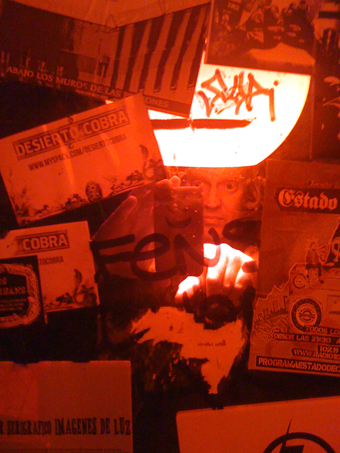
Tim Welfare in Bar Uno, Santiago, Chile
a capital collaged
My family and I arrived in Santiago only five weeks after the devastating Chilean earthquake of February 2010. This is the second time I have lived for an extended period overseas and there is nothing like arriving in a new city and hearing its voice. In Beirut where I lived for three years, I was constantly bombarded with the sound of car horns, the call to prayer and the chatter of its people, allowing me some sort of understanding of where I was. On my arrival in Santiago however, I had none of these sensations. Everything seemed familiar: cars with revolving wheels and see-through windows; roads with seemingly set directions; pharmacies on every street corner; supermarkets selling most food items, beer included. But even with all of these familiarities, I still felt disoriented. Chile was much more complex than it seemed.
As a consequence of my limited Spanish, assisted by the translation app on my iPhone, visual language has become an important part of my communication. I watch re-run after re-run as Chile mourns the loss of television personality Felipe Camiroaga (and his facial hair) who died in a plane crash over Isla Robinson Crusoe. I have a quiet laugh to myself when walking past street vendors selling newspapers displaying back issues of the satirical political newspaper The Clinic whose crude, high-school homophobic collaged covers often depict President Pinera in compromising positions with religious and political leaders. I listen to taxi drivers humming or misinterpreting the lyrics of classic rock tunes on the radio. This same music is also piped through supermarket shopping malls and department stores, a perennial favourite of mine being The Smiths’ “Girlfriend in a Coma.” (This would be an interesting case study for a student in psychology at one of 1000 university campuses in Santiago—“Looking at the effects of misheard lyrics and western music in a retail setting.”)
The people of Santiago have always seen themselves differently from the rest of Latin America due in large part to the physical landscape as the Andes run the length of country. So rather than looking across its mountains and borders for influence, it looks elsewhere. One of my favourite appropriations is the large Hollywood-styled signs on the hills above Santiago telling you which suburb you are driving past.
Last year it seemed the city had adopted ‘Brand Australia’ as a model. Curiously now, dated images of Australians with kangaroos as pets sit alongside a utopian landscape. Throughout the capital last summer, billboards for the clothing company doo australia portrayed young people in this fantasy landscape, presumably Australia. But since images produced by Chilean production companies for Norwegian hickory-smoked, spiral sliced ham products were shot in Patagonia, I’m sure this manufactured paradise of Australia is actually on the Chilean coast. Sure enough, many people are wearing the doo australia brand. Appropriated versions have also popped up: I even saw someone wearing a t-shirt with the “Aussie Aussie Aussie Oi Oi Oi” slogan emblazoned on it. So it would seem that Chileans have adopted Australia as their second country of choice.

for culture…
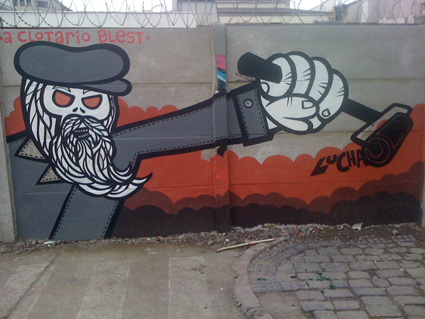
Street art, Santiago, Chile
photo Tim Welfare
Street art, Santiago, Chile
The three things which many Australians would know about Chile would be its wine, novelist Isabel Allende and General Pinochet. On arrival to Santiago it seemed that no one wanted to speak about the military regime—vastly different from my experience in Beirut where the conversation around its civil war was an important part of the healing process. But things are slowly changing and this was reflected in Chile’s bi-centennial year when the Museo de la Memoria was opened, a space dedicated to the thousands of Chileans who were either murdered, tortured or ‘disappeared’ during the 17-year dictatorship of Pinochet. It is housed in a beautiful, sleek, glass and copper-sheathed building in the heart of Santiago’s Quinta Normal area. The museum focuses on the victims of the dirty war and has visual displays of items used by the military to torture detainees, along with newspapers, letters, videos (some with English subtitles), even the bones of the dead and a wall of 1,000 photos of those arrested who have never been seen again. There is also a wonderful installation by Alfredo Jaar in a room that runs off the main courtyard. Jaar is one of Chile’s leading conceptual artists whose work came to prominence during this period. Very thought provoking and Jaar’s sentiment is spot on.
Just down the road from the Memory Museum is M100 Cultural Centre. With a modern wooden façade the building has been integrated into the old cellars of the Dirección de Abastecimiento del Estado (State Offices). M100 is an integral element in Santiago’s developing cultural landscape featuring a calendar of vibrant local and international art exhibitions, dance and theatre, films festivals and live events.
Currently showing is Coleccion Televisiva where 2,000 people from the local community were invited to each submit a video that had great personal resonance. Collaged together on a 15 x 6 metre wall across 11 screens, like a 17th century salon, the works present a range scenes from Chilean life such as Don Francisco (Chilean TV’s own Bert Newton, wig and all) hosting the annual ‘teleton’ intercut with footage from Bonanza, Beyblades (Japanese Manga), test patterns and news items from the military coup mixed with shots of the 1987’s Miss Chile/Universe winner and footage of the recent student protests played alongside rock band Queen’s video clip “Can’t Stop Me Now.” The grouping of these images offers more significance in their juxtaposition. This offers a truer sense of history than revealed in any textbook (where the winners write history). While the Pinochet military cracked down and arrested protestors in the streets, Bandstand-style programs were being screened in people’s living rooms with choreographed dancers performing to the latest hits from the US and the UK.
Also screening are Chilean Video art works as part the 2012 M100 program Video Concreta. These monthly shows have featured video programs from Chile, Colombia, Mexico, Argentina, Brasil and Australia. I recently curated boo australia, the lead out show for this series, the title derived from the streetwear clothing label mentioned above (see in the loop May 8).
Other cultural higlights include:
MAC (Museo de Arte Contemporaneo: a huge contemporary art museum with two locations operating in conjunction with the University de Chile.
Centro Cultural GAM: located in the old headquarters of the military which took control of the centre during the Pinochet period. In 2010 it returned to its original purpose as a cultural centre.
PLOP!: an art gallery and shop selling books and drawings by local illustrators.
La Chascona: the house, and now museum, of acclaimed Chilean writer Pablo Neruda.
Productant Mutante: Brainchild of Ervo Perez, this is one of the few organisations promoting electronic, rock and left-of-centre music from local contemporary and like-minded artists from the region, and also conducts regular workshops.
Santiago a Mil: international arts festival held annually in January.
for football…
Now there is culture. If you’re in Santiago seeing a game of football is a must. South America is the newest powerhouse in the sport as European clubs are now buying even second-string players. Fanatical football fans chant, dance and drum as well as set off the occasional flare in the grandstands while those who live in the east of downtown sit at home in their private, locked condominiums watching the game on their 42-inch digital television sets. To be fair, the wealthy believe in a culture of sorts—consumer culture. Unfortunately the arts are not high on their agenda unless it is the art of driving their SUV’s in all two or three lanes after a visit to the mall and then a Starbucks Cafe.
for street art…
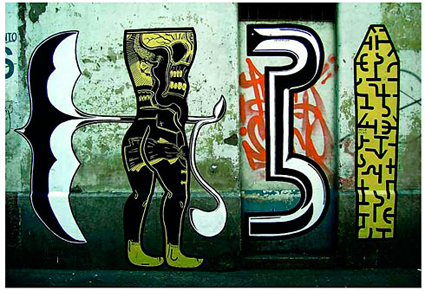
Street art by Basco Vazko, Santiago, Chile
photo Tim Welfare
Street art by Basco Vazko, Santiago, Chile
But in the rest of Santiago, visual art culture is alive on the street. Santiago currently sits alongside Sao Paulo as one of the two world capitals of graffiti. Street art has played an important role and reflects the history of political and social events in the city. The role and legacy of the Brigada Ramona Parra’s political and folk art murals throughout the 1960s and 70s cannot be overstated. Since the fall of the dictatorship many other elements have been included such as the lettering styles of New York and Brazilian pixaçao mixed with Pop Art and elements of indigenous art and American folk traditions. Great examples include the pioneering works of Cekis through to the innovative style of Basco Vazko. Works by both of these artists can be found in the bohemian neighborhoods of Barrio Brasil and Bellavista alongside 1000s of examples (and I am not kidding) located on every street corner. (See the doco Chile Estyle)
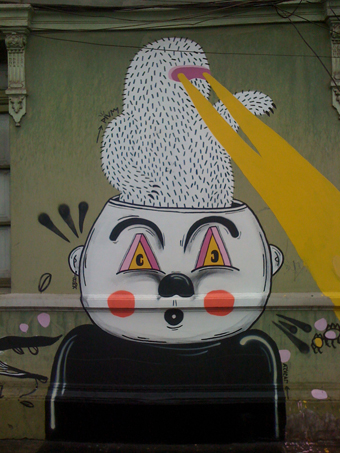
Street art, Bario Brasil, Santiago, Chile
photo Tim Welfare
Street art, Bario Brasil, Santiago, Chile
for refreshment…
Bordering the city’s historic centre and separated by the Mapocho River are the two neighbourhoods of Bario Bellavista and Lastarria where there are the many great bars, restaurants, galleries and an expanding fashionable shopping area. I am probably not the best person to walk you through Santiago’s ever-growing classic and modern day cuisine, wine lists or fashion houses as I am more interested in something more shabby and real.
One of my favourite bars is Café 202 (Calle Estados Unidos, 202 Lastaria), a small intimate bar in a back street where there a few chairs and the owner plays a mix of strange music. I often meet friends here or have been known to swallow a large schoop (a three-litre glass) or two or three of Kross Golden Ale cerveza on my own.
Bar Uno is located across the river in Bellavista (Bombero Nuñez 1, esquina Bellavista) and is most comparable to the Evil Star in Sydney in its heyday. It’s roomed in an old house with real character and held together by the paint from the murals which cover the walls and the stickers from the many punk and awful rock bands who have played in this small and smoky venue. But once in a while you will see the odd gem such as post-punk post-rock bands Dizzlecciko or Animales Exóticos Desamparados. For me it is the people patronising Bar Uno who make it a unique adventure into the bowels (and other weary body parts) of Santiago’s nightlife.
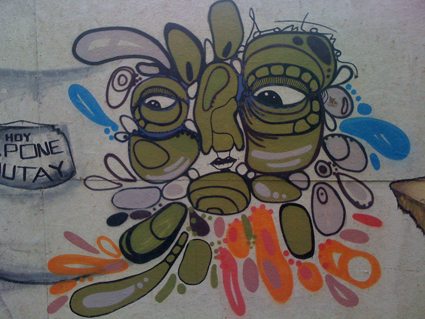
Street art, Santiago, Chile
photo Tim Welfare
Street art, Santiago, Chile
links
The Clinic http://www.theclinic.cl/
Museo de la Memoria http://www.museodelamemoria.cl/
M100 http://www.m100.cl/
M100 Coleccion Televisiva http://www.artishock.cl/2012/09/coleccion-televisiva-la-cultura-de-las-pantallas-en-chile/
Boo Australia http://www.m100.cl/wp-content/uploads/2012/05/pressreleaseAustralia.pdf
MAC (Museo de Arte Contemporaneo) http://www.mac.uchile.cl/
MAVI (Museo de Artes Visuales) http://www.mavi.cl/
Centro Cultural GAM http://www.gam.cl/
PLOP! www.plopgaleria.com
La Chascona www.fundacionneruda.org
Productant Mutante www.productoramutante.org/
Santiago a Mil www.santiagoamil.cl
Chile Football http://www.anfp.cl/
Chile Estyle http://www.youtube.com/watch?v=jgS6q4ojs14
Basco Vazko http://bascovazko.com/
Brigada Ramona Parra http://www.graffiti.org/santiago/brp.html
Dizzlecciko http://www.youtube.com/watch?v=EP95lL1qoMA&feature=my_liked_videos&list=LL-99Azv-_oq7FjpaYvGKSzg
Animales Exóticos Desamparados http://www.youtube.com/watch?v=z7j-PxO41DQ&feature=my_liked_videos&list=LL-99Azv-_oq7FjpaYvGKSzg
Tim Welfare is a multimedia artist and curator who lives and works in Santiago Chile. Alongside directing and producing his own projects (/www.scratchmynose.net) he has been actively involved in curating and organizing a wide range of cultural projects presented in Sydney, Melbourne, New Jersey and London. While living in Beirut 2001-04, he curated the screening program middleasterntalentime for dlux media arts D>Art 06 festival, while in Santiago de Chile he has curated boo Australia for the M100 Cultural Centre.
related articles
inhabited by images and sounds
tim welfare talks with visiting lebanese video artist akram zaatari
RealTime issue #73 June-July 2006 pg. 19
digital experimentation: cultural reciprocity
david cranswick talks to realtime about d>art 06
RealTime issue #72 April-May 2006 pg. 26
in the loop – may 8
including boo australia
RealTime issue #108 April-May 2012 pg. web
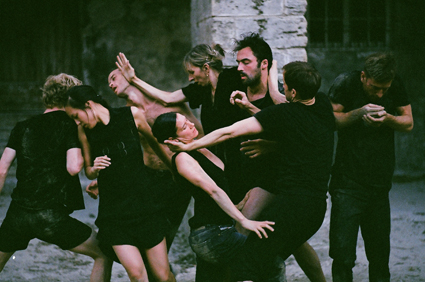
En Atendant, Rosas
photos Anne Van Aerschot
En Atendant, Rosas
THANKS TO THE 2012 BIENNALE OF SYDNEY AND CARRIAGEWORKS SYDNEY AUDIENCES WERE BLESSED WITH PERFORMANCES OF TWO MAJOR, INTERCONNECTED WORKS BY ONE OF THE GREAT CONTEMPORARY CHOREOGRAPHERS, ANNE TERESA DE KEERSMAEKER, IN COLLABORATION WITH THE DANCERS OF HER BELGIAN COMPANY ROSAS AND MUSICIANS. EN ATENDANT, PERFORMED FIRST IN SYDNEY, EVOKES THE TRANSITION FROM TWILIGHT TO NIGHT, WHILE CESENA EMERGES FROM NEAR DARKNESS TO SUNRISE.
en atendant
Across the forestage is a thin line of what appears to be soil. To the right is a simple bench. A flautist (Michael Schmid) crosses the line, stands before us, head down, silent. He sighs deeply. He breathes into his instrument, gradually forming slowly rising notes of increasing purity against a low chord which pulses with raw escalating intensity. Even though the apparent breathlessness of the performance is enabled by cyclic breathing, we sense the demands of duration and the multi-planed playing. Relief comes suddenly when Schmid stops playing and bends deeply forward. We catch our breath as one. István Matuz’s composition for flute, L(ÉLEK)ZEM, has taken us into a new space, oddly at once contemplative and anxiety-inducing. But even that is subject to transformation as the flautist leaves and a soprano arrives, sits on the bench and, to deep, breathy recorder accompaniment, sings En Atendant Souffrir (While waiting I must suffer) by the 14th century composer of the Ars subtilior style, Filippo de Caserta. The composition’s plangency, the sombre voice of the recorder and the crystalline clarity of the singing evoke the Middle Ages, as if we have been suspended between our own time (the contemporary work for flute) and the past, but connected by breath.
Dancers appear in small numbers, alone or in groups, half bending at the knee, sliding, slipping, leaning, moving unpredictably. They form a line but are unable to cross the stage as one, breaking into their own walks or dance fragments. One man travels the breadth of the stage with a semi-urgent walk, followed by another whose pacing is not quite the same. They reverse direction. Others lead and follow. The rhythm, sometimes quite complex, suggests at once courtly dance and everyday walking. The motif of leading (for Cesena as well as En Atendant) has been established, largely embodied in a bearded male dancer whose style is distinctively casual.
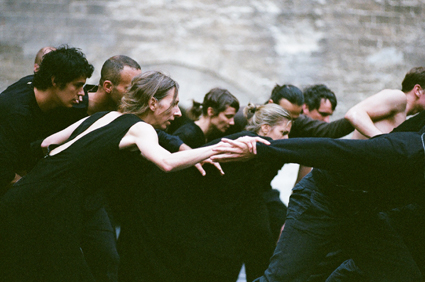
En Atendant, Rosas
photos Anne Van Aerschot
En Atendant, Rosas
En Atendant oscillates between sudden groupings, scatterings and brief, exquisite duos and solos—sometimes realised amidst the crowd in a dynamic theatre of simultaneity enhanced by the dancers’ apparently intuitive capacity to find or avoid each other in moments of great fluidity (De Keersmaeker describes her strategies for this in my report of her post-show talk).
As a group the dancers reach out, half-raising their arms, not quite suppliant but nonetheless as if collectively wishing for resolution, blessing, grace in a world of waiting, as expressed in the words of En Atendant: “While waiting, I must suffer grievous pain/ and languishing live, such is my fate/ for I cannot reach the fountain/ so many are the rivers that surround it.” Here there is “the hope for a goodly life” but “the true way cannot be found/ so troubled and sullied is the water.” In movements that range from simple to complex and demanding, both individual and collective, the dancing expresses meditative, sustained angular balances and passionate attempts to break through the barriers to purity. A male lead-and-follow duet intensifies with the men tensely resting heads and necks against each other as if wrestling with their frustration. One of them performs an enthralling, extended dance of apparently angry release, kicking at the line of earth as if it epitomises the obstruction “to the true way.” Individuals spin backwards or convulse on the floor. One man dances jauntily until he crosses the line, stops and stares at us. Bodies sink to the floor or fall back, then leap up with surprising ease. The line of earth is increasingly transgressed.
The dancers fall as one, piled as a mass; they rest and then slowly rise to form a momentary tableau, suspended between inertia and quest before surging into individual trajectories, only to merge again, to fall and rise. Again as a mass, they slowly form into a vast rotating circle which spirals inwards. Among the final moments, a male performer dances naked, moving in large circles, at times fluently, at others jerkily, amplifying the sense of individual vulnerability and pain at the core of collective anxiety.
For all its passion En Atendant is a highly formal work, framed by the complexly ordered expressions of belief in the beautiful Mediaeval music of ensemble Cour et Coeur, designer Michel Francois’ simple line of earth across the stage and the diminishing light from the stark bars hovering above, the stillness between passages of movement and music, the role of breathing (often to the point of near exhaustion) and de Keersmaeker’s insistent dance motifs that offer coherence and meaning, realised formally and informally and enhanced by the great attentiveness and responsiveness of the dancers to each other. The sheer otherness of the world that is realised by design, structure and juxtaposition is made all the more transcendent by the idiosyncratic choreography, not least in its unexpectedness—a language strange and wonderful. We waited with En Atendant’s performers in their epic struggle for a moment of grace and drank with them at its fountain. Or entered fearfully into the dark.
cesena
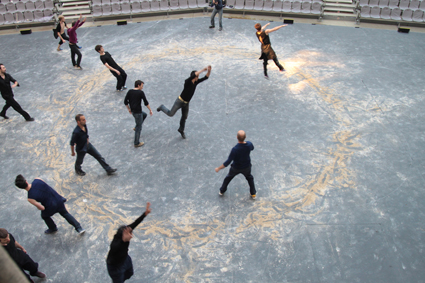
Cesena, Rosas
photos Anne Van Aerschot
Cesena, Rosas
In near dark a naked man stands immediately before us. Echoing the strenuous opening instrumental movement of En Atendant his breathing gradually vocalises into a repeated long cry that becomes an animal growl alternating with whistling, wrenching his body up and down from the waist. He breaks from this act of endurance into walking and then running fast in large circles and then wildly and randomly. The rest of the performers appear from out of the utter upstage darkness, moving into the large chalky circle that dominates the floor, scuffing and skidding across it and then drawing back like a wave, in and out of the dark, like an emergent organism. Subsequently singers and dancers draw apart into their own realms, singing to the dancing, dancing to the singing, then merging in a kind of march, and scattering as a dancer again goes wild, flopping onto and breaking the circle. These eruptions are more recurrent and desperate than anything in En Atendant. The lead dancer stops, looks up, and down, reminding us of the seeking in that work, and of Cesena’s opening and the work of breathing. Two more dancers repeat the pattern.
As more light is discerned individual and group flights of movement ensue, interrupted by freezes and collapses, forward and backward pulsing, arms raised, bodies swaying and sudden kicks. Someone walks, then races across the floor. A woman writhes. Another replaces her. The bearded man dances on the line of the circle, lowering himself into it. Singers and dancers manipulate each other’s bodies, dancers conduct the singing, multiple pietas are formed. As in En Atendant there are sudden massings—bodies pulled together, slumping as one and then appearing to be dragged en masse by an invisible force accompanied by loud bangs and crashes. Both works suggest a degree of involuntarism in such moments—the mass reveries and hysterias of the Middle Ages perhaps, or a drive beyond individual will towards the light.
In other large groupings all the men come together to sing or the performers link hand to shoulder in fast/turn/slow lines involving leaning in, then back and skipping. Communal behaviour becomes more complex with the circle, regardless of its bruising, providing a centrifugal force. With the centrality of the circle established and the light brightening, a man and woman, then two men and then others dance vigorously if lyrically at its centre. Large doors at the back of stage slide open, light floods in and the performers circle and weave. What has the circle been but a human representation of the Sun, awaited, celebrated, enacted, sung and gloriously welcomed.
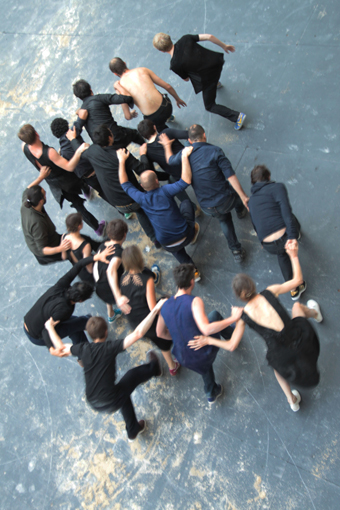
Cesena, Rosas
photos Anne Van Aerschot
Cesena, Rosas
As in En Atendant, the weave of individual, groups and sounds in Cesena offers a fascinating reverie if, on the one hand, less coherent and more opaque (another viewing would help gauge the significance of a number of solo and small group moments) but, on the other, thematically and aesthetically richer in its merging of dancers and musicians.
As Alex Ferguson reported about Cesena from the Festival TransAmériques 2012, Montreal: “The greatest vocal challenges are left to the singers, and the most difficult movement solos are left to the dancers; but for the most part the bodies all sing and move—to very high standard. Walking, turning, rolling and singing with collective intent, the performers form a community of initiates with a holy mission: to awaken the sun—or its proxy, electric light. They succeed.” (RT110)
De Keersmaeker also pointed out that her collaborator Bjorn Schmelzer, director of the grandelevoix choral group, had chosen the pieces of music but without any thematic rigidity. Opposing the “holy boxing and sterilising” of music from the past, she said “our bodies are more contemporary than anything else. We visit this old music with our bodies and the grain of the voice gives it a completeness.” De Keersmaeker made the point that Schmelzer did not aim for polished performances, nor did she. “My approach to movement is architectural.” She saw herself as realising a “materialised energy…a natural and complex richness” rooted in informal movement.
So it is that the companies of dancers and singers merge into one, sometimes significantly blurring their roles and amplifying the sense of community. A few dancers, said de Keersmaeker, could not sing, but in the case of a Serbian dancer, the music connected with his cultural background. Matej Kejzar performed a fragment of a Serbian epic poem dealing with loss, an angrily delivered lament, sung with raw passion. On the other side of the stage the rest of the company gathered in a circle, accompanying him contrapuntally with melancholy serenity. For de Keersmaeker, the song recalls the grieving over the three-day massacre of the citizens of Cesena in northern Italy ordered by the Pope during the schism within the empire, and more recently the Serbian-Bosnian war.
Asked in the post-show talk if ‘community’ was significant in her work de Keersmaeker answered, “it’s beautiful and political…a community of people and [each] person in all their complexity.” She declared, “dance makes me love people. These works were made with these people.”
In Cesena, de Keersmaeker wanted “only the body,” operating inside and out of “that most complete of forms, the circle.” The result: dancers who sing and singers who dance, one community, celebrating light, the body—at once “most ancient and contemporary”—and “most individual of all, the voice.” For de Keersmaeker, the sharing of music and movement is central to Cesena, such that she and her performers created “simple movements while doing complex singing.”
Another motivation for the creation of Cesena’s sole focus on the body, said de Keersmaeker, was a response to “the technicalised world post-WWII,” not least the dominance by speed that came with it and the technologies that negate the body.
De Keersmaeker’s En Atendant and Cesena are now embedded deep in our bodies and psyches. She leaves us feeling we have danced the dance, and sung it, with Rosas, graindelavoix and Cour et Coeur. As de Keersmaeker says of music, “[It] frames my basic nature…[it provides] order in the highest degree of chaos,” so do En Atendant and Cesena offer metaphysical and existential succour as we struggle on and celebrate from day to day.
Keith Gallasch’s account of Anne Teresa de Keersmaeker’s artist talk can be found at here.
Carriageworks & the 18th Biennale of Sydney: Rosas, En Atendant, Sept 11, 12; Rosas and graindelvoix, Cesena, Sept 14. 15; Carriageworks, Sydney; artist talk, Sept 14
This article first appeared as part of RT’s online e-dition Oct 23
RealTime issue #112 Dec-Jan 2012 pg. 26-27
© Keith Gallasch; for permission to reproduce apply to realtime@realtimearts.net
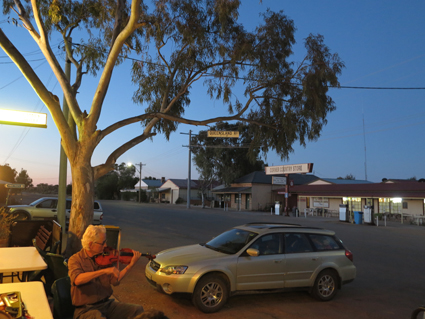
Jon Rose in Tibooburra
photo Lucas Abela
Jon Rose in Tibooburra
FROM SEPTEMBER 3 TO 18 JON ROSE (VIOLIN & FENCES) AND HOLLIS TAYLOR (VIOLIN) INVITED EXPERIMENTAL MUSICIANS AND ARTISTS LUCAS ABELA (GLASS), LAURA ALTMAN (CLARINET), DALE GORFINKEL (VIBRAPHONE, MODIFIED TRUMPET & MOTORS), SAM PETTIGREW (FENCES, GUITAR & OBJECTS), KEG DE SOUZA (VISUAL ARTIST), JOEL STERN (FOOT PUMPS & FEEDBACK) AND ME (TROMBONE) TO TOUR CORNER COUNTRY IN FAR NORTH-WESTERN NSW AS PART OF SOUND CIRCUS. PERFORMANCES AND WORKSHOPS WERE HELD AT WHITE CLIFFS, MUTAWINTJI NATIONAL PARK, BROKEN HILL, MILPARINKA, TIBOOBURRA, WARRI GATE AND CAMERON CORNER.
*
The nagging question that followed me around on this tour was whether our aesthetics would change as we took our niche practices with us way out west.
*
September 15. The last performance date of the tour, Cameron Corner, is a pub/motel/campground/restaurant/golf course straddling the borders of New South Wales, Queensland and South Australia. Population: six. By the time we get there we all seem comfortable with our wide brimmed hats, body odours, dirty hands and tinnies of XXXX.
On a patch of hard orange dirt next to the road to the pub, Jon sets up his Ball Project: a two-metre high inflatable ball, which produces electronic sound in response to its movement via wireless technology and a portable PA system. At its last outing in Tibooburra some sort of malfunction occurred. It no longer produces any sound. Joel hooks up his mini-synth to the PA and replicates what he imagines to be the sounds created by the accelerometers inside the ball, as the performers and the publican run at, kick, head-butt, carry in the air, throw and drive cars at it.
As the sun sets over the golf course and desert, the giant ball rolls across the landscape alone except for a dog which tries to herd it. Over more tinnies, the publican offers to buy it. He wants to mount it on a giant tee as an advertisement for the golf course.
*
September 14. At some point our joking mimicry of a stereotypical outback drawl has become an unconscious accent we slip in out of, how blue we swear depending on who we’re talking to. Someone else’s words in my mouth.
*
September 13. Jon has been playing in the outback for many, many years. I think for him this turning towards the interior of the continent is a deeply considered political question of adaptation and reconciliation. The slow evolution of his music and the means of its production is an historical trajectory upon which at this point in time we have joined him. During the short time in which we’ve been playing in the outback I don’t think we can effectively measure how our movement across space has affected our aesthetics.
Having scratched the surface, today we argued about how we would organise Sound Circus next time—grand plans of lengthy residencies in remote communities where we would have more time to engage with people and the environment are bandied about as if adequate funding and available dates are already a concrete reality. Perhaps the desire to put ourselves in this position again is a sign of our musics slowly turning 180 degrees to the point where finally our backs will face the ocean.
September 12. Milparinka is a ghost town. As far as I can tell, its only residents are the two volunteers who live there temporarily to keep the tourism and heritage flame burning, and a house full of kangaroo hunters, who I never see or hear.
As the sun sets Laura, Sam, Dale, Joel and Jon play on the steps of the courthouse—a well maintained sandstone building housing historic artefacts, which doubles as our sleeping quarters for the night. Their improvisation is of a particular standard genre of gentle sounds and almost polite durations that allow space for other performers to contribute in a meaningful way. The music continues on this path until a very sudden and vicious swarm of mosquitoes descends on us in clouds, driving us into the courthouse, slapping at ourselves.
The move inside ends the improvisation and a new performance begins. Lucas, Jon and Joel play a louder improvisation, in different parts of the building, using sound to explore the resonance of the spaces. The simple placement of various vibrating apparatuses in specific points in the building creates a temporary architecture within the permanent architecture of the courthouse. I have to walk around the space in order to hear the piece in its entirety. Perhaps the inability to hear the other ensemble members encourages each performer to engage more with the space in which they play. Much later that night, Sam and I explore this idea further by locking ourselves in two adjoining police cells at the back of the courthouse and, with the lights out and a thick sandstone wall between us, improvise a piece to no audience other than a pair of microphones.
*
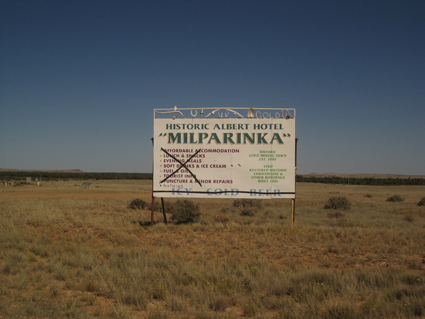
Milparinka
photo Laura Altman
Milparinka
September 11. Jon tells us we only have an hour for all seven of us to perform at Broken Hill Art Gallery because they have hired someone to work late to keep it open for us. We collectively discuss this, and decide that despite the time restrictions and the pressure to rush, we should let our performances develop organically. Throughout the tour we have been arguing about how best to respect an audience that is completely foreign to us and quite likely, in some instances, openly hostile. In particular, does a longer duration of performance test the patience of the audience, and, self-reflexively, does even questioning the patience of the audience instantly mean that we are not giving them the same respect that we would if they lived in a city? Jon says that no matter what, we’re here to entertain.
Line up: duos—Sam & Dale, Laura & Joel, Laura & Dale; trio—Joel, Sam, myself; solos—Joel, Lucas; installations—igloo with tape machines.
Despite the shorter durations, all the sets sound the way they would if we were performing at home, just truncated. Perhaps it is the safety and familiarity of a gallery setting that doesn’t challenge any aspect of our music.
At the end of Lucas’ blistering noise performance, the last of the night, an older lady at the back of the gallery exclaims “Ah, thank goodness!” This is followed by a formal question and answer session. The questions revolve around how our modified and self-invented instruments work.
*
September 9. The ball performance on the White Cliffs tennis court is cancelled due to high winds. Instead, a Radio National journalist asks if she can interview us. The interview turns into a discussion in which we press Jon to explain his intentions in inviting us to the outback with him. He wants to show us what excites him about playing in the outback, which he hopes will inspire us to regularly play there.
I ask Jon whether playing in the outback for all these years has changed the way he plays the violin. He says the violin is an inside instrument, which gets lost without four walls around it, so he began to change his playing technique—“effectively de-Europing himself,” I propose—to the point of abandoning playing the violin outside and focusing instead on playing fences and self-built instruments more suited to the conditions.
After the discussion Dale, Laura, Sam and I play a game of tennis. Even in the wind, Dale is very good.
*
September 8. Sam, Laura, Joel, Dale: a typical small-i improvised set in a dry creek bed. Quite restrained and delicate. The White Cliffs locals seem to like it. I am the first to clap when the performance ends. The local nurse—a large bearded man in an Akubra hat and Ganesh T-shirt—asks me how the hell I knew it was over. “They did that close eyes, open eyes, look up thing.” He tells me, “The silences were really a part of the music.”
*
September 7. We rehearse in White Cliffs community hall for our performance the next night as part of the Underground Arts Festival launch. We’re framed as a Sound Circus, “which makes us Sound Clowns” somebody jokes. Jon wants us to individually play 30-second interrupting segments of strange sounds during his and Hollis’ performance of folk tunes on the piano and singing saw. The general circus/vaudeville structure imposes duration on us which is antithetical to the way we usually play. (The next day, a couple of hours before our vaudeville act is to begin, Jon asks us if we want to back out. We collectively say yes.)
*
September 6. Over breakfast there are some concerns around how people are going to react to us. Sam wonders, “Are we here to entertain?” I say, “We’re not entertainers.” Lucas disagrees, he’s experimental and entertaining.
*
September 5. We arrive in White Cliffs in the middle of the night after driving through almost invisible cows and suicidal kangaroos down a narrow country road. We pull into the only pub in town, where we befriend a professional hunter, who sings the praises of vegetarianism, and the local tour guide whose deaf dog understands sign language.
*
Before we began the tour, I had a nagging question as to whether our aesthetics would change as we crossed the continent, taking our niche practices with us way out west.
Jon Rose and Hollis Taylor, Sound Circus, with Dale Gorfinkel, Lucas Abela, Keg de Souza, Joel Stern, Laura Altman, Rishin Singh, Sam Pettigrew, Hollis Taylor, Jon Rose, Corner Country NSW, Aug 24-Sept 17; http://www.jonroseweb.com/f_projects_sound_circus.html
See Jon Rose’s account of the Sound Circus over at the Australian Music Centre’s Resonate Magazine.
See RealTime’s archive highlight of the NOW now
This article first appeared in RT’s online e-dition Oct 23
RealTime issue #112 Dec-Jan 2012 pg. 42
© Rishin Singh; for permission to reproduce apply to realtime@realtimearts.net
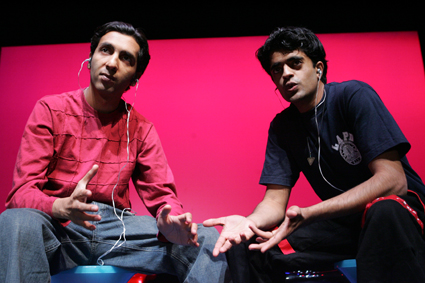
The Trouble with Asian Men
courtesy Parramasala South Asian Arts Festival
The Trouble with Asian Men
ONE OF THE GREAT CULTURAL INNOVATIONS IN RECENT YEARS IN SYDNEY HAS BEEN THE ESTABLISHMENT OF PARRAMASALA, A FESTIVAL OF SOUTH ASIAN CULTURE LOCATED IN PARRAMATTA IN SYDNEY’S WEST, FEATURING TRADITIONAL AND CONTEMPORARY MUSIC, DANCE, FILM AND THEATRE AND HYBRIDS OF THESE. FOOD AND RITUAL HAVE ALSO PLAYED A MARKED ROLE IN THE FESTIVAL’S GENERATION OF A SENSE OF OCCASION.
Parramasala is aimed not just at the South Asian population of the Western Sydney region—for whom it has become a significant event—but at a broad audience curious to engage with the art and cuisine of South Asia—the rich heritage of their suburban neighbours. Nor do the programmed works emanate only from India, Pakistan, Bangladesh and Sri Lanka; they also come from wherever the South Asian diaspora has established itself around the world, including Australia.
It’s the third and final Parramasala for the festival’s first artistic director and CEO Philip Rolfe. The indefatigable Rolfe has long played a significant role in promoting Australian art internationally and bringing key works to Australia. He was Deputy Director of Arts and Entertainment for the Australian Bicentennial Authority’s national and international performing arts programs 1985-89. As an employee of the Australia Council for the Arts, 1989-2000, he developed its Audience and Market Development wing, set up and directed the Australian Performing Arts Market for six years, and established Hybrid Arts funding and later the New Media Arts Board. He was subsequently Executive Director and Associate Producer at Sydney Opera House 2000-2009, presenting and producing a wide-ranging innovative program including Brian Eno’s Luminous, the first Vivid music and light festival in 2009. Taking on the challenges of Parramasala is Rolfe’s latest contribution to expanding Australian consciousness of the cultural riches available to us from beyond and within, in this case, as he says, to “make something that [is] rigorous at looking at the global influence of South-Asian arts and cultures wherever they might have impact.”
I spoke with Rolfe about the components of his 2012 Parramasala program, commencing with a cluster of plays with overlapping themes and concerns.
One of the directors of the UK’s Tamasha Theatre Company, Kristine Landon-Smith has recently been appointed to NIDA as a lecturer in acting. How did you come in contact with her company?
I’ve seen some of their work in the past in England and they registered as one of an interesting bunch of theatre companies that were quite distinctive. I talked to Kristine years ago when she visited Sydney soon after Tamasha was set up. Strangely, the first piece they ever made was developed in Wollongong. I always remember it. It ended up being titled Strictly Dandia—Dandia is a Gujarati dance thing. Kristine is an Australian—she’s lived in England for 25 years or so—and she made the show with input from the Gujarati community which is the biggest Indian community in and around Wollongong. That piece which, I guess in those days had a connection to the Strictly Ballroom phenomenon, proved to be quite a success in England. It’s a big-scale, popular piece of theatre—not West End, but who knows, at some point it could well have made it into that scene. It toured regionally in England and it’s still in Tamasha’s repertoire. We reconnected a couple of years ago when I started to do Parramasala. And Kristine and I talked about doing something else—a verbatim piece called The Trouble with Asian Men.
It’s a small play and we wanted to find a nice venue for it. We’re turning the Jubilee Hall, the ancillary hall in Parramatta Town Hall, into a 100-seater. We’ll have The Trouble with Asian Men and Ansuya Nathan’s Long Live the King showing there back to back through the festival. They’re small works but really potent. The Trouble with Asian Men is very funny but it’s also got a lot of content, it’s not just poking fun at tradition.
Is it about traditional attitudes and contemporary masculinity?
Absolutely. It’s light and enjoyable, accessible. I wanted this year to have theatre again. Last year we had Curious Works [communities telling their own stories in inventive formats. EDS, see article], a very different experience. I wanted to bring theatre back in as a way of showing what you can do in a festival, the sorts of things that can work in short runs.
Is The Trouble with Asian Men focused on Asian masculinity in the UK?
There are two key people in it from the original cast coming from England and then there’s a third local person who joins as a guest for each performance. We’ve done a lot of research in and around Parramatta. (Actor-writer) Drew Fairley got involved and he and (Sri Lankan-born actor) Monroe Reimers did a whole lot of interviews under Kristine’s direction. So it’s been re-situated in an Australian context (combining) the English content along with some terrific local references.
Long Live the King is by Ansuya Nathan who I see is a NIDA graduate.
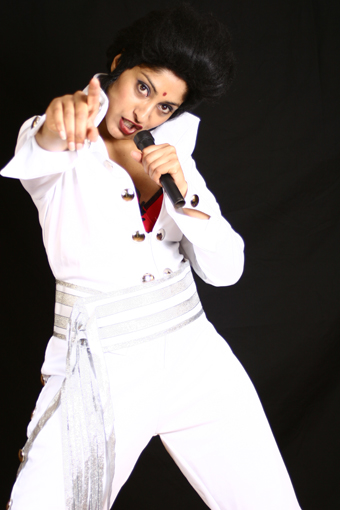
Ansuya Nathan, Long Live the King
courtesy Parramasala South Asian Arts Festival
Ansuya Nathan, Long Live the King
She is a superb actor. She’s written and worked on it and it’s a piece that she completed with Guy Masterton who is one of the regulars in the Edinburgh Fringe. He’s an entrepreneurial director and has a whole string of productions, mostly English—but this is a very distinctly Australian piece. It’s done well in a bunch of contexts and it deserves putting on and it fits well with Trouble with Asian Men.
It’s about an Indian family who migrate and arrive in Adelaide on the day that Elvis dies. It’s a sort of parody I suppose but based on some autobiographical detail. They happen to be huge Elvis fans. So there’s this apparent contradiction of a traditional looking Indian family having that kind of obsession and what results from it. Again, it’s a very humorous piece but potent and it shows things about cultural identity or how it can be misunderstood. It’s about the juxtaposition between an Australian perception of what Indian culture is and what it’s really like, particularly if you go to India now.
I remember, the last time I was in India, in the middle of Rajasthan with this host who looked after me, taking me to his home for dinner with his family. A beautiful dinner was cooked and on this massive wide screen TV we watched Indian Idol. And this guy, Kuldeep Kothari, who has become quite a good friend runs a fantastic foundation, which is about restoring Rajasthani cultures and promoting them to the world. But on this night he was having a great time with his kids. There are those sorts of humanising things in Long Live the King. Ansuya Nathan is a standout solo performer, playing all the parts.
You also have Krishnan’s Dairy by the Indian Ink theatre company from New Zealand, who have been here before.
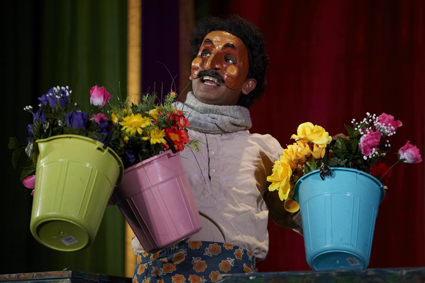
Krishnan’s Dairy, Indian Ink theatre
courtesy Parramasala South Asian Arts Festival
Krishnan’s Dairy, Indian Ink theatre
Yes, they came in the first year of Parramasala with the premiere of a new play they’d just completed called The Guru of Chai. They’re a really good theatre company, hugely consistent. They’ve stuck to their guns over the years in not being enticed into other worlds but concentrating on a terrific form of storytelling. And they’re masterful at that. They work and work on their scripts to get them into superb shape. A lot of it revolves around the co-founder Jacob Rajan, whose heritage is Keralan but that’s a couple of generations ago. Excuse me, Jacob, if I misrepresent you, but my understanding in talking to him is that he doesn’t feel a huge connection with that identity but he’s beginning to rediscover it, I think, as people tend to do. Nitin Sawney was very similar—brought up in England, looking Indian and people expecting him to be a tabla player or something. He had no experience of India really until his 20s. So there is that sense of rediscovery that Jacob’s now getting into as well.
Krishnan’s Dairy is Indian Ink’s first ever play. It was made many years ago and it’s a piece that’s been seen in Sydney—in Penrith I think, for like a week and that’s it. I like this company a lot and last time we presented them they sold out. There’s a great rapport with their audience. The Sydney Indians were amazed and had a fantastic time at Guru of Chai, which is a beautiful, original piece about a kind of semi-mystic who lives on a railway station in Bangalore—a chai-seller who is full of philosophy and stories. Jacob has a great capacity to be 20 different characters within an hour, flipping back and forth. It’s traditional but I love that—when you see something where form is not the issue, it’s how he does it.
I read that the play juxtaposes a dairy with the Taj Mahal.
A dairy is a New Zealand term for a milk bar. The basis of the play is Indian migration into New Zealand—two people who start up a dairy business and are on their way to prosperity. What I like is that within the theatre program we’ve got three different forms and styles, really good quality, simple. If you’re going to do theatre in a festival in Parramatta, you’ve got to keep it simple. I’m not talking ‘simplistic’ by any means, but simple in terms of production. There are only so many venues and you can’t afford four-day set-ups—it doesn’t work. You’ve got to take care and pay attention in making it all happen.
This is your last Parramasala. What is its relationship with the community? Has the festival achieved some of the aims you hoped?
Well, Parramasala began at a time when there had been the student attacks in Melbourne mostly and there’d been some civil unrest in Western Sydney, particularly around Harris Park. There had been some big clashes between people from the Lebanese and Indian communities that had somehow been fuelled by racist behaviour. Ways of dealing with stuff like that (were being considered). I think in the Council’s perception, having a festival that reflected
on Indian culture was one possible tactic to help bring a community a little more together. But that wasn’t the overriding reason behind it.
Parramasala is set up as a festival reflecting on South-Asian arts, not just Indian because there are other communities developing out there—Sri Lankan, Bangladeshi and Pakastani. But there are lots of common themes. From my perspective it was seen as a way to do something unique—there isn’t anything quite like it in Australia. If you’re going to set up something like this and you want people to come, don’t just serve up what they can already get elsewhere. But it was never conceived as a community-based festival, you know, ‘by the community for the community.’ I think there were people who had their feathers ruffled by that approach, that it was going to be arts-specific and it was not going to just include people out in Western Sydney who felt it was about them.
But by and large, there are a lot of people who feel warmly towards it. That was my take on what to do—to actually make something that was rigorous at looking at the global influence of South-Asian arts and cultures wherever they might have impact. They can be in England, in Germany, in the US. Over time, we’ve had lots of artists and productions that have come from all around the world to the festival. I think that should continue. There’s a sense for me and, I hope, for South-Asian people in Western Sydney that it’s a really powerful thing, that cultures from their homeland have had impact all over the world.
You also have a film program, curated by Ravi Kambhoj, Is it well attended?
Yes. We did it for the first time last year and I think it will continue. There was a lot of pressure to do Bollywood movies, and we are screening one titled Sholay, a 1970s Bollywood blockbuster. We’re doing that outdoor one night. It’ll be great fun, a good night out. But the film program is made up of contemporary films from South-Asian filmmakers with one exception, which is a piece called Sunshine & Shade, a new documentary made in Sydney by a fantastic young filmmaker Ani Tiwary. She’s lived in America and made films there. She’s worked in the Bollywood industry in Mumbai. She’s a filmmaker-producer and she’s made this great documentary, which she’s been working on for three years. It’s about the trials and difficulties—and some good things—experienced by Indian students in Australia. That’s our premiere on the first night. It’s a great little piece, not all doom and gloom. It’s character driven and it follows the history of two students in particular, what they went through and where they are now. It’s a beaut piece!
And the music program?
I’ve always wanted a non-South-Asian audience to experience absolutely beautiful examples of classical work—at least one or two in a festival. So you can promote those to people who have not experienced them before. And I think that’s a really good thing to do. A festival like this can attract lots of people who wouldn’t ordinarily get involved in seeing Indian or South-Asian work, classical work particularly. But if you put it in the right context, I think you can promote it successfully.
In India, Hari Prasad Chaurasia is a household name. He’s as well known or better known than Ravi Shankar. He is of the highest level, a Pandit, the master of his form. He’s got 50-60 year’s experience as a performer. He worked with the Beatles, all the stuff that Ravi Shankar did. He’s a master of the bansuri, the classical Indian flute. We’re bringing him and his ensemble here and I think it will be one of those experiences. It’s full of wonderful, beautiful music. To do that in every festival, to have one or two examples of that kind of work, is critical.
We have a big Pakistani qawwali group, Asif Ali Khan and a nine-person ensemble from Lahore in Pakistan. They’ll do one free outdoor performance. To see not just small versions of qawwali but the full-on performance with the wonderful vocals and the music from those guys is gonna blow people away. Everyone knows the late Nusrat Fata Ali Khan from the world music circuit. Asif Ali Khan is his replacement in many ways. He learned with him. He’s up there as a contemporary qawwali master.
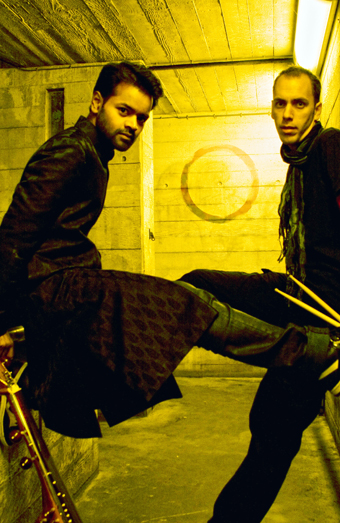
Soumik Datta, Bernhard Schimpelsberger
courtesy Parramasala South Asian Arts Festival
Soumik Datta, Bernhard Schimpelsberger
Then there is crossover music, from Soumik Datta, an amazing sarod player. Nitin Sawney pointed to him as a person who should be seen. It’s contemporary Indian music, and he’s a graduate of the Royal College of London. He’s stunning and the percussionist with him, Bernard Schimpelsberger, is also unbelievably good.
Susheela Raman is a mega musician, but not that well known here. She was brought up in Western Sydney. and is another amazingly good performer, with a powerful voice and her band is superb. She went to high school in Strathfield. Her parents were immigrants to Australia but she moved on to Europe as soon as she got out of school, I think. She’s lived and worked there and has developed this whole career.
So after three years of Parramasala, are you happy with how it’s gone?
It’s been a good thing to do. I’ve enjoyed it. It’s been bloody hard work. I was asked to do this when I left the Opera House, to set up a festival in Parramatta. I was asked to develop the concept and then to make it work for the first three years. So I’ve had a go and I feel really good to pass it on to someone [yet to be named. Eds].
Is there anything about the Parramasala program we’ve left out?
Good food. Amazing food. And a licensed bar. The food this year is going to be stunning. All carefully selected—no bain maries full of old curries!
Parramasala, International Contemporary Arts Festival, Parramatta, November 8-11, http://www.parramasala.com
RealTime issue #111 Oct-Nov 2012 pg. web
© Keith Gallasch; for permission to reproduce apply to realtime@realtimearts.net
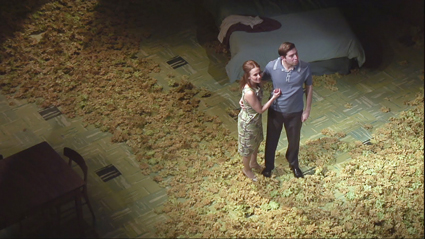
Edward Bennett, Leanne Rowe, Lovesong, Frantic Assembly
courtesy Digital Theatre
Edward Bennett, Leanne Rowe, Lovesong, Frantic Assembly
FOLLOWING ITS SUCCESSFUL DEBUT IN 2011, PAUSEFEST RETURNS TO MELBOURNE IN NOVEMBER AND THIS YEAR (PRESUMABLY EVERY YEAR?) IT’S ALL ABOUT THE FUTURE. PAUSEFEST IS THE BRAINCHILD OF GEORGE HEDON WHO AIMS TO SHOWCASE THE HIGH-END OF THE DIGITAL CREATIVE INDUSTRIES AS WELL AS INTRODUCING SOME OF OUR LOCAL GEEK GENIUSES (OR GENII).
For industry the centrepiece of the festival is the one-day professional development opportunity, PauseStage, which will bring together some of the leaders in commercial digital culture such as Rick Chen co-founder of Pozible, Jeremy Boxer from Vimeo and a range of speakers from cutting edge special effects production companies. There’s also a workshop series, PausePlayground, which looks particularly impressive, offering sessions in areas such as location-based tracking systems with Francesco Anselmo from ARUP and Aaron Tan from the University of Melbourne; and an insight into open frameworks and Kinect technology with Pierre Proske presented by Media Lab Melbourne. The PauseView sessions offer insights into some interesting interactive projects in development.
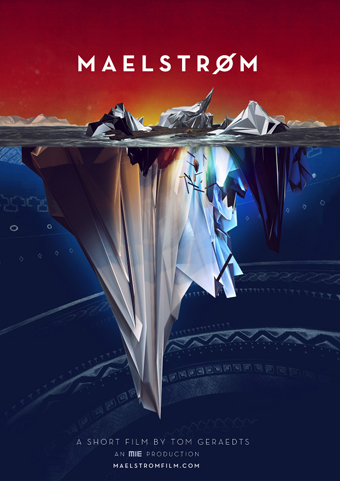
Maelstrom from Future Shorts
For those who are not so up with their C++ coding, there are 14 screening sessions featuring digital treats such as Forget The Film, Watch Titles 2005-10, a retrospective of film and TV titles; Best Animated Ads; PauseED, a showcase of student and graduate work; and Future Shorts, the best of future themed short films from 2012. There will also a be a special screening and Q&A session of Lovesong, a theatre work created by UK company Frantic Assembly and written by Abi Morgan, whose film and television credits include The Iron Lady, Shame and Birdsong and The Hour. The production explores a couple’s relationship at both the beginning and end of their lives together and is said to be a “visual and emotional feast” (press release). The filmed production is presented by Digital Theatre, the UK production house working in collaboration with a range of high profile British theatre companies and venues to make documentation of live works available online via streaming and downloading. (See our recent coverage of Random Dance’s iTunes download of Entity).
There’ll also be activities in Federation Square including an evening of DJs, interactive installations and a free screening of the Rest of Fest program, while MPULab’s Snake the Planet, an interactive street game (reviewed as part of the DorkBot Exhibition at Serial Space) will be roving around Melbourne’s CBD.
GIVEAWAY
Courtesy of PauseFest RealTime has:
2 x double passes to
Future Shorts (screening)
Fri Nov 9 9pm
ACMI – Cinema 1, Melbourne
2 x double passes to
Lovesong by Digital Theatre (screening)
Sun 11 Nov 11, 7pm
State Library of Victoria, Melbourne
Email onlinegiveaways@realtimearts.net with your name, address and contact number. Please indicate which screening you’d prefer.
Note this event is in Melbourne.
Pause Fest, various venues Melbourne, November 8-11; www.pausefest.com.au
RealTime issue #111 Oct-Nov 2012 pg. web
© RealTime ; for permission to reproduce apply to realtime@realtimearts.net
spaced: art out of place 2013-15, iaska
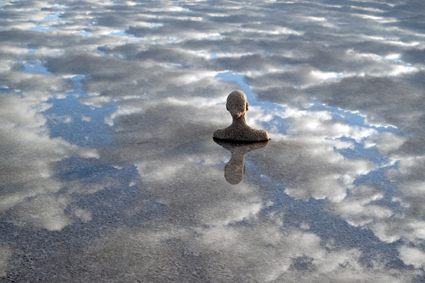
Julia Davis, Headspace, spaced 2012
courtesy the artist
Julia Davis, Headspace, spaced 2012
In February this year Fremantle Arts Centre hosted the inaugural IASKA spaced exhibition which showcased the results of 21 artist residencies in a range of communities in Western Australia. Response was enthusiastic with Sarah Miller writing in RT108, “The desire to foreground the experiences of not only the artists but also community members led to a rich and complex, often paradoxical and occasionally confronting, series of artworks, conversations and engagements that will surely resonate long after the individual projects have ended.”
The producing body IASKA is now calling for expressions of interest in the 2013-15 program. The curatorial focus for the second iteration is collective memory, considered here to be “the source of competing narratives through which we create new visions of our communal present and future” (press release). IASKA is seeking proposals from visual and media artists interested in creating works in negotiation and consultation with a WA regional community over the course of an 8-12 week residency. Communities include Geraldton, Derby, Mandurah, Kalgoorlie, Esperance and Albany and artists are also encouraged to suggest other options. Works will be exhibited in their original location and also in a final group exhibition in 2015, once again at the Fremantle Arts Centre. The exhibition will also tour 2015-17. Australian and international artists are encouraged to apply and successful applicants will receive artist fees, travel and production expenses.
Spaced: art out of place, IASKA, expressions of interest due Oct 29; http://www.iaska.com.au/
punctum: in-habit & seedpod
Punctum’s In-Habit offers Victorian artists travel and accommodation costs to undertake a residency in a regional area in an overseas country. Artists can organise their own host but Punctum has already established some very interesting relationships with international organisations such as Fontevraud Abbey, located in the Loire Valley, France which concentrates on animation, or Noirlac Abbey 40kms from Bourge which offers an arts research program around “pluridisciplinary” practices involving music, sonic arts and installation art. Also in France is Ambronay Abbey which focuses on “multi-disciplinary meetings between intellectuals and performing artists around its theme of ‘music and the sacred’” (website). Then there is Casa das Caldeiras in the Western Zone of Sao Paulo, Brazil, an art centre housed in a converted power generator offering residencies for artists whose practice concentrates on social and civic interaction. Finally there is the Mexican residency at the Centro Mexicano para la Música y Artes Sonoras in Morelia, “an avant-garde centre for music and technology unique in Latin-America” (website).
While In-Habit is only open to Victorian artists, Punctum also offers inhouse residencies at their headquarters in Castlemaine and the Old Fire Station in Bendigo, open to artists from all states. Through their Seedpod program they are currently calling for proposals from artists interested in being in residence to create live art, performance and installation works that “engage meaningfully with the environment, communities, culture, and audiences in which our incubator spaces are situated” (website). Artists receive workspace and a contribution to fees and production.
Both In-Habit and Seedpod applications are due Jan 18 2013; for more information see http://www.punctum.com.au
isea 2013, call for conference participation
The 2013 International Symposium on Electronic Art, now under the directorship of Jonathan Parsons (after Marcus Westbury recently stepped aside) is up to its final planning stages calling for participation in the conference program. The overall theme of the event, Resistance is Futile, is a comment on the ubiquity of digital technology in the world today, looking at the role of digital art in this normalization process. There’s also a range of subthemes including Resistance is fertile, Converging and diverging realities, Life…but not as we know it and Histories and Futures of Electronic Art. Artists and academics are invited to submit proposals for presentations in a range of formats from onsite discussion, online interactions, round-table debates and provocation sessions with a strong emphasis on thinking differently about the modes to presentation to ensure they are “engaging and dynamic” (oft repeated on the website). There will be no nodding off at this symposium!
Applications close Nov 16; for more information http://www.isea2013.org/conference
melbourne filmmaking summer school
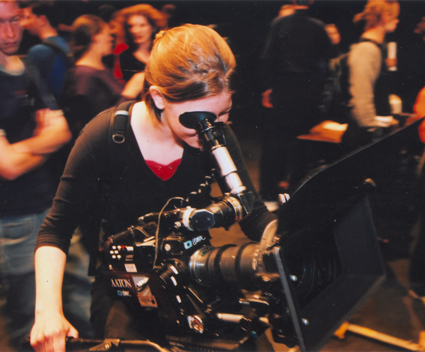
Melbourne Filmmaking Summer School
Each year for the last 19, Screen Studies at the University of Melbourne has offered an intensive summer school through their public engagement program and registrations are now open for the 2013 installment. With a strong practical component the course offers tuition in screenwriting, cinematography, directing actors, production and sound design, editing, digital effects, film music, screen language and documentary filmmaking. You can choose from a range of day sessions run by leading practitioners, undertake an introductory intensive (13 days) or the full Script to Screen course (19 days). There’s also a Cinematography Intensive that can be taken separately or as part of the Script to Screen course and taught by Ellery Ryan who has worked on films such as Angel Baby and Dead Letter Office. There are also screenwriting days such as Writing Short Films, Adaptation for the Screen and Writing for Television and a two-day Documentary making intensive.
Melbourne Filmmaking Summer School, Jan 7-Feb 1, Trinity College, Melbourne University, enquiries summerfilmschool@me.com http://www.summerfilmschool.com/
sidney myer performing arts award
Nominations are now open for the Sidney Myer Performing Arts Awards which aim to recognise outstanding achievement and ongoing contribution by individuals and companies in the areas of dance, drama, comedy, music, opera, circus and puppetry. The Individual Award is $50,000, The Group Award $80,000, while The Facilitator’s Prize, shining a little light on the often neglected enablers, is $20,000. The awards are decided by a judging panel based on nominations which can now be made online here. Deadline for nominations is Nov 9; http://www.myerfoundation.org.au
RealTime issue #111 Oct-Nov 2012 pg. web
© RealTime ; for permission to reproduce apply to realtime@realtimearts.net
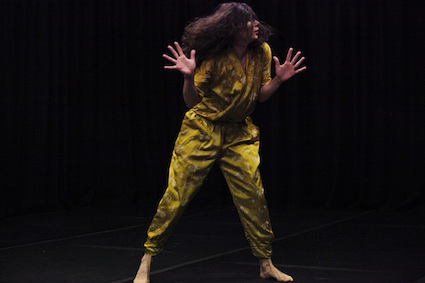
Deanne Butterworth, Twinships
photo Rachel Roberts
Deanne Butterworth, Twinships
twinships, deanne butterworth
Testament to West Space Gallery’s innovative programming is the inclusion of choreographer Deanne Butterworth’s Twinships, an installation and dance performance in collaboration with sound designer Michael Munson and lighting designer Rose Connors Dance. The work originally evolved during Butterworth’s Housemates residency at Dancehouse in 2011 where in order to augment her solo explorations she would invite people into her workspace for what she called Group:Meetings. From this grew an interest in the creation of a “twinning” of worlds, primarily the sonic and the physical. The original 45-minute performance has been reconfigured to operate as a sound, light and video installation during gallery hours with the full performance presented on Thursday and Friday evenings. The trio impressed with their work Dual Repérage in Threes presented during Dance Massive 2011 and Twinships looks to be a similarly meticulous and immersive exploration. See the review in RealTime 112.
Twinships, Deanne Butterworth, Michael Munson, Rose Connors Dance, West Space, Melbourne, installation Oct 19-Nov 10, performances October 25-26, November 1-2, November 8-9, bookings@deannebutterworth.com? www.deannebutterworth.com; http://westspace.org.au/
winner, mish grigor, firstdraft
Firstdraft Gallery is also offering some adventurous performance programming with Mish Grigor’s Winner. A playful critique of the culture of art prizes and a comment on the overwhelming number of TV talent shows, Winner asks five artists to pitch for a $1,000 prize in front of a live audience. The artists will not be able to use any visual aids and thus must convince the audience and judges through the power of words alone. A few days following the judges will publicly present their thoughts on the performances nominating three shortlisted artists who will have to expand on their original pitch. In true drawn out TV style, eventually the winner will be decided upon and awarded the cash prize. The five artist/contestants are Bonita Bub, Bonnie Cairncross, Emily Hunt, Hannah Furmage, Lucy Hall, Michaela Gleave, Nick Briggs and Peter Nelson with the judging panel comprising Mark Feary (Artspace), Sebastion Goldspink (Alaska) and Susan Gibb (Society).
Winner, Mish Grigor, Firstdraft, Sydney, Oct 24, 26-28; http://firstdraftgallery.com/
take up thy bed & walk, gaelle mellis
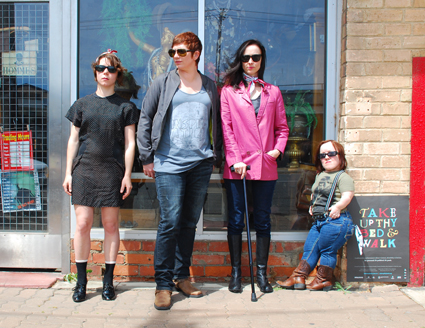
Kyra Kimpton, Jo Dunbar, Michelle Ryan and Emma J Hawkins, Take Up Thy Bed and Walk, Gaelle Mellis
photo Heath Britton
Kyra Kimpton, Jo Dunbar, Michelle Ryan and Emma J Hawkins, Take Up Thy Bed and Walk, Gaelle Mellis
Australia Council Creative Fellow Gaelle Mellis is about to present her major project, Take Up Thy Bed and Walk, at Vitalstatistix in Port Adelaide. Mellis, who has a disability herself, has been a long time advocate for access and inclusion for people with disabilities and is perhaps best known for her work with Restless Dance Theatre. The new work is based on a book by Lois Keith titled Take Up Thy Bed and Walk: Death, Disability and Cure in Classic Fiction for Girls exploring the representation of women and disability in literature. Mellis says, “We all remember reading books like Heidi and Seven Little Australians, but what we may not remember is this literature’s obsession with the disabled body. Disability, female transgression and punishment were portrayed side by side. Unlike views about women, society’s understanding of disability has not changed greatly since these Victorian novels were penned” (press release). The work also includes reference to the Punk/New Wave icon Ian Drury (disabled after contracting polio as a child) and his song Spasticus Autisticus written in defiant response to the 1981 International Year of Disabled Persons and subsequently banned by the BBC. Mellis has gathered an impressive team to realise the work including Ingrid Voorendt as co-director (from Ladykillers of which Mellis was founding member), Hilary Bell as writer and performed by Jo Dunbar, Emma J Hawkins, Kyra Kimpton, Michelle Ryan and Gerry Shearim. Mellis aims to build accessible features such as Auslan sign language and audio description into the fabric of the work. See the review in RealTime 112.
Take Up Thy Bed and Walk, Gaelle Mellis, Vitalstatistix, Port Adelaide, Oct 24-Nov 10; http://www.vitalstatistixtheatrecompany.blogspot.com.au/
pica – first amongst equals (part ii)

Elizabeth McAlpine, Black Noise (detail) 2006, Installation view, First Amongst Equals (Part I), Gertrude Contemporary 2012
photo Jake Walker, courtesy of the artist and Laura Bartlett Gallery, London
Elizabeth McAlpine, Black Noise (detail) 2006, Installation view, First Amongst Equals (Part I), Gertrude Contemporary 2012
Curated by Leigh Robb, First Among Equals is an exhibition with two iterations, the first in August at Gertrude Contemporary in Melbourne and the second at the Perth Institute of Contemporary Arts. It focuses on film, kinetics, colour, sound and time and features work made from 1936 to 2012. Playing with the concept of a group show, the exhibition is built around several pieces by UK artist Elizabeth McAlpine. Her website reveals that McAlpine’s practice spans film, photography and installation and the most impressive of her work involves neatly formal installations using Super 8 film projectors in which both projected image and projector-and-film-loop become a sculptural whole. At PICA she will be presenting a range of pieces including a two projector installation, a gramophone cast in plaster, a series of pinhole camera images and her collection of postcards of Big Ben—McAlpine seeking one card which displays every minute of the 12-hour clock. Her works are complemented by those from Christian Marclay who explores sound particularly in relation to records and phonography as well as moving image and time recently evidenced in his epic The Clock presented for the re-opening of the MCA in Sydney.
Similarly clear is the connection between McAlpine’s work and that of New Zealand artist Len Lye, one of the pioneers in scratch cinema involving direct manipulations of film (see RT92). The exhibition will also feature pieces by Australian artist Rebecca Bauman who explores kinetics and colour, and US artist Paul Pfieffer who works with video and the manipulation of media and found footage. The artworks are paired within the gallery space to create what the press release describes as “kaleidoscopic duets of colour, light, movement and sound.” McAlpine will also be collaborating with Perth architect Ariane Palassis to create an outdoor pavilion-for-one.
First Amongst Equals (Part II) curator Leigh Robb, PICA, November 3-Dec 30, http://www.pica.org.au
swedish for argument, uts gallery
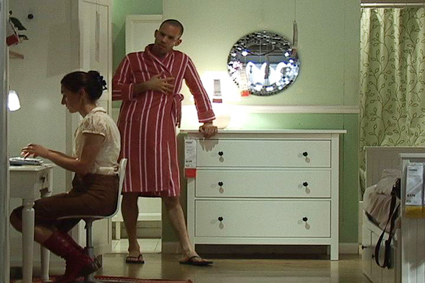
Guy Ben-Ner, Stealing Beauty, 2007
courtesy the artist and Gimpel Fils, London
Guy Ben-Ner, Stealing Beauty, 2007
At some stage, just about everyone has been pushed to near nervous breakdown during the construction of a flat-packed blond wood item using an Allen key. Personally, I can barely walk around IKEA without hyperventilating in anticipation of the stressful outcome. The latest exhibition at UTS Gallery, curated by Holly Williams, explores the IKEA phenomenon—its ubiquity (the press release says that 10% of current European children have been conceived on an IKEA bed), its models of production and its effect on global consumption. The exhibition features performance, video and installation with highlights including Guy Ben-Ner’s Stealing Beauty filmed without permission in an IKEA store where his family re-enact everyday home life (viewable on YouTube). In a performance for video, Tony Schwensen will compare Sweden’s historical dominance of Scandinavia with IKEA’s global retail share as the history of the company is read out loud simultaneously in Danish, Swedish and Norwegian and the artist attempts to construct an IKEA wardrobe without instructions. Also using performative video, Jess Olivieri with the Parachutes for Ladies will explore the choreography of moving through and against the flow of an IKEA store. Meanwhile Emma White has created reconfigurations of the iconic trademarked Allen key and Gary Carsley will redesign flat-pack furniture as an immersive installation. An artist talk and publication accompany the exhibition and there’s an IKEA Recovery Workshop to help us come to terms with anger-management issues,
Swedish for Argument, curator Holly Williams, UTS Gallery, Sydney, Oct 23-Nov 23; http://www.utsgallery.uts.edu.au/gallery/upcoming/swedishforargument.html
RealTime issue #111 Oct-Nov 2012 pg. web
© RealTime ; for permission to reproduce apply to realtime@realtimearts.net
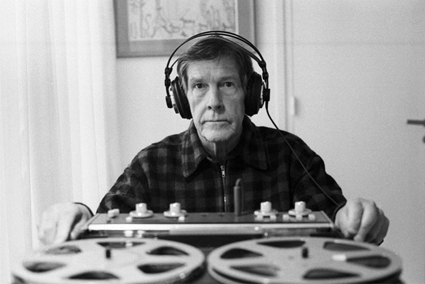
John Cage in Paris, 1981
courtesy Sydney Opera House
John Cage in Paris, 1981
The music world has pretty much thrown a year-long party for John Cage’s centenary. In Australia we’ve already seen significant celebrations by Clocked Out with The Cage in Us festival at the Judith Wright Centre in Brisbane (see preview and review). In Adelaide, composer Stephen Whittington presented a day-long celebration which included an eight-hour performance of ASLSP (As Slow As Possible) played on the Elder Hall pipe organ (see article), while Perth-based ensemble Decibel has, on several occasions, undertaken the massive challenge of performing all Cage’s Variations (see realtime tv interview with Cat Hope).
Now a major Sydney celebration will feature acclaimed US ensemble Bang on a Can All-Stars and our own Ensemble Offspring (see realtime tv interview). Presented by the Sydney Opera House as part of their Composer series (the first earlier in the year featuring Steve Reich), the mini-festival runs over two days, exploring Cage’s work and his legacy in four concerts and a lecture.
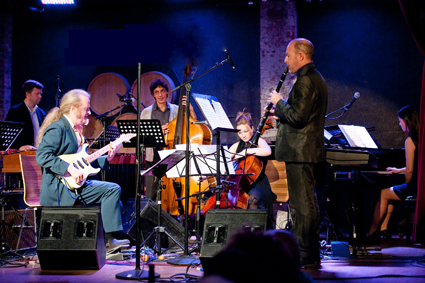
Bang on a Can All-Stars
photo Stephanie Berger
Bang on a Can All-Stars
The festival begins with John Cage and his American Descendants performed by Bang on a Can All-Stars featuring two of Cage’s seminal mid-career works, Indeterminacy and Variations 2. Following will be pieces composed by Bang on a Can founders Michael Gordon, David Lang and Julia Wolfe along with clarinetist-composer Florent Ghys, exploring the direct influence of Cage’s work on the ensemble.
The second concert The Music Of John Cage and Brian Eno will feature excerpts from Cage’s Improvisations, Sonatas & Interludes complemented by a special live arrangement of Brian Eno’s Music for Airports. Brian Eno, through his music, writing and cross-artform exploration is arguably one of the only contemporary composers to even come close to attaining the guru-like status granted Cage, so this juxtaposition seems apt.
In Permission Granted we will see Bang on a Can team up with Ensemble Offspring to further ride the ripple-effect of Cagean philosophy—beginning with the work that changed the world, Cage’s 4’33, which famously features three sections of non-playing, focusing on the actual sounds of the world around us with time as a framing device. After this aural cleansing the audience will be treated to works inspired by the kind of freedom 4’33 espouses, Dutch composer Louis Andriessen’s Workers Union, Australian composer (and student of Andriessen) Kate Moore’s Ridegway and US composer Terry Riley’s hypnotic minimalist classic In C.
No Cage celebration would be complete without a Musicircus, a cacophonous explosion of simultaneity and chance as multiple Cage pieces are performed together “on traditional and non-traditional instruments, with and without choreography” (press release), the actions dictated by the I-Ching, dice and coin tossing. This musical happening will be wrangled by Ensemble Offspring with a range of guest performers.
There is also a lecture and panel discussion led by Lyle Chan, a composer and musicologist (who is also, according to his website, a personal development coach and chrematist—someone who makes money via speculation and exchange rather than labour). In Lecture on Nothing, the title of one of Cage’s philosophical dissertations, Chan will explore “Cage’s conceptual practice, personal life and the way that they intertwined, influenced and created his creative legacy” (press release). Perhaps the talk could be followed by a screening of the Duchamp-Cage film excerpt Discs from the 1947 Hans Richter experimental feature Dreams That Money Can Buy?
The Composers 2: John Cage Centenary Celebration, Bang on a Can All-Stars, Ensemble Offspring, Sydney Opera House, Nov 2-3; http://www.sydneyoperahouse.com/
Bang on a Can All-Stars will also be performing in Melbourne presenting the Australian premiere of Field Recordings on November 5 and the Melbourne premieres of Eno’s Music for Airports plus David Lang’s sunray and Julia Wolfe’s Big Beautiful Dark and Scary on November 7. Field Recordings is Bang on a Can’s major new project, featuring nine newly commissioned works by Tyondai Braxton, Mira Calix, Florent Ghys, Michael Gordon, David Lang, Christian Marclay, Todd Reynolds, Julia Wolfe, and Nick Zammuto, formerly of The Books.
Melbourne Recital Centre – Elizabeth Murdoch Hall; Nov 5 & 7; www.melbournerecital.com.au
RealTime issue #111 Oct-Nov 2012 pg. web
© RealTime ; for permission to reproduce apply to realtime@realtimearts.net
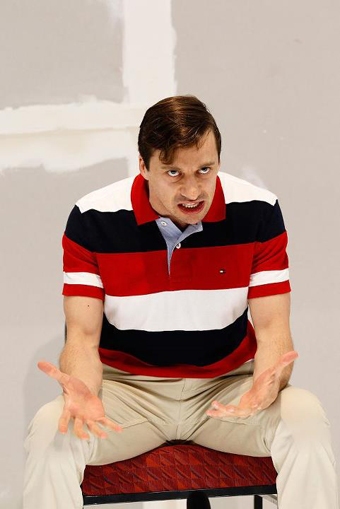
Richard Pyros, On the Misconception of Oedipus
photo Jeff Busby
Richard Pyros, On the Misconception of Oedipus
INCORPORATING TRIANGULATED DESIRE AND BOUNDARY TRANSGRESSION, FATAL SON-FATHER ANTAGONISM AND SEXUAL POSSESSION OF A BY TURNS IDEALISED OR DEMONISED MOTHER FIGURE, THE OEDIPAL DYNAMIC IS DEEPLY EMBEDDED IN WESTERN CIVILISATION.
Sigmund Freud marshalled this cultural preoccupation to reveal a particular historical manifestation of the Oedipal configuration: the bourgeois family of the late 19th and early 20th century. Even those of us unacquainted with the details of Freud’s notion of the Oedipus Complex will be familiar with its various incarnations in popular culture (Star Wars, Harry Potter and Psycho to name a few).
On the Misconception of Oedipus, a co-devised work from director Matthew Lutton, writer Tom Wright and designer Zoë Atkinson, is a 21st century post-Freudian ‘prequel’ to one of the best known narratives on this pervasive myth, Sophocles’ 5th century BC play Oedipus Rex. Whilst absorbing in its depiction of familial dysfunction, this new production struggles to present a story of predestination within a contemporary secular frame of chaos and choice.
The action takes place in three acts within the confines of a stark, windowless box. A reel-to-reel recorder in the corner bears impartial witness to the revelations that unfold, signalling the myth’s endless recording and reproduction in the modern age. Zoë Atkinson’s stage design embodies entrapment while evoking places where confessions are extracted: a therapist’s room, a tribunal or even an interrogation chamber.
The play opens to a preppily dressed Oedipus delivering an account of his carefree and loving childhood. Despite his clean-cut appearance and jovial reminiscences, there is a taut, unnerving energy to Richard Pyros’ portrayal of Oedipus, which soon gives way to raging sadism. As he recounts the warning of the oracle which predicts his coveting of his mother, we see his psychological fabric rip and his darkly aggressive urges surge forth.
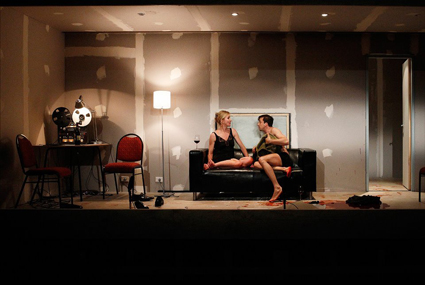
Natasha Herbert, Richard Pyros, On the Misconception of Oedipus
photo Jeff Busby
Natasha Herbert, Richard Pyros, On the Misconception of Oedipus
The second act turns to the story of his parents, Jocasta and Laius, who deliver a series of overlapping monologues exploring their emotional vicissitudes and the eventual conception of Oedipus. Natasha Herbert as Jocasta delivers middle-class restraint in the face of having her child taken away from her. This very restraint makes it hard to connect to her grief or believe her desire for motherhood in the first instance. This lack of maternal feeling is, perhaps, a very deliberate directorial choice to highlight the propensity for ‘blame’ projected on the mother figure in any Oedipal dynamic.
Daniel Schlusser’s Laius starts out with beguiling charm—even as his wife derides his propensity for cross-dressing and penchant for masochistic role-playing—which disintegrates into a fearful, angry force that eventually derails him. Schlusser creates a perturbed, protean figure who lingers in the mind long after his character’s demise.
In Freud’s theory, Oedipus’ ‘crime’ is his incomplete separation from his mother (manifest in their unwitting sexual consummation) which leads to his subsequently impossible relationship with his father (manifest in his inadvertent murder). Fuelled by this unresolved tension, Oedipus’ murder of Laius onstage appears pre-programmed: he bursts into the room and simply beats his father to death. It is an act of deviant excess that is presented without narrative justification. This seems to suggest that if his fate is predetermined then all vagaries of plot will ultimately lead to the same outcome.
At the same time, Oedipus’ actions appear as an extreme realisation of narrative agency whereby he shatters fundamental social boundaries, which he epitomises by stripping his father of his trousers, smothering him with them and then smashing his father’s head through a wall. This scene has an arresting visceral quality of systematic violence that appears predestined yet also calculated. Perhaps this is an attempt by the co-devisors to reconcile the conflicting narratives likely in any modern retelling of the Oedipal myth, by merging fatalism with the contingency of pure choice.
Tom Wright’s stylised prose of the first two acts is elegant, absorbing and immaculate. The final third of the play moves into hyperrealism, the dialogue taking on a heightened everyday quality, which is initially amusing in its flirtatious banter, but soon feels flaccid compared to the previous acts. With some fine tuning, the flippant dialogue could be a chilling juxtaposition with the scene’s significance: the naturalism of the mother and son’s flirtatious post-coital exchange becomes an attempt to normalise a reviled situation; it acts as an agent of denial to ensure that we then normalise it too. This leads to the viewer’s potential collusion in the moral quandary, making it that much more disturbing.
On The Misconception of Oedipus is a compelling and thoughtful work only let down by the prosaic treatment of the final act, which lacks incisiveness and merely dissolves into the ordinary. This intelligent, discomforting and complex exploration of the Oedipal myth is thematically consistent with Matthew Lutton’s previous works which have often explored men struggling with their nihilistic dispositions.
Perth Theatre Company and Malthouse Theatre: On The Misconception of Oedipus, devisors Zoë Atkinson, Matthew Lutton, Tom Wright, text Tom Wright, director Matthew Lutton, performers Natasha Herbert, Richard Pyros, Daniel Schlusser, design Zoë Atkinson, lighting Paul Jackson, composition, sound design Kelly Ryall; State Theatre Centre WA, Perth, Sept 5-15
This article first appeared as part of RT’s online e-dition Oct 23
RealTime issue #112 Dec-Jan 2012 pg. 32
© Astrid Francis; for permission to reproduce apply to realtime@realtimearts.net
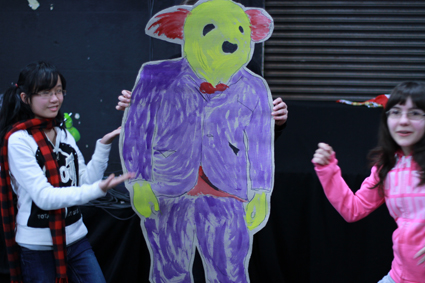
Arcade Assembly, Shopfront Contemporary Arts & Performance
photo Pollyanna Nowicki
Arcade Assembly, Shopfront Contemporary Arts & Performance
MAZES GET A BAD RAP. PRACTICALLY SYNONYMOUS WITH ANY COMPLEX SYSTEM THROUGH WHICH AN UNSUSPECTING PARTICIPANT MUST NAVIGATE, THEY HAVE PROVIDED STRESS-PROVOKING OBSTACLES FOR EVERYONE FROM THESEUS, 18TH CENTURY ARISTOCRATS AND HARRY POTTER TO PRACTICALLY EVERYONE WHO’S EVER PLAYED A COMPUTER GAME. AS MANY OF THE LATTER WOULD PROBABLY ATTEST HOWEVER, THERE’S A PECULIAR SATISFACTION TO BE GLEANED IN SUCCESSFULLY COMPLETING A MAZE.
Indeed, the effect of pacing the path of a labyrinth (technically a maze has multiple paths and points of exits, while a labyrinth is linear and possesses only one of each) has been shown to be so calming that it is used as an aid at the Center for Pain and Palliative Care at the National Institute of Health in the United States.
Described by Event Director Caitlin Newton-Broad as creating “a common ground (a maze),” Shopfront’s major production for 2012, Arcade Assembly, fused these ideas in a rich mixture of performance, artwork, music and video to create an interactive labyrinth for all ages, or “a confidential cure for the world” as one contributor put it in Shopfront’s literature. A preoccupation with circuitous paths is perhaps unsurprising, given the importance of contributions from students at the Intensive English Centres at Beverly Hills and Fairfield High Schools, no strangers to the linguistic maze of the English language, not to mention the cultural and bureaucratic ones attendant in creating a life in a new country.
It was this influence that perhaps led the company to incorporate the idea of Avatars into the project, small figures made to represent absent loved ones. After registering with Shopfront staff, collecting a Score Card to keep track of which activities were subsequently completed and watching a short video of messages to family and friends overseas made by young people studying at Beverly Hills IEC, participants had a chance to make an Avatar of their own. “Picture someone you want to see,” came the suggestion as children, parents, grandparents and Shopfront contributors crowded around a craft table to assemble a figure from corks, glue, sticky tape, construction paper, wool, pipe-cleaners and glitter.
With the brightly coloured results safely ensconced on the prize table, participants were ushered around to the main Shopfront performance space, or at least a curtained corner of it. The analogy with computer games seemed increasingly appropriate as participants were given a tutorial by Space Boy, a hyperactive performer tangled within a three-dimensional maze of red string beneath a UV light. Instructed to “Stop, Look and Listen” within the Arcade, while being ready to make new friends or meet old ones, the curtains were then drawn back to reveal a plethora of possible activities.
Towering cardboard constructions dotted the cavernous space of the former dance hall, the ambient sounds and beats of Michael Moebus (aka meem) flickering from multiple directions at once. Then a whistle sounded, launching a dance-off between Zombies and Birds(!) to a pumping soundtrack in the aptly named Dance Zone. Such set performances were interspersed with the opportunity to explore the space and participate in the many mini-games: to play foosball on a table decorated with Avatars, or check out the ‘real life’ Space Invaders of Alien Catapult—throwing balls at dastardly cardboard critters—or play with the Shadow Meetings & Haunted Houses display, spotlights cast against a series of cardboard spinners throwing a variety of simple yet vividly evocative scenes in silhouette against the wall.
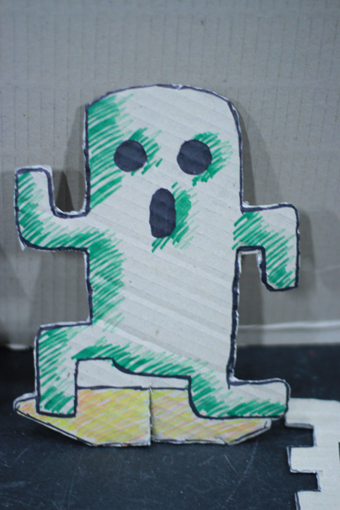
Arcade Assembly, Shopfront Contemporary Arts & Performance
photo Pollyanna Nowicki
Arcade Assembly, Shopfront Contemporary Arts & Performance
Further exploration led to mazes within mazes, some participants guiding a ball through a super-sized cardboard box maze, others forced to take their shoes off, do seven push-ups (no more, no less), or pick their noses within a giant game of Snakes & Ladders overseen by a young gentleman attired in silk Japanese dressing gown and sombrero. Others aided a rabbit in completing a cardboard puzzle, much to the chagrin of an irascible cat (don’t ask). A staircase led to the Sims Oracle, where participants selected Tarot cards under the guidance of a woman with piled coils of blue hair, the instructions printed thereon being yelled through a cardboard cylinder to another performer who then acted accordingly–examples including “take a photo,” “shake hands,” “fart”—in an effort to elicit a smile from one bemused child participant.
Then it was “game over, thank you for playing,” everyone being ushered out into the late afternoon sunshine for the scores to be tallied, winners receiving an Avatar of their own. Not that it was really about the winning of course, it being clear that passing through Arcade Assembly’s thoughtfully structured mayhem with a smile intact was prize enough.
Shopfront Contemporary Arts & Performance, Arcade Assembly, director Caitlin Newton-Broad, Outreach director, video Sarah Emery, performed by members of Shopfront, sound Michael Moebus (Meem), lighting Blair Dutney, gadgets & AV Grant Moxom, design Katja Handt & Jessica Sinclair Martin and Outreach artists Howard Matthew and Kevin Ng in collaboration with St George Mental Health Service, Beverly Hills Intensive English Centre, Fairfield Intensive English Centre, Lomandra School in Campbelltown; Carlton, Sydney, August 22-26
RealTime issue #111 Oct-Nov 2012 pg. 42
© Oliver Downes; for permission to reproduce apply to realtime@realtimearts.net
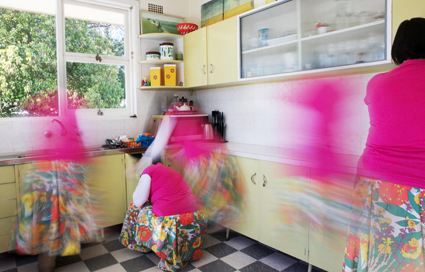
Julie-Anne Long, Something In The Way She Moves
photo Catherine McElhone
Julie-Anne Long, Something In The Way She Moves
FOR THE LAST FIVE YEARS, SYDNEY-BASED CHOREOGRAPHER AND DANCER JULIE-ANNE LONG HAS BEEN WORKING ON A BODY OF WORK ENTITLED THE INVISIBILITY PROJECT. IT WILL CONCLUDE WITH A FULL-LENGTH SOLO, SOMETHING IN THE WAY SHE MOVES, AT PERFORMANCE SPACE’S SEXES PROGRAM IN NOVEMBER (SEE INTERVIEW).
The Invisibility Project, according to Long, started life as a Fellowship proposal to the Australia Council Dance Board in 2007. The seed for the project was sown a couple of years earlier however. “I distinctly remember the day when this bunch of ideas that I was thinking about connected,” says Long. “I had this little eureka moment and thought, yeah, I could put that all together. And I went home and I wrote out this whole plan and it was called The Invisibility Project.”
So what exactly were the ideas that led Long to conceive The Invisibility Project? She explains: “Initially, it appeared to me that wherever I looked in the media, there were endless articles on the invisibility of middle-aged women, and it was all about the loss of whatever one ever had. It was quite noticeable how relentless the coverage was.” Even though Long didn’t agree with the tone of the reporting, the subject matter struck a chord with her: “It was something that I could identify with, not only in my everyday life but also as an ‘ageing dancer,’ a performer who is going to put herself, her body, on stage in front of people watching.”
The media coverage of the invisibility of middle-aged women might have served Long as a hook, as something she thought would be interesting to challenge as an issue. It didn’t, however, end up being the focus of her explorations once she received her fellowship and started to put her ideas into action. “I soon realised that I wasn’t really that interested in going down that track,” says Long. “Quite early on my interest shifted to all the great things that you can do when you are invisible.”
Long’s interest in exploring notions of middle-aged invisibility has extended far beyond the two-year period covered by the fellowship. In addition to working on the projects she initially proposed, in the following years she added new ones: for example, a series of solos as part of short works programs such as Campbelltown Arts Centre’s Folk Dancing (2009) and Performance Space’s NightTime: Everyday Hero (2010). She also showed work as part of Performance Space’s LiveWorks (2010) and Local Positioning System at the MCA (2012). As a result, two characters emerged that Long will be revisiting in her upcoming solo: Mumsy, an everyday mum in ill-fitting tracksuit pants and a T-shirt that has been washed a few too many times, and Val, The Invisible, a cleaning woman in a high-visibility safety vest which, curiously, renders her all but invisible.
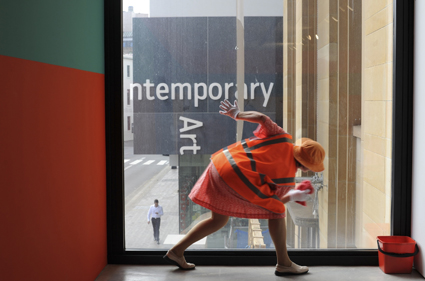
Julie-Anne Long, Val The Invisible, MCA, Local Positioning Systems, MCA & Performance Space
photo Heidrun Löhr
Julie-Anne Long, Val The Invisible, MCA, Local Positioning Systems, MCA & Performance Space
Some of Long’s Invisibility outings over the last few years have shown signs of the dancer’s signature style, mixing acerbic wit and an idiosyncratic movement language with a series of pop songs from yesteryear and an array of fabulous costumes. Anyone, though, who has witnessed Mumsy’s chilling dance, completely disfigured by a mesh orange bag over her head, and Val’s forlorn wanderings through the cavernous Carriageworks and MCA, will recognise that Long is exploring a dark streak in The Invisibility Project and is far from shying away from the project’s distinctly political dimension.
As for Something In the Way She Moves, the solo show in SEXES that will be the last instalment of The Invisibility Project, what can audiences expect? Long points out that the work is still evolving but that she thinks of it as a “short story collection. My aim is to bring together all the ideas I’ve explored in the various performances and events over the last few years and to reinvigorate that material.” The show, Long reveals, will consist of six episodes. True to its by-line, “everyday dances for an invisible woman,” each episode contains a number of dances alternating with versions of domestic task-based actions such as hanging out the washing, buttering bread and bringing in the shopping.
On stage with Long will be dance artist Narelle Benjamin as her sidekick, mini-mum, part production assistant, part target of both affection and disdain from some of Long’s characters. “She’s a bit like Dame Edna’s Madge,” says Long, laughing. And after a pause, “But hopefully not as hard done by.”
Performance Space, SEXES: Julie-Anne, Long, Something In The Way She Moves, Sydney, Nov 14-16; www.performancespace.com.au
RealTime issue #111 Oct-Nov 2012 pg. 32
© Martin del Amo; for permission to reproduce apply to realtime@realtimearts.net
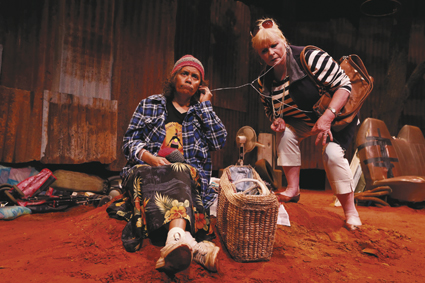
Head Full of Love, QTC
photo Rob McColl
Head Full of Love, QTC
THE SUBJECT OF LOVE IS WELL-TRODDEN TERRAIN, BUT TWO NEW AUSTRALIAN WORKS FROM THE QUEENSLAND THEATRE COMPANY AND THE DANGER ENSEMBLE OFFER ORIGINAL APPROACHES TO EXPLORING PLATONIC LOVE AND FRIENDSHIP.
The QTC production of Alana Valentine’s Head Full of Love focuses on an unlikely friendship between two women: a white suburban housewife from Sydney and an Indigenous Elder from a remote community in the Northern Territory. The Danger Ensemble’s new work, Loco Maricon Amor, deconstructs the unconsummated and passionate friendship between playwright Federico García Lorca and painter Salvador Dalí.
Valentine is Australia’s premiere verbatim theatre playwright and Head Full of Love is a result of years of consultation with community in Central Australia, including the Purple House, a community renal dialysis unit, the Alice Springs Beanie Festival and the Ngaanyatjarra Pitjantjatjara Yankunytjatjara (NPY) Women’s Council. The work debuted at the Darwin Festival and has been revived as part of QTC’s transformation under Artistic Director Wesley Enoch.
Enoch’s gift to Australian theatre has been the creation of personal stories that seek to heal the seemingly intractable grief and shame that lie between black and white Australia. Head Full of Love has all of his trademark warmth and sense of pathos. Roxanne McDonald as Tilly and Collette Mann as Nessa are both irresistibly charming. Valentine deftly navigates cross-cultural clichés. Nessa moves from white anxiety, “Do I start with sorry,” and Tilly from black cynicism, “Are you a missionary, a mercenary or a misfit?” to a shared realisation that they are both disconnected from their families and exiled from their homes.
Although Head Full of Love is based on the interviews undertaken during creative development, the form is a gentle magic realism. The play slides from naturalism into a fantastical world, climaxing with a ritualistic presentation of knitted beanies placed reverentially on hip-high hat stands. The play closes with the death of Tilly, who entreats Nessa to take her identity and her family responsibilities in order to avoid her son returning her to psychiatric care. That this awkward plot device works is a tribute to the power of the production, as Head Full of Love left me with a sense of hope and continuity that lingered for days.
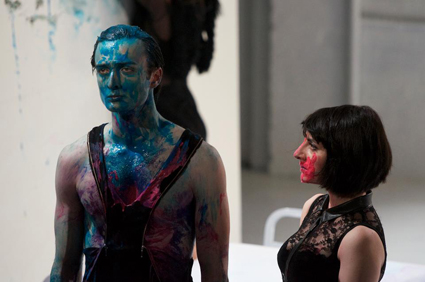
Loco Maricon Amor, The Danger Ensemble
photo Morgan Roberts
Loco Maricon Amor, The Danger Ensemble
Loco Maricon Amor shares with Head Full of Love an unashamed sense of purpose. Auteur director Steven Mitchell Wright reclaims ‘experimental’ as an avant-garde clarion call and dares his audience to “react.”
The putative sexual relationship between Lorca and Dalí has been a zeitgeist fetish since the Paul Morrison film Little Ashes in 2008. In Loco Maricon Amor an old and very ill Dalí taunts a plaintive young woman, recounting and re-enacting key moments of his relationship with his wife and muse Gala and the martyred playwright Lorca. The young woman is the moon, an observer of love and a witness to the unfolding disintegration of human passion, sex and emotion onstage.
Every detail of the piece is sharply planned, from the white pop art set to the cane with its rectangular gold hilt brandished by Gala. The encounters between the historical figures are interspersed with interrogations led by a chorus of three singers, belting out deconstructed standards from Doris Day to Beyoncé that lift the energy of the show into rock concert explosiveness.
The structure of the work is self-consciously circular with sequences that recycle and re-set, cribbed from the correspondence between Dalí and Lorca, symbols from surrealist art and Lorca’s theatrical masterworks. What drives the piece is the passionate intensity of the performers, who are brave and extraordinary. Every surface of their bodies is stripped, painted and exposed and they hold nothing back.
Loco Maricon Amor reads best as a choreographic poem, but it suffers from the ambition of its manifesto. Like the girl with the curl on her forehead, when it is good, it is really, really good. But, one awkward composition, one too many repetitions and the audience steps out of the pulsating action and the show is revealed to be merely a chorus of actors painting themselves and a white set with neon splashes of colour.
There are attempts to lighten the mood and pace through the personable character of the moon and short sequences that are replayed, mocking the intensity of the show, but they are not quite sufficient to leaven the earnestness. I have no doubt that the next iteration of the work will be tighter and more balanced. Experiencing Mitchell Wright’s obsessive mashing aesthetic is like eating too much chocolate in one sitting, an addictive overload, but one that always leaves you wanting more.
Queensland Theatre Company, Head Full of Love, writer Alana Valentine, director Wesley Enoch, performers Collette Man, Roxanne McDonald, designer Simone Romaniuk, lighting Ben Hughes, composer, sound Brett Collery; Cremorne Theatre, QPAC, Brisbane, July 7-Aug 11; The Danger Ensemble, Loco Maricon Amor, director, designer Steven Mitchell Wright, performers, co-devisors Chris Beckey, Caroline Dunphy, Thomas Hutchins, Lucy-Ann Langkilde, Polly Sara, Peta Ward, Bianca Zouppas, dramaturg Chris Beckey, lighting Ben Hughes, strings Lyndon Chester, co-designer Xani Kennedy, co-presented with Metro Arts; Sue Benner Theatre, Metro Arts, Brisbane, Aug 17-Sept 1
RealTime issue #111 Oct-Nov 2012 pg. 41
© Kathryn Kelly; for permission to reproduce apply to realtime@realtimearts.net
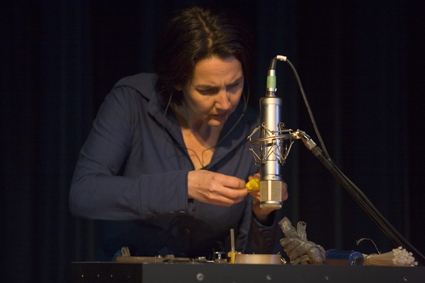
Tamara Saulwick, Pindrop
photo Ponch Hawkes
Tamara Saulwick, Pindrop
PIN DROP CAME TO PERFORMANCE SPACE DRESSED IN ACCOLADES AND AWARDS, MOST NOTABLY MELBOURNE’S 2010 GREEN ROOM AWARD FOR OUTSTANDING PRODUCTION. IT IS MINIMALIST, IMMERSIVE THEATRE, THE STAGE QUITE BARE AND PERFORMER SAULWICK OFTEN STATIONARY AT A SMALL TABLE AS PETER KNIGHT’S EXTRAORDINARY SOUND DESIGN CARRIES THE PERFORMANCE.
Built around a series of audio interviews, Pin Drop is an exploration of fear. The real life stories it draws on range from accounts of violence through to false alarms. This sort of material has potential for suspension of belief or at the least banality because we have been here so often before—in this darkened alley or empty house—but Saulwick’s crafting is so refined that we remain on a knife edge for the entire show. Everyday objects on a small table—scissors, cable ties, sticky tape—conjure a domestic, suburban context. A place of neurosis perhaps, but equally one of terror, and most significantly a place where neurosis and terror are not mutually exclusive. Saulwick’s masterstroke is to use as few pointers as possible so the space we inhabit most of all is our own imagination. The objects and anecdotes are triggers and mnemonics into our deepest fears and worst stories. Saulwick’s movements are restrained, yet her presence is riveting. She is everywoman, at once participant and narrator. Her gestures and facial expressions are mostly preoccupied with the enigmatic interior.
Knight’s production is more visceral and engaged than mere soundtrack. Footsteps echo around the room. Saulwick speaks, yet you aren’t always sure where the live text ends and the pre-recorded begins. A sequence using the objects becomes high drama as ordinary noises treated with feedback become signifiers of doom. Silence is one of the most powerful sounds of all. Where you hear the pin drop.
Bluebottle’s set and lighting are just as intimate, as well as adept in the use of absence. When the performer is highlighted, you seek as much meaning in the blackness around her, as you do in her face. The lights are frequently so dim that you strain to see in the dark. What was that? My mind playing tricks on itself? Or is it just my imagination? Yes, it’s theatre, at its best a psychic state where fantasy and reality are one and the same.
In a climate that favours research over production, it is immensely gratifying to see such finely honed work. Time can wear things out, but Pin Drop’s two years of outings has surely worked in its favour. In some ways programming RRAMP, featuring Lisa O’Neill, Peter Nelson and Christine Johnston centrestage, was an unusual, if not risky, juxtaposition. Yet it paid off, even if Performance Space’s description of the Show On season as “contemporary performance that focuses on audience participation and the intersection of art, life and popular culture” lacks concision. Pin Drop and RRAMP (incidentally neither participatory) were like two houses in the same street, with very different tenants and design.
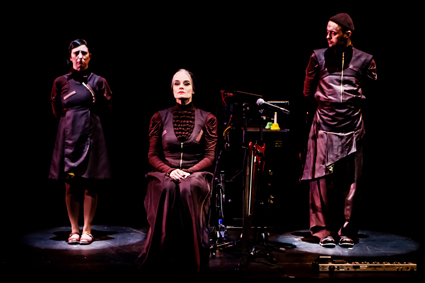
Lisa O’Neill, Christine Johnston, Peter Nelson, RRAMP
photo Sean Young
Lisa O’Neill, Christine Johnston, Peter Nelson, RRAMP
The darkness of Johnston’s persona is more about the loneliness of the outsider, the strangeness and wonder of life itself. Her suburban childhood, as with previous shows Decent Spinster and Fluff, is her font. In Rramp: The Collector, the Archivist and the Electrocrat she collaborates with long-time associates O’Neill and Nelson, each playing those characters in an “electronica dance metal rock set.” Animator Ahmarnya Price refreshes the team. Her projected illustrations of life in a chook run are dynamic, engaging and central to the work.
Johnston’s observations of her childhood chickens become epic: her first lessons in life, death, friendship and society. The collection of these stories is the show’s narrative thread, echoed visually by a series of jars used as repositories for all sorts of things, from memories to bones. A standout for me was the song—also wittily illustrated by Price—about receipts in files in boxes in the bedroom. It’s Johnston at her crazy, astute best, magnifying the everyday. She is a fine lyricist, as well as singer, with a unique vision.
Selena Cochrane’s elegant, quirky costumes meet the standard, which has a grandeur even while being utterly personal and idiosyncratic. There is the usual deadpan delivery, and Johnston’s Collector is Spinster enough for me to wonder why the line between the two has not been alluded to more. O’Neill is less of a stooge and Nelson’s musical skills more evident. Johnston’s extraordinary vocal abilities with birdcalls and singing the visual weren’t fully called upon in this production. Perhaps they will be as the work continues to be performed. Rramp could mature into one of Christine Johnston’s best performances yet.
Lisa O’Neill, Christine Johnston and Peter Nelson have recently titled their collaborative team RRAMP House.
Performance Space, Mobile States & Performing Lines: Pin Drop, creator, performer Tamara Saulwick, design & production Bluebottle (Ben Cobham & Frog Peck), movement Michelle Heaven, composition, sound design & operation Peter Knight, costume design Harriet Oxley; Lisa O’Neill & collaborators, RRAMP—the Collector, the Archivist & the Electrocrat, Christine Johnston, Lisa O’Neill and Peter Nelson, animations Ahmarnya Price, Performance Space, Carriageworks, Sydney, Aug 1-4
RealTime issue #111 Oct-Nov 2012 pg. 40
© Fiona McGregor; for permission to reproduce apply to realtime@realtimearts.net
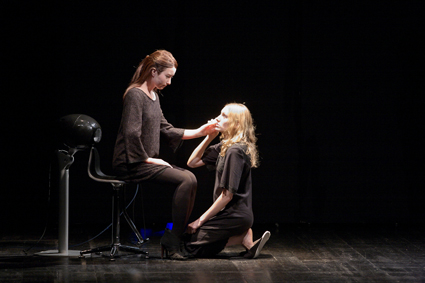
Geminoid F, Bryerly Long, Sayonara: Android-Human Theatre
courtesy the company
Geminoid F, Bryerly Long, Sayonara: Android-Human Theatre
ONE OF THE MOST BLINDLY ACCEPTED NOTIONS IN POP PSYCHOLOGY OF RECENT YEARS HAS BEEN THAT OF THE UNCANNY VALLEY. THE THEORY SUGGESTS THAT OUR IDENTIFICATION WITH ROBOTS INCREASES AS THEY BECOME MORE HUMAN-LIKE, BUT DROPS AWAY SHARPLY ONCE A CERTAIN LEVEL OF ALMOST-BUT-NOT-QUITE SIMILITUDE IS REACHED.
Since Masahiro Mori first put forward the concept in 1970 research has been remarkably thin, and much of it refutes the proposal, yet it continues to be taken as fact by most who come across it. Because robots are creepy, right? To my mind the readiness with which we embrace the Uncanny Valley has cultural roots that edge dangerously close to naturalising discrimination.
japan: robot compassion
Hiroshi Ishiguro and Oriza Hirata’s “android-human theatre” is a case in point. The former is the world’s leading professor of human-like robotics, the latter a theatre director acclaimed for developing new performance methodologies based around an understated naturalism. Both have been collaborating for some years, exploring the possibilities of a theatre practice involving androids as actors, and their work Sayonara recently brought them to Melbourne.
The response to the work demonstrated the differing expectations that various cultures impose on the automaton. In western Judeo-Christian tradition, there is almost always something suspicious about the artificial person. Frankenstein’s monster and the Terminator are the two most familiar examples of the perils of taking the creator’s place, and posit the inevitable uprising and rebellion of machines against their makers. In contrast, according to Ishiguro, the image of the robot in Japan is more often one of companionship and exchange, which he traces to the Shinto and Buddhist traditions which still form the basis for much of his society’s imagining of the natural world. These categories of human/animal/robot are much less rigidly policed, he says.
And so Sayonara isn’t concerned with maintaining the otherness of the automaton, but with the possibilities of compassion, connection and transcendence it may offer. A young girl (played by Canadian actor Bryerly Long) is confined to her home with a fatal illness. Her parents have provided her with a robot caretaker (Ishiguro’s Geminoid F), who sits by her side and reads poetry from across several centuries and continents. Their exchanges skirt delicately around issues of mortality, impermanence and loneliness. In the second act the girl is gone, and the android is visited by a technician who is tasked with locating her to an area near Fukushima too irradiated for humans. Her new job will be to act as a surrogate for our mourning, praying for the dead in our stead.
We’re a long, long way from vengeful machines, here. The subdued, sparse fragility of the performance, its minimal visual palette and the way technology is presented mostly as a vehicle for poetry comes as a surprise to anyone steeped in the iconography of the untrustworthy robot. If an audience member experiences discomfort watching Ishiguro’s creations—and there was no evidence of such unease the day I attended—then it will act as a barrier against engagement with the very serious themes he and Hirata are interested in. And if the Uncanny Valley does exist, then it is, to Ishiguro’s mind, not a natural necessity but a cultural prejudice, something to get over.
china: internalising capitalism
Can we draw a similar line to the representation of China in Australia today? Much writing and public discourse revolves around the idea of the nation as a superpower, demanding the deployment of warships to monitor its actions, a constant eye kept close upon it. The reality for many millions living on mainland China is of a vastly different order; the majority scoff at the idea that their country is a superpower, since it can’t yet provide running water or electricity to so many of its citizens.
Fight the Landlord is a keen-witted take on the lived experiences of an aspirational Chinese society rent by deep fractures. The work, which unites Ireland’s Pan Pan Theatre and Beijing Square Moon Culture Company, presents three young women battling one another via the card game of the work’s title, drifting away in between hands into comic vignettes, heated debates and satirical pontification. The subjects of their conversation are seemingly superficial—gossip magazines, celebrities, housing prices and dating—and their constant clowning adds to this lightness. But the current underlying all of this only gradually becomes clear. Contemporary Chinese society, for this middle class, is one in which competition is demanded in every sphere of life, where people have internalised the idea that to get ahead you have to push someone else down, where the differences between yourself and your neighbour are the key to success. It’s not hard to see a pointed critique of an emergent capitalism here, and in thinking through the work’s subtext it’s equally easy to see its relevance to Australia of 2012.
The design of Fight the Landlord virtually commands this engagement, too. The audience is seated on stage, in the round, immersed in a festive riot of plastic bamboo trees, fairylights and screens upon which surtitles appear. The players sit at an oversized red table, but just as often clamber under or over it and through the legs of the onlookers. It’s certainly the most striking reinvention of Arts Centre Melbourne’s Fairfax Studio I’ve seen—the sort of staging that drew gasps as attendees shuffled into the auditorium.
east timor: post-colonial angst
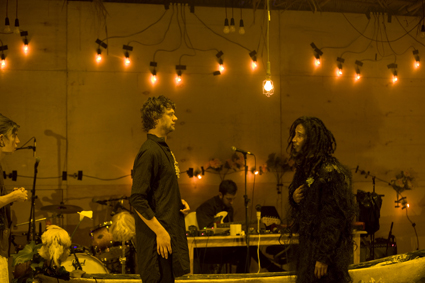
Doku Rai, The Black Lung Theatre and Whaling Firm, Liurai Fo’er and Galaxy
photo Ponch Hawkes
Doku Rai, The Black Lung Theatre and Whaling Firm, Liurai Fo’er and Galaxy
There were similar responses as people arrived at Doku Rai, a collaboration between Melbourne’s Black Lung Theatre and Whaling Firm and Timor Leste companies Liurai Fo’er and Galaxy. Anyone who’s caught a Black Lung show before will be used to their astounding design aesthetic, of course. In this case, the audience enters the space in the middle of things, a shambolic band raising raucous rock hell amidst a ramshackle arrangement of plants, a canoe-bathtub, threadbare rugs, carved icons, trinkets, smoke and light.
It takes a while before anything resembling a narrative presents itself, and it does so in furtive, sideways steps. The title (and subtitle, “you, dead man, I don’t believe you”) refers to a curse which can be cast on an enemy and which will result in their death. In this case a doku rai is cast by a man against his brother, but the dead man keeps returning from his grave, requiring another murder to send him back. The cycle keeps repeating, and goes from horrific to bleakly comic in turns, the hundreds of deaths meted out against the sorry figure attaining a level of excess that can’t help but result in laughter.
At the same time a counter narrative imposes itself—that of the Australian director attempting to piece the production together. He’s a grotesque, a shouting, addle-brained colonialist whose idea of collaboration is really a one-way thing. Rather than engage in a conversation with his counterparts, he sees them as objects to be manipulated, and cultural curiosities to be exploited.
Unfortunately this second element to the work isn’t realised with nearly as much acuity as the first—the director is such an inflated monster that he acts purely as an object of ridicule, and the thread serves in some way to safeguard against the possibility of similar breakdowns of communication within the work’s own development. Most of all, it affords its audience the satisfaction of recognising a dangerous mode of cross-cultural engagement without making us complicit in that danger itself. We’re never asked to investigate our own assumptions or desires, but simply to disapprove of someone else’s.
Beyond this, however, does lie a thick and thorough dialogue with the recent history of one of Australia’s closest neighbours, both politicised and aestheticised with remarkable effectiveness. As the result of several months working together, the various artists here have forged a connection that should be admired, and which hopefully will continue to develop in intriguing and strange new ways.
See Vicki Van Hout’s response to Doku Rai.
Arts Centre: Seinendan Theatre Company and Osaka University, ATR Hiroshi Ishiguro Laboratory, Sayonara: Android-Human Theatre, writer, director Oriza Hirata, performers Geminoid F, Bryerly Long, Tadashi Kaizu, technical advisor Hiroshi Ishiguro, design Itaru Sugiyama, lighting Aya Nishimoto, robot direction Takenobu Chikaraishi, Fairfax Studio, Arts Centre, Aug 24-25; Pan Pan Theatre Company and Beijing Square Moon Culture Company, Fight the Landlord (Do Di Zhu), writer Sun Yue, director Gavin Quinn, performers Bai Shuo, Sun Yue, Wang Jinglei, designers Aedín Cosgrove, Gao Yiguang; Fairfax Studio, Arts Centre, Aug 30-Sept 1; Arts House: The Black Lung Theatre and Whaling Firm, Liurai Fo’er and Galaxy, Doku Rai (you, dead man, I don’t believe you), director, designer Thomas M Wright, performers Liam Barton, Etson Caminha, Gareth Davies, Melchior Dias Fernandes, Osme Gonsalves, Thomas Henning, Laca Ribeiro, Vaczadenjo, Wharton-Thomas, lighting Govin Ruben, video Sequencer Amiel Courtin-Wilson, translator Elizabeth Adams, producer Alex Ben-Mayor, Arts House, Meat Market, Melbourne, 29 Aug – 2 Sept
RealTime issue #111 Oct-Nov 2012 pg. 38
© John Bailey; for permission to reproduce apply to realtime@realtimearts.net
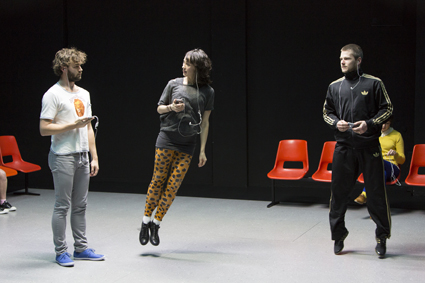
Rennie McDougall, Harriet Ritchie, Alisdair Macindoe, Conversation Piece, Lucy Guerin Inc
photo Brett Boardman
Rennie McDougall, Harriet Ritchie, Alisdair Macindoe, Conversation Piece, Lucy Guerin Inc
A LINE OF ORANGE PLASTIC CHAIRS, A WHITE FLOOR, STERN ROWS OF FLUORESCENT LIGHTING ABOVE: YET ANOTHER MINIMALLY MUTABLE, LIMINAL SPACE IN WHICH A THEATRE LAB TESTS HUMAN BEHAVIOUR. THE TOOLS WILL BE VERBAL IMPROVISATION AND STRUCTURED DANCE. THE TEST ANIMALS, THREE DANCERS AND THREE ACTORS. THE SUBJECTS: [1] THE STRUCTURES OF SOCIAL CONVERSATION; AND [2] THE THEATRE/DANCE NEXUS.
Three performers (later revealed to be dancers) arrive onstage chatting amiably and before long are riffing on a string of subjects that will become interconnected across the evening’s performance. Tonight’s improvised discussion from Alisdair McIndoe, Rennie McDougal and Harriet Ritchie focuses on birthmarks, male nipples, body hair—”beards are in,” a bearded lady and a hairy baby—and “How far have we evolved?”
The performers have been recording their own strands of the conversation on mobile phones which they then pass to three more performers. The new trio (actors Matthew Whittet, Alison Bell, Megan Holloway) listen to the recordings and reproduce them, standing still and with firm if neutral accentuation. What they capture is the structure of the peculiar turn-taking, trumping, affirmations and rhythms of the original conversation.
Then the dancers dance while the actors keep speaking as well as offering small complementary gestures, hands passing across faces as if sharing a communal, ritualistic language without obvious meaning, but resonant with the communality of the show’s opening. Group movement will return as a motif, although in different forms.
From here on, the opening dialogue is subject to various treatments yielding fascinating outcomes. A single strand of dialogue, shorn of responses, becomes a scornful monologue, or half of an overheard phone conversation, a backwards ‘foreign’ rendition or an interpretation. We fill in the gaps but meaning is newly charged each time. With the seats realigned, these variations are performed as if overheard in a bus station waiting room, the conversation sometimes forced on unwilling listeners. Non-verbal communality is re-achieved when the i-Phones become musical instruments and the performers a quirky band, their bodies mimicking actual playing, one performer, for example, very effectively strumming his phone as guitar. (Phone and sound correlations throughout are excellent thanks to sound designer Robin Fox.)
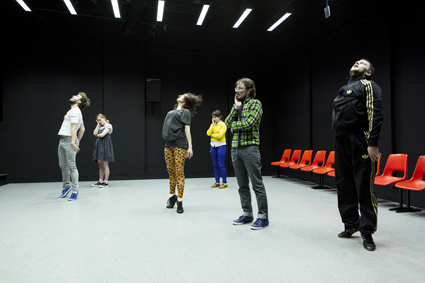
Conversation Piece, Lucy Guerin Inc
The show takes a threatening turn when one performer (McIndoe) brutally invades another’s (Whittet) space commencing with a hand on knee and then a leap onto his lap while the victim keeps churning out words regardless, until the silent antagonist forces him to the ground, stands on him and unplugs him. You could sense separation anxiety coursing through the audience like an involuntary Mexican wave.
Things can only get worse, and they do when apparently senseless violence is followed by behaviours neurotic and psychotic. Whittet will use words to reduce McIndoe to gestural frustration and wordless impotence and then McIndoe will ‘murder’ all save Whittet, hanging their unplugged phone above limp bodies.
Prior to this grim resolution, we witness one actor on her own mad trajectory obsessively filming a male dancer with her phone or free-form cavorting as the rest of the cast dance neatly along two sides of the stage. As well, a sense of conversation as the generator of exclusion rapidly escalates in a new phase in which, for example, an actor takes the words of the original innocent conversation and turns them into weapons, improvising caustic responses to those utterances: “You like talking about nipples, don’t you? Lactation from a mole! A scary monkey child? You’re up yourself.” Our memory of a conversation now cruelly un-pieced plays a crucial role in the show. As it ends we hear those initial words in all their benign clarity.
It is sometimes said that violence ensues when words run out. Here the words are toyed with, corrupted and exhausted, and the body asserts itself, but no longer in the safe house of dance. Of course it’s a fallacy to claim that the dancing body is inherently truthful or morally superior to the speaking body, although it might be able to express some things that are beyond words. The body, and dance no less, can lie with its own language and assert itself psychotically and fascistically. I doubt Lucy Guerin is a dance romantic given that the ambiguities of the relationship between words and body are writ large here and dance, in the end, offers no salvation (her Human Interest Story is similarly bleak). That said, I wondered why dance didn’t play a more prominent role improvisationally, beyond its structural provision of providing a certain fragile communality. Perhaps that was determined by the limitations of the dance/theatre experiment and there’s no denying that movement underpins Conversation Piece and is tightly correlated with the unnervingly rich dance of words.
For her Belvoir commission Lucy Guerin has created a powerful dance/theatre hybrid (the other I can recall is choreographer Anouk van Dijk’s [see article] very different collaboration, Trust, with playwright and co-director Falk Richter for Berlin’s Schaubühne Am Lehniner Platz [RT95]). Guerin’s verbally extrovert dancers were wisely chosen, while the three actors got to prove their improvisational skills with words in extremis towards the show’s end. Conversation Piece makes the mind work, the audience delighting in its play with their intelligence as it draws into consciousness their inherent knowledge of how talk works and they witness the palpable physicality that is ambiguously entwined with it. Just how funny (very on the night I saw Conversation Piece), how grim (apparently not every night), how meaningful each performance becomes I imagine is determined by the tone and content of the initial conversation while the predetermined dance structure and improvisation strategies nonetheless incline the work into dark, unplugged territory where smart phones hang in indeterminate space obsessive-compulsively chatting with each other. Test result: social conversation prognosis, bad; dance/theatre nexus, excellent.
See the interview with Lucy Guerin about Conversation Piece and her new work Weather for the 2012 Melbourne International Arts Festival in RealTime 110.
–
Belvoir: Lucy Guerin, Conversation Piece, choreographer, director Lucy Guerin, performers Alison Bell, Megan Holloway, Alisdair Macindoe, Rennie McDougall, Harriet Ritchie, Matthew Whittet, set & costume designer Robert Cousins, lighting Damien Cooper, sound design Robin Fox; Belvoir Theatre, Aug 29-Sept 16
RealTime issue #111 Oct-Nov 2012 pg. 37
© Keith Gallasch; for permission to reproduce apply to realtime@realtimearts.net
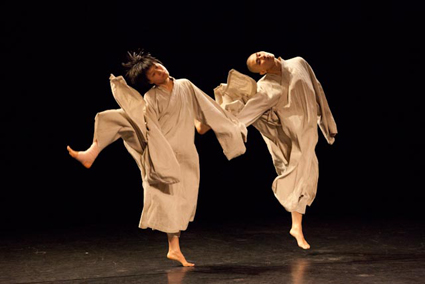
Tao Dance Theatre, Weight x3 / 2 Part 1
photo courtesy the company
Tao Dance Theatre, Weight x3 / 2 Part 1
SYDNEY SPRING, CURATED BY SYDNEY DANCE COMPANY ARTISTIC DIRECTOR RAFAEL BONACHELA, PROVED HUGELY POPULAR THIS YEAR, AND A FINANCIAL SUCCESS, ACCORDING TO PRESS RELEASES AND MEDIA REPORTS. WE THOUGHT THE PROGRAM DISTINCTLY PALLID COMPARED WITH THE BRIGHT OFFERINGS THAT GRACED WENDY MARTIN’S 2011 THEMATICALLY RICH PINA BAUSCH PROGRAM WITH DV8 PHYSICAL THEATRE (HELPMANN AWARD WINNER 2012 FOR BEST DANCE WORK, FOR CAN WE TALK ABOUT THIS?), LES BALLETS C DE LA B AND ISRAEL GALVÁN AMONG OTHERS, WHILE THIS YEAR’S AUSTRALIAN CONTENT, CLOUDS OVER BERLIN EXCEPTED, LOOKED DECIDELY GREY—UNDERDEVELOPED, NOT TO MENTION UNDER-RESOURCED.
The best work in the program from choreographer Tao Ye’s Tao Dance Theatre (China), was the first, Weight x3 / 2 Part 1, in which a male/female pair in loose clothing responded to Steve Reich’s Phase with elaborately timed and spatialised tandem walking, much of it hand in hand. The recurrent patterning, bodies relaxed but firmly erect, became more expansive and complex—heads flicked sharply to the side, legs momentarily raised and flexed at the knee, high kicks executed without interruption to flow, and a roll back onto the heel before stepping forward providing sudden propulsion. The subtle transformations in movement fitted beautifully with Reich’s phase shifts. When the dancers eventually ceased holding hands they still moved in parallel until they bumped into each other, a brief shock of a moment, a spell broken but then recast.
The second work, Weight x3 / 2, Part 2 , featured a female dancer as warrior twirling a long spear-like weapon, the speed increasing until she had conjured a bronze shield. However, a limited set of repeated movements and an unconvincing relationship with the music could not lift the work above tedium. The third piece, 2, focused on floor work with two dancers in grey costumes, mutually prostrate, not in sync but exercising similarly restless moves. They gradually assume postures of repose, heads resting on hands, elbows to the floor. Eventually they temporarily overcome gravity, walking and rocking in squat positions, executing shoulder stands and rolls, before returning to inertia—just when we hoped they would break free. The dancers were doubtless skilful but Tao Ye’s choreography was short on inventiveness.
iou projects: six solos and a bbq
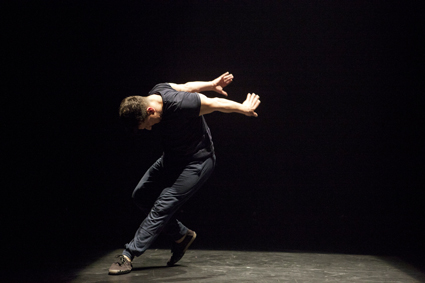
Anton, IOU
photo Jess Bialek
Anton, IOU
The presentation of a selection of short solo works by Sydney dance artists looked admirable on paper, but in reality it hardly suggested a serious vote of confidence in the local dance scene. Poor production values were barely compensated for by an overtaxed if inventive lighting designer (Benjamin Cistern) working with smoke effects. The works themselves were sometimes short to the point of miniature and several were quite underdeveloped. IOU felt like a workshop showing if, fortunately, not without rewards.
Anton’s semi-improvised Supermodern 2.1 is danced antically in a constrictive pool of light, his limbs moving so fast he appears to have been strobed, fingers fluttering about his ears, body spinning, gesturing right and left as if attempting to broaden his boundaries. It’s enigmatic, distinctive and hypnotic, and apparently semi-improvised from an aspect of his recent work at Parramatta Riverside, Supermodern Dance of Distraction, a show that might have benefited both Anton and the Spring Dance audience had it transferred to the Opera House. In Awaken Absence, For Josh, Craig Bary danced on/with/to a chair, initially sitting on it in a variety of ways and then moving away, responding to the chair at a distance, and then returning. While his dancerly movements were fluently expressive, little was built out of the conceit of the engagement.
Martin del Amo performed two pieces, the first, 2 Sides 2 IT, Part 1 (Disorientation), an opaque if deliciously paced and articulated passage from his feature length work It’s a Jungle Out There. In Part 2 (What good is it sitting alone in your room?), Del Amo’s trademark ambulatory movement is replaced by a series of poses that evoke the choreography of Bob Fosse but without the steps from which they would usually resolve—it’s funny, quite sexy, eliciting amused recognition from the audience. This work at least seemed self-contained and complete.
After opening with a sustained, mood-calming headstand, Narelle Benjamin, in Nobody, went on to perform (to recorded sitar music) with a ritual sword, evoking that curious merging of warrior and philosopher embodied in many martial arts. The dancer’s relationship with the sword—extended, dipped, drawn close to the throat—suggests an aspiration towards oneness with one’s weapon. It’s a delicate, entrancing work which will benefit from clearer elaboration.
Kristina Chan’s enigmatic Lost & Found commences with her body vibrating, lowering herself to the floor, onto her belly, legs and arms lifting as if wavering in an unnatural pose. Her persona appears uncertain of her movement, of gravity, of her body—she pulls her singlet away from her and peers down at her breasts and then at her fingers and feet, and at us, before commencing a wider range of movements that, arms out, head down, suggest a truly lost soul. The work seemed considerably less coherent than the many works by others which Chan has so brilliantly danced.
The crowd-pleasing finale to IOU came from Timothy Ohl in Jack, drolly parodying TV talent quests. He’s Jack in a show called Master of None, adept at everything from ukelele to tap, Devo-ish robotics, hip hop and show-bizzy ballet in which he tragically contracts a prize-losing cramp. It’s an engaging, skilfully performed light entertainment, but no more than that, in which parody succeeds because it’s performed with skill and commitment.
maria pagés & sidi larbi cherkaoui, dunas
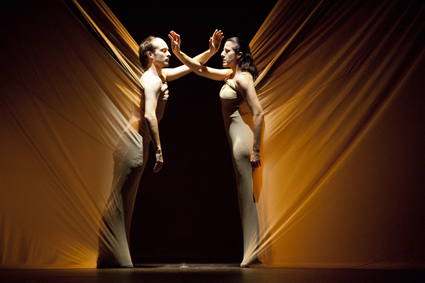
Sidi Larbi Cherkaoui, Maria Pages, DUNAS
photo Jess Bialek
Sidi Larbi Cherkaoui, Maria Pages, DUNAS
Dunas begins with two bodies shrouded in sand coloured gauze, straining towards one another. The separation proved to be a recurrent motif (though unintentional we suspect) in a work ostensibly about connection.
Last year’s Spring Dance gave us Israel Galván, a virtuosic exponent of Flamenco who showed us just what baring the elements of a traditional form can reveal. Dunas with Maria Pagés and Sidi Larbi Cherkaoui offered no such revelations. With two musical ensembles (piano and violin, guitar and percussion) largely hidden in the dark on either side of the stage a vital physical relationship between the music and the dance so crucial to Flamenco was erased though, thankfully, nothing could dampen the powerful voices of Ana Ramon and El Aribi Serghini that floated on the air.
Pagés is an impressive dancer with a strong, sinuous body but a superfluity of shared free-form movement between virtuosic Flamenco displays (including a spirited castanet solo) made her appear constrained by the format. Sidi Larbi Cherkaoui, whose collaborative work with Akram Khan (Zero Degrees, 2007) was so memorable and whose Sutras with Shaolin monks, featured at last year’s Spring Dance, is legendary, here seemed reduced to empty displays of ‘free-style’ movement with occasional Flamenco inflections (a protracted sequence of projected sand drawing gave some hint of his distraction). In this instance two dance forms met and had little to say.
contemporary women
Staged as sparely as IOU, Sydney Dance Company’s Contemporary Women program featured short works by Lisa Wilson (QLD), Larissa McGowan (SA), Emily Amisona (NSW) and Stephanie Lake (VIC).
Larissa McGowan impressed with Slack in Spring Dance 2009, a very distinctive, eerily surreal creation. In this much lighter work, Fanatic, a take on popular culture passions, she has her performers not simply mime the utterances of the humans and creatures in Alien and Alien vs Predator and those of their fans but brilliantly embody them, bigger than life, with immaculate precision. The outcome is very funny and quite spooky, if not particularly revealing. (See a review of McGowan’s Transducer.)
The strongest offering in the program was Stephanie Lake’s Dream Lucid with its opening image of a stamping, pulsating group of dancers. Gravity and attraction appear to be central to the work. A man lifts a visibly lightweight woman but the effort is almost beyond him. She appears to have magnetic control over him, drawing him offstage. Another pair demonstrates attraction with a dance of hands, his apparent dominance overcome when she traps him with scissoring arms. As the work moves towards a final merging of these beings, a vast field of static mimicking thunder, heavy rain and insects floods around them. Seven twitching automatons appear to hang off the back wall of the stage. Dream Lucid is bracingly mysterious, confidently constructed and forcefully danced.
We were uncertain about intent and choreographic execution in Lisa Wilson’s Desire and Emily Amison’s Yield, both built around two male-female couples. While some of the paired movements in Desire revealed an idiosyncratic choreographic sensibility the overall structure and meaning remained elusive. (See a review of Lisa Wilson’s Lake.) The quainter intimacies in Amison’s Yield proved just as puzzling, there was something afoot about relationships, deftly performed but less than tangible.
antony hamilton & melanie lane, clouds over berlin
Dancer-choreographer Melanie Lane’s Tilted Fawn, made with sound installation artist Chris Clark, achieves a nice balance between sound art and movement although it’s the sound that finally takes precedence, with the performer building a sonic world, literally, from ‘bricks’—small boxes containing speakers. On a shallow stage she shapes these into various configurations that evoke cities physically and aurally. Initially she simply turns each brick on, steps back and listens. The cumulative effect is at times orchestral. At other times the bricks are wielded like instruments from swung arms or stacked to created particular bodies of sound, cities of voices or the flow of static and mass media. Or the bricks become part of her, tucked beneath the chin, laid along an arm. Tilted Fawn is an intriguingly meditative performative installation, baffling some of Sydney Spring’s audiences, but opening them to the possible worlds that dance can build through cross-artform collaboration.
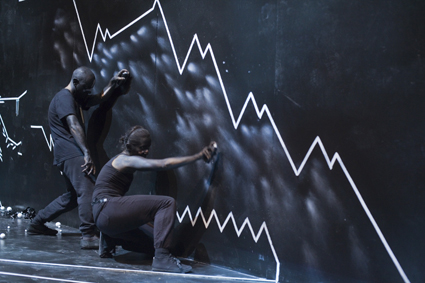
Antony Hamilton, Melanie Lane, Black Project 1
photo Ponch Hawkes
Antony Hamilton, Melanie Lane, Black Project 1
Antony Hamilton’s Black Project 1 is just as demanding in its own way, a substantial work warranting close attention and patience, its design and construction manifesting as a sizeable, emerging visual art work. At one end of a bleak wide wall are two slumped bodies (Hamilton and Lane) who come stutteringly to life, like cyborgs. Moving mechanically they evolve into something like high-end graffiti artists, very slowly transforming the space around them, ‘chalking’ it out in terms of their personal ground space and later on the wall in terms of their body proportions. They create a vast work with as much passion as their repressed bodies can express in this dystopia where soft clouds pass damply over them (video projection Olaf Meyer). But before their disappearance their art becomes magical, a two-dimensional world is transformed into a multi-layered one, meticulously un-peeled and crafted to reveal surprising depths and movement. This is a very strange world that Hamilton conjures, rooted in moody European comic book art, minimally hopeful in the manner of Beckett, and exquisitely realised.
Rafael Bonachela has two Spring Dance seasons ahead of him. Let’s encourage him to move beyond just showcasing local talent to giving a couple of choreographers the much-needed opportunity to present feature-length works in ideal conditions. As for the programming of international artists, let’s hope for a bolder selection.
Spring Dance 2012, curator Rafael Bonachela, Sydney Opera House, Aug 20-Sept 2
RealTime issue #111 Oct-Nov 2012 pg. 36
© Keith Gallasch; for permission to reproduce apply to realtime@realtimearts.net
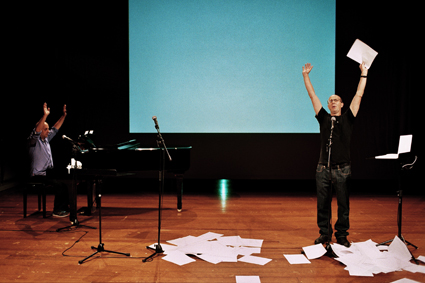
Matteo Fargion, Jonathan Burrows, Cheap Lecture
photo Herman Sorgeloos
Matteo Fargion, Jonathan Burrows, Cheap Lecture
PRESENTED BY STRUT AND AUSDANCE WA, THIS NOT SO MODEST DANCE FESTIVAL INCLUDED IMPORTANT ARTISTS FROM THE INTERNATIONAL SCENE SUCH AS JONATHAN BURROWS (UK), DIDIER THERON (FRANCE) AND SIDI LARBI CHERKAOUI (BELGIUM) ALONGSIDE THE LOCAL, WITH PERTH-BASED ALICE LEE HOLLAND’S TINY LITTLE TRAGEDIES AND RECENT WESTERN AUSTRALIAN ACADEMY OF PERFORMING ARTS (WAAPA) GRADUATES INCLUDED IN A MIXED BILL, MOVEMEMIX.
Alongside the performance program were workshop opportunities for Perth and Sydney artists with Burrows and his creative colleague, composer Matteo Fargion, and I saw Theron conduct a masterclass with third year students at WAAPA. This represents what STRUT has been doing so well for so long—supporting local artist development in an international context with links to interstate artists. STRUT Director Agnes Michelet is a powerhouse supported by a proactive WA Ausdance branch.
Burrows and Fargion’s double-bill, Cheap Lecture and The Cow Piece, seemed a perfect expression of something that hovers between “marching and flight,” a phrase from the spoken score of Cheap Lecture. The ‘lecture’ is a self-reflexive piece on the process of making work, consisting of spoken text, some movement directions and musical interludes. The Cow Piece is, effectively, a demonstration of the compositional principles laid out in the first work, using a table full of small plastic cows to beat out rhythms, perform simple dances and act out brief dramatic scenarios. The score for Cheap Lecture is a homage to John Cage’s Lecture on Nothing (1959) which is mentioned in the piece, taking not only its formal structure but a mid-century, Beat-poetesque, New York pace (as suggested by Theron) and a neo-Surrealist bent à la Cage associate Robert Rauschenberg. While the driving spoken word, consisting mostly of pithy statements, floods over us a few quotes are suspended in the air; “composition is about making a choice including the choice to make no choice,” “we don’t know what we’re doing and we’re doing it” (after Cage’s “I have nothing to say and I’m saying it”). What does become clear is that the first half addresses the making of work and the second its reception: “the return of a theme alters everything,” “repetition can pass through boredom into a state of grace.” Surreal actions come in the form of Burrows’ extreme Cossack-dancer energy and Fargion slowly looping a noose around a small plastic cow’s neck. The two giggle sometimes.
The turn to dance history for inspiration in Burrows and Fargion’s work (as they state, “everything is stolen”) is also apparent in Cherkaoui’s Faun, commissioned by Sadlers Wells for their In the Spirit of Diaghilev program in 2009. Faun featured WAAPA graduate James O’Hara in a romantic duet with Daisy Phillips to the original score by Debussy (for the original choreography by Vaslav Nijinsky in 1912) with additional music by UK composer-superstar Nitin Sawhney. The mood is mythical and the movement virtuosic within a simple scene suggestive of a forest. O’Hara’s faun, established in an opening solo, is fiercely three-dimensional, opposing the two-dimensional mode of Nijinsky’s iconic work, creating circular patterns of fluid, floor-based, acrobatic movement. Sawhney’s score accompanies Phillips whose almost contortionist postures and movements seek to seduce through display. The duet section features more extreme poses as the two young bodies intertwine and the overall effect is mesmerising. The entire work is currently viewable on You Tube.
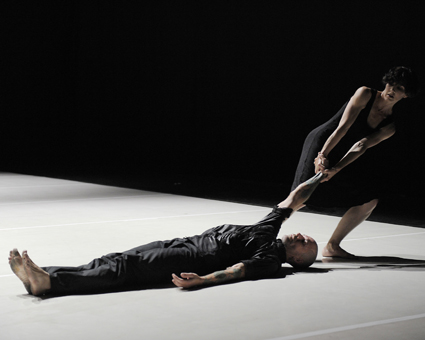
Harakiri
photo Christophe Canato
Harakiri
In contrast, Didier Theron’s Harakiri is a formalist piece to a discordant, driven and escalating score. Having encountered his Shanghai Bolero last year (RT105) I was prepared for the limited movement palette which consists of a lunging walk and variations in arm positions, with break-out solos puncturing the repetitions. Performed by five mature Australian artists (Matthew Morris, Sue Peacock, Aimee Smith, Isabella Stone, Sete Tele and Michael Whaites), the theme of human sacrifice emerges in the violent quality of the solos and the stoic inevitability of the patterned composition once it is set in motion. Theron’s characteristically charged actions draw expression from geometry, one of his stated aims.
Holland’s Tiny Little Tragedies could have been, quite simply, an exploration of the Jung quotation in her program: “I’d rather be whole, than good.” The contrasting dark and light in the piece that works through heavy, sculptural group work and airborne, dramatic solos suggests inner struggles and tensions between individual responsibilities and ‘the community.’ But some voice-over narratives about loss and regret seem to say either too much or too little, and while the intensely virtuosic choreography shows off the excellent dancers in the group, I couldn’t help feeling that there were just too many steps.
The short works in MoveMeMix were really sketches and excerpts, with Brooke Leeder’s Not Even New York perfectly pitched as a single movement idea inspired by international travel. A duet sequence consists entirely of hip displacements that instigate falls off-balance and movements of hesitancy. A final ‘mime’ sequence recalling two people forced into close proximity in the Metro or Tube takes this to a literal conclusion. Fleck&Flecker by Cass Mortimer-Eipper and Emma Sandall was an excerpt from a recent season in Perth and featured assured duet work and some intriguing movement from Mortimer-Eipper as one half of a conversation. Pieces by Emma Fishwick and Bianca Martin were not quite suited for such a formal performance season, seeming more like works-in-progress. Crash Course, the work-in-progress by James Berlyn, who has been collaborating with Sydney-based Nikki Heywood, was also presented during the festival. An immersion in the world of the migrant or physical therapy patient, the piece featured an entire fictional language created by Berlyn into which we are inducted. Themes of power and exclusion lie beneath this promising germ of an idea.
Here’s hoping STRUT and Ausdance WA can build and maintain this West-Coast answer to Melbourne’s Dance Massive, an event shaped so beautifully around STRUT’s commitment to local artist development in an international context.
STRUT and Ausdance WA, MoveMe Dance Festival, Perth, Aug 28-Sept 2
RealTime issue #111 Oct-Nov 2012 pg. 35
© Erin Brannigan; for permission to reproduce apply to realtime@realtimearts.net
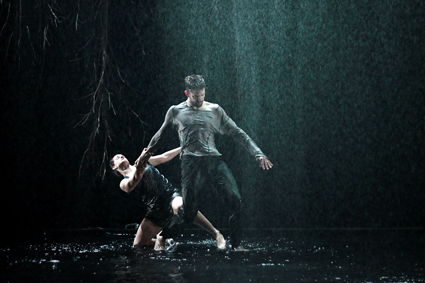
Lake, Lisa Wilson, Timothy Ohl
photo Fen Lan Chuang
Lake, Lisa Wilson, Timothy Ohl
LAKE IS THE SECOND MAJOR WORK FROM LISA WILSON, THE BRISBANE-BASED CHOREOGRAPHER AND HEPHZIBAR TINTNER FOUNDATION CHOREOGRAPHIC FELLOW. WILSON WANTED TO “DELVE INTO OUR FASCINATION WITH AND FEAR OF WATER…AND WHAT LIES BENEATH WHEN WE ‘BREAK THE SURFACE TENSION’ OF A RELATIONSHIP.”
Lake opens with the sounds of water, then breath. A young woman rises, her hands grasping, flexing, tense. Is she drowning? Willows trail onto the square, ankle-deep pool that is framed by bare stage on all sides. The cold night breaks into day. The ghostly willows morph into a hyperreal projection of a white gum swamp. A couple arrives, camping chairs in hand. The lurking woman watches.
There is a playfulness and personal authenticity to the work created by Wilson’s dual role as choreographer/performer. Her performance as the coupled woman anchors the naturalism of the choreography where the vernacular gesture, a touch on the knee, a cuff on the arm, become starting points for movement sequences of genuine virtuosity.
Night falls and the mood darkens. The couple is lured into the lower depths by the watching woman. Her body reflects their relationship to the water: she is manipulated, thrown, rejected, embraced, a force of enticement and menace. The complicity between the performers is palpable, with barely a pause before each collision of bodies. The naturalism of the back projection is fractured by interloping sequences of graphic animation, filmed bodies under water and the watching woman’s first solo in shadow.
The performance crescendos steadily, with the three dancers crashing against each other with a shark feeding frenzy. The young woman is expelled from the pool gasping. There is a moment of breath, an interlocking gaze between the couple and then darkness.
Watching the moment of expulsion had all of the pleasure of a traditional narrative. The relationship under pressure survived, the unspoken fear was expunged and a journey to the depths was completed. Lake moved seamlessly between abstraction and naturalism because of the clarity of its structure and the sense that the rationale had been fully investigated and supported by the design. The lighting was so delicate it melted into the restrained and elegant set, which was dominated by the ominous black rubber-encased pool.
There were only a few moments of rupture: one too many trick props at the top of the show, a bubble-blowing sequence towards the end. These demonstrated how easily accessible dance theatre can descend into pantomime, suffering from a lack of politic or explosive power. But Lake was beautifully controlled and paced. There was a surprising inevitability about the shifts in emotional tone, the transformations within the design and the movement from vernacular choreography to a furious and ritualistic play where the spumes of refracted water became almost as beautiful as the powerful bodies carving their way through the liquid’s opaque surface.
Dance seasons are heartbreakingly short but Lake has the potential to be a true crossover dance theatre work. I hope it has another life.
Lake, director, choreographer, performer Lisa Wilson, performers Timothy Ohl, Hsin-Ju Chui, dramaturg Jennifer Flowers, designer Bruce McKinvin, lighting Jason Glenwright, sound designer, composer Matt Cornell, video producer Chris Golsby Performance Space, Judith Wright Centre of Contemporary Arts, Brisbane, July 11-14
RealTime issue #111 Oct-Nov 2012 pg. 34
© Kathryn Kelly; for permission to reproduce apply to realtime@realtimearts.net
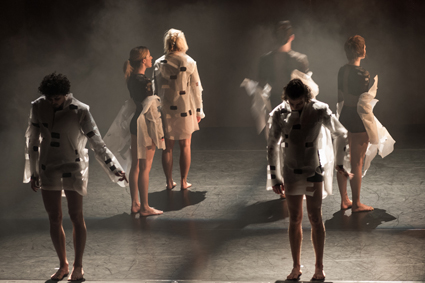
Tasdance, A Human Calculation, Anna Smith
photo Jen Brown
Tasdance, A Human Calculation, Anna Smith
A MESH SCREEN RISES AT THE REAR OF THE STAGE REVEALING A SPACE BEYOND FORMED ENTIRELY FROM ‘THICK’ GREEN LIGHT. TWO MALE DANCERS WALK BACK INTO THE DEPTHS OF THE SPACE, SEEMING TO DISAPPEAR WITHIN ITS GLOW. WHILE THIS MOMENT OF THEATRE IS TECHNICALLY SIMPLE, THE ILLUSION IS COMPELLING IN ITS EXECUTION. I CATCH MY BREATH. IT IS JUST ONE OF MANY STRONG IMAGES IN A WORK CHOREOGRAPHED BY ANNA SMITH IN TASDANCE’S VOLTAGE SEASON.
Taking the idea of voltage as a starting point, choreographers Larissa McGowan and Anna Smith have each prepared a work for six dancers, titled Transducer and A Human Calculation respectively. McGowan has taken a more direct approach to the concept, by exploring the effect of energy on the body, the duo and the group, while Smith’s work reflects a fascination with the impact of technology on the human race.
Transducer opens with strobing light and each of the dancers silhouetted against a full height scrim forming a corner between the rear and side of stage. Both the set and the costumes are stripped back to basics, with the scrim a blank white, the dancers clothed in variations of loose or fitted orange lycra. It feels like an exploratory work that may have been developed entirely in collaboration with the dancers and composer. The ‘twitch’ of electricity is the link between really interesting solos or duets and more conventional group movement. I’m completely taken by a series of duets where one dancer appears to roar or scream at the other, mouth fully open, syncing exactly with the soundtrack of industrial noise, the other’s body moving involuntarily in response. I note that the two male dancers with their fierce, loose movements seem to portray this effect even more vehemently than their female mirror images.
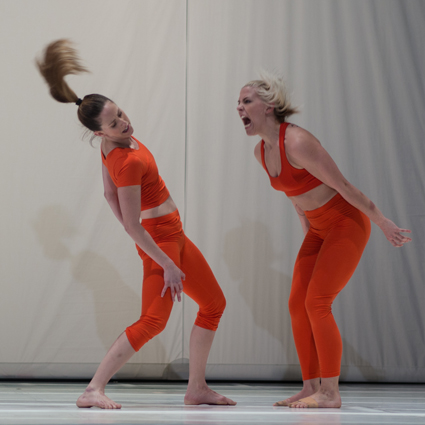
Tasdance ensemble, Tranducer, Larissa McGowan
photo Jen Brown
Tasdance ensemble, Tranducer, Larissa McGowan
While McGowan’s reads as a workshopped piece, Smith conveys a sense that every detail has been considered and every image composed. She is playing with the apocalyptic idea (borrowed from Ray Kurzwell) that society will reach a point of “singularity” in 2045 when the speed of technological change causes a rupture in “…the fabric of human history” [when technological “superintelligences” will outstrip human intellectual abilities. Eds]. Her dancers appear lost in the afterglow of this moment, as though trying to reclaim a way to move or behave. A repeated movement throughout is of pulling forward and being drawn back, as though continually failing. The costumes, lighting and set pull together to form an intimate, moody work that is full of memorable, almost filmic images. Six dancers frozen in formless, laser-cut paper shifts, backlit like translucent lamps, provides one such moment.
Two-choreographer seasons have generally produced good results for Tasdance and obviously offer a productive challenge for their dancers. The works in Voltage are really interesting in themselves, but the double billing disadvantages choreographers clearly at different points in their careers. In this work McGowan is still evolving her choreographic language, while Smith appears at ease with the movement and is more focused on the developing the imagery of an idea. Consequently the more experimental work, Transducer, cannot hold its own against the more confidently shaped A Human Calculation.
Tasdance, Voltage, Transducer, choreographer Larissa McGowan, music Charlie Chan, A Human Calculation, choreographer Anna Smith, dancers Tobiath Booth Remmers, Ben Chapman, Sarah Fiddaman, Brianna Kell, Jenni Large, Tim Walsh, music Loscil, Scanner, Tim Hecker, Hauschka & Hildur Guðnadóttir, costumes Lexi George; design and lighting for both works Bluebottle–Frog Peck; Theatre Royal, Hobart, Aug 2- 3
RealTime issue #111 Oct-Nov 2012 pg. 34
© Judith Abell; for permission to reproduce apply to realtime@realtimearts.net
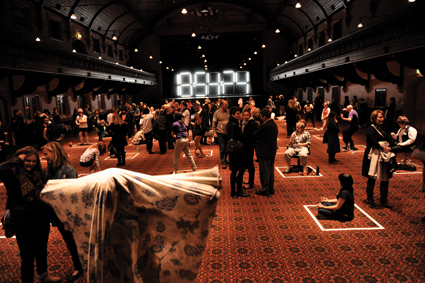
WeTube LIVE, Stompin’ Youth, Junction Arts Festival 2010
photo Mark Webster
WeTube LIVE, Stompin’ Youth, Junction Arts Festival 2010
WHEN I WAS CHILD, OTHER THAN FOR INTERMITTENT, SADISTIC OUTBREAKS OF ERSATZ FOLK DANCING (WHO WERE THESE FOLK?) IN AN OTHERWISE ART-POOR PRIMARY SCHOOL CURRICULUM, I THOUGHT DANCING WAS THE UNNATURAL EXTROVERSION PROMULGATED IN MGM MUSICALS AND THE NUMEROUS 60/40 (60% MODERN, 40% TRADITIONAL) GATHERINGS MY PARENTS FREQUENTED ACROSS THE 1940S AND 50S. THE DANCING WAS ACCESSIBLE, DILUTED BALLROOM. NOT INFREQUENTLY, I WOULD FIND MY FACE THRUST AGAINST THE TUMMY OF SOME HEAVILY CORSETED MATRON VIGOROUSLY TRIPPING THE LIGHT FANTASTIC.
Such events were wonderfully sociable, staged in a variety of halls in a wide range of nearby suburbs, organised by sports clubs, businesses and lodges and with quite a class mix (if not ethnic in the 50s). My mother’s disdain for Catholics partially evaporated when she discovered a local church held dances of a Sunday evening. A title like Oh! I Wanna Dance With Somebody conjures for me a time when dancers actually held each other, pre-Twist, pre-disco, as a matter of course in massive numbers for many hours across the globe. However, although the program for Oh! I Wanna Dance With Somebody features Tea Dancers, most of the partners in dance that we’ll see perform are engaged in quite some other intimacies.
In RealTime 109, in “New niches, new dance audiences,” Martin del Amo updated us on the burgeoning contemporary dance scene in Sydney’s west. One of the main forces in that thrust has been the perpetually innovative Campbelltown Arts Centre, its dance program curated by Emma Saunders, a member of Sydney’s famed The Fondue Set. As the culmination of three years developmental dance work, CAC is presenting Oh! I Wanna Dance With Somebody, programmed over three days in October and rich in community, cross-artform and intercultural engagement.
I spoke with the inimitable Saunders, a prodigious improviser, who volunteered a five-minute concentrated rendering of the program (she could do it), but I opted for a more leisurely drip-feed. Asked about the motivation for staging this dance fest, Saunders says, “The project has come out of my idea to house some of the outcomes of the dance programs of the Campbelltown Arts Centre over the last three years into one event. There were different models set up over this period, asking artists to work in different ways and with different structures—interdisciplinary projects where I might ask a dancer to work with an artist from a different field to make new work together. It might also be an intercultural commission as in the case of Narelle Benjamin and Anandavalli (Lingalayam Dance Company).”
Saunders explains that “these commissioned works are a mix of my own and Julie-Anne Long’s curatorial outlook; she was curator for a year while I was away having a baby. The works have had various stages of development over the past one to three years.”
However, she admits, “actually housing the outcomes is a bit trickier than just showing them in a theatre. For example Paul Gazzola and Paul Granjon are making a work called The Experimental Body Extensions Manufacturing Unit. They are working with communities around Campbelltown to create practical, physical projects that look at human body extensions, that locals can wear. It’s not a joke, although it has a humorous edge. Over a month, the artists will invite people into a kind of factory process and then stage a catwalk showing, or I should say, a product demonstration. I invited [Berlin-based] movement artist Paul Gazzola who in turn invited Welsh artist Paul Granjon, a specialist in robotics but who is also a performer, to work with him. The movement has come out of the project quite organically in that it’s people having a dialogue with their own bodies in terms of how they might develop these practical extensions. For example, someone has developed a Personal Space Activator, a skirt made of plywood, which, as you go to shake someone’s hand, flares up and prevents you from connecting. Therein lies the movement.”
Saunders cites “two other curatorial thoughts running behind the project. Oh! I Wanna Dance With Somebody looks loosely at where dance and community can intersect. It’s very ‘in’ to have community projects and I’m very interested to see what that means for artists—how does work connect with an audience, where does it start, finish, who are we dancing for, who’s dancing with us? That’s an ongoing dialogue I’m floating with each of the projects.
“The other idea is, ‘What would it be like to swap the black and white spaces of the theatrical and the visual arts and see what that does to a work?’ Lots of visual artists are making very performative work, which is really exciting: but how do they relate to each other and to community? So, the same work will be repeated in both spaces, gallery and theatre, and the audience might be able to see both versions when they plot their path across the day.” Although, in the end, says Saunders, it might not matter, it’s about the thing itself, the body. “It’s a fun and fresh way to see innovative new dance work.”
We chat about the partnerships which have been nurtured. Saunders tells me that “dancer Anton and visual artist David Capra are developing a dancing duo. They look similar, both are of Ukrainian origin and wear black-framed glasses. We put them in a room and a work has organically evolved over four weeks in two-week blocks. They’ve had a good, strong critical dialogue. And David is a good dancer and is a very physical visual artist and this gives Anton the opportunity to dance in a different way. They’ll present the finished work on the weekend.
“Narelle and Anandavalli will present an early showing of a work they’ve been commissioned to premiere here in 2013. They will be performing with a visiting Indian singer. Each presentation will run for about half an hour. Elizabeth Ryan (of the Fondue Set) is coupled with fashion designers Romance Was Born—I wanted to do an age-old thing in an innovative way, and fashion has been with dance at least from the Ballets Russes to Akira Isogawa working with the Sydney Dance Company. Elizabeth will be performing in a new gown by Romance Was Born’s Anna Plunkett Cole and Luke Sales who make amazing gear.”
There’s also a regional aspect to the CAC dance program, with Saunders setting up a dance exchange with NORPA in the Lismore region. “I’ve worked up there myself a number of times. Phil Blackman in Lismore is working with Martin del Amo in a residency at the moment. We’re sharing the love around our dance ecosystem so that not everything is city-based.”
As part of CAC’s international dance residency program, Saunders has invited German dance artist Jochen Roller to create a new work called the Dance Tourist, about being a tourist in Campbelltown. “It stemmed from him being in residence in Campbelltown in Kintyre, Scotland which will parallel the work he’s doing here. He’s looking at the social ‘fabric’ of Campbelltown. He’s been to the fabric shops and made some purchases and is making a series of objects to create a sense of how he sees Campbelltown. It’s a very beautiful work from a dance artist working in the visual arts! His presentation will be more like an exhibition. He’s working with dance theatre performer Nadia Cusimano. “
Julie-Anne Long is involved in the event on two fronts: “She’ll do our Whitney tribute, a dance marathon across the weekend. We’ve also commissioned her to make a film with Sam James of her work with local women from her Invisibility Project (see page 34). Titled Dancing in the Dark, it will screen across the event. It’s another aspect of how work is being commissioned here at Campbelltown Arts Centre.”
Readers might remember the excitement occasioned by Ben Speth and Stompin’ Youth’s WeTubeLIVE for the 2010 Junction Festival in Launceston (RT99). Saunders has invited Speth to realise a version of it for her dance event in which she will “fill the gallery spaces with 100 performers. This involves a great deal of work,” she admits. Saunders has been corralling dance groups, line dancers, Indian dancers and community members who have had something to do with CAC in recent years. “The performers each choose a favourite clip from YouTube and perform it forward and backwards at timed intervals in a one-metre square each.” The audience move among the performers.
For Oh! I Wanna Dance with Somebody, the galleries will be cleared of artworks, says Saunders, “so that the bodies are the art,” and the foyer will become more like a lounge.
WeTUBE will be performed on the opening Friday night. The dance partnerships will be on the Saturday from 10am-10pm with improviser par excellence Andrew Morrish commencing the day’s proceedings by anticipating what he thinks he will see and then, later, declaring precisely what he has witnessed. On Sunday there’ll be a forum with the artists, community leaders and audience with a performative curator’s introduction from Saunders. There’ll also be handouts about works, a publication down the track and a photographic record created by Heidrun Löhr. As we conclude our conversation, Emma Saunders finally mentions the Tea Dance Project performers who, on opening night, “will actually dance with each other.” Could make us all wanna dance.
Campbelltown Arts Centre, Oh! I Wanna Dance With Somebody, curator Emma Saunders, CAC, Oct 19, 20, 21; for program: www.campbelltown.nsw.gov.au/Dance; box office 02 4645 4100, 10am-4pm
RealTime issue #111 Oct-Nov 2012 pg. 33
© Keith Gallasch; for permission to reproduce apply to realtime@realtimearts.net
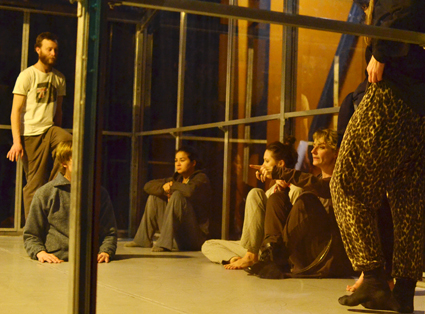
Anouk van Dijk (second from right) and dancers in rehearsal for An Act of Now
photo courtesy Chunky Move
Anouk van Dijk (second from right) and dancers in rehearsal for An Act of Now
A GRADUATE OF THE ROTTERDAM DANCE ACADEMY IN 1985, ANOUK VAN DIJK, THE ARTISTIC DIRECTOR OF MELBOURNE’S CHUNKY MOVE SPENT THE NEXT 10 YEARS AS A LEAD SOLOIST FOR ROTTERDAM DANCE COMPANY AND AMANDA MILLER’S PRETTY UGLY DANCE COMPANY. IN 1998 SHE FORMED ANOUKVANDIJK DC, HER OWN AMSTERDAM-BASED COMPANY WHICH HAS PERFORMED WORKS AROUND THE WORLD, OFTEN WITH A STRONG FOCUS ON EXPLORING THE AUDIENCE’S RELATIONSHIP TO THE DANCERS.
She has created works with German writer-director Falk Richter and has developed major site-specific works. For the 2012 Melbourne International Arts Festival she is creating An Act of Now, which will be performed in the Sidney Myer Music Bowl. Philipa Rothfield met van Dijk to discuss the choreographer’s Countertechnique methodology and its relationship to her work.
act one: the choreographic relation
I am interested in the different ways in which a choreographer works with her dancers. Susan Foster has written of “the body for hire,” a term usually associated with project-based work. The body for hire is seen to be already trained, already in possession of the requisite skills. It presumes that dancers are somehow prepped in technical terms. While every dancer has a history, a training background and performance experience which they bring to the situation, the work itself may provoke a mode of development on the part of the dancer.
Anouk van Dijk has developed a particular approach to movement, which she names Countertechnique, something she has been developing over 20-odd years. Countertechnique is movement methodology based upon Alexander technique, in particular its strategic invocation of directions in the moving body. While the Alexander lesson typically focuses on everyday activities such as sitting and standing, Countertechnique offers a range of perspectives upon a more dynamic palette of activities. It is a set of strategies which can be utilised by the dancer, offering multiple critical perspectives (“a toolbox” of options) to allow dancers to expand their field of possibility and enhance their corporeal agency. It is task-oriented. Dancers do things and observe how they move, invoking particular elements of the approach. Countertechnique is formulated to augment the dancer’s critical abilities, supplying a horizon of potential thoughts, ideas and anatomical insights.
To what extent is van Dijk offering this approach to those dancers who will perform in her upcoming work, An Act of Now? In response to my question, she takes me to the studio. She has brought with her a master teacher (Nina Wollny) and a senior teacher (Peter Cseri) to work with the dancers. Wollny has been working with van Dijk in performance and on Countertechnique for over 10 years. Van Dijk calls Wollny over and asks her what she is working on. She says that she is thinking about the distance between her sit bones and her heels, and is working on her back which is stiff from jet lag. Later I watch Wollny roll a dancer’s head around to give her a sense of the distinction between the skull and the neck. The dancer then tries to differentiate the spine and skull on her own. Taking on physical insights is easier said than done. The morning is a time of ritual and repetition. For those who work in a classical idiom such as ballet, the terms of engagement are clear. But if the work is about the production of difference in the body (new skills, new habits), strategies other than repetition are called for. Countertechnique is clearly on the table here. Teachers assist the dancers to work on the material. Van Dijk also speaks of the mix of people selected for this project, the younger ones learning from the more experienced dancers. So there are a number of senses in which the work itself offers a mode of development for the dancers. She wants to enhance the agency of the dancer in performance because “a dancer with no agency dies”.
act 2: between the idea and its action
I wonder about the relation between thought and action. What sort of thinking is at stake in this (and previous) work? One mode of thought has been raised above. It is about the ‘power of thought’ in the body, and is embedded within Countertechnique .There are two further lines at play in van Dijk’s thinking. One is historical and cultural. The way she puts it concerns the ways in which thought processes affect our bodies: what’s happening in the world and how does that affect me? For her generation, life was framed as a matter of choice. Feminism emphasised the importance of women’s careers. The 1960s opened out the sphere of possibility, in part a result of post-WWII prosperity, in part the result of 60s radicalism. Today the horizon is less rosy. We face a collapsing social system, a globalised network, a complex interplay between the self and the environment. A brainstorm ensues:
Stimulus: body-environment
Response: subjectivity, unconscious influence, warm spaces, cold spaces, open/closed, seductive, manipulative, culturally determined spaces, biased spaces, the space of doctrine, eg, religion
Stimulus: agency
Response: assumed consensus, habitual patterns in following, manipulation of language determining values, gender(less), need for control, loss of control, need for balance, breaking balance, assumed freedom, freedom within an historical context.
The question then is how these ideas translate into dance. For van Dijk the dance work is not a mere representation of issues nor is it a mirror of the social but is rather an attempt to physicalise thought. The social, cultural and historical is thus an impetus, an inspiration and not actual content. This leads her to pose the question: how do I translate that into a physical state? How do I shift this sense of the socio-historical into a movement-based language? An Act of Now is one such attempt to look at the body-environment relationship in physical terms. Is this dance or theatre I ask? For van Dijk, performance is always already theatrical in that it is expressive and is for an audience, but physicality is her medium, her art.
act 3: an act of now
If all performance is theatrical, what about the spectator? How does the audience relate to and experience the work? There is a tension here, between the spectator’s freedom to perceptually roam and the choreographer’s desire to direct attention. Van Dijk has in the past played with this tension, working the contrast between distance and proximity and selecting locations other than the void of the black box. Each site calls for a particular mode of attention. An Act of Now will be performed in the Sidney Myer Music Bowl, inside a glasshouse. While the audience is positioned outside that space, they will be supplied with headphones. The intention is to (virtually) locate the observer inside the glasshouse, through the intimacy of sound.
The idea of headphones in An Act of Now is to suck the audience into this constructed space, a glasshouse filled with smoke, to virtually enter its shifting play of actions, tasks, projects. The dancers are in rehearsal now. It is for them to negotiate the range of available choices, posed within the structure of the piece, the set, the time and space. Anouk van Dijk enters rehearsal aiming to aid the agency of the dancers, to affirm and enhance their options, yet steer them towards the qualities and possibilities she would like to see.
Melbourne International Arts Festival: Chunky Move, An Act of Now, concept, choreography Anouk van Dijk, performers Peter Cseri, Leif Helland, Stephanie Lake, Lauren Langlois, Alya Manzart, James Pham, Niharika Senapati, Nina Wollny; Sidney Myer Music Bowl, Melbourne, Oct 17-27
RealTime issue #111 Oct-Nov 2012 pg. 31
© Philipa Rothfield; for permission to reproduce apply to realtime@realtimearts.net
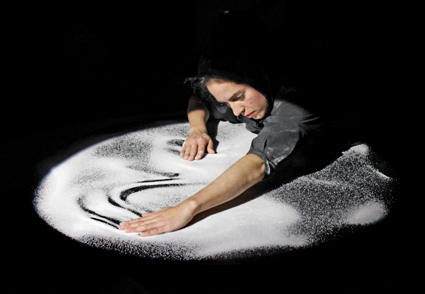
Zoe Scoglio, Shifting Ground
photo Ponch Hawkes
Zoe Scoglio, Shifting Ground
SEISMIC STABILITY IS SOMETHING WE (FINDING OURSELVES IN THE MIDDLE OF A TECTONIC PLATE) DON’T DWELL ON TOO OFTEN. IN SHIFTING GROUND, ZOE SCOGLIO SHINES A TORCH ON THE FISSURES IN THE PLASTER WALLS OF OUR HOMES, AS WELL AS IN OUR RELATIONSHIP WITH THE EARTH.
The performance opened bang on one month after a 5.2 magnitude earthquake sent Melbourne shuddering on June 19, sparking ‘online hysteria’ (at least in my Twitter feed). The earth, as Scoglio so magically describes it, is not inert. And to be reminded of that is to look at ourselves, our built structures as well as the earth’s mineral resources as finite.
A ceremonial glass of sencha tea awaited us as we piled into Meat Market’s Studio B where we were then asked to pick up a rock from a collection lined up against the wall. A round table stood in the centre of the darkened studio; an air of ritual prevailed. Cross-disciplinary artist, Zoe Scoglio is high priestess, but more often a conduit here; through her exploration of the sonic and physical space the audience makes new and rather philosophical connections. Our chosen rocks sit on the edge of the table, meaningless and static until they are picked up and transformed in her hands. Through gestural choreography they take on the shape of ice floes or moving continents. Crushed quartz is spilled onto the table creating a frozen landscape; the rocks perform a glacial dance, spinning and settling into place. The table is strung with piano wire inside, emitting vibrations as rocks journey across it. A sun-like spotlight joins in. Donning a miner’s torch, Scoglio becomes an explorer finding cracks and marks on the walls of the studio, evidence of the shifting earth below. The geological transformations that we witnessed earlier are not over.
An installation resembling a cave wall becomes the focus, the performer removing a part to get at a rock inside. In a playful way, Scoglio questions how inanimate objects arrive at their place and for what duration of time. In the spirit of William Blake, we see the world in a few grains of quartz and eternity in a 40-minute performance. Later a projection shows a rock spinning on a dark background, a foreboding meteorite; Scoglio’s own face briefly flashes across the wall, echoing her video Rock Bodies (made for Next Wave’s Timelapse program in 2009). In cultures that practice animism, natural forces, plants and animals are not regarded as lower than or separate from human beings. As Scoglio continues her inquiry, it begins to appear that the relationship between humans and earth is as much a spiritual question as any. This is imparted by her almost Gregorian-like chanting, which sets the rigged-up table to shake violently at the end of the performance, causing the quartz crystals to bounce off as if by magic. A machine sets the floorboards vibrating, reminding us again of the recent quake, and like the meteorite, of our own temporal nature. Scoglio’s performance is a finely cut gem, moving with perfect timing across landscapes and ideas.
Arts House: Shifting Ground, concept, performer, videographer Zoe Scoglio, sound design Nigel Brown, interaction design Chris Heywood, set & prop designer Zoe Stuart, human ecologist consultant Asha Bee Abraham; Arts House, Meat Market, Melbourne, July 19-22
RealTime issue #111 Oct-Nov 2012 pg. 43
© Varia Karipoff; for permission to reproduce apply to realtime@realtimearts.net
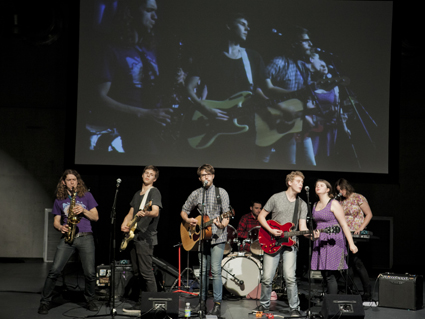
Applelspiel Make a Band and Take on the Recording Industry
photo Alina Gozin’a
Applelspiel Make a Band and Take on the Recording Industry
PERFORMANCE IN ALL ITS DIVERSITY GREETED ME IN THEATRES OVER RECENT MONTHS: A HORROR STORY IN WHICH A FATHER IS NEARLY DRIVEN TO MURDER HIS CHILD (PRESENTED AS A NASTY PUPPET); AN ADAPTATION OF AN INGMAR BERGMAN SCREENPLAY IN WHICH A PSYCHIATRIST, INCAPABLE OF SELF-ANALYSIS, SUFFERS A SEVERE NERVOUS BREAKDOWN; A YOUTH THEATRE PRODUCTION THAT ADDRESSES STRESSES AND CULPABILITIES IN GOSSIP CULTURE; AND, THANKFULLY LIGHTER, AN ENSEMBLE OF PERFORMERS FANTASISE A ROCK’N’ROLL CAREER FOR THEMSELVES. EACH OF THE WORKS RAISED DRAMATURGICAL ISSUES AROUND CONCEPTION AND EXECUTION.
appelspiel make a band…
Appelspiel’s ‘rockumentary,’ Applelspiel Make a Band and Take on the Recording Industry is an amiable satire on the popular music industry via video interviews, performances, video clip mockups, the tour saga and the pressures that can result in band breakup. It’s all too familiar territory but what gives this show an edge is the inclusion of local colour autobiographical material captured in onstage video interviews, the tracking of the construction of hoped-for hit songs, including different arrangements, and, at the work’s dramatic centre, an hilarious roundtable battle over royalties caught verité onscreen by a camera amid the performers.
What impresses is the precision and ease with which the creator-performers manage the constant juggling of cameras, microphones, musical instruments and scene setting. The band members are their own very efficient roadies. A pity then that the overall lighting lacks definition, frequently blurring the projected images on the large screen that dominates the stage. Handheld lights and clever camera work create some of the best effects including a very funny parody of a hip hop video clip which managed to transfer well to the screen.
Appelspiel Make a Band and Take on the Recording Industry is an inventive and very funny crowd pleaser. It deserves a return season with the opportunity to smooth out unevennesses in the singing and the otherwise admirably laidback performances, to improve the rather limp ending and to trim the number of songs. Appelspiel Make a Band…represents a quantum leap in the writing, structure and performance strengths of the group; promise of even better things to come.
atyp and version 1.0, the tender age
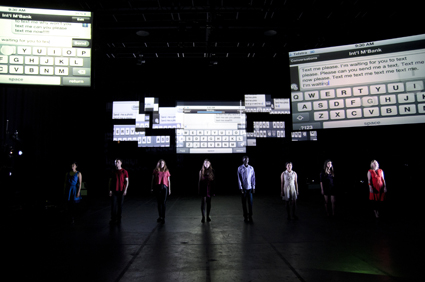
The Tender Age, ATYP & version 1.0
The inspiration for The Tender Age comes from an infamous radio broadcast in which a young teenager, quizzed about her sexuality on radio, reveals that she has been raped, and that her mother had refused to deal with it. That the girl was even being interviewed about her sexuality by radio hosts Kyle Sandilands and Jackie O using a lie detector was bad enough, but the role of her mother, who thought it would be good for the girl to be confronted about herself in a public arena, was more worrying. The mothers and other adult women in The Tender Age are, by the end of the performance, grotesques.
Against projections of images of a household interior on large screens, a very long period is spent establishing the mood of a group of teenagers, dancing, cuddling and playing games until a mobile phone image of one of the girls having sex is widely distributed. The young performers move in straight lines, breaking at right angles, rumour and judgments passing from one person to another. Screens fill with faces and keyboards. Abusive exchanges ensue. The radio interview is recreated verbatim: Jane Phegan plays the mum neutrally so it’s difficult to judge the woman’s tone and motives—but she’s the one who asks the lie detector questions. The radio hosts are immediately alarmed and apologetic. The scene is deftly realised; judgment left to the audience.
A woman appears, anxious about choosing the right image of herself for Facebook. A restrained teenager worries about kissing. A counsellor struggles to effect a meaningful apology from the student perpetrator of e-gossip. This is another strong scene, rich in tensions and contradictions, if too short-lived. The plethora of images and information in The Tender Age have by now evoked both the vulnerability and cruelty of teenagers, but evocation is rarely extended to anything more probing.
Images and episodes roll on. A witty ode to the smart phone is followed by a human tangle in which, among other things, the percentage of teenagers watching porn is detailed. A woman is outed online and loses her job for sleeping with her CEO. With a row of alco-pops before them, the adolescents express their anger at adult hypocrisy about alcohol consumption. Finally, drunken mothers turn against their children: “You’re a loser, just like your father,” “You ruined my life. I wish you didn’t exist.”
Where are the fathers? Or is this a single mother issue? The young people, whose material this is have, to a large degree, cast their net very wide resulting in an intermittently engaging show with some tantalisingly potent scenes and confusing disjunctions. On the other hand, the narrowness of the approach to adult females (anxious, vain, ineffectual, victimised, drunken and bitter) calls at the very least for a sustained scene depicting a mother-child relationship.
Fortunately the committed young actors perform convincingly and passionately under the co-direction of Fraser Corfield and David Williams, although some standard youth theatre gambits and the cut and paste construction of content is not what we expect, especially from version 1.0. Given the delicacy and the potency of the subject matter, The Tender Age warranted an experienced writer to help draw its young subjects further into the complexities of the issues they face in their lives. This is a very well-publicised production of scale in a major venue; its young performers deserve more. The Tender Age certainly holds up a mirror to the lives of a generation, but much more than reflection is needed.
stc: face to face
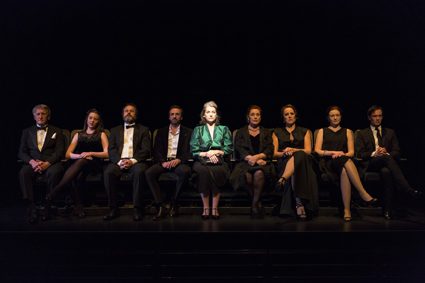
Face to Face, STC
photo Brett Boardman
Face to Face, STC
Without having first seen Ingmar Bergman’s Face to Face (1976), director Simon Stone found the published screenplay and was entranced by its theatrical potential. Bergman was also a great director of the European stage, a ruthless adaptor (like Stone) of classics and, apparently, a not particularly successful playwright. It was, of course, in film that Bergman excelled as a writer, innovatively synthesising theatre and cinema into what he described when referring to Persona, The Silence and others as “chamber films.’
As a fan of Bergman’s films, Stone was aware of a problem, one that the filmmaker himself was constantly alert to (and had written about pre-production to the actors and crew for the Face to Face): how to represent dreams in film? Bergman regarded this film, one of his least favourite, as emotionally overwrought. The film is nonetheless absorbing, largely due to the raw power of Liv Ullman’s performance as Jenny, a psychiatrist suffering a nervous breakdown; but the extended dream sequences are indeed problematic—rather theatrically staged and too literally symbolic. However, Bergman gets it right in the smaller moments of psychological disintegration in Face to Face when the bleed from reality to hallucination appears frighteningly actual, a goal Bergman aspired to. These involve Jenny’s encounters with an elegant, elderly woman, dressed in black and missing one eye. That she is so disturbed by the woman, with whom she exchanges no words, is the first signal for Jenny that something is wrong. Later she will turn to a mirror and see not herself, but the one-eyed woman.
Co-adaptors Stone and Andrew Upton have elided the old woman, perhaps because her role is purely symbolic and too neatly frames both screenplay and film. In doing so they diminish, to a degree, Bergman’s Freudian preoccupations and focus on immediate social pressures—work, marriage, ageing relatives—and rape. This makes things awkward when, in the play’s second movement (there is no interval) in a psychiatric ward, the “repressed” fairly gushes out in an expository rush. It’s already a problem in the original and no less so here. What Stone and Upton do tolerably well, however, is realise a disturbing interplay of nightmare and reality in the ward.
Jenny’s hospital room is a wide, glaringly white box of a room behind glass with the actors’ voices cinematically amplified, lending the production the much needed chamber theatre quality it most certainly needs. Between moments of lucidity, Bergman’s screen nightmares are replaced by hallucinated characters from Jenny’s life who, confronting and demanding, wander into or race through her room. The success of these scenes, played out in a shifting palette of eerie pastel lighting that blurs the rational/irrational divide, highlights the weakness of the first movement of Face to Face.
Stone uses the full, bare stage of the Sydney Theatre for the first half of the play in which Jenny’s world disintegrates, placing performers at a great distance from the audience and each other. While Stone’s skill at stage choreography can never be doubted in the enforced intimacy of Belvoir Upstairs, here it appears, at turns, shapeless or over-determined. Voices are thin, furniture (including an embarrassingly voluminous hot tub) is clunkily hauled on and off. Perhaps Stone reckoned that this otherwise vast emptiness would amplify our sense of Jenny’s alienation from her world. The one moment of intense focus in the first movement comes when, after being raped, Jenny attends a musical concert. The actors sit in a row across the front of the stage, Jenny arriving late and sitting in the middle, her face alone is spotlit.
For Bergman, the still face in close-up was one of his principal filmmaking fascinations. In theatre, lighting aside, it’s the actor’s capacity physically and vocally to draw us to them with the aura that is their personal spotlight—witness Cate Blanchett’s Lotte in the opening monologue of STC’s Gross und Klein. But there’s little opportunity for that in the first rather disengaged first movement of Face to Face, save for moments of wry if incidental humour. However, in the end—as it should be—it’s the performances—if against the odds and principally in the second half—that make Face to Face memorable.
Kerry Fox’s down to earth Jenny is a superb realisation of a woman for whom every meaningful connection with the world is systematically severed. She plays the role with a lightness of touch, a kind of innocence tempered with touches of bluntness and detachment. But it is an innocence corrupted by denial. Without going to the physical extremes of Liv Ullman’s body-wrenching breakdown in the film Fox nonetheless conveys a palpable sense of total disturbance.
Having left a phone message for her husband, describing the vacuousness of her reality, and consumed copious sleeping tablets, Jenny slips into another world signalled by a column of light emanating from a vast ceiling descending from above and into which she disappears. After a short blackout we are with her in the nightmarish psychiatric hospital in the play’s second movement. The effect is theatrically monumental, possibly ironic, but oddly epic in proportion to the movements that frame it and certainly an unsubtle leap from the real into nightmare.
There are too many changes to the Bergman screenplay to warrant detailing, some are clever, some insightful, some wrongheaded. Bergman’s theatre metaphor is nicely accentuated. However, it’s quite noticeable that lines that work on screen in close-up can sometimes sound either bland or melodramatic when transferred wholesale to the stage, especially when juxtaposed with fresher additions from the co-adaptors. Mitchell Butel’s Thomas, a bisexual with whom Jenny has a brief affair and who supports her through her illness, is denied the mix of altruism and cynical resolution he exhibits in film and screenplay. It makes him too benign, undercutting Jenny’s return to strength and independence. Butel’s is a fine performance but deserving more complexity. Wendy Hughes and John Gaden as Jenny’s aunt and uncle are excellent and Humphrey Bower is aptly acerbic as a cynical fellow psychiatrist. Face to Face is partly successful, thanks mostly to Kerry Fox’s central performance, but the adaptation appears to have created more problems than it could solve.
stc: hilary bell, the splinter
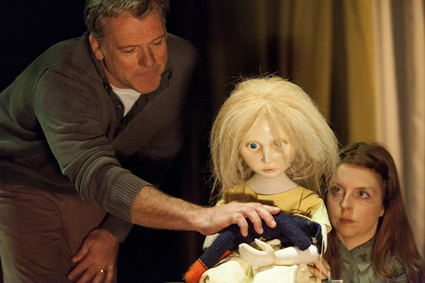
The Splinter, STC
photo Brett Boardman
The Splinter, STC
Hilary Bell’s The Splinter, the tale of a kidnapped child mysteriously returned to her parents, has the potential to unnerve its audience, but something appears to be awry in conception and execution.
The return should be the salvation of her parents’ difficult relationship but the father doubts the child is their own. His growing paranoia in which he hallucinates two sinister look-alike teenagers in cahoots with the imposter turns him against mother and child. What ensues is confusing narrative and theatrical overload.
In the tradition of the folk tale and ghost story, something very odd is happening, which even the wife momentarily experiences, but it doesn’t help the audience place the apparently evil twins, other than as ‘the others.’ The father sees them as manipulating his family. This is amplified by the others’ Bunraku-style handling of the child, presented as a puppet. Had the production invested more in the realisation of the child, given it a more palpable personality, as puppetry is perfectly capable of, and more engagement in the action, then the production might have offered Erik Thomson much more to work with. The child is absent for long stretches and her presence is diluted when she’s simply bundled about by the twins. I began to wish that the two were simply puppeteers (much to be learnt here from My Darling Patricia’s virtuosic Africa, RT101, p41) instead of being literalised and attention pulling. ‘The others’ should be felt and not seen. And the child should dominate the stage life of her parents.
Erik Thomson (ideally cast as a benign man pushed to the edge of madness and possibly the murder of his child) and Helen Thomson (a principally reactive role, but excellent in the moment where she grapples with her guilt) do their best under difficult circumstances. It’s a pity that The Splinter becomes so confusingly diffuse when it appears to have the potential to chill.
In RealTime 112, Andrew Fuhrmann will write about a Melbourne adaptation of Ingmar Bergman’s film Persona from Fraught Outfit and Theatre Works; it’s programmed for Belvoir in July-August, 2013. An interview with Simon Stone about Face to Face appeared in RealTime 110. An interview with Hilary Bell can be found here.
–
Performance Space, Show On: Appelspiel Make a Band and Take on the Recording Industry, creator-performers Simon Binns, Nathan Harrington, Nikki Kennedy, Emma McManus, Joseph Parro, Troy Reid, Rachel Roberts, Mark Rogers; Carriageworks, July 25-28; version 1.0 & Australian Theatre for Young People, The Tender Age, directors Fraser Corfield, David Williams, performers ATYP members, video artist Sean Bacon, lighting Christopher Page, sound design Gail Priest, Carriageworks, Aug 22-Sept 1; Sydney Theatre Company, Face to Face, A Film by Ingmar Bergman, director, adaptor Simon Stone, co-adaptor Andrew Upton, cast Humphrey Bower, Mitchell Butel, Kerry Fox, John Gaden, Wendy Hughes, Anna Martin, Jessica Nash, Queenie Van Zandt, Dylan Young, set and lighting Nick Schlieper, costumes Alice Babidge, composer, sound design Stefan Gregory, Sydney Theatre, opened Aug 11; Sydney Theatre Company, The Splinter, writer Hilary Bell, director Sarah Goodes, performers Julia Ohannessian, Erik Thomson, Helen Thomson, Kate Worsley, puppetry, movement director Alice Osborne, designer Renee Mulder, lighting Damien Cooper, composer Emily Maguire, sound design Steve Francis; Wharf 1, STC, Sydney, Aug 10-Sept 15
RealTime issue #111 Oct-Nov 2012 pg. 44-45
© Keith Gallasch; for permission to reproduce apply to realtime@realtimearts.net
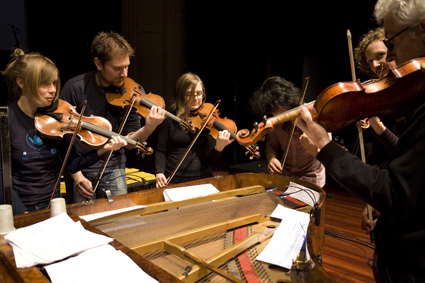
Atticus with Jon Rose (far right), Metapraxis
photo Ponch Hawkes
Atticus with Jon Rose (far right), Metapraxis
ATTICUS’ METAPRAXIS IS A PROGRAM OF WORKS THAT STRETCHES THE CONCEPT OF A STRING QUARTET IN EVERY DIRECTION. A TEAM OF ASSOCIATE ARTISTS CONTRIBUTED TO THE EVENT, WHICH MIGHT BEST BE DESCRIBED AS A SEASON FOR EXPANDED STRING QUARTET. BEGINNING EACH OF THEIR THREE PERFORMANCES WITH A DIFFERENT IMPROVISED MUSIC ‘SUPPORT ACT’ SEEMED APT AMONGST WORKS THAT WERE EQUALLY EXPLORATORY AND OF ‘THE NOW.’
On viola and reel-to-reel tape recorder, James Rushford and Joe Talia performed an improvised work of deft subtlety and stealth. Using a vocabulary of sounds that drew attention to subtle imperfections—scratches, whispers and glitches—this work maintained focus, despite its ephemeral gestures.
What was most impressive about Talia and Rushford’s performance was the sensitivity they shared toward the sounds they produced. Never at odds with each other, the music they created was free to move in any direction at any time—to lash out from its predominantly restrained state into moments of extreme violence and intensity.
On the second evening, the program opened with Jon Rose’s Palimpson—a solo act that conveyed a similar sense of exploration. Performed on what might be described as a ‘meta-violin’—the instrument expanded through four audio channels and employing a diverse palette of interactive, electronic effects—Rose’s work was unrelenting in its kinetic energy. Despite the intensity and complexity of the sounds produced through these electronic effects, Rose, as a performer, was never overwhelmed, always interacting physically with this complex onslaught of sound.
Anthony Pateras’ Crystalline, performed by Atticus as a string quartet, is a composition about stark contrasts and transitions. For the performers, this work was highly challenging, not only in its intricate and complex rhythms, but in the challenge to convey a structure that takes a series of unexpected turns. I found it difficult to engage with on its first performance, however on the second evening the energy of the performers and the work itself were more convincingly aligned.
Cat Hope’s Cruel and Usual Punishment, commissioned especially for this program, displays a fascination with frequency. It transforms the role of stringed instruments from the producers of ‘notes’ to frequencies, free to glide outside the chromatic spectrum. Although I felt that it could have evolved further, this work provided an ambience and spaciousness that offset more frenetic works on the program.
Rose’s The Long and Short of It, an emphatic statement on Australia’s cultural identity, seemed to resonate through the program as a whole. Taking audio and footage from The Great Fences of Australia project, in which Rose and partner Hollis Taylor perform on wire fences with violin bows, The Long and Short of It is a work that is overwhelmingly about place—about the vastness of our landscape, and a music that could not possibly come from anywhere else.
Using a series of cue cards, Rose directed a small ensemble of string players performing a series of quasi-improvised passages. A curious phenomenon occurs in Rose’s work; the more heavy-handed his approach to what seem to be crudely formed ideas, the greater their clarity. This was evident not only in The Long and Short of It, but in Palimpson as well. Traces of Rose’s influence can be heard in Hope’s and Pateras’ work—all three composers produce work that rails against the conservative mainstream, and that pushes its material to the utmost extreme.
Jani Christou’s Metapraxis provides a glimpse as to where this sentiment has its roots. This work is a commentary on the highly theatrical nature of concert music. There is a heightened sense of drama and urgency here, due not only to the frenetic, contrapuntal string writing that dominates, but in the way in which the composer dictates the physical mannerisms of the performers and directs them to various locations within the performance space.
Once again, Atticus drew on a team of associates to realise this work. There was a dream-like atmosphere to the performance—a surreality in which the work transcended musical performance, becoming an entirely new form of theatre.
Metapraxis embraces the experimental underground with an agenda to perform music that is deeply connected to our time and place. It challenges not only musicians to collectively expand the stylistic vocabulary of their work, but also asks us who we are as audiences and the kind of values we would like our music to reflect.
Arts House & Atticus: Metapraxis, artists Jon Rose, Biddy Connor, Phoebe Green, Judith Hamann, Anita Hustas, Charlotte Jacke, Zac Johnston, Andrea Keeble, Kevin CK Lo, Leigh Raymond, James Rushford, Joe Talia, Lizzy Welsh, Arts House, North Melbourne Town Hall, July 19-21
RealTime issue #111 Oct-Nov 2012 pg. 48
© Simon Charles; for permission to reproduce apply to realtime@realtimearts.net
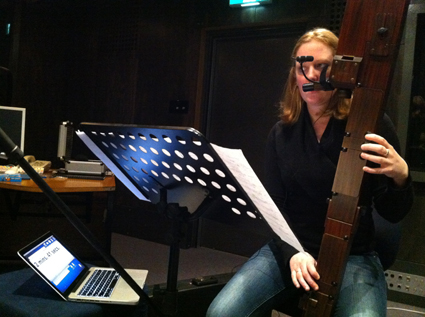
Alana Blackburn
photo Ben Carey
Alana Blackburn
DRAPED IN RED SATIN AND ACCOMPANIED BY JET ENGINE ROARS, A DOUBLE BILL FEATURING FANTASTIC YOUNG MUSICIANS CHARMED THE RED RATTLER IN SYDNEY’S MARRICKVILLE LAST MONTH. WITH PETER FARRAR DEMONSTRATING SAXOPHONE IMPROVISATION AND ALANA BLACKBURN OFFERING A VERY FINE INTERPRETATION OF CONTEMPORARY CLASSICAL MUSIC FOR RECORDER, NEW MUSIC NETWORK HAS ONCE AGAIN SUCCESSFULLY SHOWCASED INNOVATIVE MUSIC IN SYDNEY’S INNER WEST.
Farrar’s experimental alto saxophone set opened. He chose the floor in front of the stage rather than an elevated position for an exercise in sonic safari. His unassuming stance ensured we would meet him in his place of improvisation. Farrar popped a plastic water bottle in the bell of his sax and, presumably drawing on his experience in African scales practised with Ethiopian singer Dereb the Ambassador, sped into crowded marketplaces of sonic invention. He crossed genres and national borders. At times his notey flights could have come from bagpipes. Gasping for air after busy phrases he conveyed just how much information he was processing live for us. Then an abrupt stop. He casually sipped water from another plastic bottle and let silence annunciate just how much energy he had built with the vibrations and buzzing of his modified instrument.
Farrar’s second offering was a sound world in four breaths, or four movements. Each breath was longer than your average exhalation due to impressive cheek-puffed circular breathing. The bell of his horn now stuffed with water bottle and a loose plastic bag, the resultant sounds hissed like an old pinball machine. Multiphonics honked in and out as in a seismologist’s dream. His study in sound allowed time to move at its own speed, which felt both dilated and compressed.
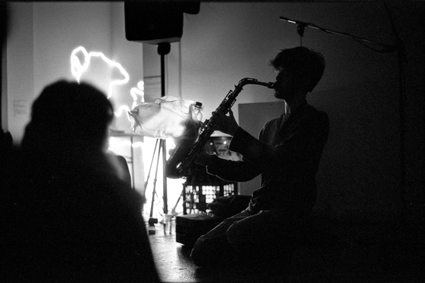
Peter Farrar
photo Lucien Alperstein
Peter Farrar
Later when Farrar returned to a traditional sound, sans bag and bottle, the timbre of the instrument was so comparatively clean as to feel almost inadequate. He dextrously made up for this tonal simplicity with rapid arpeggiated passages. Then like a singer producing the same pitch using different vowels, Farrar pulsed on long notes bringing out subtleties in harmonics and overtones. This reaffirmed what seemed the message of his entire set, that we can expect more from a saxophone. When Farrar abruptly announced in a shy voice, “That’s the end of the set. Please get up and do stuff,” there was electricity in the air and a sense throughout the room that we could have lapped up more of his humble genius. Thankfully Alana Blackburn stepped in to fill that spot.
Blackburn is an expert in Renaissance, Baroque, Contemporary and Japanese repertoire for recorder. Her program featured two Japanese-inspired compositions, Kage (2000) by Dutch composer Roderick de Man and Et Døgn (2009) by Steve Adam. Norwegian for ‘one day,’ Et Døgn, for four different-sized recorders and computer, explored sounds mimicking nature including chirping birds and crickets. Enchanted Japanese forest meets late-night radio. Perhaps this music was too subtle as it left me asking, “Why do this live when it could be synthesised?” While Blackburn gave an excellent performance, there was a sense that the concept might be better honed to perfection in a studio, as the spontaneity of live performance didn’t seem a defining feature of the sound world.
Kage (2000), after the Japanese word for shadow or reflection, was a study in interaction between fixed media and improvisation. Blackburn imitated the electronics and at other times her scored part took the fore. Some of the accompanying material derived from recordings of Noh theatre including vocal exclamations and shakuhachi sounds. The Japanese elements of this work came across well, even with a pronounced Dutch accent.
All works in Blackburn’s set had been written since 2000, including a world premiere of a work by Anthony Leigh Dunstan. His piece, Tic, communicated musically the nervousness a performer feels. Dunstan’s aim had been to subvert the relationship between stimulus and gesture in the music-making process. He says a shy, nervous character is integral to the expression of this musical material because it prescribes the physical gestures that will then be transformed into musical phrases by the performer. Blackburn’s realisation of the nervous tic was highly involved and bordered on mania rather than self-consciousness. Her commitment to theatrics was impressive however and carried the weakest composition in the program through to hearty applause.
_derivations by local Ben Carey was perhaps the most progressive and refined work in the program. Sound technologist Carey was present to manipulate synthetic and live samples. Ever expanding a database of musical materials, a form of timbral matching was employed to build a conversation between musician and computer in true concord. Top job, new musos!
In varietate Concordia, presented by New Music Network, performers Peter Farrar (saxophone) and Alana Blackburn (recorders and electronics), Red Rattler Theatre, Marrickville, August 27
RealTime issue #111 Oct-Nov 2012 pg. 48
© Felicity Clark; for permission to reproduce apply to realtime@realtimearts.net
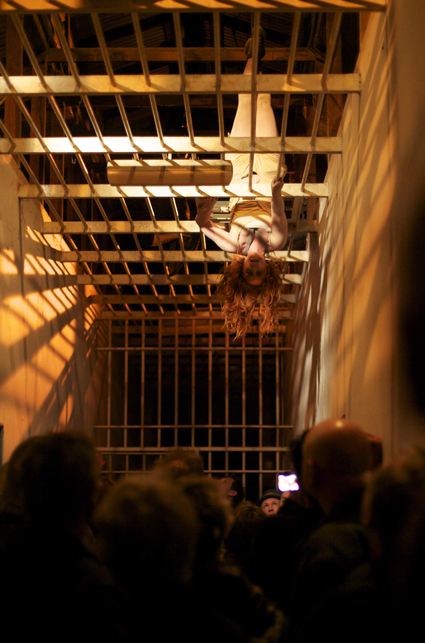
Tammy Brennan, Confined
photo Oliver Eclipse
Tammy Brennan, Confined
WINTER IN CENTRAL AUSTRALIA IS BITTERLY COLD. HUDDLED IN THE LOW LIGHT OUTSIDE THE JAIL WE ARE WARNED OF THE STRONG AND EMOTIVE THEMES OF THE WORK: CHILD SEXUAL ABUSE, MADNESS, EMBODIED TRAUMA, DEATH.
Ducking to enter through a small iron hatch-like door, I am disoriented; white manicured roses are shadowed red and pale blue under spotlights as I hear, for the first time, the ratchet sound that will haunt me throughout the performance. Good god, I think to myself, what the hell have I got myself into this time?
Set against the whitewashed walls of the cellblocks of the old jail in Alice Springs, Confined fuses physical theatre, multimedia installation and opera to evoke the distressing dystopia of psychosis. Creator and lead performer, Tammy Brennan, uses the archetypes of Echo and Narcissus to embody the split personalities of an adult survivor of sexual assault and her child self. The libretto traces her journey through the bowels of madness and despair, with the score interlacing live soundscapes with macabre field samples.
The heart of the performance occurs in the claustrophobic corridors of two cellblocks. Here we are greeted by Echo, suspended from the ceiling in the moments after her death. Her long operatic howls ricochet through the corridor. The air is thick with sound and sweat as she is lowered to the ground to prowl amongst us, recalling gut-wrenching abuse in hyperbolic sprechstimme. Coloured lights emanate from closed cells, suggesting perverse peepshows of human grief. Across the hall a woman peers through the peephole into one of the cells. Compelled, I press my eye against one of the slits and spy a masked man, all protruding nose and sunken eyes. Later, the cell doors are flung open as Echo strides from room to room, oscillating between childish rage and sorrowful surrender as she encounters surrealist landscapes inhabited by live incarnations of her fragmented self. Another audience member brushes against me. My skin crawls. I am relieved when we are asked to move on.
Entering the second cellblock, the sense of confinement is overwhelming as masked figures claw their way across the fenced gangway above us. Echo descends headfirst into the audience, her voice unwavering as she swings amongst us.
The door opens. Suddenly, we are ejected into the crisp night air. The intensity of the cellblocks dissipates as we witness Echo’s ascent into another world. The spell is broken when we are herded into a small holding room to watch a gratuitous video interview with Echo recounting her abuse.
Confined is an intimate and immersive foray into the depths of the troubled mind. While so much work produced in the regions mirrors the geographical and cultural nuances of local areas, Brennan refuses to ghettoise trauma in the local, undertaking extensive primary and secondary research to create a work that speaks to the universality of human suffering. From the burning ghats of Varanasi to the Hearing Voices conference in Melbourne, she has undertaken countless studies of site and numerous interviews with survivors of mental illness, including acclaimed outsider artist Anthony Mannix.
Over a beer after the performance, a man confided that his brother had suicided during a psychotic episode, and that the show had been “a spot-on representation” of his brother’s world. By stepping outside the parameters of reality, Confined illuminates the profound terror of psychosis, that for some, is unbearably close to home.
Moodkiller Productions, Confined, created and performed by Tammy Brennan, composers Barton Staggs, Sophie Loizou, director Younes Bachir, dramaturg Gayelene Carbis; Old Alice Springs Jail, Alice Springs, June 16
RealTime issue #111 Oct-Nov 2012 pg. 49
© Kelly-Lee Hickey; for permission to reproduce apply to realtime@realtimearts.net
IMPROVISED ‘CONTEMPORARY CLASSICAL’ MUSIC IS NOT EASILY FOUND IN AUSTRALIA, ALTHOUGH MANY A COMPOSER THESE DAYS OFFERS MUSICIANS PASSAGES IN WHICH TO IMPROVISE, ALBEIT WITHIN STRICT PARAMETERS. SYDNEY, HOWEVER, HAS IN THE NOISE A FINE ENSEMBLE OF IMPROVISERS WHO ON THIS OCCASION SUPPORTED CLASSICAL AND JAZZ CLARINETTIST AND SAXOPHONIST PAUL CUTLAN TO REALISE THREE OF HIS SEMI-IMPROVISED COMPOSITIONS, WITH THE ASSISTANCE OF JAZZ BASSIST BRETT HURST.
The first work, Times Past, “evok(ing) a time when the viola da gamba ruled the earth” (program note), was immediately engaging, double bass-propelled (including some ravishing glides), the baritonal bass clarinet soaring over string quartet moodiness. The piece was a prelude to the main work in the first half of the concert, Cutlan’s Across the Top Suite, inspired by travelling to north-eastern Australia. The four-part suite evoked vast spaces with floating melodic passages, ethereal harmonics and shimmering strings, and hints of more foreign landscapes—African, Bulgarian—and musical modes, Baroque and 19th century classical (recurrent sweet pizzicato). The last movement, Reconcile, signalled order and resolution but ended rather darkly—a melancholic admission perhaps that Reconciliation is not easily achieved.
After interval, Off the Beaten Track comprised four role- and task-based improvisations in which a wider range of techniques was applied to the instruments, yielding varying degrees of magical cohesion and exciting digressions, with some dynamic forays from Cutlan, gripping group glissandi, fine cello and bass entanglements, an abrasive violin and chugging viola encounter and some embracing, motoristic ostinato big band moments—Cutlan and Hurst weaving in and out of the shifting textures created by The NOISE. The concert concluded with Cutlan’s Perhaps Next Time—latin jazz-inflected, smooth and orchestral; you could see it in the uniform swing of the musicians’ bodies. A very satisfying concert, above all in its assaying of semi-structured improvisation by virtuosic musicians working as a confident ensemble.
New Music Network, Cutloose meets The NOISE, Paul Cutlan, Brett Hurst, The NOISE (Veronique Serret, Skye McIntosh, James Eccles, Oliver Miller); Sydney Conservatorium of Music, Aug 2
RealTime issue #111 Oct-Nov 2012 pg. 49
© Keith Gallasch; for permission to reproduce apply to realtime@realtimearts.net
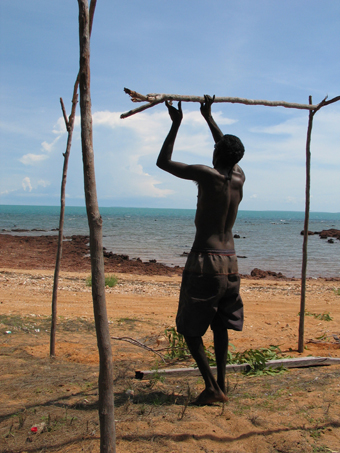
GADAWULKWULK means SHELTER, 2009, Barayuwa Mununggurr & Ruark Lewis, Yarrinya
photo Ruark Lewis
GADAWULKWULK means SHELTER, 2009, Barayuwa Mununggurr & Ruark Lewis, Yarrinya
THERE’S A WORD THAT’S INCREASINGLY SURFACING IN DESCRIPTIONS OF RECENT WORKS BY RUARK LEWIS, ONE OF AUSTRALIA’S MOST ENDURING INTER-DISCIPLINARY ARTISTS WORKING WITHIN THE REALM OF CONCEPTUAL EXPLORATIONS OF LANGUAGE, AND THAT IS THE TERM “CIVIC.”
Whether referring to the artist’s signature agit-prop banners, collaborative illuminated Indigenous oral history installation, people’s poems or public art commissions, this expansion of Lewis’s practice into the civic realm is also a prominent feature of the artist’s first major mid-career survey. At Hazelhurst Regional Gallery in Sydney’s south, itself a uniquely modelled complex designed to maximise community engagement, Lewis is activating and inhabiting the space in ways that spill out beyond the architectural confines of the gallery’s white walls.
“I want to compose a certain formality within the gallery space itself,” Lewis explains. “Whereas I need a particular informality outside in the garden, interactive works that move and shift around, that kids can play with and audio in the garden as well as a people’s poem attached to the cottage.” Built in 1947 and later bequeathed to the local community (along with the surrounding 1.4 hectare estate), the Hazelhurst cottage is an early example of an architecturally designed house in the Sutherland Shire and certainly a resonant site for reprising Lewis’s striking black-and-white textual skin of aphoristic statements, Banalities for the Perfect House (2007).
When I meet Lewis in the lead-up to the survey, he is busy tending to the considerable administration that accompanies a survey across two locations (Macquarie University Art Gallery will host the second part early next year with some works shared between both galleries and others uniquely installed). Taking stock of the material output and the more ephemeral traces of three decades of a practice that spans painting, drawing and writing to performance, installation, sound art and live collaborative works and actions (see RT87), Lewis is also confronting the vagaries of time, inspecting old Polaroids retrieved from rusted canisters and discovering the freedom of studio space after pulling out some works for the first time in years. With a monograph publication also planned, Lewis cites finding an “advantage in bringing the larger works out and putting them in a new context and then having the chance of photographing them again. The book also demonstrates issues of mobility of objects. I’ve been interested in the opportunity to do things twice but the chance doesn’t really come up that regularly.”
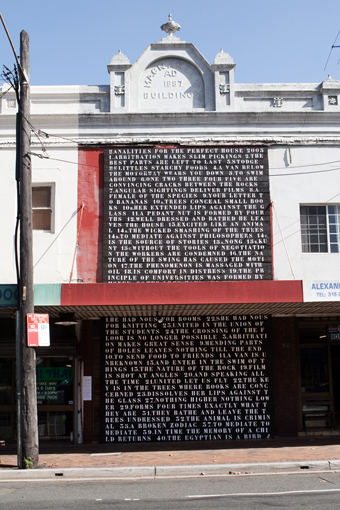
Banalities for The Perfect House (2007), SLOT Gallery
photo Alex Wisser
Banalities for The Perfect House (2007), SLOT Gallery
For audiences, the survey provides a rare opportunity to view a significant body of Lewis’s work in one space alongside newer pieces. These works continue to reflect the artist’s talent for devising idiosyncratic methods of translating longstanding concerns in unconventional, and often deeply personal, ways. An earlier engagement with the paintings of the Yirrkala region which led to a memorialising suite of transcription drawings, for example, has assumed a new direction since Lewis met Yolngu artist Barayuwa Mununggurr in Sydney. In 2009, the pair commenced a creative exchange which has seen Lewis twice make the long journey to Mununggurr’s ancestral country on the east coast of Arnhem Land. During a visit to Yarrinya, at a saltwater location at Blue Mud Bay, Lewis became immersed in subjects related to Mununggurr’s paintings.
Here, Lewis photographed the technique of the assembly of a lightly installed shade shelter, filmed the details of the water currents and wave formations, and also the clouds, and made audio recordings of the water at night as well as later observing the building of a traditional bark shelter at the settlement of Yirrkala. The Arnhem Land research belongs to Mununggurr and Lewis’ ongoing project, Transcriptions for the Perfect House (2009-2012), in which explorations of ‘home’ connect their practices. Mununggurr’s bark paintings represent “contemporary expressions of the custodial ideal of place” while Lewis responds with “coincidental sculptural processes and an environmental graphism,” explains writer James Paull in the exhibition room brochure. As Lewis describes it, the project is “a reference, quite an elaborate one, to what’s happening in the Northern Territory with the Intervention and the anti-homelands movement that the federal government implemented and maintains—the idea of bringing all the people from the homelands into the settlements where medical facilities, education and the like are streamlined and economically disbursed. As I understand it, the NT Intervention isn’t a system the Yolngu aspire to.”
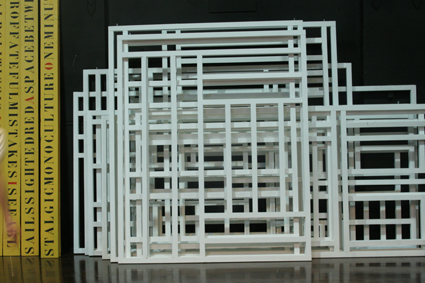
Ruark Lewis & Rainer Linz, Banalities for The Perfect House, 2005
photo Ryan Leech
Ruark Lewis & Rainer Linz, Banalities for The Perfect House, 2005
For the survey exhibition, Lewis presents a set of newly constructed mobile shelters, functional yet ultimately sculptural works that visitors can test out for themselves in the Hazelhurst gardens. These nomadic architectural installations, titled Star Shelters (2012), stem both from Lewis’s concern for the thermal exposure crisis experienced by Sydney’s homeless people during wintertime and his desire to create a temporary housing solution for the Darwin homeless, the so-called “long-grassers,” Indigenous individuals and families who visit the city without a place to stay and who sleep rough outdoors. Lewis observed the long-grassers over a nine-week hospital stay in Darwin earlier this year. It was during his hospitalisation that he began the prismatic black-and-white graphite drawings, made to chance formulae but also responding to ideas of Aboriginal astronomy, which have since evolved into the shelter works.
“I took a set of my small drawings and began folding them to form three dimensional structures,” Lewis explains. “I scored along the lines and simply folded them like origami. These maquettes were scaled up and using plywood formed life-sized tent-like structures with openings on the side that permit people to get inside them.”
Site-specific works include two banners printed with the subtly ironic phrases GO HOME and HOMELESSNESS for one day at two major traffic entry and exit points at the threshold of the Shire. For Lewis, the introduction of elliptical text-based works into the civic realm allows the reader to “attach their own meaning to words, phrases and concepts. It’s a kind of esoteric form of public writing, a reductive form of writing expression, and one that percolates like salt or minerals rising up through the earth. These simple words signal and impart a social nutrient and I’ve found these ideas can easily flourish. It isn’t a bad thing if we can hold back from being singular authors some of the time and think more about the use of art in our society.”
If the chronological and classificatory logic of a survey reveals a tendency to freeze works as finite objects in space and time, Lewis is resisting this impulse toward stasis by using documentation to “bring into the audience’s perception that there’s also a lot of performance that goes on around the works.” Two live works in the gallery with dancers and choreographers Tess De Quincey and Alan Schacher are programmed, the latter involving Schacher’s response to Lewis speaking the 1943 version of the aphoristic text, Directions, by the largely forgotten Sydney poet of the PUSH movement, Harry Hooton. It’s this summoning spirit which similarly permeates so much of the art of Ruark Lewis. Recovering and illuminating the nuances of place, history and community without losing their critical force, Lewis skillfully translates enough of the strangeness in these manifold stories to keep their poetry alive.
Ruark Lewis: Survey 1982-2012, Hazelhurst Regional Gallery, Sept 29-Nov 11; Macquarie University Art Gallery, Jan 30-March 13 2013; Events at Hazelhurst: Oct 28, 11am artist talk with Ruark Lewis, 1pm performance, Tess De Quincey, Catscradleforsutherland; Nov 11, 1pm performance, Alan Schacher, Directions, www.hazelhurst.com.au
RealTime issue #111 Oct-Nov 2012 pg. 52
© Ella Mudie; for permission to reproduce apply to realtime@realtimearts.net
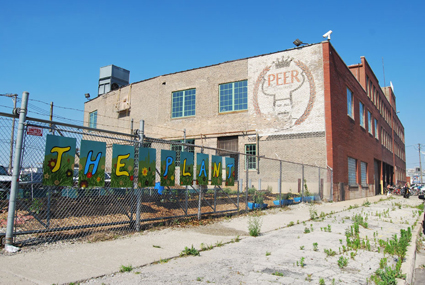
The Plant, Chicago
photo Tessa Zettel
The Plant, Chicago
IN MAY 2012 I EMBARKED ON A FOUR-MONTH TOUR OF NORTH AMERICAN ARTIST-LED SPACES AND INITIATIVES ACROSS 14 CITIES. BY CONNECTING WITH THESE SPACES AND CITIES, I HOPED TO LEARN ABOUT DIFFERENT MODELS AND THE CONTEXTS SHAPING THEM, AND TAKE A COMPARATIVE LOOK AT OUR OWN SITUATION IN AUSTRALIA, SPECIFICALLY SYDNEY.
The tour was also an opportunity to ponder the behaviour of cities, and the potential for artist-led activity to transform economies. As director of Bill+George, an ARI in Redfern, I also hoped to start a conversation with various spaces on a possible collaborative exchange project for 2014.
The artist-run initiative (ARI), the artist-run space, or the artist-run centre (ARC) as it is known in Canada, is a useful barometer for the health of the arts and the political economy in general. In Australia, the ARI can be considered an incubator for new ideas, with a reputation for risk and experimentation, and a drawcard for emerging artists in the first few years of their practice. Conventional definitions in Australia typically assume a predominantly visual art frame, with some kind of curatorial or exhibition activity.
definitions & ideologies
I have observed for a while the need for an expanded definition of the Artist-Run Initiative in Australia because current definitions omit a large swathe of artist-led activity which is actively contributing to and enhancing artistic output, and the capacity for artists to innovate new forms and ideas. Current discourse and definitions are narrow in reach, and tend to elide the substratum network of what all artist-led activity does, which is to connect at the creative level what everyone in the non-creative world does: manage, administer, make business decisions and produce and distribute resources in order to keep their enterprise going. In particular, scant attention is paid to the effects of autonomous decision-making on artistic endeavours, and the flow-on effects of self-organisation, which strengthen the artist’s political muscle in the broader economy.
Coming to America, I was intrigued by the ‘pulling yourself up by the bootstraps’ mentality and the entrepreneurial flag-waving which sit awkwardly alongside America’s difficult relationship to ‘big government’ and public funding. I was interested in how these ideologies were shaping artistic endeavour. Over the course of the journey my line of inquiry grew to include housing projects, publishing endeavours, libraries, urban farms, breweries, small manufacturers and even an artist-run limousine service.
building a hot list
My initial plan reflected a hot list of happening spaces and connected people. A great resource for building a list is the Phone Book, a solid listing of artist-run spaces and initiatives produced annually by Chicago artist-run gallery threewalls. In Canada, a comprehensive guide is the Directory of Artist-Run Centres published through Réseau Art Actuel by the Quebec-based regional association Le Regroupment des centres d’artistes autogeres du Quebec.
Time permitted a cursory drift through only a select number of regions, with this short review presenting a snapshot of three cities in the Mid West: Minneapolis/St Paul, Chicago and Detroit. In this edition I focus on Chicago.
chicago
My interest in exploring the USA was first ignited when I came across the Chicago-based venture Incubate. Describing itself as a research institute, the central thrust of Incubate is to explore new approaches to arts administration and funding, and to approach art administration much like a creative practice. Incubate is perhaps best known for Sunday Soup, a food-based micro-grant program which involves groups (artists or community) presenting short projects they want funded to a crowd who dine on soup cooked by volunteers. Audiences then vote on their favourite, with the winning project getting all the proceeds from the door. This concept has expanded internationally, and in January this year included Sydney’s favourite ARI, The Red Rattler, hosting one at their Marrickville venue.
In Chicago, artist-run spaces are plentiful in a city of more than 10 million, and a large number are havens for post-MFA artists looking for alternatives to the art market. Threewalls, an artist-run space located amongst a cluster of galleries in the arts district of Chicago’s West Loop, mixes a number of clever strategies. Mimicking the increasingly popular Community Supported Agriculture (CSA) programs across America, threewalls produces a twice yearly art subscription service of locally produced work, which they call Community Supported Art. Perhaps because of this, they are the only artist-run space invited to be part of the Expo, a Chicago Art Fair, presumably to help grease the trapdoor for emerging talent into the art market. Along with the Phone Book and initiatives across North America, threewalls also organises an annual conference called Hand in Glove which brings together artists from all over the country to talk about new ways of doing things with administration and project management.
Further south of the city in the Bridgeport neighbourhood, Co-prosperity Sphere takes up an impressive footprint in a still semi-industrial area with a receding reputation for seediness. Headed up by the affable enabler Ed Marszewski, Co-Prosperity is an exhibition space, a performance venue, a publishing arm, a festival platform, a craft beer maker and Small Manufacturing Alliance among many other things. It is also home to the annual Versionfest, an artist-run festival which basically remixes the neighbourhood, packing 60-plus events and happenings into 20 spaces for the month of May. Bringing together “cultural workers, community developers, urban entrepreneurs, artists, designers, foodies, public space hackers, urban planners, cultural geographers and dreamers” it presents the optimum conditions for expanding the artist-led realm.
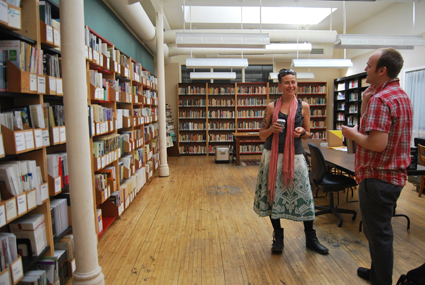
Rebecca Conroy with Daniel Tucker, AREA Chicago
photo Tessa Zettel
Rebecca Conroy with Daniel Tucker, AREA Chicago
Marszewski refers to Bridgeport and Co-prosperity as the “Community of the Future” and has been promoting its wares through a number of very nicely designed and printed publications. He considers the community newsletter to be an excellent instrument for building community and activating its histories. Similarly, histories and local archives drive the work of Chicago artist Daniel Tucker, a prolific maker of projects who has an extensive archive of Chicago art and community projects. He describes one such project, AREA Chicago, which he founded in 2005, as “a print publication, a web platform, an event series and a group learning experiment for adults who identify as artists, researchers, educators and activists living in the city of Chicago” (AREA Chicago, The First Five Years #12). AREA is published twice a year on a theme decided by the editorial team who often provisionally attach themselves to other organisations or sites to inform the curatorial and editorial process. This makes for a nimble publishing endeavour, engaging various communities through physical proximity.
Tucker is currently working with Rebecca Zorach on Never-the-Same.org, an online archive about social and political art in Chicago and a wonderful resource for those new to Chicago as much as it must be for those who share its history. Tucker is also involved in Compass, a loose alliance of artists, critical thinkers, researchers from an area they refer to as the Mid West Radical Culture Corridor, and who have just published a collection of work called Deep Routes: The Midwest in all Directions (White Wire, Wisconsin, 2012). The text pulls together a survey of regional encounters within the Midwest and beyond, highlighting knowledge production and the economic reality of communities from the perspective of specific locations and sites.
In Back of the Yards, another neighbourhood south of the city, The Plant is a vertical farm and sustainable food business inside a repurposed meatpacking facility measuring 45,000 square feet. Industrial artist and designer John Edel purchased the building in 2010 having previously run Bubbly Dynamics, an industrial arts and sustainable manufacturing centre. Operating as a social enterprise and not for profit organisation, The Plant is working towards zero net waste and zero net energy status. Here, as in many artist-led spaces and ventures, The Plant recognises the need for deep connection with local community; every two weeks it holds an open day and tour of the facility, promoting the practice of zero net waste and energy, as well as animating the place and bringing business to the enterprise.
Crucial to this project, and to many artist led projects across the States is access to affordable property. And although the familiar dirge of artist led gentrification shadows the artist run enterprise wherever it goes, the boom and bust cycle means it is currently straddling a fertile cusp. The call of the urban artist pioneer for renewing and revitalising is nigh. Detroit is a case in point, magnified to the power of a thousand, and in many ways provided an anchor to this trip, as you’ll read in RealTime 112.
In RealTime 112, Rebecca Conroy encounters unexpected artist-run initiatives in Detroit, Minneapolis and St Paul, including a car service, a traffic calming initiative and an artist business incubator.
See also Rebecca Conroy’s Detroit RT Traveller
RealTime issue #111 Oct-Nov 2012 pg. 53
© Rebecca Conroy; for permission to reproduce apply to realtime@realtimearts.net
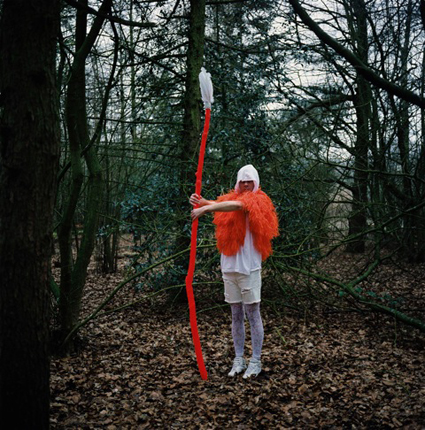
Christian Thompson, Flowering Spear – Donkere jongen die speer rechtop houdt from the Lost Together series, 2009
courtesy Gallery Gabrielle Pizzi
Christian Thompson, Flowering Spear – Donkere jongen die speer rechtop houdt from the Lost Together series, 2009
WHEN I WAS TWELVE, IN THE LATE 1950S, I DISCOVERED A BOOK OF ESSAYS AND CARTOONS BY THE AMERICAN HUMOURIST JAMES THURBER. I WAS REALLY TAKEN BY A CARTOON IN WHICH A WOMAN LANGUIDLY DECLARES TO A MAN, “IF THERE WAS ANOTHER SEX YOU WOULDN’T HAVE A CHANCE.” IN A FIVE-WEEK SEASON TITLED SEXES, RUNNING FROM LATE OCTOBER TO EARLY DECEMBER, PERFORMANCE SPACE WILL PONDER THE COMPLEXITIES OF GENDER VARIETY IN THE 21ST CENTURY THAT GO FAR BEYOND THE OLD MALE/FEMALE DIVIDE.
Performance Space is now led by a vigorous male/female duo, co-artistic directors Jeff Khan and Bec Dean. Both come from Perth where they each worked for a time at PICA (and occasionally wrote for RealTime). Khan became director of Melbourne’s Next Wave Festivals 2008 and 2010 and Dean moved to Performance Space as a producer after a stint at the Australian Centre for Photography.
Khan’s Next Wave broke new ground with an impressive range of live art and less categorisable works and Dean has curated significant exhibitions including Night Works (2010). Their expansive vision of what constitutes art means that Khan and Dean are not strictly confined to the roles, respectively, of programming performance and visual arts. As Performance Space always has, they see themselves as responsive to artists’ changing visions and needs, embracing both continuity and change.
As a team they’re engaging, clearly excited about their immediate program and what they envision for the future, turn-taking democratically in their responses to my questions and occasionally completing each other’s sentences with an ease that suggests a comfortably shared vision. There’s a lot of laughter. And there’s no doubting that the Performance Space community is more than pleased with their joint appointment.
then & now
On the matter of continuity, Dean says, “New possibilities for performance practice are fundamental to Performance Space. We’re really conscious of being an artist-led organisation and Performance Space always has been. Not that we’re headed by artists but we’re looking at practice and where that takes us. So while we’re currently diversifying with venues and activities we’re also looking at what artists are doing and where they’re wanting to site work and bring audiences to them.” Khan reports that, “Our joint program with the MCA, Local Positioning System, our Walks program (RT108) ad the current Halls for Hire program have achieved good audiences and good feedback, which made us think about working more off-site [from Carriageworks] and hosting more site-specific works.”
Dean says of Halls for Hire that “half the works have to be in the places they’re sited in: the CWA bake-off, Mass Action, 137 Cakes in 90 Hours, had to be at the CWA [Country Womens Association] in Potts Point; and The Making of a Flag: Give us Back our Unions at Sydney Trades Hall. We want to get out there and take audiences there and respond to artists. We are based at Carriageworks, but we don’t have to be there all the time; we can look for other possibilities. We think of ourselves as an agency.” Kahn points to “a lack of infrastructure for artists working in socially engaged and live art ways. It is important that they get logistical support, a critical framework and dialogue. It’s an exciting development for us.”
sexes: hypercritical and super fun
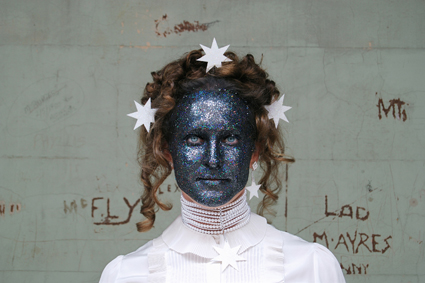
Liam Benson, Glitterface, 2010
courtesy of Artereal
Liam Benson, Glitterface, 2010
Dean and Khan tell me the forthcoming program, SEXES, at Performance Space was instigated by visual artist and activist Deborah Kelly, who had been prompted by a dream in which she experienced “a wonderful show but asked why she wasn’t exhibited in it, only to realise she’d curated it.” Kelly’s invitation to Dean and Kahn to co-curate came well before the pair became co-artistic directors. Subsequently they took up the proposal for a Performance Space season. The long gestation has presumably enhanced a program rich in ideas, provocative artists, installations, performances and events.
While SEXES was originally conceived in terms of the visual arts, Dean explains that the curatorial vision was that it not be limited to an exhibition model: “It could include performance, more diverse experiences and artists we might not have been able to use in a museum context. So it grew from there.” Khan adds, “It was an opportunity to be more risky in our progamming choices and a bit more fluid about the boundaries between artforms.”
performing sexes
Khan describes SEXES as “essentially an exhibition with 17 contemporary artists and a sort of live art program layered over it so that periodically the exhibition spaces will be animated by live performances that audiences might encounter. And there are two full-length shows in the theatres: Whelping Box which is a collaboration between Branch Nebula’s Lee Wilson and Matthew Prest, and Something in the Way She Moves, the culmination of Julie-Anne Long’s long-term The Invisibility Project (see interview, p32). The performance episodes and vignettes from that project are rolled up into a full-length show.
Kahn says of the Whelping Box, a work commissioned by Performance Space, that “it’s an intense physical theatre work about masculine rituals of physical training and competitiveness performed in a pit-like space in which the audience sits with the performers moving through and behind. Its super off-beat humour doesn’t let you off the hook.” While Whelping Box explores gender in a hypertheatrical manner, Long’s The Invisibility Project deals with the invisibility of middle-aged women “with a subtle performative treatment of the mundane and the everyday.” Performance Space is particularly pleased to be presenting this work given its support for it at various stages of its development.
Khan is excited about “the super-expanded Club House program, which includes the Dirty Movies by Artists Night, curated by Lex Lindsay, former director of the Queer Film Festival,” to which Dean adds: ’academic’ sessions with Anne Marsh and Ed Scheer talking about gender currents in contemporary art practice and CoUNTesses (Elvis Richardson; Women count in the artworld, http://countesses.blogspot.com.au), speaking about statistical representation of genders in public art spaces—annotated statistics: things get very compelling when you put them in pie charts [Laughs].”
Khan eagerly appends to the growing list of events “a night of queer core punk called Punk is Fuck with local band Glory Hole curating.” Dean admits knowing nothing about queer core punk, to which Khan retorts, “You’re learning.” A lot of us will.
bodies in question
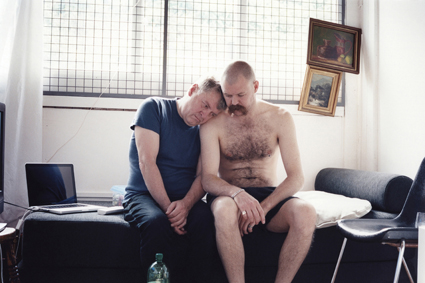
Paul Knight, from the series Chamber Music 2009-2012
courtesy the artist
Paul Knight, from the series Chamber Music 2009-2012
Talk turns to some of the artists in the exhibition. Trevor Fry, formerly of the Wild Boys (Dean recalls his drag work in the early 2000s), has “shifted to making ceramics, quite grotesque works—deity figures small and large, multi-phallused and surrounded by filth. It’s such extraordinary work you just want to bring it immediately from the kiln into public space.”
Eric Bridgman, famed for his performative portraits in which he appears in a range of roles, is, says Khan, presenting “a new body of work extending his drawing practice which has not been much seen. He recently did a residency in London focusing on it. The work is a series of large, free-standing drawn figures based on male porn stars and sporting heroes, starting with Rugby League players—Eric’s a Queensland boy. It addresses his long-standing interest in the sexual politics of sport and looking at the similarities in body culture and the exploitation of the masculine body as an object of desire in the physical performance of masculinity. Porn and sport are very similar! Bridgman’s work will be at the more provocative end of the SEXES spectrum.”
The Kingpins “will remount a recent video work not yet seen in Sydney called Spiritus Mundi (Spirit of the World), working with a lot of images of Dubai as an icon of contemporary capitalism. They perform as spirits of the world, as capitalist archetypes fucking the world.”
sexes in the foyer
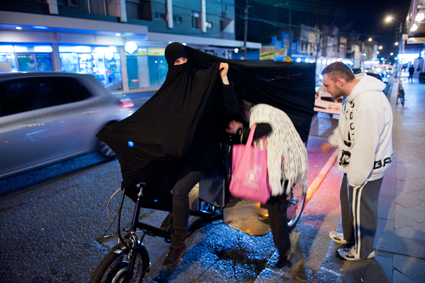
Cigdem Aydemir, Extremist Activity (ride), 2011, performance in Sydney
photo Alex Wisser
Cigdem Aydemir, Extremist Activity (ride), 2011, performance in Sydney
Dean reports that “Marley Dawson who works with mechanical constructs and machines will be reactivating the massive drive shaft in the Carriageworks foyer that used to run all the engines in the space. We’re in negotiation with the Heritage Commission to do it. Dawson is looking at gendered objects and spaces. Cigdem Aydemir is working on a similar scale running the length of the drive shaft. She’s working on extending the idea of the burqah as a cover. She covers objects and vast spaces with black cloth, here the long shaft with just a small visor cut out through which to see. One shaft, Dawson’s, will be visible, the other, Cigdem’s, covered, peeking out of the tunnel, the narrow space between Tracks 19 and 20.”
Khan is excited at the prospect of audiences being “welcomed to SEXES with a giant rotating shaft and a burqah-clad passageway—two large, highly performative sculptural interventions.”
Given the subject matter of SEXES it was important for the curators, says Khan, “not to take the easy path and have just a photomedia show, but to take on a more interdisciplinary approach, one departing from predominantly binarised versions of gender that dominate discussion in Australian art. Exhibitions of this kind have focused on either feminism or on masculinity or being queer. We wanted to do more, make a show about multiple positions jostling with each other as indicated in the title, SEXES.”
queering up
Dean reports, “We also had a fantastic response to the reactivated Stephen Cummins Queer Residency Bequest this year. Some of the artists will be part of SEXES. The bequest was set up to provide a prize for queer practice, but one of things we want to develop among Performance Space’s key areas of artistic focus is queer programming. The response showed us just how much work is out there and so much desire for the work to be transferred from the club scene into different contexts which we can facilitate and provide, otherwise the work will not be seen by a wide range of people.” Khan concurs, “Sydney has an incredible queer scene with work for parties and cabaret running parallel to the art scene. We want to connect with that scene and give artists tools to really refine their practice in a rigorous way, for which we’ve provided mentors like Julie-Anne Long, Chris Ryan and Deborah Pollard working on the inaugural round of residencies, mentoring individuals. Through it we got to meet Karli Munn who will curate Dirty Movies by Artists Night and Sarah Coconis, our first Cummins Bequest resident is shaping some of her material for the live art program of SEXES.”
various othernesses
Among the commissioned works, including those of Trevor Fry, is Parachutes for Ladies’ Like a Prayer which Dean describes as a sung work “built from notions, from a range of people, of what love will be like in the future. It will be presented operatically on opening night and then as sound interventions in the course of the exhibition.” The series of speakers, scattered across the exhibition space, will be sculptural.
While the ever incisively witty and subversive Christian Thompson will be showing his new work made in London around Sydney, the SEXES curators “are looking back to work made a few years ago which repositions gendered Indigenous persons in a European context using tableaux.” Tracey Moffatt and Gary Hillberg’s widely shown Other is a richly sardonic assemblage of film clips, familiar and rare, “addressing sexual desire in terms of otherness,” says Dean; “a tour de force: hypercritical and super fun,” quips Khan. Much laughter as we agree it would be a good publicity hook for SEXES.
Dean and Khan suddenly recall a key event in SEXES they’d forgotten to mention, a rare appearance by Pauline Pantsdown who will host Incite, a variation on the SBS Insight program, in which the audience—drag artists, special guests, the audience—all in drag (no admission otherwise), will discuss the performance of gender.
SEXES will doubtless remind us how far we’ve progressed from a time in which biology had the last word and doubtless how far into the future gender varieties and complexities will continue to yield angst, pleasure and art.
Performance Space, SEXES, curators Bec Dean, Deborah Kelly, Jeff Khan; Carriageworks, Oct 25-Dec 2; for program details, www.performancespace.com.au
RealTime issue #111 Oct-Nov 2012 pg. 54-55
© Keith Gallasch; for permission to reproduce apply to realtime@realtimearts.net
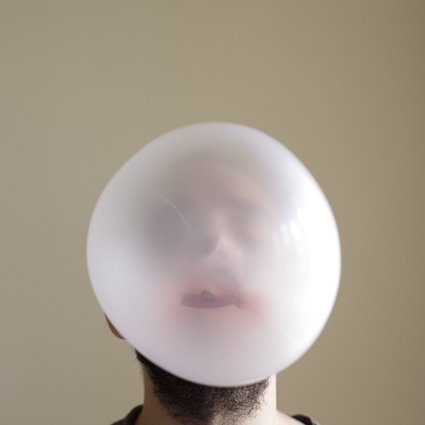
Yavuz Erkan, Bubblegum 2011
courtesy the artist
Yavuz Erkan, Bubblegum 2011
CCP DECLARES: ON THE NATURE OF THINGS PRESENTED ITSELF AS A ‘STATEMENT’ EXHIBITION THAT EXEMPLIFIES THE STATE OF CONTEMPORARY AUSTRALIAN PHOTOGRAPHY. THE WORKS WERE LOOSELY UNIFIED BY A FOCUS ON THINGS: AS SUBJECTS OF PHOTOGRAPHY OR THROUGH PHOTOGRAPHY’S CONSIDERATION OF ITS OWN MATERIALITY. THIS THEME BELIED A DEEPER CONSIDERATION OF PHOTOGRAPHY’S EXPANDED FIELD, OR OF ITS RELATION TO WHAT EXISTS BEYOND THE IMAGE.
Yavuz Erkan’s Unorthodox Aphorisms series uses things to create synaesthetic encounters that fire the senses and short-circuit the act of seeing that governs photography. These works mostly show the artist in staged interiors performing deliberate gestures with single props. Though employing Erkan’s gauche body and unusual situations to effectively confound our expectations of photographic display, the most striking thing about these scenes is their delicate sensuality. In one image, the folds of a towel wound around the artist’s averted head introduce a hint of texture and tactility. In another image, the immersion of the artist’s hand in a glass of snow white milk emphasises the liquid’s creamy viscosity. If an aphorism is a saying that is supposed to express a truth, in Erkan’s photographs this truth is not thought but lived, grounded in the body’s experiences and impurities.
Amy Marjoram’s Cloud Series 2010-2012 comprises shots of a cloud scrawled in black permanent marker on a window. The artist’s winsome drawing becomes a fetish that imbues an otherwise unremarkable view with quiet fascination, its presence rendering the trails left by water on the window’s greasy pall of dust in a work like Untitled 2 mournful or almost lyrical. The choice to include her looping Swanston Series 2009-2010 on a digital photo frame was curious, as these albeit intriguing works seemed incongruous next to others. Marjoram’s work leads into Nasim Nasr’s nine-channel video installation, What to Do? in which each screen shows a different set of hands working a string of worry beads accompanied by the sounds of prayer. The fetishisation of this object in male hands linked this work to Marjoram’s and alluded to the fraught politics of the Middle East, though the beads’ endless vacillation also makes the work’s strength—its ambiguity—its weakness, by undermining any cohesive political message. Nevertheless, the pervasiveness of the work’s quiet susurrus through the gallery space captures the everyday anxiety that motivates such rituals.
In Andrew Hazewinkel’s Head Replacement Therapy: (plundered #1-#6), the belatedness of documentation—the way it captures an object whilst also signifying its absence—is used as a resource. His six photographic objects are 19th century negatives of damaged classical statues screen printed on backlit glass, each with a thin slice of agate placed where the statue’s head would have been. This simultaneous act of restoration and defacement highlights the uncanny effects of disintegration, making us acutely aware of how wound-like each rough patch of broken marble seems. Hazewinkel’s acts of archival plundering exploit his source photographs’ strangeness and untimeliness, transforming documentation into work with its own singular mystery.
It is this concern with the singular that brings Hazewinkel’s work into dialogue with Jane Brown’s nearby suite. Her small prints show monochromatic, precisely composed scenes. The absence of human presence makes them acutely evocative of the passing of time. Empty, they become memorials created in anticipation of the inevitable expiration of the places they depict. In Brown’s work it is perhaps the photograph itself that foregrounds its status as thing, becoming a material remainder of a moment long passed.
A focus on the photographic product also motivates Jacky Redgate’s work. Her large format photographs from the Light Throw (Mirrors) series problematises the idea of a subject of photography. Constituted by complex combinations of objects, mirrors, reflections and sources of light, the images in this series refuse to resolve into comprehensible layers. Zones of intensifying shadow, the imperfect forms of card cut-outs and fields of colour created by blue and yellow plastic trays in Light Throw (Mirrors) #9 draw the eye into a dynamic compositional play propelled by uncertainty, constantly inviting and deflecting the viewer’s gaze.
The contained meditations of David Nixon’s Energy 2006-2012 series position themselves interestingly within the expanded photographic field on display. Each video shows a spotlit object moving in darkness: the sinuous motions of a feather boa; neon green tinsel reminiscent of scratched film; water-like polystyrene spheres. Though these objects are banal and can be linked thematically, there is something else operating in Nixon’s series. As well as chanting, the changing soundscapes accompanying the videos include wordless voices, droning and the sounds of violins: elements that remain indefinite even as they gesture to some reality. Instead of foregrounding the meaning of things, Nixon’s videos invite us to meditate on things as they appear. The effect is, paradoxically, one of stasis, as though Energy is capturing fixed qualities in the midst of movement and change.
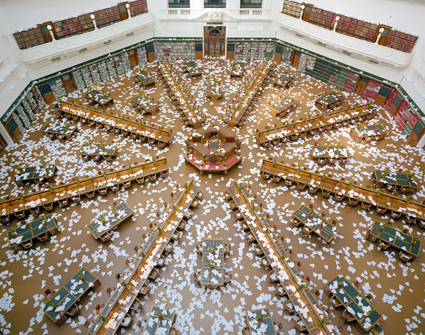
Ross Coulter, 10,000 Paper Planes – Aftermath (3) 2011
courtesy the artist
Ross Coulter, 10,000 Paper Planes – Aftermath (3) 2011
Whereas Nixon’s videos try to seal the qualities of things in hermetic depictions, Ross Coulter’s arresting Aftermath photographs can’t be divorced from the event they document. Aftermath depicts the debris of a performance at the State Library of Victoria in which Coulter had a team of 160 volunteers throw 10,000 planes from the La Trobe Reading Room’s balconies. Wanting to “capture the flight of thoughts, ideas and dreams through the library’s dome” (State Library of Victoria documentation), Coulter’s action was both whimsical materialisation of an abstract notion—thought—and a subversion of the library’s conservationist functions. Though beautiful, the grounded planes dappling the shelves are also reminiscent of a battlefield full of casualties. This focus on what remains dramatises the difference between performance and its capture, reminding us that the fleeting and abstract must also come down to earth.
Brought together by an exploration of the status of the photograph, or by its relationship to its outside, the works in CCP Declares map a compelling field of expanded photographic practice. If this mix of emerging and established artists is anything to go by, Australian photographic practice is in a healthy state.
CCP Declares: On The Nature of Things, curator Kyla McFarlane, artists Jane Brown, Ross Coulter, Yavuz Erkan, Andrew Hazewinkel, Amy Marjoram, Nasim Nasr, David Nixon, Jacky Redgate; Centre for Contemporary Photography, Melbourne, Aug 3-Sept 16 September
RealTime issue #111 Oct-Nov 2012 pg. 55
© Scott Wark; for permission to reproduce apply to realtime@realtimearts.net
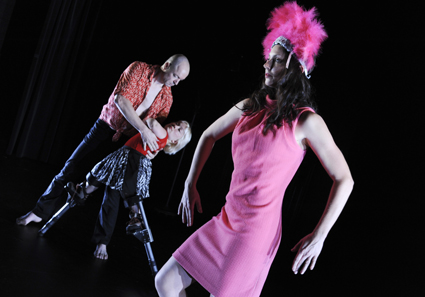
James Berlyn, Kiruna Stamel, Rachelle Hickson, Variant
ALTHOUGH SUE HEALEY’S PREVIOUS WORK HAS ENTAILED DRAMATICALLY PERFORMATIVE COMPONENTS AND SOPHISTICATED MULTIMEDIA IMAGERY (THE CURIOSITIES, NICHE/JAPAN), I USUALLY ASSOCIATE HER WORK WITH THE KIND OF LYRICAL FORMALISM SO EVIDENT IN THE CHOREOGRAPHY OF THE NICHE AND IN TIME SERIES WHERE SHE HAS EXPLORED THE BODY AT THE INTERSECTION OF TIME AND SPACE—A MOVEMENT LANGUAGE THAT PERSISTS IN HER WORK.
In Variant, Healey has turned explicitly to dance theatre. A promisingly idiosyncratic narrative voiceover from Brian Carbee delineates the lives of the eccentric characters who populate a shared house. Unfortunately, in Healey’s rendition Carbee’s wry, neo-gothic storytelling disappears for long periods and often bears little relationship to what happens on stage—most obviously when Carbee predicts a terrible domestic clash and none eventuates. Expectations are quashed. Of course, lateral connections between narrative and image have long been de rigueur but here they are simply too loose. Just as problematic, some performer personae are more developed than others.
In a show replete with stilt walking, a drag act, stage magic, parodic ‘freak’ acts and some delicate but limited dancing from a pair of ‘twins,’ the music is an uncomfortable mix of cabaret, contemporary classical, neo-baroque and folk (in which the household finds reprieve in mass dancing). Although clearly not short on talent, Variant appears under-developed, neither through-composed nor through-choreographed: there is too much variety at the expense of what might have been a taut comedy of interlocking bodies and the surfacing of subterranean desires.
–
Sue Healey and Company, Variant, choreography, with the performers, Sue Healey, performers Narelle Benjamin, James Berlyn, Benjamin Hancock. Raelene Hickson, Kiruna Stamell, Nalina Wait, songs and piano Pat H Wilson, design Tobhiyah Feller, lighting Jenny Vila, producers Performing Lines, Seymour Centre; Seymour Centre, Sydney, July 26-Aug 4
Read more about Sue Healey in RealTimeDance
RealTime issue #111 Oct-Nov 2012
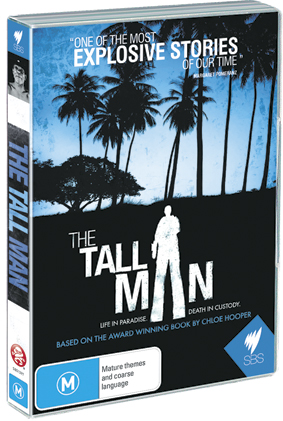
The Tall Man
The Tall Man, Madman DVD
“Tony Krawitz’ documentary The Tall Man painfully captures the horrendous ambiguities surrounding the death of Mulrunji Cameron Doomadgee on Palm Island in 2004 and the failure to convict police sergeant Chris Hurley for his part in the man’s death. Like Chloe Hooper’s award winning book of the same title, this is a film that attempts to deal with both (or more) sides of a story that is deeply complex given the character of Queensland colonialism, its police history and the cruel peculiarities of Palm Island….[The film is] an indictment of a system that has ruined the lives of Indigenous people and then held them guilty for the outcome.” Keith Gallasch, RT102.
5 copies courtesy of Madman Entertainment, www.madman.com.au
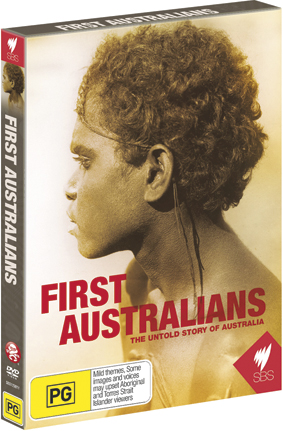
First Australians
First Australians, 7 Documentaries, Madman DVD
Another in Madman’s Stories That Matter series is the award-winning and groundbreaking, epic series First Australians written and directed by Rachel Perkins with fellow writer-director Beck Cole and writer Louis Nowra, and produced by Perkins with David Dale and SBS. “First Australians chronicles the birth of contemporary Australia as never told before, from the perspective of its first people. First Australians explores what unfolds when the oldest living culture in the world is overrun by the world’s greatest empire. Over seven documentaries, First Australians depicts the true stories of individuals–both black and white—caught in an epic drama of friendship, revenge, loss and victory in Australia’s most transformative period of history” (press release). Superb viewing.
5 copies courtesy of Madman Entertainment, www.madman.com.au
The Tall Man and the First Australian's is part of Madman’s culturally significant series, Stories that Matter.
——————-
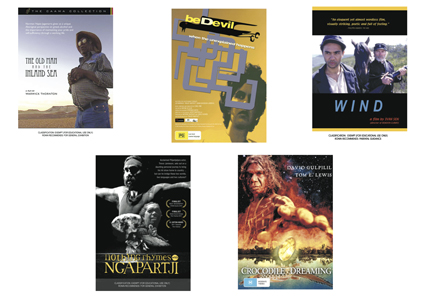
From Ronin Films: 5 remarkable Australian films on DVD
Ronin Films has an astonishingly large and exemplary catalogue of films by and about Australian Aboriginal and Torres Strait Islander peoples. They are offering to one lucky RealTime reader a collection of five DVDs: Tracey Moffatt’s Bedevil, Iven Sen’s Wind, Warwick Thornton’s The Old Man and the Sea, Darlene Johnson’s Crocodile Dreaming and Suzy Bates’ Nothing Rhymes with Ngapartji—which documents actor Trevor Jamieson’s involvement in the acclaimed theatre production Ngapartji Ngapartji.
1 set courtesy of Ronin Films
Ronin Films is offering schools a 30% discount for 10 films on DVD from their Indigenous collection for 2013. For the full Ronin Films Indigenous Australia catalogue go to www.roninfilms.com.au or contact the company at admin@roninfilms.com.au.
Email us at giveaways@realtimearts.net with your name, postal address and phone number.
Include ‘Giveaway’ and the name of the item in the subject line.
PLEASE NOMINATE ONLY ONE GIVEAWAY
RealTime issue #111 Oct-Nov 2012 pg. 56
© RealTime ; for permission to reproduce apply to realtime@realtimearts.net
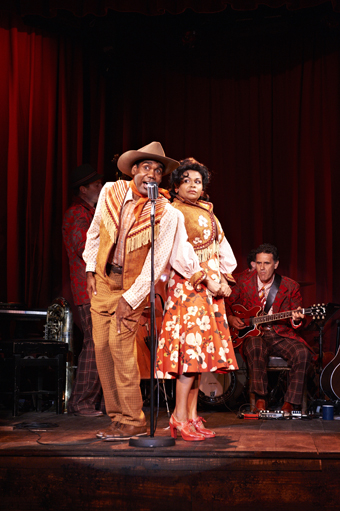
Trevor Jamieson, Ursula Yovich and David Milroy on guitar in his play Waltzing the Willara, Yirra Yaakin Theatre
photo Jon Green, courtesy Performing Lines
Trevor Jamieson, Ursula Yovich and David Milroy on guitar in his play Waltzing the Willara, Yirra Yaakin Theatre
THE FIRST PLAY DAVID MILROY WROTE WAS IN 1997. CALLED RUNUMUK, IT WAS FOR A NEWLY FOUNDED WESTERN AUSTRALIAN THEATRE COMPANY, YIRRA YAAKIN. DAVID, LYNETTE NARKLE (CURRENTLY SEEN AS THE MATRIARCH IN THE FILM THE SAPPHIRES) AND PAUL MCPHAILX, PROGRAMED YIRRI YAAKIN’S FIRST SEASON WITH PLAYS THAT HADN’T YET BEEN WRITTEN. AND THEN DAVID WROTE SOME OF THEM, CREATING A PLAYWRIGHT IN THE PROCESS. HERE, HE REFLECTS ON THE EVOLUTION OF ABORIGINAL THEATRE AND CURRENT ISSUES THAT HE FEELS NEED TO BE ADDRESSED.
In those early days Aboriginal plays were viewed with curiosity. They were ‘exotica.’ Of course there were people with a genuine interest in Aboriginal stories too. We had been written out of history and as a country we were late in catching up. In the 70s and 80s there was a lot of ignorance about our stories and history, and we weren’t that visible being such a small percentage of the population. There were no Aboriginal theatre companies other than the Redfern model so we had to play ‘catch-up theatre.’ Of the early plays, those of Jack Davis, Kevin Gilbert and Bobby Merritt were heavily based on the experiences of the writers and the people around them. The politics were quite strong.
fiction, non-fiction and ethics
Lately there have been more autobiographical plays—interesting works about interesting people—and they are very valid but, personally, I don’t do non-fiction shows any more. I am more interested in the craft of fiction. Non-fiction shows are also challenging to navigate in terms of permissions—the community, the extended family and the person you are writing about. You are pulling the lid off their life. That is a noble journey and for some, it can be very cathartic. You still have to be responsible to culture and community if you are writing fiction to keep it real and authentic.
writing for both audiences
I started off by writing shows with big casts and then, slowly, I wrote more ‘practically’ and the shows became more manageable in terms of cast numbers, to the point where I was just writing single handers. Now I just write what the show requires regardless of cast size or staging. It’s up to the powers that be if it gets a run. Audiences have also evolved since then. As Aboriginal writers we don’t have to spell everything out, post-”Sorry.” I write for both audiences: our own community and non-Aboriginal. For me, a play needs to be accessible to both, and each reacts differently—laughing and cringing at the same scene.
more than catch-up theatre
What has changed since I started in theatre? The styles of plays being written for one. Back then, the politics of the time were such that our theatre was about telling stories that had been erased from (public) discourse. But Aboriginal culture isn’t exclusively about ‘catch-up theatre’—having to educate audiences about our history and what really went on in this country. We have so much more to give. In terms of the future you can’t determine or predict what stories will emerge, that will happen organically. But it is exciting; there’s all sorts of energy around hybrid forms; theatre and music, theatre and multimedia, theatre and circus. It’s healthy. We have always adapted and evolved.
the next generation
Looking at where we are now, one of the burning issues for me concerns the next generation of artists coming through, and their training. When I began, yes, I was young and passionate but I fell into playwriting and I could have done with some guidance. I didn’t know the history of Aboriginal theatre and the politics of it. I didn’t know about genres of writing. I am not saying we have to slavishly follow western styles of playwriting but developing theatre would be easier if we knew what they were. I had no idea what a metaphor was! So, we need to focus on the next generation, to look at training pathways, and not just for actors and writers and directors but our stage managers, set, lighting designers etc. The major Indigenous training institutions—West Australian Academy of Performing Arts, the Aboriginal Centre for the Performing Arts in Queensland and the Eora Centre in Redfern—still struggle with inadequate funding. It will be great to put energy and resources into that.
room for optimism
Am I optimistic about the future for Aboriginal theatre? If you had asked me three years ago the answer would have been no. There were some great shows but less of them, companies were struggling or going under. We hadn’t had a black playwriting conference in years. I thought, “this is the end of black theatre—we will fade to the fringe.” It was a wakeup call. The National Indigenous Theatre Forum happened, and the Australia Council and others got to see that we had a united voice and some things changed such as the Yellamundie Playwriting Conference. Now I’m optimistic!
protocols & stories
There are other issues around how mainstream uses Aboriginal theatre content, how they engage with the community around protocols, and issues of more non-Aboriginal writers writing Aboriginal stories. We need to stay strong, and make our agenda clear to them. We’ve come a long way but there’s still a long way to go.
acknowledging theatre elders
I’d say my other burning issue is around acknowledging our theatre Elders, those living legends, and those who have passed on. We need a national event to acknowledge them and the role they have played, the strong foundation they have laid down for us to have a thriving industry and a pathway to the future.
This article has been edited from an interview with David Milroy conducted by RealBlak editor Jane Harrison.
RealTime issue #111 Oct-Nov 2012 pg. 21
© David Milroy; for permission to reproduce apply to realtime@realtimearts.net
At RealTime we’re proud to have been invited to host RealBlak, an initiative coming out of the 2011 National Indigenous Theatre Forum. Aboriginal and Torres Strait Islanders, guided by the editorship of Jane Harrison have written authoritatively and passionately about their engagement with the performing arts in terms of culture, protocols, personal ambitions and their relationship with white institutions and practices. We hope this initiative will further the wonderful work produced by Australian Indigenous artists in theatre, contemporary performance and dance by expanding the possibilities for writing critically about practice. Our thanks go to Liza-Mare Syron, Andrea James and Alison Murphy-Oates for inviting us to manage and publish RealBlak and for the opportunity to work so happily and collaboratively with Jane Harrison.
In this edition we welcome back Philip Brophy to the pages of RealTime as columnist with AudioVision, guaranteed to get you thinking twice about the unreal media reality that increasingly consumes us. Philip contributed extensively to RealTime in the 1990s and 2000s with his much-admired Cinesonic column about the relationship between image, music and sound design in film.
Vale Vikki Riley, who died recently in Darwin on her way to visit refugee detainees. Vikki’s memorably eccentric and perspicacious reviews of the dark edge of popular music had a strong following in RealTime in the 1990s. She is missed.
RealTime issue #111 Oct-Nov 2012 pg. 1
© RealTime ; for permission to reproduce apply to realtime@realtimearts.net
uts international animation festival
A wide array of local and international animation will be on offer at the upcoming UTS Sydney International Animation Festival (Oct 12-14). Premiering this year are two contrasting independent features from France’s Bibo Bergeron and the Czech Republic’s Tomáš Lu?ák. Bergeron’s child-oriented, somewhat Americanised yet still wondrous A Monster in Paris is a visually lush steampunk adventure-romance which references King Kong and the early days of cinema. Lu?ák’s Alois Nebel, while no less visually impressive, is a decidedly adult film based on the Czech Republic’s first modern graphic novel. Beginning in 1989, the year during which Czechoslovakia’s Communist regime fell, it is a stark yet moving portrayal of one man’s personal struggle with nightmares past and present.
Another festival highlight, Dance of the Shadows, documents the life of Lotte Reiniger, the German film artist responsible for creating the first feature-length animated film in history. The festival will also show¬case animated documentaries, up-and-coming Japanese animators, promising local talent including Indigenous animator Jason Japaljarri Wood and some particularly strange fare during a “Late Night Bizarre” session, as well and discussion panels. Katerina Sakkas.
UTS Sydney International Animation Festival, Oct 12-14; http://www.siaf.uts.edu.au/
are we there yet?, uwa & the cruthers collection
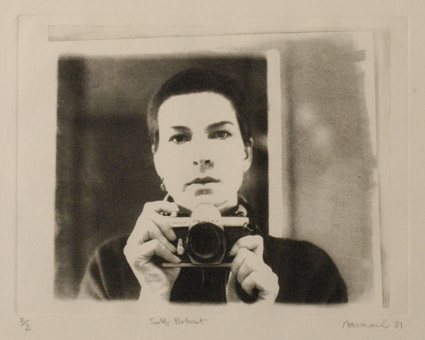
Anne Newmarch, Self portrait, 1981, photo-etching
courtesy the Cruthers Collection
Anne Newmarch, Self portrait, 1981, photo-etching
After a few years of relative quiet on the subject, feminism is once again a hot topic as women from generations Y & Z explore their connection to previous thought and the role of women in their own milieu. Recently Serial Space’s Time Machine dedicated a whole day of their festival to explore the role of women in media and technology-based art (see Dan Mackinlay’s account). Now the University of Western Australia, in collaboration with the Cruthers Art Foundation, has announced a two day symposium titled Are we there yet?.
The event accompanies the exhibition Look. Look again: the Cruthers Collection of Women’s Art, the first significant survey drawn from the collection featuring work by female Australian artists who have mostly slipped under the mainstream artworld radar. Including pieces from over the last century the works in the exhibition range from portraiture, domestic studies and still life to abstraction and political activism.
The Cruthers Collection of Women’s Art was donated by Sir James and Lady Sheila Cruthers to the University of Western Australia in 2007 and represents the largest collection of work by women in Australia. The symposium brings together curators, artists, historians and theorists to discuss the importance such a collection has to the future of female representation in the arts. Speakers will include Felicity Johnston, the curator of the Cruthers Collection, Leigh Robb, curator at PICA, Catriona Moore, lecturer, Art History and Film Studies at University of Sydney, Ted Snell Director, UWA Cultural Precinct and the CoUNTess who writes a blog exploring the uneven representation of women in Australian art (http://countesses.blogspot.com.au/) and is a participating artist in the Performance Space SEXES program (see article).
Are We There Yet? a two-day symposium on women’s art, Oct 20-21, registrations open until Oct 19, UWA, registration & info; Look. Look again: the Cruthers Collection of Women’s Art; Lawrence Wilson Art Gallery, UWA, Perth, Oct 20-Dec 15; http://www.lwgallery.uwa.edu.au/cruthers-collection-of-womens-art
lecture—improvlab with artists from the forsythe company
While Melbourne gets the Forsythe Company experience in full, Sydney doesn’t miss out entirely. Thanks to Shane Carroll and Meredith Brooks, company dramaturg Freya Vass-Rhee and dancer Riley Watts will be conducting a workshop and presenting a lecture at the Bangarra Studios.
Vass-Rhee and Watts will be in Sydney collaborating with cognitive scientist Kate Stevens on the Dance Engaging Science project which is part of the Forsythe Company’s Motion Bank activities. Motion Bank is a four-year project (2010-13) which involves the publication of digital dance scores created by guest choreographers including Deborah Hay, Bebe Miller and Jonathan Burrows and Matteo Fargion (see article). It involves research into how the “special qualities of computer-aided recording and design can be applied to the challenge of documenting, analysing, notating and presenting dance with the aim to extend and complement creative practice” (website).
Vass-Rhee will give a 65-minute lecture titled Performing Perception which will present some of her research into Forsythe company’s working methodologies. Riley Watts will then conduct a two-part practical workshop for 20 dancers exploring the movement and awareness practices employed in the company’s work.
Lecture—improvlab with artists from The Forsythe Company, Bangarra, Studios Sydney, Oct 20, lecture 1pm, workshops 2.15pm; for more information and bookings email shane.e.carroll@gmail.com; <a href="http://motionbank.org/en/" target=”_new”>http://motionbank.org/en/
RealTime issue #111 Oct-Nov 2012 pg. web
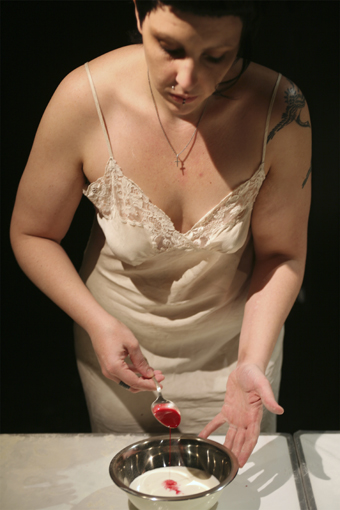
Sarah Jane Norman, Take This, For It Is My Body
photo Carl Newland
Sarah Jane Norman, Take This, For It Is My Body
BLOOD IS JUST SUCH CLEVER STUFF. AS A SUBSTANCE AND AS A METAPHOR; EVEN THE WORD ITSELF ON THE PAGE HAS A UNIQUELY RICH POETIC TONE. IN THE COURSE OF MAKING UNSETTLING SUITE, MY CURRENT BODY OF WORK, I HAVE BECOME DEEPLY INTIMATE WITH BLOOD IN ALL ITS FACETS.
In preparation for Bone Library, I’ve spent nearly a year, it seems, with blood permanently encrusted under my fingernails, the result of months spent cleaning animal bones, pushing out plugs of bloody marrow; and I’ve gradually learnt the best spots on my own body, with its recalcitrant veins, to draw blood, having trained myself via the many DIY hotel-room phlebotomies that have had to be discreetly performed for Take this, for it is my body. Materially, physiologically and symbolically, blood is an undoubtedly fascinating substance.
Unsettling Suite as it stands comprises three finished works and one in development: Take this, for it is my Body (2010; RT101); Corpus Nullius (2011); one as yet forthcoming/untitled; and finally the monumental Bone Library (2011-ongoing). For the purpose of this article I’ll be speaking through only one of these works, Take this, for it is my Body. First presented at InBetweenTime in Bristol in 2010, this work had been more than six years in the making. It was subsequently performed twice in Sydney, once at Performance Space, which has been a home venue for me throughout all the years of my growing practice, and once at Elizabeth Bay House for the NSW History Council.
Take this, for it is my Body has gone through multiple reconfigurations, from a one-to-one performance, to a performance for small groups, back to one-to-one again but with my own performing body replaced by my mother’s. Through all its permutations, the core action remains unchanged: in the work the audience sits at a table and is offered a slice of warm, homemade bread. They can choose to consume or otherwise, in full knowledge that the ingredients include 6mls of my blood.
My mother was of a generation in which Aboriginal people were classed, like cattle, according to a quantitative judgment of blood. In an era prior to the granting of basic citizenship to Aboriginal people, the question of how much ‘native blood’ a person had in their veins could determine a great deal about their circumstances.
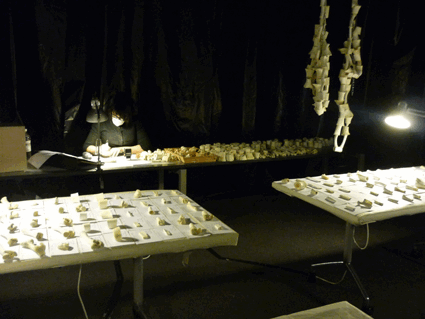
Sarah-Jane Norman, Bone Library
photos Annaki Kissas
Sarah-Jane Norman, Bone Library
It enrages me to be asked, as an Indigenous person, how much Aboriginal blood I have in me, or worse, when people blithely attempt to classify my identity in halves or quarters. I’ll field such questions diplomatically, because ignorance is not a crime. People ask not out of racism but out of genuine curiosity. It’s questions, and not the people themselves, that are racist. They represent a continuation of the same apartheid consciousness which atomised my family, which put my olive-skinned mother on one side of the line in the post office and my black Aunty Launa on the other. The truth of my blood and my family heritage is this: I was born in Sydney. My father is British and my mother is Aboriginal. Where I am truly from is a question to which I don’t, and never will have, a single answer. I am a proud Aboriginal Australian, of Wannarua and Wiradjuri heritage. I am also a citizen of Great Britain and a sometime resident of the European Union. Indigenous artists have walked this line for a very long time. There is a natural facility with the discourses of cultural hybridity among Indigenous peoples from which I daily draw strength. I’ve learnt to reside in these ambiguities of self as a gesture towards a cultural paradigm which no longer asserts the power of absolutes.
The idea for Take this… arrived, as most things do, as a puzzle. A collection of separate parts, which held within them the potential to interlock. During the work’s development I thought about a great many things. I remember hearing about a very old French folk lyric, about village women making bread. The women sing of kneading the dough between their thighs, of its softness and warmth, and of bringing themselves to collective orgasm through their labour. I thought about my grandmother, Aunty Biddy, working as a shearer’s cook on a station in outback NSW in the early 1960s, and wondered if, in making the damper or the scones for the Boss and the Missus and the men, she ever considered doing the same. I thought about the mesmeric, earthy fecundity of that gesture, and of its generational continuity: why it was that I, who grew up on Sunblest and Tiger loaves from the local Vietnamese bakery, could feel such an old, archetypal and robustly female energy animating that gesture? Why, in the process of kneading dough on my benchtop in Darlinghurst, I could feel another body, or bodies, spectrally taking possession of my own, that my grandmother’s blood and spirit were alive in my own flesh.
When I was 12 I thought about cutting my finger and bleeding into the ANZAC biscuits. Of course, I thought about the Holy Communion. I thought about the so-called Syncretic religions, the absorption of the saints and rituals of the (usually Catholic) colonial power into the Indigenous belief systems of the area: Haitian Voudoun is one such religion, and I wondered if the Aboriginal relationship with Christianity and increasingly, Islam, might not fall in similar territory. Last of all I thought about the poisoning of the flour rations that were sent to Aboriginal missions, and how this represents for me one of the most frightening truths of human atrocity; that the processes of genocide are manifold, that its most effective modes are frequently the subtlest. I thought broadly about the notions of ‘contamination’ and ‘assimilation’ and their resonance; gestures of absolution, and modes of defiance. I thought about that powerfully awful expression, “a lick of the tar brush,” and how I have heard it used, without irony, in reference to myself by supposedly educated and politically aware people, as though my culture and heritage were some kind of cheeky smear on my otherwise passable ‘whiteness.’ I thought about this notion of being of ‘mixed blood’ and what it might mean to reclaim this as a position of strength: where is its poetry, its power? Is there an image to hold it and carry it? I thought about a great many things, all of which eventually culminated in a simple offering, which continues to develop and resound.
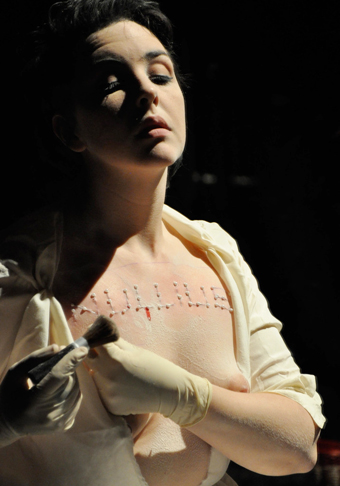
Sarah-Jane Norman, Corpus Nullius/Blood Country (2011), part of the Unsettling Suite
photo Penelope Benton
Sarah-Jane Norman, Corpus Nullius/Blood Country (2011), part of the Unsettling Suite
Like most practitioners who move in that territory that might be broadly called performance (or Live Art, or Performance Art, or Contemporary Performance, or body-based or time-based art, depending on context and discursive vogue), I have come to my current location via multiple elsewheres. My background is varied: training in theatre, dance, visual arts and cultural studies have all shaped my practice.
My practice is transnational and inter-local by necessity. It was appropriate that the first performance of the Unsettling Suite cycle should be presented in Bristol, because Bristol was where the work was seeded. I moved there in 2006, by way of Tokyo and rural Devon. It was in Bristol, through the community of artists that I found there and with whom I still share close creative and personal bonds, that I first came into an awareness of what I now recognise to be one of the most significant gifts of artistic practice: connectivity, the potentiality of infinite, lateral movement through transnational communities, linked by common dialogues. I felt at home as an artist in England in a way that I didn’t as a human being. It was perhaps this tension that fostered the seed ideas for Unsettling Suite.
I feel confident in the assertion that Britain has not processed its history as a former colonial power to the extent that Australia, and certainly Aboriginal Australia, has had to interrogate its own history as a former colony. The brunt of the work, when it comes to unpicking the true meaning of this complex state we call “postcoloniality,” seems to fall more often than not on the former colonial territories. As an Aboriginal Australian artist it seems assumed that the business of interrogating postcoloniality falls squarely within my jurisdiction. That’s just the way it goes, I suppose. Postcoloniality is a shared state. We are all post-colonial: if there is one truly global dilemma that would have to be it. I feel privileged, as an Aboriginal artist, to be at the vanguard of rethinking that discourse.
Blood is such clever stuff: it has profound intelligence and a long memory. History is never history. It’s alive in the written and unwritten rules of our world. It’s alive in our language. It’s alive in the depths of our bodies. This is something that is traditionally understood by Aboriginal people; that our bodies are of the land and the land is of our ancestors. History is something to be understood viscerally. Perhaps the depth of grief that continues to haunt our culture/s is what fuels the necessity to tell and re-tell this history, and the articulation strikes home because of the sheer force of its necessity. Does grief make us eloquent? If every work of art is an exercise in cheating death, in defiance, in the re-ignition of the spirit, then yes, it does. I can’t be certain and I can’t speak collectively. Only through practice can I begin to grasp for insight.
RealTime issue #111 Oct-Nov 2012 pg. 3
© Sarah-Jane Norman; for permission to reproduce apply to realtime@realtimearts.net
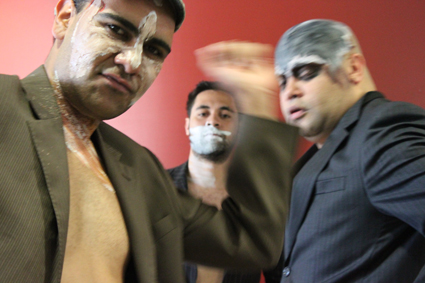
Sonny Dallas Law, Bjorn Stewart, Colin Kinchela, Bully Beef Stew, PACT Centre for Emerging Artists
photo Cat Jones
Sonny Dallas Law, Bjorn Stewart, Colin Kinchela, Bully Beef Stew, PACT Centre for Emerging Artists
WHEN I TELL PEOPLE I AM AN ANIMATEUR, SOMETIMES THEY SAY, “OH, SO YOU MAKE ANIMATIONS.” “NAH,” I REPLY, “IT’S A WEIRD FRENCH WORD THAT’S USED AT THE VICTORIAN COLLEGE OF THE ARTS. IT’S WHAT WE DO WHEN WE MAKE THEATRE FROM SCRATCH.”
Us animateurs, we don’t rely on the well-made play. We bring together a group of artists and we enter the unknown. It’s not community cultural development and it’s not (cue dreaded music) ‘group devising.’ It is deeper than that. It’s theatre making. Making theatre from scratch. We scratch below the surface and we dig deep into the dirt.
This business of animateuring requires great courage and the people you bring with you on that journey must be brave and talented. Not Young Talent Time or X-Factor talented; just fearless, smart and intuitive. This thing that we do requires great courage. We open ourselves up and we push things to the edge and beyond. We risk failure, ridicule and scorn when we push too far.
Most animateuring begins with a question or a hunch. An itch that just has to be scratched. We draw a big circle in the sand and we enter the play space. In that room or space we push through the shame barrier. We flail about with our bodies and minds looking for that sweet honey spot of truth; and when a brave, intuitive actor steps into this spot, our world is illuminated and we breathe a collective sigh.
Why is animateuring important for us theatre mob? Because it’s the closest thing we can get to initiation and ceremony. Big call? In our ‘modern’ worlds, away from the bush and the aunties and uncles, we constantly seek that place around the fire. We yearn for stories, dance, ceremony and tradition and we seek and find these things through our craft.
bloodland
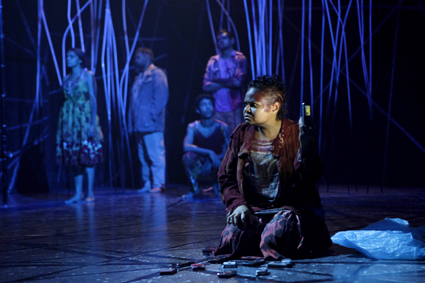
Bloodland, Sydney Theatre Company
photo Danielle Lyone
Bloodland, Sydney Theatre Company
To be an animateur requires deep listening or what Stephen Page calls “listening with your eyes.” I am reminded of the making of Bloodland, a collaborative theatre performance piece co-produced by Bangarra and the Sydney Theatre Company in 2011. I have long been inspired by Stephen’s segues away from straight dance—that magic moment when a dancer speaks or when a singer or actor is allowed onto a dancer’s stage—when monologue, poetry, song and yarning are allowed to spring forth. This began for me with Bangarra’s Skin in 2000 (providing some of the most memorable moments on the blak stage, aided brilliantly by the performances of Wayne Blair and Archie Roach).
So I was pleased to see Stephen step even further into the world of theatre with Bloodland (2011). Even more pleasing was the fact that the spoken word in the piece was predominately Yolngu. How gloriously annoying this was for some audience members who have become complacent, who want a plot, story, subtitles and characters to laugh at. Yet I was transfixed and reminded of Samuel Beckett’s Waiting for Godot—these two fullas who wait around as if they are on ‘sit down money,’ where words seem to have no logic, but where the atmosphere and SPIRIT is thick. Just like in Godot, the people in Bloodland had a dilemma that was presented to us in all its glory and ugliness. The audience was placed in a privileged and voyeuristic position and we left the theatre feeling unsettled.
This brave new work was made (animateured) within four weeks. Bringing Wayne Blair’s treatment/script and some character outlines to the Yolngu homelands, the creative team made this work from scratch. As Stephen reiterated, “It’s rude to go in with your theatre plan. It was best just to go in…”
In a work deeply embedded in language and cultural principles, two moieties were formed within a cast/clan. Stephen Page describes his process as a “contemporary initiation”:
“Because we’ve never learnt the fear of that. Because we’ve been dictated to about how to fear…In our culture the fear is much more potent…If you’re back in your country you’ve gotta be out at a certain time between wet and dry season to get some gathering. And if you’re not back for that sun, that’s your initiation. That sun sets and you haven’t gotten back, that’s your initiation. You’ve gotta be able to monitor land and land’s gotta be able to shape your fear and you’ve gotta build a balance between that so that you can survive that initiation…Whatever organically happens in the process usually is what ends up on stage.”
This is what makes good animateuring. The blakness. Going into the unknown. Hanging around til just after the sun sets, then coming back to camp to dance, sing or tell your story. Not to say that we all have to go up to East Arnhem Land to find that place. Some peers criticise Page for his approach, saying that this feeds the stereotype that only real blackfullas are up north. It’s wherever we find our inspiration; each of us has our own traditions, country, stories, totems to draw upon and that’s what keeps the blak theatre fires burning.
bully beef stew
I recently experienced theatre as ‘contemporary initiation’ when I collaborated on Bully Beef Stew (RT105) at PACT Centre for Emerging Artists with Sonny Dallas Law, Colin Kinchela and Bjorn Stewart as they walked valiantly into that ‘dark place.’ As animateur it was my job to provide a creative framework for these wonderfully talented artists to explore Aboriginal male experiences and notions of initiation. As an Aboriginal woman I was required to leave the room many times and I will never know what happened behind that door. All I know is that when I came back to see them perform, they had changed. I love it when theatre can do that. When the indescribably sacred is felt but not known.
the next generation
Which leads me finally to the voice of our next generation of animateurs:
Possible idea for a play
1. Get Indigenous actor
2. Throw some dirt on stage
3. Profit.
This Facebook status update was posted by the cheeky and irreverent Bjorn Stewart on August 22. As a young blak theatremaker trying to find his way in a competitive and cutthroat industry, he threw this line out to see if he would get any bites. And bite we did:
Colin Kinchela It’s already ‘©’d’ :p
Sonny Dallas Law Hey i did that back in 2006!! lol
Andrea James What about ‘throw dirt on actor’??????
Bjorn Stewart Damn it! See now all you blackfellas are trying to steal my idea!
For us animateurs, concepts of ceremony, tradition, initiation and clan systems are hard to uphold in an industry that is essentially market driven and predominately controlled by non-Aboriginal artistic directors and bureaucrats obsessed with bums on seats. Limited funding and therefore limited time often forces us to reduce our cultural ambitions. Going onto country to make work is a per diem minefield that needs to be battled. Waiting for country to speak to us doesn’t always fit neatly into a project budget. Furthermore, the idea of ‘profit,’ as Bjorn so succinctly puts it, flies in the face of more traditional notions of reciprocity.
With our practice comes a sense of cultural responsibility and the unspoken expectation of reciprocity that some non-Aboriginal artists can avoid. Us blackfulla artists avoid this at our peril. Our work is about much much more than mooms on seats. There’s a blak commerce at play too.
“None of that is contracted legally,” says Page. “It’s all based on bartering and giving back and going up there and doing shows, workshopping with the kids… That has a lot to do with this organic process….here’s this full circle of giving back from where inspiration is.” This is the gift that Aboriginal artists give back to their communities in recognition and appreciation of our inherited stories and traditions.
Animateuring—making theatre from scratch—is vital to our cultural and artistic expression as blakfulla artists. Something that cannot always be served by wornout play commissioning processes and/or predictable subscription seasons (if I see another translation by another white male I’m going to scream!)
Which is why we must keep scratching, keep digging and telling our stories our way.
RealTime issue #111 Oct-Nov 2012 pg. 4
© Andrea James; for permission to reproduce apply to realtime@realtimearts.net
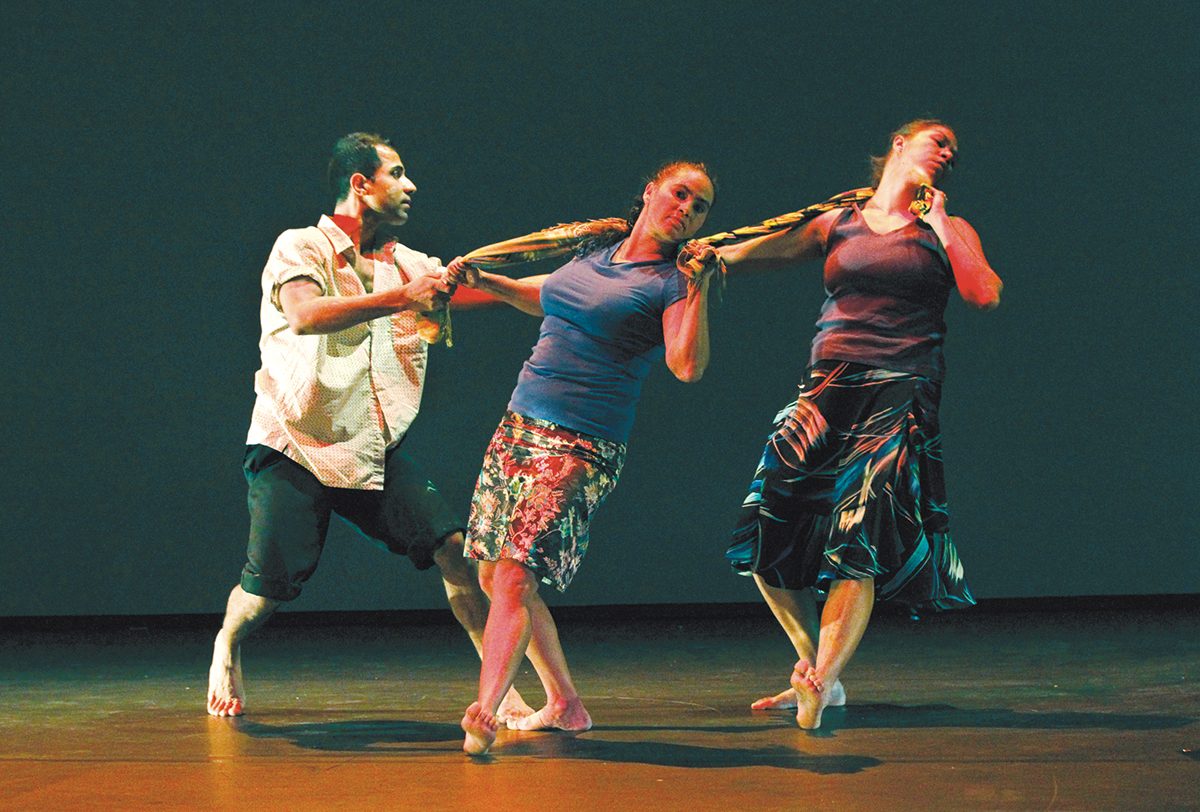
Raghav Handa, Henrietta Baird, Rosealee Pearson, Briwyant, 2012, photo courtesy the artists
“AVANT-GARDE: FROM THE FRENCH, ‘ADVANCE GUARD’ OR ‘VANGUARD,’ A TERM REFERRING TO PEOPLE OR WORKS THAT ARE EXPERIMENTAL OR INNOVATIVE, PARTICULARLY WITH REGARD TO ART, CULTURE AND POLITICS, A PUSHING OF THE BOUNDARIES OF WHAT IS ACCEPTED AS THE NORM OR THE STATUS QUO IN ORDER TO ACHIEVE SOCIAL, POLITICAL, ECONOMIC AND CULTURAL REFORM.” ADAPTED FROM WIKIPEDIA.
I belong to a community driven by innovation and experimentation, one that doesn’t blindly accept what is, but what is necessary and why this is so to an arts community, which encourages a discourse of relevance using the artform as the platform for debate. I am an Indigenous interdisciplinary performance maker, born also into my Wiradjuri heritage where I have immediate and extended family obligations, but with a practice nurtured and consolidated within my contemporary community through my training at NAISDA (National Aboriginal/Islander Skills Development Association) Dance College.
My passion to make work is driven by my continual thirst for knowledge about culture (Indigenous, mainstream, contemporary and ‘traditional’). I use it as another source of commentary for understanding as I learn and appreciate the complexity, sophistication and diversity of expression. My works do not always constitute singular linear narrative perspectives. They often comprise episodic, abstract non-linear narratives that work to a concept: Wiradjourni (2006) was inspired by the Wiradjuri kinship system and choreographed to explain how it works as a complex mathematical equation through spatial floor patterns and with the use of a series of rhythmic structures. My Right Foot, Your Right Foot (2007) was inspired by ancient trade practices, the commercialisation of Aboriginal performance for the tourism market and Welcome to Country protocols, while Briwyant (2010, see review) was inspired by the inherent interdisciplinary nature of Indigenous cultural expression, including song, dance, story, painting and the bir’yun effect in Yolngu painting through crosshatched lines and the similar shimmer effect in desert dot paintings, which imbues them with ancestral magic, connecting us inextricably to [this] country.
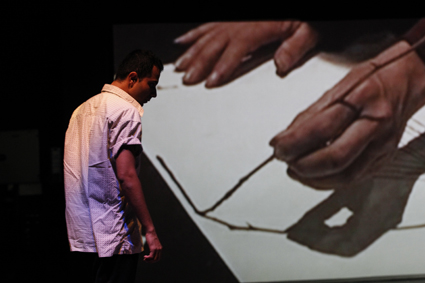
Raghav Handa, Briwyant, Vicki Van Hout
photo Jeff Busby
Raghav Handa, Briwyant, Vicki Van Hout
I utilise this knowledge to explore how these ancient practices may still manifest themselves in the present urban environment. I believe in cultural memory and that our culture is a living one, not boxed in by a preconceived notion of the ‘traditional’ being the only true authentic. In Briwyant this is illustrated through the tracking of country, my country being the streets of inner western Sydney, from the St Peters train station to an internet joint in Redfern. My set was adorned with an installation comprising a river of playing cards, each card a dot, representing the Lachlan River, while also alluding to the proliferation of wealth shared throughout communities through mini ‘casino’ gambling. In My Right Foot, Your Right Foot two dancers enact breaking into a house to steal a mobile phone, using an amalgamation of tracking/hunting steps to a voiceover from a novel titled I, the Aboriginal written in 1962 by Douglas Lockwood, who as a white Australian, wrote in first person as the first Aboriginal medic and senior lawman from Roper River. In this passage Lockwood describes going on a successful hunt for the first time. I wanted to illustrate the flipside to Welcome to Country ceremonies and comment on the possibility of wasted/neglected potential.
My dance language is an amalgamation of my ongoing dance practice through continued contact with NAISDA (25 years to date) and mainstream contemporary dance training, learning dances from Turkey Creek, Christmas Creek, Maningrida, Mornington and Bathurst Islands, Yirrkala and Murray, Saibai, Moa and Badu Island to name a few, alongside jazz, tap, African American and classical ballet. This was underpinned by Graham-based modern training, which was consistent and predominant in order to both fast-track our dancers’ bodies and give us entry into modern ideologies of art. These styles manifest themselves equally in my choreography; from years of repetition I embody them, they in turn embody me. Not in a clear distinct linear fashion, whereby each unit of movement attributed to specific communities asserts itself individually, but as a new logic that only my body, and people who have trained as I have, understand. Our mid-year and end of year performances at NAISDA featured dances consisting of this new developing hybrid style, an Indigenous aesthetic not specific to one community but to us (Aboriginal and Torres Strait Islander students) as a collective. In my time I witnessed dances about black deaths in custody and the Stolen Generation; I performed in Parliament House and in protest for Survival day. We used our vocabulary as a tool for recognition of our living circumstances, to positively effect change.
At the National Indigenous Theatre Forum in Cairns in August, 2012, it was suggested much more stringent measures must be put in place for usage of any cultural vocabulary requiring specific permissions from relevant communities. I always seek permission if using intellectual material from specific story and song cycles—information pertinent to the underpinning existence of a community. I ask myself whether I am compromising any community ethically and financially as a mandatory cautionary measure. The initiative proposed at NITF will prove a very difficult undertaking. But not only that, I think it is complicated and in some cases would be unnecessarily pedantic, inhibiting freedom of expression in places such as NAISDA and ACPA (Brisbane based First Nations college of performing arts).
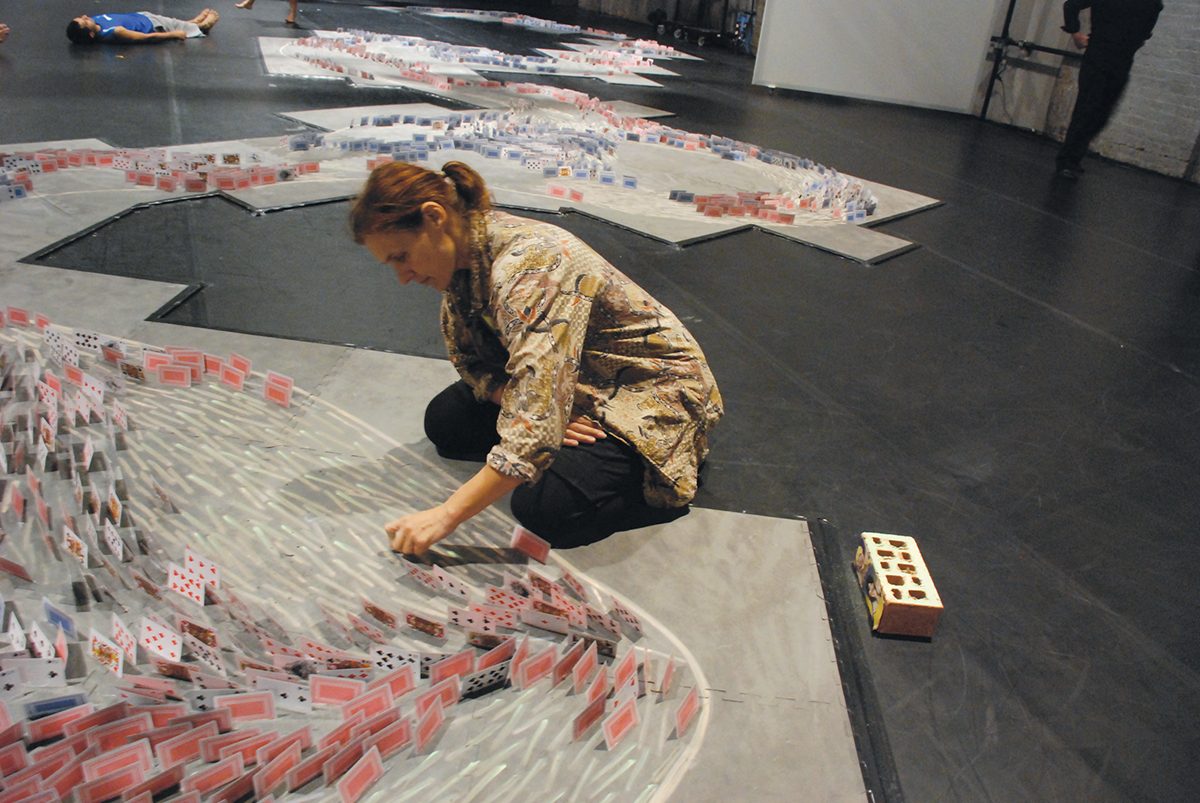
Vicki Van Hout working on installation for Briwyant, 2012, photo courtesy the artist
In my case I have an ongoing relationship with several communities due to my association with NAISDA (I am currently employed on a casual basis as technique and repertoire teacher). I invite my local community to watch works in all stages of progress. Most recently, my choreography for NAISDA, Imprint, containing deconstructed vocabularies from my Yolngu and Tiwi training, was performed at the Garma Festival in front of representatives and Elders of both communities to an overwhelmingly positive reception. I did not ask permission to utilise specific steps but instead relied upon my accumulated knowledge. I will shortly go to Galiwinku community on residency with NAISDA and will listen, watch and ask questions when the time is right, with my intuitive understanding of when that might be.
What happens if I want to use my collective embodied knowledge to illustrate a non-specific Indigenous concept? What if I want to use my hybrid language to illustrate something unsavoury, unpopular or controversial? How do I explain the importance of absurdity? How do I ask permission if I want to challenge the way and setting in which my performance is framed? Martha Graham’s principles of contract and release, a ballet pas de bourrée, are commonly used in many dance contexts and we don’t ask specific permissions.
I think a one-size-fits-all approach negates the capacity for individual integrity. As a contemporary artist I use my medium to provoke and to provide insight and possibility for change. Tradition reiterates long-held cultural practice, while contemporary practice is current in its immediacy. These ideologies are polar opposites but when compared or used in juxtaposition each gives the other context. I have witnessed this in the performances of Akram Kahn, the English-born Bangladeshi choreographer who utilises his Kathak dance to illustrate the contemporary human condition as he sees it, often pairing up with performers from other cultures as he did with Sidi Larbi Cherkoui in Zero Degrees where he utilised several dance languages, live spoken text and sculpture to illustrate his experience of going to India, looking like/having the same racial heritage as the locals but being British, he is an outsider, a tourist.
Recently I attended a performance titled Doku Rai, created off the coast of Dili, as part of the Darwin Festival, a collaborative venture between Melbourne’s Black Lung Theatre, electro rock band Galaxy and Liurai Fo’er (King Bin), an independent performance company that creates contemporary performance and installations from found items and large scale rubbish. In this loosely structured play-within-a-play performance, the company challenge the significance of death, of self-determination in a political sense and for the right to conduct culture, to tell their stories their way. It starts with the enactment of a death curse ritual, not a fictitious account of one, but one truly practiced. The fluidity of narrative between the ‘play’ and the direction by a white director of a play symbolising our peace-keeping presence in East Timor, of ritual connecting of people to their country, of farce in which a character who is killed repeatedly but never dies, succeeds in highlighting the horror and frustration of a struggling nation where a documentary might not. Through this surreal offering I felt a visceral connection to the prevalent ugliness and instability evoked by this work. (See p38 for John Bailey’s review.)
I do know I rely heavily on my moral compass and that if something feels wrong or unjustifiable I need to keep talking to relevant community members until it feels right. I also know that my art often articulates the point that can’t be said with mere words and that after the work is seen the real talking proceeds. We, as Indigenous performance makers, are working within a new climate that acknowledges the importance of being the authors of our own works. We are in the perfect position to challenge the black box environment and explore how we, as an inherently interdisciplinary, expressive culture want to be seen/experienced. This cannot be done through tighter and tighter gate- keeping within our arts community, but rather through processes that acknowledge and encourage trust as well as communication.
–
Vicki Van Hout is a Wirradjerri woman born in Wollongong on the NSW south coast. In the early 90s she moved to New York and trained with leading modern and post-modern dance artists before returning to Australia in 1996 to train at the National Aboriginal and Islander Skills Development Association and to perform with Bangarra Dance Theatre. As well as creating her own work, including the nationally toured Briwyant, she teaches at NAISDA Dance College. Van Hout has recently received a grant from the Australia Council’s Indigenous Experimental Art Fund for a hybrid performance development workshop inspired by Long Grass People (homeless Indigenous people).
–
RealTime issue #111 Oct-Nov 2012 pg. 5
© Vicki Van Hout; for permission to reproduce apply to realtime@realtimearts.net
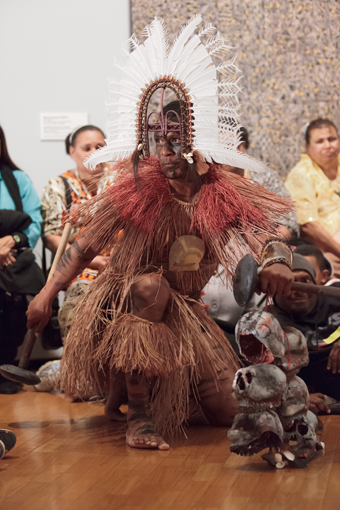
Alick Tipoti, performance, UnDisclosed exhibition, National Gallery of Australia, 2012
photo courtesy National Gallery of Australia, Canberra
Alick Tipoti, performance, UnDisclosed exhibition, National Gallery of Australia, 2012
KULAY NGAY LAK MINA KOEYMA AP ASIN NGOELMUN LAGAW KUYKU MABAYGAL, ZUGUBAL A MURUYGAL KIZIPAY NGAPA KULAY THONAR INGU. NGAW NGULAYG NGAPA NGITHAMUN INGU. NGAY MINA KOEYMA ESO POEYBIN A LAK YUDIN MUYI NGULAYG IKA.
Firstly I greatly acknowledge the Elders of the islands, the Zugubal and the Muruygal of the past for my knowledge comes from them. I give thanks to you all and seek more knowledge. The Muruygal and the Zugubal protect and guide me though my cultural practices in life.
In a culture the native language sits in the centre of it. All practices in life branch off language. The language identifies the true meaning of culture. The Torres Strait Islands have two groups of language: the Kala Lagaw Ya (KLY) of the western islands and the Meriem Mir of the eastern islands. Kala Lagaw Ya has four dialects; Mauyag, Kala Kawaw Ya, Kawrareg, Kulkalgaw Ya. Meriem Mir has two dialects; Mer, Erub.
In terms of cultural protocol I can only speak of my people of the Maluyligal nation of the western group of islands. Cultural protocols keep Torres Strait Island culture in line. They separate the modern from the ancient. They separate the introduced from the original.
Kulay Sabil is the term for ancient cultural protocols or ancient lore. These protocols are strictly followed when it comes to reviving ancient culture through visual art and traditional dance. The Western Islanders of the Torres Strait are known as the Maluyligal, meaning people of the sea. They are people of protocols from the Land to the Sea to the Reefs.
Torres Strait Island lore came from the ancient people known as the Muruygal. The Muruygal would channel and communicate with the Zugubal of the spirit world and return with the knowledge of cultural lore to address the Islanders in the human world.
One must know and understand the ancient language in order to revive ancient practices. One must know how to communicate with the Zugubal who are the spiritual ancestors of the past. Why is this information withheld from the outside world? This brings us to [the notion of] sacredness. Our ancient knowledge and the sacredness that comes with it is what makes us such a powerful culture.
Through my art and dance practice I must always acknowledge my spiritual ancestors if I am to create a painting or a sculpture that will expose a glimpse of totemic markings and/or parts of ancient legends. This is the very first protocol undertaken before the idea is interpreted.
I am blessed to have been guided throughout my art career by some really great cultural leaders. Most of them have passed on but are still guiding me to this day. As a leader of today, it is my role to guide those emerging and to make sure protocols are followed. The only challenge of today is that language is slowly deteriorating and time is always against us as a culture.
One can only utilise technology to help retain and sustain cultural knowledge so that it can be practiced by the future generation. At the very same time we must be aware that without protocols our culture can be exploited and sold.
The creation of Mawa masks, for example, comes with powerful, significant rules that keep their sacredness and please the teachers in the spirit world, who in this case are the Zugubal. Certain Mawa mask performances are not to be exposed to the general public and are only performed at night during certain moons. The Mawa masks are only to be touched and worn by men. Women and children are forbidden to associate themselves with such spiritual beings. Because we associate ourselves with the spirits of the past, there is a great deal of respect for these protocols as we are both students and the future of our ancestors. This is how our culture survives for countless generations. Descriptions of the journey to the other realm through the Mawa masks are exclusively sacred to cultural Torres Strait Islander people.
The masks are beings among us and are greatly respected for their presence. A single touch of the Mawa mask must always be acknowledged in ancient Kala Lagaw Ya language.
A painting or a print hanging on the wall of a museum is just another piece of art. One could almost say it is a dead object; however when accompanied by songs, chants and dance it is brought to life. The true connection of culture is awakened and infused. These practices can only be allowed to and achieved by a person who has great cultural understanding. When certain protocols are not followed, things tend to go wrong during or after performances or in life in general.
Kulay Sabil clashes with the Christian religion that was introduced on July 1, 1871. Many Islanders chose to follow this introduced spiritual practice yet speak out loudly of the deterioration of cultural practices. Many of our practices were forcibly discontinued and forgotten but a few Islanders have chosen to revive the ancient style. Some protocols have been interwoven with outside influences such as the Christian religion. However from a cultural perspective they sit below the original culture. One must not be influenced or manipulated to not practice ancient culture.
If a person does not know and understand their language then they are not qualified to initiate such traditional practices. The most powerful cultural protocols can only be oral and described in our native language. Articulating such protocols in foreign language does not have the power to bring them to life and therefore over time, protocols are forgotten and lost.
Ancient cultural protocols are the key to survival.
Lak mina koeyma eso poeybin inub knulayg ika
Once again I acknowledge the knowledge.
Zugub Alick Tipoti , Maluylig, Lagalayg, Zenadh Kes
RealTime issue #111 Oct-Nov 2012 pg. 6
© Alick Tipoti; for permission to reproduce apply to realtime@realtimearts.net
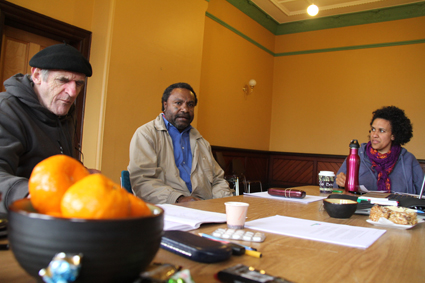
John Romeril, Walter Waia, Margaret Harvey
photo John Harvey
John Romeril, Walter Waia, Margaret Harvey
MARGARET HARVEY IS DEVELOPING A NEW PLAY, AMANA KAZI, DRAWING ON HER SAIBAI ISLAND ORIGINS IN THE TORRES STRAIT. HARVEY IS COLLABORATING WITH HER UNCLE WALTER WAIA AND PLAYWRIGHT JOHN ROMERIL WHO’S ACTING AS DRAMATURG. I SPOKE WITH HARVEY ABOUT THE ORIGINS OF THE PLAY, CULTURAL CONCERNS AND THE DRAMATURGICAL PROCESS.
JH What inspired you to make this new work?
MH In 2003 I performed in a theatre piece that contained Greek myths woven through it and it got me thinking about how powerful the Saibai Island myths are…I decided to create a visual theatre piece that stemmed from my own clan group. I am developing a highly visual theatrical experience in a genre that could be described as magical realism.
JH What is the Amana Kazi about?
MH It is for my people on Saibai. The play is called Amana Kazi, which means mother’s child. [Saibai is one of around 274 islands in the Torres Strait and is closer to Papua New Guinea (8 km away) than to mainland Australia. Ed] Amana Kazi really represents community and it takes a community to tell an epic piece like this. The play is being developed in collaboration with my Uncle Walter, who is an Elder of one particular clan group, the Ait Kadal (crocodile) clan. My dream is to have a minimum cast of 10 but 15 would be the optimum. We’re aiming for presentation in 2013. John Romeril came on board as dramaturg in late 2009.
JH Why this story?
MH I grew up down south, away from the Torres Strait Islands, but my Mum was always encouraging us to tell her stories. During my Australia Council Fellowship I developed a methodology for telling those stories. For me, it is part of making that connection again with family. I don’t have a literary background so it is a visual theatre piece.
I began by speaking to my Uncle Walter about how to bring to life some of the myths of our clan and my mother’s stories. I feel the power of the stories. My mother left Saibai on a pearl lugger in 1947 when she was six months old. The family settled in Bamaga, set up by the Queensland government for families of the exodus, and she went on to marry an English man. So I don’t come from a traditional background—yet there is an emotional journey to the piece.
My Uncle Walter is a wise, knowledgeable man. I always wanted John Romeril on board but the two men had to connect to make it work. As soon as he and John got in the same room, well, they might as well have been brothers. Uncle Walter said, “If you don’t bring this fella back, I’m not coming back.”
JR I liked Uncle Walter’s company, but liked his story too. He explained the way he was ‘fired off,’ like an arrow to the mainland by his Dad to skill up as part of the post-war generation. Walter doesn’t just ‘tell’ me this story, he enacts it. He adopts the stance of an archer. You see the bow, you see the arrow. The fingers relax. The arrow’s been fired. His eye-line, and mine, watch it out of view. In Walter’s case, that arrow lands in Adelaide, where he’s sent to get a law degree. He goes on to do Native Title work, especially around Sea Rights. He was involved in the Mabo case.
But what struck me, hour one of that first meeting was, “Wow, this man can ‘dance’ ideas.” As a playwright, a dramaturg, I’m thinking, “This is gold.” He is innately theatrical.
As the conversation continues, Romeril suggests Walter’s journey is a diaspora story, an exodus story that parallels the play Margaret is developing. A difference is that Walter flew to the mainland, whereas their mother, in a far from incident-free voyage, sailed to the mainland. The Saibai backstory is that king-tides in 1946 inundated parts of the island, ruined gardens, killed fruit trees. The issue confronting half the island’s population was relocate or starve.
Young Saibai Islanders who’d been part of the Torres Strait Infantry patrolling Australia’s northern shores during World War II approached their Elders. They’d spotted a tract of land on Cape York. It boasted good soil, timber and permanent creeks. The post-war settlement at Bamaga would evolve, becoming home to displaced Islanders and Aboriginals alike, including Margaret Harvey’s mother.
JH How is John working as a dramaturg for this piece?
MH John is helping to build it; the structure of the piece. He is an outside eye. He was also someone we thought we could take to Saibai, and who could make that connection with Uncle Walter, apart from just helping us with the history. Uncle Walter has a traditional background even though he was sent to Adelaide. When he speaks it is very poetic, especially when he talks about the land, the sea, the stars. Uncle Walter and John both speak their own ‘language’ but they understand each other. It is two Elders speaking, with mutual understanding.
Going back to my roots, right back in blood, it is an amazing thing. Although you leave the land of your heritage, it is still in you.
JH How is the process of working with John?
Harvey describes how Romeril listens to Uncle Walter, and retains that information, in turn sharing it with her. “I re-learn some of these cultural stories from JR. I don’t turn a ‘blind ear’ to them ‘cos I trust him. It is knowledge that I didn’t grow up with.[Our relationship] is organic and respectful. I don’t feel like a newbie, as a writer. It is about the creation, respecting each other, and what each of us brings to the table.”
JR Presentations are made to the extended family on the theatrical material Margie is developing, and always with an eye to staying true to their cultural roots. While I push the form of theatre I am also asking, what are the stakes here? And what, protocol-wise, is appropriate?
MH JR works in a respectful way. And having that trust is a big thing. Certain of the myths and legends in the stories come with gender issues attached so we need to be careful how they are used. We also need to consider can the story survive down south, where there is no common cultural understanding audience-wise? We want to widen the audience to reach beyond community, yet have the community’s voice be heard.
JR Margie has an aesthetic. She will see a YouTube clip and say, “I like this palette of colours.” Because she’s grown up with it, dance, song and ceremony remain a huge part of the story.
The rehearsal room is intense. Uncle Walter will say, “I last heard this song when I was 13.” He remembers a few of the traditional moves that belong with the song. At times it is very emotional, they cry so easily. It’s beautiful, epic stuff. This has never been done before. People travel, often taking long journeys. But so do artifacts, so do stories, so do languages.
JH What have you learned from working with Aboriginal and Torres Strait Islander theatre makers, JR?
JR Perspective. And the adventures I can now have with first peoples of this country…I get a sense of my forebears having washed up on this continent in 1854, clinging, in my case, to the country by our fingernails. This interaction enriches me; it gives me a sense of how to live in this place I’m in. What a palette! It is energising, uplifting… It gives my white a darker, denser, shade of pale! (LAUGHS).
JH Why is dramaturgy is important?
MH For me as a new time writer/creator this collaboration is imperative in helping bridge the gap in a theatrical medium. As Indigenous artists we need to be really honest about what we bring. When re-telling a story with the outside world, you need to find a way to communicate it to the audience. We are using language; one of the main intentions of this piece is to help keep language alive, but for me it’s about finding a creative way to communicate without just having surtitles. I’m not going to alienate the [non-Torres Strait Island] audience. Otherwise they are just watching something ‘exotic.’ It’s not just about ‘showing,’ it’s about sharing, and using a shared language. That language is theatre.
JR I may not be a first person, but I am the first audience!
MH It’s not just about John being an iconic playwright, he understands culture. All of our family loves him. When we see him out and about, we make a beeline for him.
RealTime issue #111 Oct-Nov 2012 pg. 8
© Jane Harrison; for permission to reproduce apply to realtime@realtimearts.net
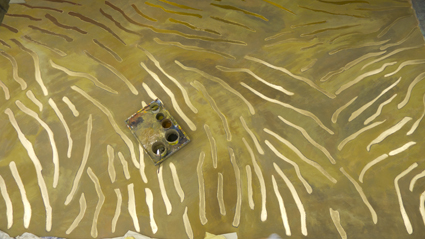
Terrain sets in progress, designer Jacob Nash
photo courtesy the artist
Terrain sets in progress, designer Jacob Nash
THERE IS A VISUAL LANGUAGE CREATED BY INDIGENOUS ARTISTS THAT IS DISTINCTIVE AND IS RECOGNISED BY PEOPLE AS INDIGENOUS. I LIKE THE WORD ‘LANGUAGE,’ BECAUSE IT SPEAKS OF PLACE AND PERSON. THERE HAS BEEN A RICH HISTORY OF INDIGENOUS THEATRE THAT CONNECTS WITH CEREMONY, PAINTING, MUSIC AND DANCE IN THE THOUSANDS OF YEARS PREVIOUSLY AND THIS HAS HELPED TO SHAPE WHAT INDIGENOUS THEATRE IS TODAY.
In a sense, this connection with Indigenous history and culture has inadvertently shaped the images you see on stage, creating a kind of design language. Because of the nature of the stories we tell, there can often be thematically and visually similar elements that appear on stage. Yet there are so few Indigenous designers that you couldn’t really say there is a contemporary design ‘movement’ that is distinct. But at the heart of all design for theatre is creating a visual world that supports the particular story you are telling.
Working with Bangarra Dance Theatre, where there is no script involved, I need experiences that inspire and shape the direction in which the design will take me. For Terrain (2012), choreographer Frances Rings, sound designer David Page and I took a trip to Lake Eyre, where the stories originate. We experienced that country; we met Elders and community and spent time immersed in the place and culture. Creatively, this was a very rich experience. I can’t just sit in a room and create; I have to get out there. I love the word ‘journey’ rather than process because I am on a journey of discovery.
At Lake Eyre I let the country affect me and fill me up. I was very moved by the experience of travelling there. This is where instinct is so important; I have to go with what my heart is telling me and I need to trust that. I had to find a language that would capture the spirit of place, find its heart, its core and create truthful responses to the country and people. Landscape is a hard subject for a designer to work with, as you can’t just depict what you see, but need to find and create images that try to find the essence of place and you do that in colour, light and texture.
As a designer I have to go further than just what is in a script or an idea and find meaning in the subtext. Just because there is a red dirt road in the script doesn’t mean you have to put it on stage. I ask myself what else could this be, how can I keep pushing these design ideas forward? For example in Terrain, in the section called Salt, I had to firstly find out what a salt pan looked like and break down all the elements that made it a salt pan. This gave me a colour palette, a texture, scale and an emotional response. All of the creative ingredients were in front of me—pastel colours, ochre whites, textured clays—and I could express the land in a more abstract form that captures the essence of place. It’s like trying to stir up the memory of the audience to an experience they have had and letting them connect to it in their own way. When all the elements of dance, design and music become one and the dancers begin to tell the story, I feel that I have journeyed some way in capturing that sense of country.
For me, choreographers and directors are usually the first point of inspiration as they pull you into their creative sphere and you get caught in their stories. At Bangarra I get the opportunity to collaborate with inspirational artists (Stephen Page, Frances Rings, David Page, Kathy Marika, Hetti Perkins) in creating, shaping and refining the productions. These relationships are crucial. Working more than once with someone allows me to explore ideas with more trust and it becomes more rewarding. Finding someone who can honestly tell me their opinions about what is working and what is not working in my designs, is essential.
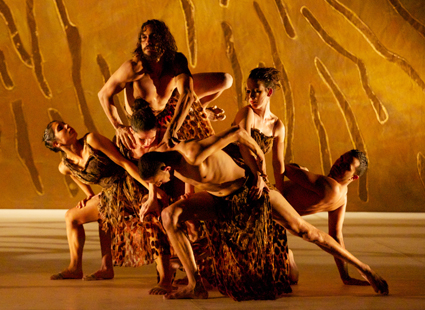
Terrain, Bangarra
photo Greg Barrett
Terrain, Bangarra
Belief is another really important element in the creation; if I don’t believe in what I’ve created, is anyone else going to believe in it? I am sure designers and artists ask themselves that all the time. So for me there is the journey of finding all the inspirational material and having rich experiences, displaying them up on a wall and then responding with pencil, brush, model or whatever. From this point it’s about the critical refinement of the work, and this determines its look. These are some of the hardest but most rewarding moments of the journey.
In terms of the demands or expectations of my work as an ‘Indigenous designer,’ you can only be who you are, and true to what you know and your family. People can place expectations upon you that are sometimes far too great. I can’t fall into the trap of designing stereotypical images of what ‘Indigenous’ is. The biggest demand placed upon me is from myself! When I am entrusted with a story from a community or family, the work I produce has to do justice to the story I have been given. This is because there’s a cultural responsibility to the story you are telling. I have been given a gift and I need to respect that gift.
I am also driven to explore those stories that inform who I am. My birth mum is Aboriginal and we also have Chinese Malaysian blood. My adoptive parents have Irish, English and German heritage. My sister has Papua New Guinean heritage and that’s what I know so far. There are many stories held within this group of people that I don’t know yet and this drives me. I constantly draw upon identity and the past to inform my work.
I think we are about to hit another generational explosion in Indigenous art. If you look back at the past 60 years of Indigenous artistic leadership, there are people who have laid down a strong cultural, political and artistic platform that inspires all of us. It is up to us now to continue in their footsteps.
I want to keep designing. I also want to make a film, paint, travel and work in another country and continue to be inspired by this country, its stories and my family and friends. I don’t know where I will be in another 10 years, but then 10 years ago who knew I would be here?
RealTime issue #111 Oct-Nov 2012 pg. 12
© Jacob Nash; for permission to reproduce apply to realtime@realtimearts.net
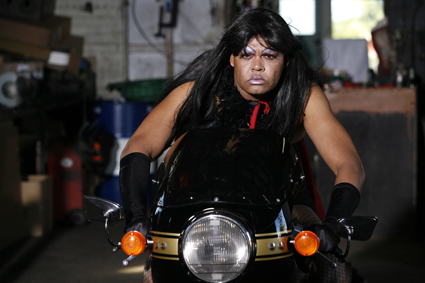
Constantina Bush
photo Daniel Boud
Constantina Bush
CABARET AND CROSS-DRESSING ARE AN IDIOSYNCRATIC PART OF CONTEMPORARY INDIGENOUS CULTURAL EXPRESSION, BEST KNOWN IN THE SHAPE OF MARY G, QUEEN OF THE KIMBERLEY (MARK BIN BAKAR). HERE, KABOOBIE (VISUAL AND PERFORMANCE ARTIST TROY-ANTHONY BAYLIS) CONVERSES VIA EMAIL WITH CONSTANTINA BUSH (ACTOR AND CABARET ARTIST KAMAHI DJORDAN KING). THEY YARN ABOUT EMPOWERMENT, THE ART OF DRAG, THE ROCKY ROAD OF GLAMOUR AND QUERYING QUEER, BLAK-WAYS.
Kaboobie: Hello my darling sista Ms Bush. Finger-waving at you from Adelaide on Kaurna country! You’re on Larrakia country preparing for your show That’s The Way Life Goes as part of the 2012 Darwin Festival. How are the preparations coming along?
Constantina Bush: The preparations are coming along good way. The Bushettes arrived here the other day and we now doing little bit rehearsals you know. Darwin mob will probably like this one show because we talk little bit about the Interventions in it. Even though we bin go all around the country with this show it will be the first time that they will be seeing us here in Darwin. So being back on my home turf will be little bit nervous for me cause you know all the stories I talk about in my show is true and they belong for my families, so they will know.
Let’s step back in time. How did Constantina Bush come about? How did she start? How was she born? Was she even born at all? How did you get your name?
Constantina Bush came about because a performer pulled out of Outblack [a social support group that raises awareness of gay and lesbian issues both within and outside Indigenous communities. ED] and a friend asked me to fill in her spot. I offered up some live singing and a very sassy cossie. It was an instant hit and I bin workin’ it ever since. The name Constantina Bush came when I was asked to a luncheon to meet Condoleezza Rice for the 2006 Commonwealth Games. I didn’t know who she was so I had to ask the driver who was taking me there. He informed me that she was the US Secretary of State. When I got there and met her I addressed her as Constantina Bush and also called her a UN Ambassador, much to the amusement of those around me. Ever since then the name stuck.
That story’s so funny, and now you embody it in namesake for always. I first saw you in the flesh when we shared a dressing room and time-shared the stage for Outblack in Melbourne in January 2010 as part of the Midsumma Festival. It was a live performance where you sang, and you had great earrings that provided some fitting, campy dance. (An ‘earring,’ dear gazer, is a term us Queens use to describe a back-up dancer or singer, who sings and/or dances on either side of us). The gig was a late night ‘nightclub’ act and different to the other shows I saw that are more cabaret-style, where you talk-up with your audience. I think your versatility and adaptability are some of the qualities that make your work accessible, plus word is out you’re easy to work with. Why else do you think people are so drawn to your charms? Tell us about your audiences? Do blakfullas respond differently to whitefullas? What about outside of the big city lights, beyond the city limits?
Yes, absolutely they do. I think a reason is because Constantina talks Myall or Kriol, a mixed form of English and Aboriginal with a bushy sort of accent. As always, the humour is typical of our Australian Aboriginal sort and they get it straight up. However, the nature of my shows is to educate the broader community and non-Aboriginal people about the issues we face. By speaking this way it encourages people to listen really closely and pay attention. They don’t always immediately understand the Kriol but they get the gist of the actions and come round after a while. I think people are drawn to Constantina because of her naivety and innocence, and maybe because I am different and real strong in that. Blakfullas draw on that strength and can relate to it.
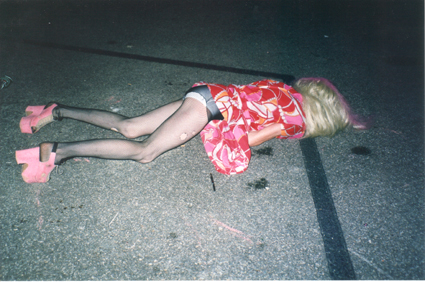
Kaboobie, Proud Mary, Queensland Artworkers’ Alliance, Brisbane 1999
photo Luke Roberts
Kaboobie, Proud Mary, Queensland Artworkers’ Alliance, Brisbane 1999
Not to mention your fabulous pins! Real superwoman legs you got there girl, with something extra. I am a big fan of your publicity imagery. I find them to be artful. Some of the shots remind me of film stills from road movies like Rough Rider, Mad Max or maybe Mad Maxine from the television series Prisoner, which you know is my favourite TV show of all time. You butchin’ it girlfriend: motorbikes, pulling fuel, petrol stations and bitumen! Total glamour. Does celluloid seduce you? Does it inform your work? Is there a movie in the works?
Cellulloid does seduce me, especially after seeing The Sapphires. It’s such a great film. Really takes you to another place and time. Three Darwin girls in there I might just point out. There is a movie in the works for me and we are setting it in the 70s when children were still being taken away. I can’t say too much of it at this stage because it is not that far past the synopsis stage but there is some interest in it already. I see Constantina as a bit of an art piece herself and would love to keep doing more works like Attack of the 50 Foot Black Gin (2010) and get the imagery out there more.
You sure is an art piece—a fine piece of work. I am so glad to hear that you gonna get more stories out there through film and art as well as your performance work. I think it is important to speak-up from our own knowledge position as Queer-Aboriginal people and challenge the ways our cultures are socially constructed, and express a bit of fun too. I dunno know ‘bout you, but I bin abused once or twice by extremists who say people like us be introducing gender and sexual diversity to communities and that gender and sexual diversity is not Aboriginal way. I think even our own mob sometimes don’t realise or give much thought as to how deep colonisation imposed itself onto our cultures and how when we buy into a culture of homogeny we do the coloniser’s work. Since when did Aboriginal people become straight anyway? Just because the record is absent or vague on the matter of queerness in Aboriginal cultures, it doesn’t mean that it didn’t exist. Anyway, this stuff really gets my wig wet. Do you have any thoughts about this issue or ever felt the whip just for being you?
Haha, thanks for your comments, you’re too nice. In regards to your last question, Kaboobie, I have been made to feel bad about what I am before, but this was mainly when I was younger. Since then I have grown up into a physically and more mentally strong person and I don’t so much get it now. People look at me and think twice before they pick a fight with Constantina Bush! I know some smaller built people that are like me and are persecuted here in the Aboriginal community. I have never had to deal with too much of that though. The times that it does swing my way is usually by my own family because they know me and think that they have a right to input into my choices in life. It’s not really a choice for me anyways but an orientation, something I can’t control, and it is difficult for a lot of people to understand.
I am looking forward to seeing you perform again and seeing your creative presence generally. I hope you can blow-in to Adelaide again soon. In the meantime have fun at the Darwin Festival. Break your legs. Amour Amore, Kaboobie xxx
Thank you my sista. Hope to share the stage with you again very soon and also blow-in to Adelaide. Adelaide is ready for a bit of Bush I reckon. CB xxx
RealTime issue #111 Oct-Nov 2012 pg. 13
© Constantina Bush & Kaboobie ; for permission to reproduce apply to realtime@realtimearts.net
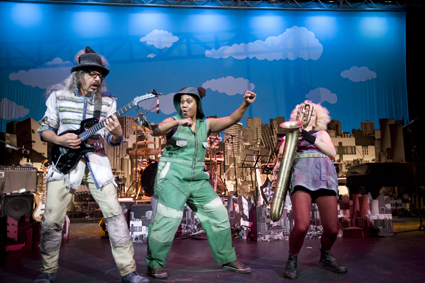
Carl Polke, Ghenoa Gela (centre), Ania Reynolds, From the Ground Up, Circus Oz
photo Rob Blackburn
Carl Polke, Ghenoa Gela (centre), Ania Reynolds, From the Ground Up, Circus Oz
HOW DO YOU TURN EXPERIENCE AS A DANCER AND COMPETITIVE AIR GUITARIST (GELA WAS QUEENSLAND FINALIST FOR TWO YEARS) INTO A CIRCUS ACT WITH ICONIC AUSTRALIAN COMPANY, CIRCUS OZ? A NEWCOMER TO CIRCUS, GELA IS THE MC IN CIRCUS OZ’S LATEST SHOW, FROM THE GROUND UP. SHE SPENDS A LOT OF TIME ON STAGE—IN DANCE NUMBERS, YARNING WITH THE CROWD, INTRODUCING ACTS AND FIRING UP THE AUDIENCE.
Gela plays down her role as MC. “Even though I am the MC, and the first person on the stage, it’s not hierarchical; I am just a thread throughout the story.”
A Torres Strait Islander from Rockhampton, Gela has a unique skill set. Along with working as an actor and dancer, she has learned cultural protocols and practices of the Torres Strait from her family. She reveals how she made the move from the dance stage and screen into the Big Top:
“It started with a conversation. I was involved in a dance show, Vicki Van Hout’s My Right Foot, Your Right Foot (2007), when Josh Bond—Artistic Associate and Indigenous Programs Coordinator for Circus Oz—approached me, saying I had comic timing, and I laughed it off. While training at NAISDA I had done some clowning and a little comedy, never circus.”
Bond persisted, and in early 2012 Gela joined a select group of performers for Circus Oz’s inaugural Blakrobatics Masterclass. Experienced in dance, comedy, acting, music, each participant had been personally recruited. A circus background wasn’t required, but a solid standing in their chosen field was. The program is a Circus Oz initiative overseen by Bond [see article] and designed to attract talented Indigenous performers to circus, introduce them to the skills required and see what develops.
Gela recalls, “The Blakrobatics workshop was massive! A whole mob of us in a mainstream organisation and we all had such diverse backgrounds. The workshops took place over a week. We did everything—table sliding, tumbling, pole dancing, juggling, diabolo, trapeze, and lyra (aerial ring). We had two specialist trainers. I found the trapeze and the tissu most challenging. I have a whole new respect for circus performers. They do these really difficult things and make them look so easy. You need so much core strength!”
While confessing to a big fear of heights, Gela confides that she is also an “adrenaline junky.” She felt exhilarated by the Masterclass.
At the end of the Masterclass week Gela and Dale Woodbridge (Gamilleroi) were selected for a follow-up program, the Blakrobatics Internship, which involved another 16 weeks of training with the Circus Oz cast and other specialist trainers in The Lab. This was a busy period of experimentation, tightening skills and devising acts for the show. Woodbridge, who has a gymnastics background, worked on his flying trapeze skills and fine-tuned his wicked baton twirling talents.
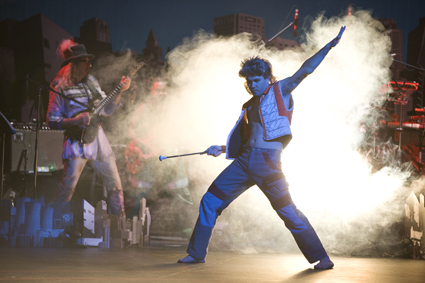
Carl Polke, Dale Woodbridge, from the Ground Up, Circus Oz
photo Rob Blackburn
Carl Polke, Dale Woodbridge, from the Ground Up, Circus Oz
The process of developing the show’s content was a new experience for Gela: “In dance, it has a definite structure and you build within those walls to meet what the choreographer specifically wants. Here, at Oz, it’s different. We work very collaboratively, but we have more ownership of our individual pieces. Then you bring all those pieces together. I’ve never had this much freedom of creativity.”
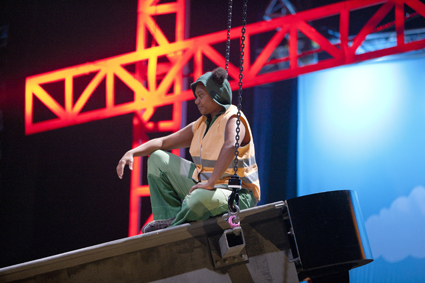
Ghenoa Gela, From the Ground Up, Circus Oz
photo Rob Blackburn
Ghenoa Gela, From the Ground Up, Circus Oz
As MC, Gela performs a delicate balancing act. As the main ‘voice’ in the show she has a strong stage presence balanced by a friendly and personal approach. Gela is a dynamic and articulate guide to cultural and racial politics. But this isn’t a dry lesson—she shares funny, and at times uncomfortable, stories about being a proud Torres Strait Islander woman in contemporary Australia. She seems genuinely surprised that she still has trouble hailing a cab.
“Others might see me as a spokesperson, even when I don’t say anything. I am only myself up on stage. The political material is confronting for some. When I move off stage, some people can’t even look me in the eye. While I don’t feel that pressure of representation, what I can be is someone that the young ones can aspire to. That’s one of my mottos, ‘Aspire to inspire.’ It is about showing possibilities to young Aboriginal and Torres Strait Islander people. If I can, they can.”
Making her message both playful and memorable, Gela weaves her anecdotes into a riff on the virtues of fruit salad over smoothies. She describes how a fruit salad has lots of different colours, tastes and textures all mixed together into a treat enhanced by each item retaining its identity in the whole. This is done in such mouth-watering detail that Circus Oz might do well to offer fruit salad along with its usual popcorn.
Then, slightly mournfully, Gela relates how a smoothie takes all those different, luscious ingredients and blends them into an undifferentiated, mono-tinted mélange. She drives her point home by pointing to cast and band members, describing their unique abilities while revealing their diverse cultural backgrounds.
“You have to balance the politics, the skills, the music and the characters and aesthetics of the performance. Whatever the content, we all want it to be the best show possible.”
With such a big message, and such a big role, Gela is glad that a circus show is something that allows her to keep developing her character, skills and patter.
“The circus world is very different to the dance world that I’m familiar with. In dance, once you have your moves, that’s usually it for the season. But here, the show is still evolving and being tweaked while it is touring, sometimes even seconds before going on stage. That is definitely testing my abilities under pressure. It also gives me a chance to improve some of my new circus skills.”
Circus Oz’s history of mixing social justice issues with breathtaking skills, comedy and live music has made them one of Australia’s longstanding major performing arts groups. The decision to let Indigenous voices take centrestage, while framing their message with a dynamic and entertaining show, will hopefully open new conversations on what it means to be an Indie Genius Australian!
RealTime issue #111 Oct-Nov 2012 pg. 14
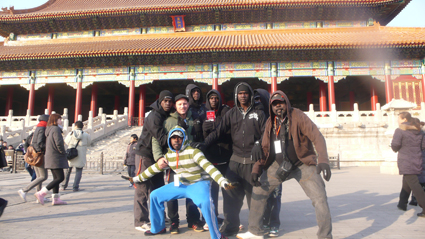
The Chooky Dancers at the Forbidden City, Beijing (2010)
photo Rosealee Pearson
The Chooky Dancers at the Forbidden City, Beijing (2010)
JOSH BOND CAN FLY THROUGH THE AIR ON A TRAPEZE. I RECALL IN HORROR SEEING HIM—LITERALLY—HAMMER A LARGE NAIL INTO HIS NASAL PASSAGE AS PART OF A CABARET ACT. NATIONAL INSTITUTE OF CIRCUS ARTS (NICA) TRAINED AND ONCE A DANCER, LATELY BOND HAS COME DOWN TO EARTH AND IS DOING TRICKS BEHIND THE SCENES, JUGGLING WORK WITH CIRCUS OZ, MANAGING AND DIRECTING THE CHOOKY DANCERS WHILE PULLING STRINGS ON BEHALF OF THE SNUFF PUPPETS (THREE PUNS IN ONE SENTENCE! A RECORD). HERE HE ELABORATES ON THE FANTABULISTIC WORLD OF ARTS MANAGEMENT.
What are you up to at the moment?
Well, the Chooky Dancers were recently in the Solomon Islands where they participated in the Festival of Pacific Arts. In their Prime Minister’s closing speech, he called the Chooky’s performance a highlight. It was their first tour for a while, since the tragedy before Christmas [where one member of the troupe was killed in a car accident].
I’m also Artistic Associate and Aboriginal & Torres Strait Islander Programs Officer with Circus Oz, responsible for developing the Blakrobatics Masterclasses, the first of which resulted in two Indigenous performers joining the current show From the Ground Up [see story]. Blakrobatics is happening again in 2013.
I have recently pitched a collaborative puppetry/Indigenous storytelling project with the Snuff Puppets…Hopefully the major festival circuit will come on board with the concept. I also managed part of the Body Armour tour. [Body Armour is a theatre/educational piece with a theme around hepatitis, developed by Ilbijerri Theatre Company, which has been touring across Australia, see p10].
Earlier this year Flying Fruit Fly Circus up in Albury asked me to help them recruit a couple of young Indigenous performers for their national training project. They are Australia’s leading organisation in the development of young circus performers, and initiatives such as these ensure realistic pathways to professional careers in the performing arts for our young people.
On top of that we’re working on an Indian/Australian co-produced feature film featuring The Chooky Dancers, which is giving me the opportunity to cut my teeth on the basics of film production.
How did you become involved with the Chooky Dancers?
Big Frank, the father of Chooky’s performer Lionel, is my manyi, my grandfather. My father and Big Frank worked together years ago on the Healthy Lifestyles Festival on Elcho Island, out of which the Chooky Dancers sprang. I grew up with those lads and I also worked with Big Frank with Saltwater Band. When the Chooky’s “Zorba the Greek” video went viral on YouTube, Big Frank contacted me, as he knew I had experience in arts management generally. The response to Zorba was sensational, there were offers from everywhere…They needed someone who could look after them in a way that respected their cultural, personal and financial integrity.
The Chooky Dancers toured to Beijing and Taiwan last year and were on national TV for Chinese New Year, which is watched by all of China—a quarter of the world’s population. They are amazing ambassadors.
What do audiences get out of seeing Chooky’s perform?
The Chooky Dancers are a blend of old culture and new culture. They are an authentic representation of traditional culture and also deliver contemporary forms of comedy and dance theatre. English is their 10th or 12th language or dialect. Traditional song and dance is an essential part of their lives. They have that integrity on a cultural level, so when they do traditional dances they do them with reverence, with respect and with permission from the cultural leaders of the community. If they didn’t, there would be repercussions in the community. They also do western contemporary numbers—like “Singing in the Rain”—which they do with total irreverence. When they are dressed in traditional costume and doing a Bollywood sequence it flips audience expectations.
Why are you doing management work?
I worked in mainstream circus for ten years …it was very ‘white.’ I had to get back to working with my family. The boys in the Chooky’s, for example, get more excited about performing for our bush communities than walking the red carpet at events. For example, we were invited to a mining community and I negotiated that they would also get to perform for the local community, 40ks away. Because the Chooky’s began as part of a Healthy Living program they are very grassroots, and they are keen to promote good physical and mental health to communities. The Roebourne Ngarluma Yindjibarndi Healthy Lifestyles Festival 2011 sprung from that, and we took John Butler, hip hop dancer Nikki Ashby, singer Shellie Morris and comedian Kevin Kropinerri up there to perform along with the Chooky’s. People came from communities everywhere! This kind of work changes lives…it is the best use of my time. I believe we can change the world but that change has to start in people’s hearts. Dance, music, comedy, theatre, books and poetry are some of the best ways to reach people’s hearts. Apart from that, when we’re on the road, there’s the biggest mob of us having biggest mob laughs.
What are some of the challenges of arts management?
I developed a thick skin over the years. Pitching to the major festivals can be intimidating—producers and presenters don’t tend to give you love (laughs). It can be a pretty cold process. Whether you are negotiating with a Chinese TV producer or the Department of Foreign Affairs, it is all about relationships…and how you maintain them.
Where do you see yourself in five or ten years?
My five year plan is to have a better idea about my 10 year plan! [Laughs] Who knows? In ten years I’ll be 40! Living back in the Northern Territory without a racist Intervention? I love performing. I’d like to further my music career. The highlight so far would be performing on Rockwiz with Kutcha Edwards in front of 40,000 people at the Sidney Myer Music Bowl. There’s nothing like it! Producing films? Watching Neighbours with Aboriginal and Torres Strait Islander actors starring! With all of my projects, I love the creation process the most. I love producing acts like The Chooky Dancers; it is one of the most effective way to implement change, to educate people, to change opinions, but also to bring audiences something unique and beautiful.
****
The day after this interview, Josh’s partner Vika gave birth to Maya.
RealTime issue #111 Oct-Nov 2012 pg. 15
© Jane Harrison; for permission to reproduce apply to realtime@realtimearts.net
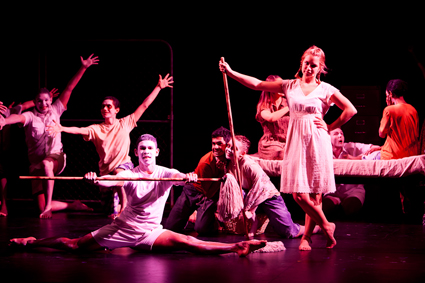
Students from the Aboriginal Centre for the Performing Arts, Brisbane perform Stolen by Jane Harrison, directed by Leah Purcell
photo courtesy ACPA
Students from the Aboriginal Centre for the Performing Arts, Brisbane perform Stolen by Jane Harrison, directed by Leah Purcell
“I EXPECTED TO LEARN ABOUT THE BASIC ACTING SKILLS. I ALSO EXPECTED TO LEARN ABOUT ABORIGINAL HISTORY IN THE PERFORMING ARTS. I ALSO WANTED TO LEARN MORE ABOUT MY CULTURE AND MY PEOPLE IN GENERAL. BEING AN INDIGENOUS PERFORMER IT WAS IMPORTANT FOR ME TO LEARN MY HISTORY, THE ABORIGINAL HISTORY IN PERFORMING ARTS, AND THE PEOPLE WHO HAVE GONE BEFORE ME, MY ROLE MODELS. I BELIEVE THAT INDIGENOUS STORYTELLING AND PERFORMANCE IS A LOT DIFFERENT TO THE SO-CALLED MAINSTREAM PERFORMING ARTS PRACTICE.” SONNY DALLAS LAW, 2010
Many well-established Indigenous theatre practitioners insist that culture is at the heart of their practice. Where then are the opportunities for such an engagement with culture as part of vocational training? Also, insofar as such opportunities do exist, how can we account for the differences between the various professional training programs available to Indigenous actors?
culture, not content
Most Indigenous acting students begin their careers in an Aboriginal-identified actor-training program, with some going on to further training in a mainstream institution. Whatever institution they attend, the way in which Indigenous acting students experience, and make sense of, their training does not depend so much on the specific content or structure of classroom- and studio-based learning; rather, it is essentially defined by the much larger cultural and pedagogical frameworks within which these learning activities are embedded. One of the significant differences between Aboriginal-identified and mainstream actor-training contexts is in the acknowledgement, or not, of culture as meaningful to acting, performance and theatre-making practice for Aboriginal and Torres Strait Islander people.
where to train?
Apart from well known ‘professional’ mainstream actor-training programs at the National Institute of Dramatic Arts (NIDA), Victorian College of the Arts (VCA) and Western Australian Academy of the Performing Arts (WAAPA) there are also three Aboriginal-identified actor-training programs on offer: Eora College in Sydney, New South Wales, the Aboriginal Theatre Certificate IV course at WAAPA and the Aboriginal Centre for Performing Arts (ACPA) in Brisbane, Queensland. Other Indigenous performance-based programs also exist, like Michael Leslie Pilbara Performing Arts and Karratha Community Performing Arts, also in the Pilbara in northern Western Australia, and the Remote Outreach program of Carclew Youth Arts in Adelaide, South Australia. Such programs play a significant role in the actor-training sector because they have a rural and remote reach. More importantly, these programs often inform many of the practices of their city-based counterparts. However, these programs are generally project-based, target young people or are delivered as community development programs. They do not offer ongoing, specifically accredited acting programs for adults, which is the sector under review here.
In regard to the mainstream and Aboriginal-identified institutional actor training programs mentioned, there are many similarities between them, which are mostly more striking than the differences. Of far greater importance are the differences in the cultural context from one institution to another.
aboriginal-identified programs
The Aboriginal-identified programs and institutions are mostly based on the principles of self-determination and self-management. They emerged from Aboriginal community programs originally designed by and for Aboriginal and Torres Strait Islander people. Their primary focus is the education of Indigenous students. These programs generally have core subjects in Aboriginal culture, history and/or values. Many are governed by an Indigenous board or closely monitored by an Aboriginal advisory body. They also employ a significant number of Indigenous teachers and lecturers, and compared to many mainstream programs have a significantly higher Indigenous student population.
culture, informally
Surprisingly, the way in which culture is delivered in an Aboriginal-identified training context is not always by way of structured culture subjects. In fact many of these programs struggle with the delivery of culture as an area of formal study. Instead, culture is mostly exchanged through informal interactions between Indigenous students and staff. Culture is also inherent in the delivery of Indigenous perspectives from Indigenous teachers and guest lecturers. Then, by way of performance, it is enacted, presented and exchanged. In an Aboriginal-identified actor-training program, for the most part, that exchange will take place between Indigenous peoples.
In an Aboriginal-identified actor-training context the culture being enacted, exchanged and experienced retains its integrity. For me the word ‘authentic’ represents a loaded concept; however, in an Aboriginal context, the idea of an authentic or common Aboriginal experience can be explored or experienced through the presence of other Indigenous students and staff.
Some Aboriginal programs also have non-Indigenous student populations and staff. This provides added opportunities for a multiplicity of cultural exchanges to take place. However there are fundamental issues that may arise under these conditions.
culture vs canon
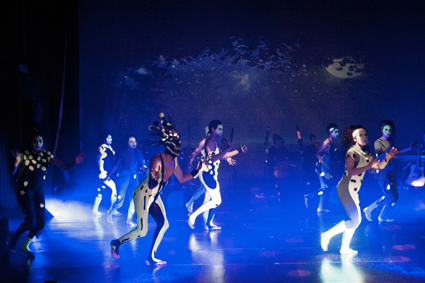
Students from the Aboriginal Theatre ensemble, STRONG by Phillip Walley-Stack, WA Academy of Performing Arts, 2012
photo courtesy WAAPA
Students from the Aboriginal Theatre ensemble, STRONG by Phillip Walley-Stack, WA Academy of Performing Arts, 2012
At mainstream actor-training sites, Indigenous students often, though not always, struggle to some extent to maintain their cultural identity against the dominance of mainstream or Western theatre practices. In this space mainstream programs struggle to know and understand Indigenous culture and its place in mainstream actor training. And for many Indigenous students who attend these programs, the knowable set of dominant theatre practices, mostly framed as ‘mainstream,’ will at some point come to direct the perceived value of their own practices as secondary to mainstream.
cultural specifics vs universals
The ambiguity of the cultural framework underpinning mainstream training contexts can also at times be unsettling for many Indigenous acting students. The idea of a universal acting practice that many mainstream training programs employ (although this is not always clearly articulated) challenges the very core of an Indigenous student’s identity, which is closely aligned with culture and community. Having, in many instances, moved away from family and community to study at a large institution in the big city, the practice of ‘stripping down’ or ‘laying bare’ (or building up) to achieve the ‘neutrality’ of an actor is perceived by some Indigenous students as an act of integration or indoctrination in Western theatre practices. When I asked an Aboriginal graduate from a mainstream training program, “what do the words’ actor training’ mean to you?” the response was:
“Training came to mean that it was a process—I guess assimilation is too much of a loaded term—but a process of being deconstructed and reconstructed into a particular model with a set of expectations that were unclear and changing.”
Both Aboriginal-identified and mainstream actor-training programs offer a range of pedagogical and cultural experiences. For the Indigenous student, these experiences can at times be challenging, and at other times liberating. With many Indigenous acting students beginning their careers in an Aboriginal-identified actor-training program, and with some going on to further training at a mainstream institute, invariably it will be these cultural experiences that define their future acting practice. However the underlying value of culture to that practice cannot be ignored.
looking for cultural engagement
After graduating from both the Eora acting program and from ACPA, Sonny Dallas Law did not go on to study at a mainstream actor training program; he may one day, or he may not. What is important to Sonny however is developing a theatre and performance practice that is meaningful to him, and this means having an approach that is informed by and connected to culture (see page 4). This is not the same for every Indigenous graduate from the Aboriginal-identified acting sector, but in scoping the career pathways of graduates from both mainstream and Aboriginal acting programs I have found that many will attest that they have at some point required some cultural engagement, and this will take the form of either working with other Indigenous people in the process of making theatre, in creating new work, or by portraying Indigenous characters and stories. Also, when Indigenous actors graduate, they are still Indigenous, and they will mostly be required to be so by the industry they graduate into, and by the family they return home to.
incorporating culture
While many Aboriginal-identified actor-training programs see culture as significant to the lives and expression of Indigenous students in general, there can also be improvements in the way culture is incorporated into these programs. This is already something the Indigenous dance-training sector has begun with the development of specific Indigenous dance techniques. There is also a push from ACPA to include voice, language and movement training for performance students based on specific techniques found in Indigenous cultural expression. These developments continue to influence the ever changing cultural landscape that many Indigenous students navigate during their training to be actors, and that will ultimately inform the future of Indigenous performance and theatre-making practices.
RealTime issue #111 Oct-Nov 2012 pg. 16
© Liza-Mare Syron; for permission to reproduce apply to realtime@realtimearts.net
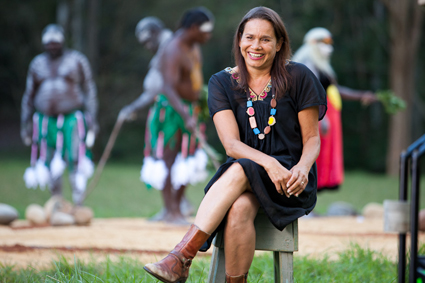
Rhoda Roberts
photo Daniel Boud
Rhoda Roberts
I AM SIMPLY PASSIONATE ABOUT FESTIVALS; THEY ARE ONE OF THE FEW PLATFORMS THAT ALLOW AND ENABLE FREEDOM FOR EXPRESSION IN ALL SHAPES AND FORMS, CATERING TO ALL DEMOGRAPHICS. THEY OFFER EXPERIENCES FILLED WITH MESMERISING MOMENTS OF AWE, SURPRISE, CELEBRATION, PERSONAL EMOTIONS AND INSPIRATION—DARE I SAY, THEY ARE EVEN LIFE-CHANGING FOR SOME.
“Is there room for one more?
We don’t want to see old people digging graves for young people
Old people crying for young people
Young people should cry for old people
They should be digging grave for old people
To see young people healthy and strong. That’s why we are doing this work.”
Gumatj Clan Leader & Healer, the late Mrs Yunupingu
I am proud to have founded The Dreaming (1995-2009), a festival which catered to so many artists, participants, community and audiences on an international and national scale. A festival is a time for all to gather and reflect; since time immemorial we have gathered on country to call, sing and dance. Over the years there has been much research regarding the necessity and sustainability of such cultural events and now it is evident that critical mass celebrations have widespread outcomes and long-term benefits and implications. There are many Aboriginal and Torres Strait Islander festivals that have been ongoing across country and we all know they are a healing tool, empowering our people to continue the ancient and the new, providing and encouraging discussion of those daily issues faced by many of our communities.
My experience on a personal level working with festivals across urban, rural and remote communities has been witnessing the profound effect they have on audiences. The well-being of our people through the arts sector for me is paramount so I was saddened to hear of The Dreaming festival’s demise. With global economic challenges across the sector we have to get more creative in our planning, structure and relationships when it comes to funding expensive undertakings such as festivals.
Perhaps the ancestors were indicating a time for change? Change allows us to reflect and consider new models and approaches to the structure of budgets and resources for varying festival models. We need to evaluate the relationship with land, consider the place of mining sponsorship along with the Commonwealth’s obligation to the festival sector, including its commitment and responsibility to support the maintenance of the oldest living and adapting culture on the planet. The corporate sector has developed partnerships with many arts companies, and should recognise that festivals represent a unique opportunity to foster community ownership, inclusion and basic relationships across differnt industries.
Is there room for yet another boutique festival with a niche market that not only provides entertainment but enables the wellbeing of my countrymen and women?
I strongly believe there is. And I am working towards a renamed and rebranded event, the Boomerang Festival, which aims to continue the spirit of The Dreaming festival. The event will be held at Byron Bay on the lands of the Bundjalung in October 2013, signalling a return to country for me in my role as volunteer artistic director. It’s been a hard slog, and sometimes I question how far we have come and whether different cultural voices are still viewed with suspicion. But we are fully committed to the festival and, beyond securing council approval, the challenge will be to garner further financial support that will allow us to re-establish an annual gathering that is sustainable and profitable.
Some 17 years ago, when I began developing my very first festival, I realised immediately that a successful festival only occurs when the team runs a like a precision engine. I needed to understand every facet and mechanism of the vehicle. The driver for that first festival was Karilyn Brown [the then Executive Director, Audience and Market Development, Australia Council for the Arts], and thank God for her. I am indebted to her persistence, guidance and nurturing. Success was her only option; there was simply no room in the dialogue for failure.
The road ahead was a complex one with many twists and turns and I was behind the wheel with my ‘P plates’ on. I recognised the enormous scale this opportunity presented: a rare chance to showcase our culture from a very different perspective. There was the responsibility and cultural obligation of ensuring the content was appropriate. There was the challenge of showcasing a diversity of country, language and the many artforms we practice—from ancient chants, the mesmerising balletic fusions of our dances, the ritual drone and the rhythm of our youth.
So I began my daily mantra of ensuring cultural authenticity and control. I paid attention to detail and process, I discussed industry standards and felt overwhelmed and completely out of my depth. My teachers and cultural guides were many; the voices of Oodgeroo Noonuccal, Justine Saunders, Vivien Walker and Brian Syron guided me through the rips. Their words and advice echoed daily on the wind, and I listened and watched. I was astounded as I saw the tide change as more and more cultural practices were given space for maintenance, rekindling and revitalising.
I embarked on travelling the breadth of country, seeking cultural knowledge from the Sweetwater of the Clarence River home of the Bundjalung to the escarpment lands west of the Kimberley, witnessing Bunggul on the Dhalinbuy homelands of the Yolngu and sitting on the red earth and hearing the Inma of the Seven Sisters, and then crossing the gulf country to the saltwaters of the Lardil. It was the beginning of a rich cultural education I had never dreamed possible. I am indebted to the many senior cultural custodians and lore men and women who were my mentors on so many levels.
When we launched my appointment as the Artistic Director, The Dreaming festival, back in 1995, there were rumblings of discontent from some members of the community; loud questions erupted regarding the name of the festival and the essence of the program. Some even suggested that this was exploitation of the oldest living race. It was a minefield and an educative process all rolled into one. I took the criticism personally, but I was buoyed by the support of my dearest colleague Lydia Miller [producer, performer, administrator and currently Executive Director Aboriginal and Torres Strait Islander Arts, Australia Council]. Had she not been there I would simply have given up.
The day of the launch was a warm one and I sweated in my suit as the media gathered at Djubagalle, under the sails of the Opera House. I silently paid my respects to her original inhabitant, Bennelong, wiped away the tears and prepared to face a very short career in the world of festivals.
Then the black men arrived; resplendent in their attire and with smiles gleaming they embraced me. Uncle Chicka Dixon and Gary Foley stood shoulder to shoulder with me as we faced the onslaught. “You’re a good community girl from a strong mob,” Uncle remarked. Those few words changed my world; with them he passed the mantle to me. The strength and power of that gesture gave me the courage to think big and create annual events that ensured intergenerational exchange and knowledge transmission.
RealTime issue #111 Oct-Nov 2012 pg. 17
© Rhoda Roberts; for permission to reproduce apply to realtime@realtimearts.net
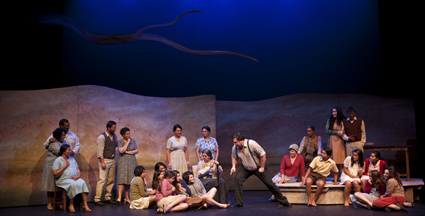
Tiriki Onus with the Short Black Opera ensemble and Dhungala Children’s Choir, Pecan Summer
photo Jorge de Araujo
Tiriki Onus with the Short Black Opera ensemble and Dhungala Children’s Choir, Pecan Summer
OPERA MIRRORS ABORIGINAL CULTURAL PRACTICES. INDEED, INDIGENOUS AUSTRALIANS HAVE BEEN TELLING THEIR STORIES THROUGH SONG AND DANCE, DRAMA AND COSTUME, FOR THOUSANDS OF YEARS. THE COMPARISON TO OPERA IS OBVIOUS AND YET FOR SO LONG WE HAVE BEEN UNDER REPRESENTED IN THIS WONDERFUL GENRE.
In July 2006, Pecan Summer was little more than a title. Ten years on from my autobiographical play White Baptist Abba Fan I knew it was time for my next major theatrical effort but what was it to be? After almost 20 years as a freelance soprano, I felt it was time to do something to encourage other Indigenous singers to consider a career in classical vocal music.
Opera has been my life; I have immersed myself in that world since the age of 14. I cannot imagine a world without it. The power of music to elevate a story beyond the spoken word has always captivated me.
Harold Blair paved the way for me. In 1949, a 25-year old Aboriginal tenor emerged from the cane fields of Queensland. After gaining his diploma at Melba Conservatorium, he began a career that was to span almost 30 years.
Harold was the first. It is never easy to be the first. He was a leader at a time when Australia wasn’t sure what to do with Aboriginal leadership. But with his voice and professionalism he well and truly transcended the status of Flora and Fauna imposed on Aboriginal people prior to 1967.
Developing a career in opera is a long, slow process. It is an elite pursuit. It is a demanding and all consuming profession with many, many layers of knowledge to acquire before a career can begin in a meaningful way. These points are NOT reason enough to prevent Indigenous men and women from taking this path, but the weight of low expectations could be. It is my goal to change expectations. When you change expectations you change outcomes.
In April 2007, after receiving an Australia Council Fellowship, I began a process researching the history behind Pecan Summer. I chose the story of the 1939 walk off from Cummeragunja NSW Mission/Station for its obvious dramatic content, the exodus of Yorta Yorta people from their homeland and the inevitable and unending search for identity. Much of my early research took place in the library of the Koorie Heritage Trust in Melbourne. I soon realised I needed to go to the source and speak to people who had lived the experience and most of whom are now in their late 70s.
I headed north to Shepparton where I knew of a Yorta Yorta Elder who had experienced the walk-off. Aunty Frances Mathyssen was just nine years old when she left Cummera along with her parents and 200 other men, women and children and yet could recount the events of that day in such vivid detail that I was immediately transported to that hot February morning.
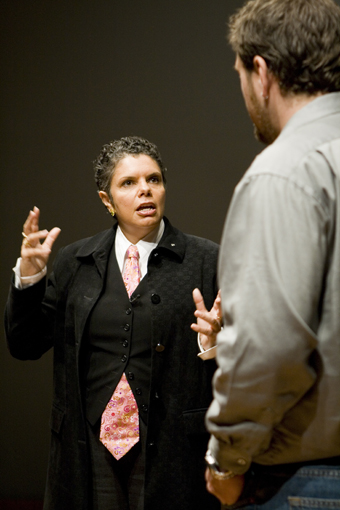
Deborah Cheetham
photo Jorge de Araujo
Deborah Cheetham
In 1939 the men and women of Cummera took their destiny into their own hands. Leaders such as Bill Onus, Jack Patten and Geraldine Briggs, encouraged by the tireless efforts of William Cooper and Douglas Nichols, showed amazing courage to lead their people across the Dhungala (Murray River) into Victoria. It is an epic tale. One deserving of an opera.
It also became a personal story. During my conversations with Aunty Frances I made a startling discovery. The Aboriginal grandparents that I had never known were actually part of the story and were well known to the elderly people I was interviewing. Suddenly I had a family that stretched beyond the limitations of my knowledge. People were telling me how much I reminded them of my grandmother Francis and how she was a singer with a beautiful voice. Suddenly my past linked up with my present and my future, and I just happened to be writing an opera about it—what are the chances?
Pecan Summer is my first libretto, my first operatic score. It comes from a very deep place, from genetic memory, from life’s experiences. In 2010 we took the story home, to Mooroopna, near Shepparton, for the world premiere. We did this in honour of the men and women whose lives were shaped by the walk-off. In 2011 it had its Melbourne premiere in the iconic Arts Centre Playhouse. Both seasons were received with critical acclaim. In 2012 we shared our story with Western Australian audiences, on the ancient land of the Noongar people.
Like Harold Blair before me, I set out to create a pathway for Indigenous singers who wish to pursue a career in the intensely emotional world of classical vocal music. Australian Indigenous voices can and will become the new sound in opera around the world. With Short Black Opera developing artists the calibre of Yorta Yorta bass baritone Tiriki Onus and Wiradjuri soprano Shauntai Batzke the future is looking very bright.
RealTime issue #111 Oct-Nov 2012 pg. 18
© Deborah Cheetham; for permission to reproduce apply to realtime@realtimearts.net
YELLAMUNDIE, THE NATIONAL ABORIGINAL AND TORRES STRAIT ISLANDER PLAYWRITING FESTIVAL, IS LONG OVERDUE. THE FIRST NATIONAL BLACK PLAYWRIGHTS’ CONFERENCE WAS HELD AT THE AUSTRALIAN NATIONAL UNIVERSITY IN CANBERRA IN JANUARY 1987, THE SECOND AT MACQUARIE UNIVERSITY, NORTH RYDE, IN JANUARY 1989, AND THE THIRD WAS HELD AS PART OF THE ADELAIDE FESTIVAL IN 2000.
It has been over 20 years since the last Indigenous Playwrights’ Conference occurred in Sydney and since then there have been significant developments in Aboriginal and Torres Strait Islander theatre across Australia.
As well as the emergence over recent decades of companies such as Yirra Yaakin, Ilbijerri, Kooemba Jdarra and Moogahlin there has been an explosion of new actors, directors and writers telling stories in a variety of different and exciting forms and styles. Audiences, both Aboriginal and non-Aboriginal, have responded enthusiastically to these powerful stories.
Yellamundie—a Dharug word, from the north west region of Sydney, meaning storyteller—will be produced and presented by Moogahlin, the Redfern-based Aboriginal performing arts company, at Carriageworks as part of the 2013 Sydney Festival.
The idea for a new national playwriting conference or festival came out of the first National Indigenous Theatre Forum, held on Yidindji Gimuy Walubara Country in Cairns, Queensland in August 2010. The forum identified a need for a meeting place where new work could be developed and presented within a national Aboriginal and Torres Strait Islander theatre community context:
“The Cairns Consensus recognises that Indigenous theatre is integral to our cultural identity and plays an important role to the broader artistic vibrancy of Australia…the forum agrees to progress a national approach to the development of the Indigenous theatre sector…the Cairns Consensus builds on the legacy of our storytellers, practitioners and Elders, past and present, and views this forum as a platform to secure the future of National Indigenous Theatre.”
Yellamundie is important because it provides the Aboriginal and Torres Strait Islander theatre community with a national reference point to gauge the ongoing development of the sector. It will allow us to discover and nurture new playwrights, support established playwrights, help writers to develop their profile within the industry and build long and sustained careers. The festival is a way to advocate on behalf of writers, not just within the Indigenous theatre community but by encouraging mainstream companies and producers to engage more with new and challenging material.
It’s also a way to survey how many Aboriginal and Torres Strait Islander playwrights are currently writing in Australia, what they are writing about, who they are writing for, and what issues or ideas appear regularly in the work despite or because of geographical and cultural distance or closeness.
When applications for the festival closed in August, Moogahlin was delighted to have received 16 plays from both the city and the bush. From these, six plays have been selected and the playwrights will be invited to Sydney to have their scripts workshopped: Cuz, Billy Mcpherson (NSW); The Lighthouse, Sermsah Bin Saad (WA); Dust, Suzanne (Jub) Clerk (WA); Weight, Jada Alberts (NSW); Crowbones and Carnivores, David Milroy (WA); and First Contact, Jane Harrison (VIC).
Three directors will work on two plays each, while there will be two dramaturgs who will work on three plays each. We are planning for a company of 10 actors of mixed ages and gender depending on the scripts and their casting requirements. All theatre artists working on the festival will be from the Moogahlin Performing Arts membership and will be paid for their contribution.
The first week will be closed to the public and will be spent in rehearsal/workshop with the writer working with the director, dramaturg and actors developing the script. The second week will consist of public readings of the plays presented to an audience of industry professionals, community and the public. Theatre companies, directors, producers and any potential supporters will be encouraged to attend. The natural outcome of the festival would be that one or any number of these plays would be picked for further creative development, or at best, production.
Even though Yellamundie is the first national writers’ event for many years it is hoped that it will become a regular part of the national Indigenous theatre calendar. As it grows in scale and importance so too will the opportunities for Aboriginal and Torres Strait Islander theatre in Australia.
Moogahlin Performing Arts: Yellamundie, National Aboriginal & Torres Strait Islander Playwriting Festival, Carriageworks, Redfern, Sydney, Jan 28-Feb 9, 2013; supported by the Aboriginal and Torres Strait Islander Arts Board of the Australia Council, Playwriting Australia, Performing Lines, Carriageworks and the Sydney Festival.
RealTime issue #111 Oct-Nov 2012 pg. 20
© Frederick Copperwaite; for permission to reproduce apply to realtime@realtimearts.net
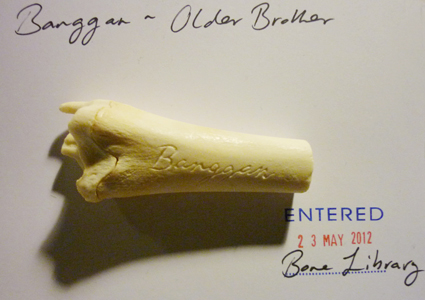
Sarah-Jane Norman, Bone Library
photo Annaki Kissas
Sarah-Jane Norman, Bone Library
AS EDITOR OF REALBLAK, LIKE A BOWER BIRD, I HAVE BEEN COLLECTING SHINY ITEMS, AND NOW PROUDLY DISPLAY THEM IN THE FIRST EVER INDIGENOUS PERFORMING ARTS EDITION OF REALTIME. OUR BOWER CONTAINS JEWEL-LIKE STORIES OF ARTISTS’ PRACTICES, FROM THEIR OWN PERSPECTIVE, THAT THEY HAVE POLISHED AND FUSSED OVER AND MADE PRECIOUS. ALL DIFFERENT, BUT WITH COMMON ‘BASE METALS’—OF PASSION, COMMITMENT TO COMMUNITY, A SENSE OF HISTORY OR CONTINUANCE OF CULTURAL PRACTICES, YET FORWARD THINKING. EACH OF THE ARTICLES, IN MYRIAD SHADES AND TONES, CONVEYS THAT STORY.
The stories demonstrate that we don’t want to be typecast or described or documented, or marginalised or exoticised. Our cultural expressions are not static—we morph and weave and are porous to other influences, but we hold our values; our cultural core persists. We are resilient. We are not homogenous. How could we be? Here’s a glimpse; Blak queens chatting, blood and bread in performance art, running away to the circus and the issue of a Blak aesthetic.
what’s happening?
This editorial is from my ‘bird’s eye’ view as a playwright. The third National Indigenous Theatre Forum (NIFT) held in Cairns, in August, was exciting, and it glinted with optimism. Beginning with an impressive list of achievements from the previous year, it was inspiring to hear of the initiatives that have come out of our forums—the idea for this edition, for one, and the emerging producers initiative being another (see Louana Sainsbury). The event naturally generated lots of ideas: about peak bodies and pathways and training and the need for advocacy and protocols and…not much talk about writing (from a playwright’s point of view).
One discussion at NITF did turn to devised plays, and who owns them, particularly when the devising group is made up of Aboriginal actors and the assigned writer is non-Aboriginal. The debate then segued to the issue of community permissions and when they should be sought, reciprocity and royalties and ways to divide them up fairly to give back to community. Overall, protocols were a burning issue at the NITF and they also smoulder in many of our RealBlak articles. Contrast this with the mainstream world where anything is up for grabs (wanna write a story about Warnie? Sure! Wanna write a story about teenage lesbian kidnapping murderers, based on a real story? Sure! Backlash? Huh? But if there is backlash, then it makes for good publicity).
For us, as Indigenous writers, unless we are stuck in a mould of only writing our own stories (in my case, how boring) then we need to write other stories—other people’s, made up stories and community stories—and these do require a process to be undertaken—a process that involves great sensitivity, protocols and permissions. Telling Aboriginal stories comes with a responsibility that none of us takes lightly. I am always struck, whenever you get a mob of blackfellas together, that we are anxious to ‘do the right thing’ by our communities, beyond furthering our own careers or feathering our own nests. But protocols and permission seeking are not always straightforward. Differences occur in the way communities operate in different geographic areas too. In this discussion—and it needs to be had—we mustn’t lose sight of the purpose of protocols. Wouldn’t that be to ‘do no harm’? None of us wants to harm our communities, I would say. We live in them, we have to deal with the consequences. (Unlike whitefellas, who can usually walk away). Challenging stuff.
who’s writing our stories?
While we are trying to grapple with the complex stuff of protocols, a quiet stealthful revolution is happening. White writers have slipped right past us and have jammed their Aboriginal themed plays onto a stage near you. I know, they have always written our stories. Alexis Wright laments the fact that non-Aboriginal people write Aboriginal-themed literature: “our histories have been smudged, distorted and hidden…” And now, too, in theatre. What was a novelty has become a steady stream. It’s not even a question of can they, because, mostly, it appears that they can (with caveats). But should they? And why do they? And are they doing it better than us? It seems to me more Aboriginal stories by non-Aboriginal writers are being produced than those that are written by us. Audiences are seeing them. And loving them, I guess.
who controls storytelling?
That brings me to another theme discussed at NITF: “What is Aboriginal theatre?” Not as straightforward as one might think. Is it an ‘Aboriginal play’ if it has an Aboriginal theme, Aboriginal actors, a white writer and a white director? (Before you think I am against white directors please note that my last play was sensitively and skillfully directed by a white director. Nor am I against collaboration. Or colour-blind casting.) What about a devised play with Aboriginal actors but where no ‘writer’ is listed? My point is, who is in control of the storytelling? Who owns the story? (Legally, the writer holds the copyright). And what about plays that are more clear-cut? Plays written by white writers, directed by white directors, programmed by white artistic directors and yet with Aboriginal themes and Aboriginal actors, who often get ‘tasked’ with being instant cultural consultants (just add ochre) during the workshop or rehearsal period, despite obvious power imbalances in those relationships? The publicity for the play features a bright-eyed Aboriginal actor looking deadly. But is it an Aboriginal play? Is it important who writes the story? Why care? Well, I do.
One part of this mix is that there are only four Aboriginal theatre companies; they might have funding to do one major production per year. At most, that means four playwrights may be commissioned in any given year. Not a whole lot of wriggle-room there. So, we want to get our plays on to main stages. Okay, there’s a dozen or so theatre companies around the country, who might program one ‘Aboriginal’ themed play per year. So if non-Aboriginal playwrights are writing those plays, where are our opportunities? Maybe there should be a moratorium on ‘Aboriginal’ plays written by non-Aboriginal people—unless they have been approved by a suitably qualified Aboriginal advisory group? And then branded as such, like a ‘Heart Smart’ tick: what about an ‘Aboriginal Approved’ or ‘RealBlak’ tick? Cos shouldn’t they be subject to protocols, too? Radical? Think about it.
In response to a key priority identified at the second National Indigenous Theatre Forum held in Cairns 2011 of the need for a space in which Indigenous performance makers and workers can critically reflect on their practices or their sector, Liza-Mare Syron, Andrea James and Alison Murphy-Oates approached RealTime to host RealBlak and the Aboriginal and Torres Strait Islander Arts Board to fund the venture.
I would like to thank all of the writers for their contributions and the RealBlak editorial committee for their wise council and encouragement; as well as the RealTime gurus Keith Gallasch and Virginia Baxter and team for their mentoring and support.
RealBlak is published with the support of the Aboriginal and Torres Strait Islander Arts Board of the Australia Council for the Arts.

RealTime issue #111 Oct-Nov 2012 pg. 2
© Jane Harrison; for permission to reproduce apply to realtime@realtimearts.net
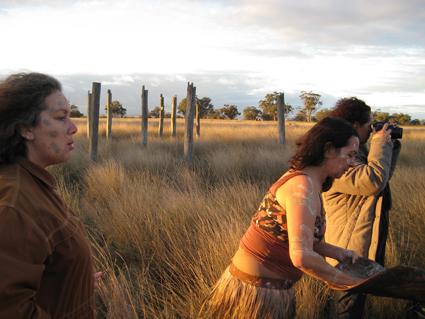
Aunty Rhonda Dixon-Grovenor, Lily Shearer, Michelle Blakeney, working on Posts in The Paddock, My Darling Patricia & Moogahlin Performing Arts
photo Clare Britton
Aunty Rhonda Dixon-Grovenor, Lily Shearer, Michelle Blakeney, working on Posts in The Paddock, My Darling Patricia & Moogahlin Performing Arts
Currently I’m the General Manager of Gadigal Information Service Aboriginal Corporation (GIS), a leading Aboriginal and Torres Strait Islander media/arts hub based in Redfern, Sydney.
GIS is the home of Indigenous community radio and also plays a leading role in developing and promoting the careers of Aboriginal and Torres Strait Islander musicians, broadcasters, singers and songwriters. Its Young, Black & Deadly workshops support the creative aspirations of under-18s in performance and radio broadcasting. The Gadigal Music Label develops new and emerging talents and supports established performers through presenting a range of recording opportunities and distribution for our music. GIS’s annual Yabun event on 26 January is Australia’s largest one-day festival of Aboriginal and Torres Strait Islander cultures and its Klub Koori events are regularly held in various venues around Sydney.
Although busy with these projects, I also make time to undertake my own creative practice. After four long years of development, the performance work Posts in the Paddock had its premier showcase at Carriageworks in 2011 and a full spotlight at the Australian Performing Arts Market (APAM) in 2012. For Posts I was the cultural creative and ‘queen connector,’ which meant I connected up relatives and community who had an association with the material in the play. For This fella, my memory, a devised work, which has recently had a very successful reading for Moogahlin, I played one of the main characters, Aunty Toots. She’s a former country and western singer who left her homelands and thinks she knows all about culture but in the play it is clear that she has a lot to learn! I love the whole process of creating—working across the disciplines, acting, devising, creating, writing, connecting.
My next burning project will be to get the Moogahlin kids’ circus off the ground. And to get a production of This fella, my memory up at Carriageworks in 2013.
Lily Shearer is a Muruwaroi woman with over 30 years experience in Aboriginal Cultural Development, theatre and performance making. Since completing a Bachelor in Theatre Studies at the University of Western Sydney, Shearer has worked in Aboriginal community theatre in leadership roles on a remarkable number of performance projects. Her body of work in this field is unprecedented. Importantly, she has always worked for the betterment of Aboriginal communities and Aboriginal theatre and performance practitioners.
RealTime issue #111 Oct-Nov 2012 pg. 20
© Lily Shearer; for permission to reproduce apply to realtime@realtimearts.net
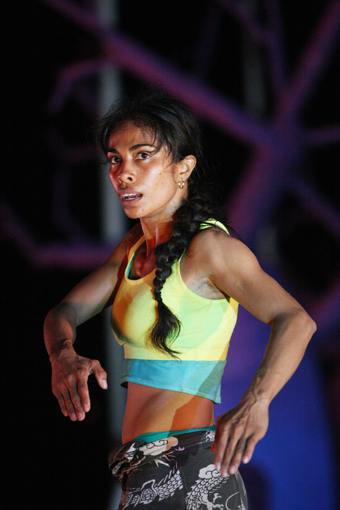
Dalisa Pigram, Gudirr Gudirr
photo Rod Hartvigsen
Dalisa Pigram, Gudirr Gudirr
I am working on a solo dance piece called Gudirr Gudirr for the Marrugeku company. The concept came from my grandfather Patrick Dodson. He spoke about Gudirr Gudirr or Guwayi (its proper Yawuru name), a small shore bird that calls out to warn you when the tide is about to turn. He related this bird to the work I do in my community keeping Yawuru language alive but also with how Marrugeku has been finding new ways of storytelling that ensure our culture survives. I have taken this idea as a starting point and have been exploring dance themes through animals that function as omens or warnings to the community. My story is influenced by my mixed heritage of Malay, Philipino and Indigenous Australian cultures, practices like Malaysian martial arts (Silat), gymnastics and memories of traditional movements.
When creating ideas for a work we sit and talk with Elders from the community and are culturally guided by appropriate people at every stage of development. As co-conceiver/dancer/choreographer of Gudirr Gudirr I will collaborate with Belgium-based director Koen Augustijnen. This collaboration has grown from a long-term commitment by Marrugeku to develop new possibilities for contemporary Indigenous dance artists. Gudirr Gudirr will premiere at Dance Massive in Melbourne in March next year followed by its Broome premiere at Shinju Matsuri in September 2013.
And I will continue to work at Cable Beach Primary School teaching Yawuru language to students there and enjoy time watching my three children grow.
Dalisa Pigram became Co-Artistic Director of Marrugeku in 2009 and is a founding member and core performer with the Broome and Sydney-based contemporary intercultural performance company. She has toured extensively both overseas and throughout Australia with shows Mimi (1997), Crying Baby (2000) and Burning Daylight (2006/9). Pigram comes from the Yawuru people of Broome in the Kimberley region of WA and Marrugeku’s recent work Buru was conceived, choreographed and co-directed by her. She is currently working on her solo piece Gudirr Gudirr, a work accompanied by video art by Vernon Ah Kee.
RealTime issue #111 Oct-Nov 2012 pg. 22
© Dalisa Pigram; for permission to reproduce apply to realtime@realtimearts.net
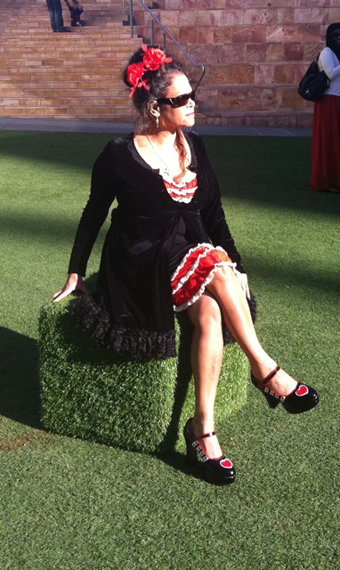
Dallas Winmar
My writing journey started when I was first approached by Yirra Yaakin Noongar Theatre to write Aliwa, a story of three sisters and their mother’s fight to keep them together. Aliwa premiered in Perth (2000). I was also commissioned by Kooemba Jdarra to write Skin Deep for their 2000 program.
Aliwa was re-staged at Belvoir Street Theatre Sydney (2001) and is published by Currency Press. Yibiyung, my third play, premiered at Belvoir Street (2008) and played at Malthouse (2008). I have also written an episode for Series 2 of My Place—Before Time: Bunda (ABC TV and Australian Children’s Television Foundation). My writing awards include: Kate Challis Award 2012 for Yibiyung, Kate Challis RAKA award 2002 for Aliwa (shared with Jane Harrison for Stolen) and short-listing for the WA Premier’s Book Award and the Louis Esson Prize for Drama.
I’m currently working on a stage adaptation of Kim Scott’s award winning novel That Deadman Dance with director Neil Armfield. The process of writing I guess is a madness. A journey drawing on personal experiences. Love the feeling you get when a character is given a voice, a personality, life. The magic that writing gives. Is it worth it? Yes!
Dallas Winmar (Yettung) was born in Perth, WA. She has worked in many different industries, balancing her full-time job with her love of the arts.
RealTime issue #111 Oct-Nov 2012 pg. 22
© Dallas Winmar (Yettung) ; for permission to reproduce apply to realtime@realtimearts.net
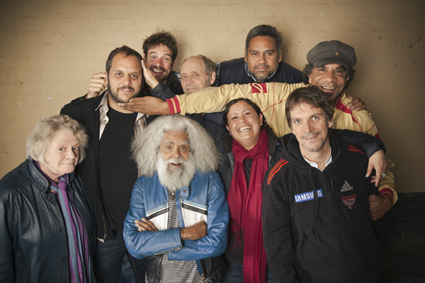
Isaac Dranic top left with cast of Coranderrk: We Will Show The Country
photo by Richard Kendall for the Melbourne Times Weekly
Isaac Dranic top left with cast of Coranderrk: We Will Show The Country
Kiya/Dobar dan (Hello)
With a one-year-old girl who’s just learnt to walk, directing a show at the Sydney Opera House, my footy team making the finals, life is busy and going along nicely. This year I’ve worked as an actor, writer and director.
I kicked off the year directing Coranderrk: We Will Show The Country, an inspiring true story of courage and determination (Melbourne Indigenous Arts Festival/Sydney Opera House). I also toured a show I co-created called Bindjareb Pinjarra, a comedy about a massacre! What? Built through improvisation and with proper consultation and respect for protocol, this show is the most flexible and dynamic theatrical experiment I’ve ever been involved with (www.realtimearts.net/article/issue96/9846).
I’m currently working on a professional development initiative with Ilbijerri. The idea is to form an all blak ensemble to create stories using a collaborative and eclectic approach. Next year I am involved in the Malthouse production of The Shadow King and Belvoir’s Peter Pan as assistant director.
[Kiya is Nungar and Dobar dan is Croation; both mean hello. Eds.]
Isaac Drandic is a father, husband, actor, writer, director and is currently the associate director of Australia’s longest running Indigenous theatre company, Ilbijerri. His mother is Noongar from south-west WA and his father is from Croatia.
RealTime issue #111 Oct-Nov 2012 pg. 23
© Isaac Drandic; for permission to reproduce apply to realtime@realtimearts.net
What a year! I’m on a big learning curve as an ‘emerging producer’ and nothing is more rewarding than seeing a show through development to performance. Perhaps closest to my heart is the show Beautiful One Day.
A co-production between Belvoir, Ilbijerri Theatre Company and version 1.0, Beautiful One Day is a verbatim theatre piece looking at Palm Island in the aftermath of a 2004 death in custody (the subject of the book and film both titled The Tall Man). My first two weeks on the job were spent on Palm Island where we connected with the local mob and began creative development. The play premieres in November.
Another profound and enriching experience was the Festival of Pacific Arts in the Solomon Islands in July. Aboriginal and Torres Strait Islander mob made up the Australian delegation and we joined our brothers and sisters from around the Pacific for two weeks of cultural celebration and festivities.
I participated in the National Indigenous Theatre Forum held in Cairns in August. Playwrights, theatre and dance practitioners, producers and presenters came together to map out the landscape of Indigenous theatre and dance and identify areas and steps we can take to strengthen our sector. The next step for me will be following through the commitments that I made, building on the progress and achievements that have come out of previous forums.
Louana Sainsbury is a descendant of the Burramatta clan, of the Dharug nation. She holds a Bachelor of Arts in Theatre and Performance Studies and Film Studies from the University of New South Wales as well as a Certificate III in Live Production, Theatre and Events. She has worked as an Assistant Stage Manager for Bangarra Dance Theatre and Sydney Theatre Company before joining Belvoir and Urban Theatre Projects in 2012 as Emerging Indigenous Producer.
RealTime issue #111 Oct-Nov 2012 pg. 23
© Louana Sainsbury; for permission to reproduce apply to realtime@realtimearts.net
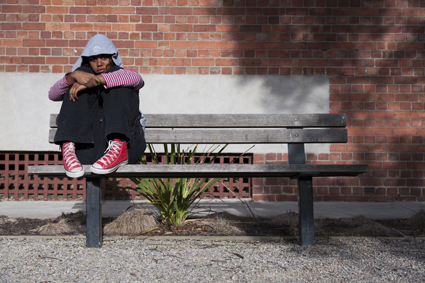
Maurial Spearim, Body Armour 2012
photo Steven Rhall
Maurial Spearim, Body Armour 2012
I am interested in exploring theatre, song and dance through the expressions of the body and the utterance of the voice; where artforms combine to create a story evoking the past, present, race, gender and age to a seamless progression and examination of life. I am influenced by a mixture of past and present; how deeds done can influence the ‘now.’
I had an early introduction to storytelling, dance and song from learning and performing my traditional songs and dances, ever since I could walk. This has formed a strong foundation for me to grow and further develop my talents. I undertook a Diploma of Performing Arts at Southbank TAFE QLD then was encouraged to apply to the VCA.
I am currently working with Ilbijerri Theatre Company touring Australia performing in Body Armour, a show that has been designed to raise awareness of Hepatitis C in the Indigenous community and beyond. It has been a fantastic experience and it is truly a blessing to be doing what I love every day. I am also in the process of developing my first album, which I am hoping to release in 2014.
Maurial Spearim is an Indigenous woman from the Gamilaraay nation on her father’s side and Kooma/Muruuwari on her mother’s. She is an actress, writer, singer and dancer. You can see her shake and groove in the fun dance show called Move it Mob Style (ABC3 TV) and later in the year she will appear in a short film called Sweet where she plays a flirtatious teenager.
RealTime issue #111 Oct-Nov 2012 pg. 23
© Maurial Spearim; for permission to reproduce apply to realtime@realtimearts.net
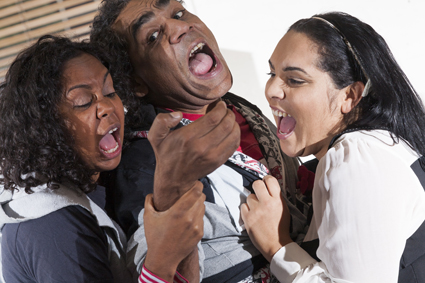
Maurial Spearim, Leroy Parsons, Uraine Mastrosavas, Body Armour, Ilbijerri
photo Steven Rhall
Maurial Spearim, Leroy Parsons, Uraine Mastrosavas, Body Armour, Ilbijerri
I DIDN’T TRULY UNDERSTAND THE MYSTERIOUS, OMINOUS ROLE OF THE DRAMATURG UNTIL I’D BEEN WRITING ‘PROFESSIONALLY’ FOR ABOUT FOUR YEARS AND HAD WORKED WITH FOUR OR FIVE DIFFERENT DRAMATURGS WHO HAD ALL BROUGHT ME DIFFERENT LESSONS ABOUT DRAMATIC CONVENTIONS.
With no formal training I was learning on the job, what worked and what didn’t. I seemed to have an infatuation with what didn’t, dragging my painfully over-worded, prose-filled, two-hander about a delusional heroin-addict Shrunken Iris around the country to various conferences and festivals like it was some sort of get-out-of-jail-free card or free-trip-to-wherever-the-next-conference-is card.
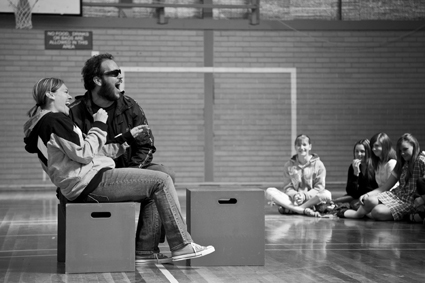
Nikki Ashby, Isaac Drandic, Chopped Liver
photo Steven Rhall
Nikki Ashby, Isaac Drandic, Chopped Liver
Most of my pieces (or should I say Shrunken Iris which was ‘debuted’ at least three times) though performed in theatres, were not really plays but more performance poetry. Then in 2006 I was given my first major commission, Chopped Liver—a comedy about Hep C, which was still not really considered a play but more a ‘health vehicle.’ So I put my on-the-job-lessons to work, did my research, set the scene, established a time frame, developed my ‘characters’ and not only thought I was all set but that I was quite clever to boot. I entered the rehearsal room armed with my first draft, that even when read by two talented actors sounded like a 45-minute walking-talking health pamphlet the effect of which could be equated to licking a piece of burnt toast. The awkward silence and uncomfortable looks on the surrounding faces (including the poor actors; was it them? could a script really be that bad?) made it clear that I was far from ‘entertaining the audience whilst educating them.’
Where was the journey, the humour, the tension, the arc, the payoff?
I turned to look at the knowing smirk of my esteemed dramaturg John Romeril, though I then had no idea who this old codger was and what he had achieved. I think I heard something about a baby factory [actually the famed Pram Factory of the 1970s. Eds] but he didn’t look that fertile to me. He had obviously read my script, had known it was wrong and let me enter the lion’s den without any intervention, and then met my silent plea of “Why didn’t you tell me?” with words to the effect of “oh well, back to the drawing board.”
At the time I couldn’t understand why he hadn’t said something to save me this humiliation, and I muttered to him, “I don’t think I can do this,” at which he laughed and reassured me, “Of course you can. It’s all there, it’s in the characters.” And so it was—in their backstories that I had written half-heartedly, not really understanding the point of the exercise. A map of their lives, the arc, the suspense, the tension, the journey and ultimately the real story of Hep C was all there waiting to be found and written. John, skilled dramaturg that he is, knew that he couldn’t show me, that I had to discover it for myself—then his job could really begin.
My most successful, enjoyable, educational, frustrating, painful, stick-a-fork-in-a-toaster dramaturgical relationship has been with John Romeril and not just because he is such a talented and experienced writer (though of course this helps), but because he recognised my internal creative source and helped me to find a way to tap it. He has helped me to harness my raw style and unpack the thoughts that well up from the ground, through my body and around my head and which I struggle to put on paper in a way that is interesting and watchable for the ever elusive ‘captive audience.’ On the flip side he also recognises when it is time to let my mind run free with the creative spirit, to purge the demons and indulge in the ‘genius,’ knowing once I have had my fun he will be waiting with coloured markers, yellow and blue note cards and his proverbial whip, ensuring I am developing believable, empathetic characters, that I am mapping a structure and plotting the journey, titling my scenes and even identifying a dreaded beginning, middle and end. All of which I would find quite tedious tasks without him acting as an encouraging and unsatisfiable sounding-board prodding me to writing glory by dryly asking, “Are you going to do some real work now?”
To me a good dramaturgical relationship has nothing to do with race or gender. I have worked with both men and women, Indigenous and non-Indigenous—maybe because I don’t write race- or gender-specific stories. I write stories that just happen to be about Aboriginal people. To achieve success it is essential for a dramaturg to be able to keep pushing past the point of what the writer thinks is possible, convincing them that it can be taken further, made better, that there is more truth to be found, revelations to be made, that there are more laugh-out loud and punch-em-in-the-guts moments, that not every word is precious nor every line needed, that the loudest moments are found in the silence, and though the ending may have been written the story is far from over. A non-Indigenous dramaturg must not be scared to ask questions that may seem ignorant, to make points that are not politically correct, to sometimes play the racist advocate but ultimately have an empathy and understanding of the diversity of the voices of Aboriginal people—recognising we are not all the same, that we all look, feel, think, desire, live, experience, express and write differently and yet somehow simultaneously share a commonality that belongs to all of us.
A good dramaturg also knows that some ground is sacred, that the truth cannot be changed nor doctored—and sacred ground is not monopolised by Indigenous people; truth is not a race-specific thing, we all have our own story we are trying to express, the place we are coming from or trying to get back to, the point we are trying to make. If dramaturgs try to force their interpretation of the truth then those are the stories they need to write themselves.
Kamarra Bell-Wykes is a descendant of the Jagera and Butchulla clan groups. Her plays include Shrunken Iris (Next Wave and Ilbijerri); Chopped Liver, which toured for four years visiting schools, prisons and Aboriginal communities from Broome to Cherbourg; Body Amour, (Ilbijerri 2012); and Mother’s Tongue (Yirra Yaakin, 2010). Kamarra recently participated in the Black Comedy creative development process for ABC2. She loves to explore modern day issues facing contemporary Aboriginal people.
RealTime issue #111 Oct-Nov 2012 pg. 10
© Kamarra Bell-Wykes; for permission to reproduce apply to realtime@realtimearts.net
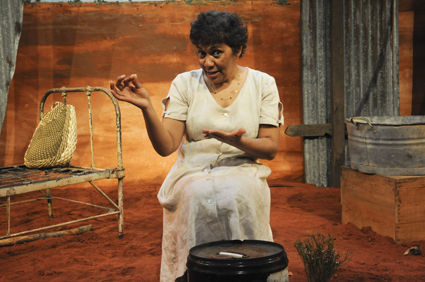
Roxanne McDonald, Windmill Baby, design by Ruby Langton-Batty
photo Heidrun Löhr
Roxanne McDonald, Windmill Baby, design by Ruby Langton-Batty
THE INSPIRATION FOR MY WORK AS A DESIGNER COMES FROM MY FAMILY, OUR HISTORY AND ARTISTS WHO HAVE INFLUENCED ME. I GREW UP SURROUNDED BY REMARKABLE PEOPLE WHO TAUGHT ME TO QUESTION, READ AND OBSERVE. MY MOTHER (PROFESSOR MARCIA LANGTON, FOUNDATION CHAIR IN AUSTRALIAN INDIGENOUS STUDIES AT THE UNIVERSITY OF MELBOURNE) AND FATHER (DR PHILLIP BATTY, SENIOR CURATOR FOR ANTHROPOLOGY AT MUSEUM VICTORIA) HAVE BOTH PAVED A PATH FOR ME TO WALK DOWN PROUDLY. I AM DESCENDED FROM A PEOPLE WHO HAVE LIVED IN THIS COUNTRY FOR TENS OF THOUSANDS OF YEARS.
My mother’s grandmother was Bidjara (although she spoke a number of languages like Yuwalarayi) and my great grandfather was Yiman. Their lives, under the Queensland government’s repressive policies, were very hard. On my father’s side I’m related to a woman who came here as a convict in the First Fleet for stealing ‘a bolt of cloth’. I’m also related to the Queen Mother through the Bowes-Lyon family—my grandmother actually received a small inheritance from the line.
Artists, filmmakers and designers from every imaginable background also inspire me. I admire the careers of Lizzie Gardiner and Catherine Martin and I learn from all production designers’ work I see. As a child I watched The Wizard of Oz, The Jungle Book and Blazing Saddles too many times to count. Living in the claustrophobic, straight-laced suburbs of Melbourne I would stare at the Tracey Moffat print we had in our lounge room (from her Something More series) and, like her, long for adventure. As a teen I would hire out every film featuring actors I liked at the time, such as Ewan McGregor or Audrey Hepburn. I admire the tongue-in-cheek take on colonialism of artist Yinka Shonibare, who re-created colonial scenes with headless mannequins swathed in period costumes made of richly patterned African Dutch wax print textiles. I love Kimberley artist Goowoomji (aka Paddy Bedford)’s use of colour, texture and shape in the expression of his deep relationship to land.
Research is the most important part of my designs. My aesthetic depends on the historical and cultural context of the story that needs to be told. I try to put my personal tastes to one side in order to be motivated by concepts and character, working in collaboration with the director, other creatives and the performers. I think it is important to approach the audience intelligently and assume that they already have knowledge about relevant subjects, in order to delve into ideas and I hope, present truths about ourselves. In my costume designs I try to establish a sense of character and place immediately for the audience. I want the character to appear on stage fully formed and my costumes are a big part of that. Being a designer is also largely about figuring out the practicalities of conveying an idea, balancing budget, time constraints and logistics.
The first show I designed after graduating was David Milroy’s Windmill Baby at Belvoir Street (2011), directed by Kylie Farmer. The protagonist, Maymay Star, returns to the Kimberley pastoral station where she worked and lived as a young woman. Actress Roxanne McDonald performed every character in the story. Kylie and I wanted to take the audience to the Kimberley with Maymay, and also create the feeling of visiting a grave. The set design was a painted backdrop and a hyper-realistic reconstruction of the decaying station. We covered the entire stage floor in fine red dirt (pindan), causing much difficulty for the technical department (there are still traces of it in the most unexpected crevices at Belvoir). Kylie explained that it would be culturally problematic to import actual Kimberly pindan so we decided to recreate it. We did this by mixing Sydney quarry sand, which is yellow, with synthetic iron oxide. All of the props were extensively researched and were chosen based on that research. Artist Belinda Williams, who has spent a lot of time travelling across Australia, painted the backdrop.
In my costume research I came across some very beautiful pictures of women who worked as domestic servants on pastoral stations at different times in history. I based Maymay’s costume on two pictures, one from the 1890s and one from the 1920s. In both, the women were holding washing baskets. What struck me was that they were essentially wearing the same dress: very modest white cotton (probably recycled flour sacks) in the fashionable silhouette of the time. I had a dress made for Roxanne out of very beautiful, expensive Italian linen in a simple, modern design. I wanted her costume to seem current and also reference the images of the station women so that visually she would merge into her memories of the past.
I am incredibly privileged to be working as a production designer at this time in Australia and to be part of a significant movement towards getting Aboriginal voices into the mainstream. When I think about how things were a generation ago, I fully appreciate the accomplishments of people like Bob Maza, Jack Davis and Justine Saunders. For me, an important part of creating work is to inform the audience and help them to digest and reflect upon complex issues in ways they wouldn’t normally be able to. The best way to do this is to make them laugh. An excellent example of this is Bran Nue Dae, the musical written by Jimmy Chi (first performed by the Black Swan Theatre in 1990) and adapted in 2010 into a feature film directed by Rachel Perkins. In an industry bursting with talented Indigenous people I am also influenced by people such as Wayne Blair, Stephen Page and Leah Purcell. I am connected to a line of people who had to fight to tell their stories: now I am able to tell my story without the fight. There is obviously still a very long way to go for Indigenous Australians, but our generation has a very different struggle ahead of it from what was required in the past.
There is often a community expectation that I will be able to represent Indigenous people in a broad sense. This is a challenge because it is unrealistic to expect that one person can or should stand for a vast group of people—like anyone I can only speak from my own experience. I find the best way to deal with this [challenge] is to call my Mum. I know that being successful is a matter of continuing to work hard and being strong in the knowledge of who I am. I am interested in and affected by a range of issues. I like to read and think about civil rights, history and feminism. I also listen to Beyoncé and love reading Vogue. Fundamentally, I just want to work hard and be a part of telling stories through design. I have a long list of people I want to work with, both Indigenous and non-Indigenous. It is heartening what is happening in Australian performing arts and knowing that I am part of an industry that is constantly growing and evolving.
Freelance set and costume designer Ruby Langton-Batty graduated in 2010 from the Victorian College of the Arts with a Bachelor of Production degree. She was costume assistant on the feature film The Sapphires, associate designer on I Am Eora for the Sydney Festival and worked in the costume department for Redfern Now, the forthcoming ABC TV series. She will design costumes for Beautiful One Day at Belvoir, Nov 17-Dec 23 and The Shadow King, a version of King Lear with Tom E Lewis at Malthouse, Melbourne, Oct 8-27, 2013.
RealTime issue #111 Oct-Nov 2012 pg. 11
© Ruby Langton-Batty; for permission to reproduce apply to realtime@realtimearts.net
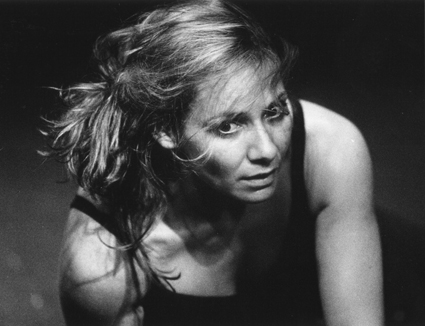
Image: Tammy Anderson, I Don’t Wanna Play House
photo Jeff Busby
Image: Tammy Anderson, I Don’t Wanna Play House
I recently appeared in The Sapphires playing Kay’s mum, a cameo in a brilliant, timeless piece of work. And I’m still performing my one-woman show, I Don’t Wanna Play House, which is in its 12th year. That’s been my biggest achievement artistically. Theatre changes lives.
I’m also the face of AGL, playing the character ‘Jenny’ in a national advertising campaign. I’m everywhere—posters, newspapers, TV, the lot! And I’ve just completed a placement program at Malthouse Theatre. It’s been a fantastic experience, learning new skills in administration, co-ordinating projects and being a part of a hard-working, passionate creative team.
I’ve just been commissioned to write my first children’s book. Through my little characters readers will get a taste of what it is like to be Aboriginal in suburbia. And I’m also in the process of writing a new work for the stage, The Waterhole. It is a collection of good yarns accompanied by amber ales from my travels across this rugged country. I’ve been on the road for a long time and the stories I’ve heard and characters I’ve met together make a work of art!
I am constantly taking on new challenges, being part of readings/ creative developments, facilitating workshops or presenting at festivals and events. Every day I fill my soul artistically.
Tammy Anderson is an actress, writer, director and recipient of The Uncle Jack Charles Award and The Uncle Bob Maza Award. She graduated from Swinburne University and The John Bolton Theatre School. She has been active in the arts for 20 years.
RealTime issue #111 Oct-Nov 2012 pg. 24
© Tammy Anderson; for permission to reproduce apply to realtime@realtimearts.net
beautiful one day
The theatrical documentary Beautiful One Day (Belvoir, Nov 17-Dec 23) is a co-production between Belvoir, Ilbijerri Theatre Company and version 1.0: the three companies “came together in 2011 over a shared sense of outrage at the injustices surrounding a death in custody in 2004….[P]rompted by the Palm Island community, Beautiful One Day looks for a way to turn outrage into real understanding and new possibilities. At its heart is a determined struggle to understand the persistent heavy-handedness of white Australia.” The cast includes Rachael Maza and Kylee Doomadgee, with set and costumes by Ruby Langton-Batty (see p11).
coranderrk
Melbourne’s Ilbijjeri Theatre Company and Belvoir are co-producing the Sydney season of Coranderrk (RT107, p34) with a cast that includes Jack Charles and Kelton Pell. Written by Andrea James (see p4) and Giordano Nanni (who conceived the idea for the show) and directed by Isaac Drandric (see p23), Coranderrk draws on the records of a Victorian Parliamentary Inquiry in 1881 to tell the powerful story of the men and women of the Coranderrk Aboriginal Reserve who successfully challenged the Aboriginal Protection Board (Belvoir, Dec 2013).
meyne wyatt & peter pan
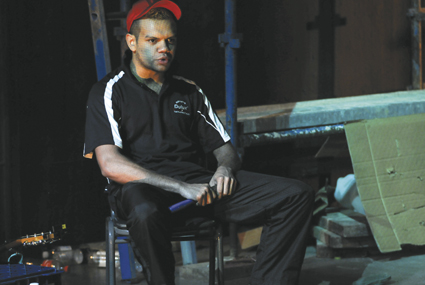
Image: Meyne Wyatt, Buried City, Urban Theatre Projects
photo Heidrun Löhr
Image: Meyne Wyatt, Buried City, Urban Theatre Projects
Aboriginal theatre artists hit the mainstream in 2011-12 in collaborative works with white theatre workers tackling classic works. Meyne Wyatt, who trained in the Aboriginal Theatre Course at the Western Australian Academy of Performing Arts will appear for Belvoir in the title role in JM Barrie’s Peter Pan, directed by Ralph Myers (Jan-Feb, 2013). Wyatt won the best newcomer prize at last year’s Sydney Theatre Awards, was seen earlier this year in Urban Theatre Project’s Buried Cities and in Griffin’s Silent Disco, has a supporting role in The Sapphires and is in Bell Shakespeare’s currently touring production of Moliere’s School for Wives.
tom e lewis and king lear
Tom E Lewis and Michael Kantor are collaborating to create The Shadow King, based on Shakespeare tragedy’s, with Lewis as Lear in a cast that includes Jimi Bani; the associate director is Isaac Drandric and props and costumes are by Ruby Langton-Batty (Malthouse, Oct 7-28). The work has been developed in association with the Melbourne, Brisbane, Adelaide and Perth Festivals.
yirra yaakin & the cake man
The classic Aboriginal play, The Cake Man, by Robert J Merritt will receive a welcome production as part of Belvoir’s Downstairs program in a co-production with Perth’s Yirra Yaakin Theatre Company in November 2013. Yirra Yakkin Artistic Director Kyle J Morrison will direct. The cast includes actor and emerging filmmaker Irma Woods.
RealTime issue #111 Oct-Nov 2012 pg. 24
© RealTime ; for permission to reproduce apply to realtime@realtimearts.net
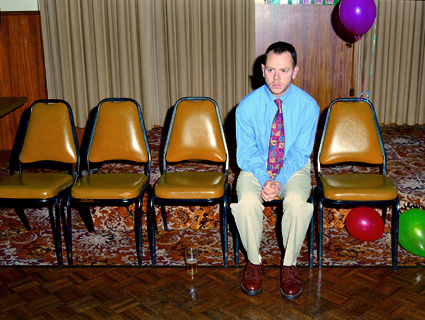
I want to Dance Better at Parties, 2004, Chunky Move
courtesy Chunky Move
I want to Dance Better at Parties, 2004, Chunky Move
AT A TIME WHEN ARTS FUNDING ACROSS THE COUNTRY IS UNDER DURESS, IT IS REFRESHING TO SEE A NEW POT OF MONEY EARMARKED SPECIFICALLY FOR CREATING AMBITIOUS ARTS-BASED FILMS. THE HIVE PRODUCTION FUND REFLECTS THE OVERLAPPING REMITS OF ITS FUNDERS: ABC ARTS AND ENTERTAINMENT, THE AUSTRALIA COUNCIL AND THE ADELAIDE FILM FESTIVAL, FOLLOWING ON FROM AN EXTENDED WORKSHOP COMPONENT IN EARLY 2011 WITH THOSE PARTNERS PLUS SCREEN AUSTRALIA AND THE SOUTH AUSTRALIAN FILM CORPORATION.
Encouraging multidisciplinary teams to collaborate on longer form projects that work on both a festival and prime time broadcast platform, The order of the day at HIVE is audacity of subject and bold production approach.
The slate of projects has a freshness in its blends of genre, format and team compilation, indicating that the investors have trusted proven talent at an early stage of a project’s life rather than weighing down the process by waiting for fully-formed material. Or, as producer Kath Shelper explains, “The great thing about the HIVE is that they have allowed us to be fairly loose in how we approach things…usually with film funding submissions you are required to be so explicit about what you’re making and why and how—’What are we going to see on screen?’”
A total of $670,000 has been secured by the following projects from the fund and they now have the momentum to meet their schedule to premiere at the Adelaide Film Festival in October 2013.
gideon obarzanek, i want to dance better at parties
I Want to Dance Better at Parties is a 30-minute hybrid film co-directed by Chunky Move founder Gideon Orbarzanek and Matt Bate (Shut Up Little Man! An Audio Misadventure, 2011, producer Bec Summerton; RT107 ). Stemming from an existing dance work from 2004 where Orbarzanek interviewed men about their relationship with dance then created eight pieces from the interviews, the film seeks to extend the story of one of these men. “[Orbarzanek] told me about one of the characters, a guy called Phillip Rose, and how he always wanted to expand [his story] into a bigger project,” says Bate. “We put this thing together not really knowing what it was… the dance piece had the outline of the story, but there was more going on, and that’s what we wanted to explore in our version.”
The story has a solid transformative arc. “[Phillip Rose] is a guy whose wife passed away, he’s got a daughter and an intellectually disabled son, he’s grieving, his life has been turned upside down. A few years later he goes to a party, and as he’s dancing he loses himself on this dance floor in the kitchen. He has fun but one of the women there says, ‘You’ve got to loosen up’…So the next day he joins this dance class, and the story’s about how he overcomes his grief, regains his confidence and gets his life back on track using dance.” At this stage the team is consolidating the best formal approach to bring the story to a half hour docudrama format.
lynette wallworth, tender
Esteemed media artist Lynette Wallworth also turns to documentary with Tender, a partnership with producer Kath Shelper (Samson and Delilah, 2009). The piece will follow Wallworth’s friend Jen (“our lives are bound together like seam in a rock”) who is starting a not for profit funeral company called Community Undertakings in Port Kembla. “In order to understand how she comes to be doing that I need to show you what has shaped her into the person she is now,” explains Wallworth. “The fearlessness of Jen is at the heart of the work.”
Wallworth and Shelper came together thanks to a combination of serendipity and networking at the lab component of the HIVE. Shelper explains, “I loved Lynette’s story…but I didn’t think about it much after [the lab]. Scroll forward a year and I was sitting at my desk putting the finishing touches to my first ever will, and Lynette walked into my office and asked me if I wanted to produce her film. I am terrified of death and I think I was doing my will as an insurance policy against dying too soon. I think now that it’s done hopefully it won’t need to be used for a while yet.”
Wallworth’s artistic practice will strongly inform her approach to the film. Following on directly from her interactive installation Evolution of Fearlessness (2008), she wants to create an immersive experience and give the viewer space to engage with the visually led narrative:
“I will work with disparate images and narration so that what we see on the screen is not a direct reflection of what we are hearing about but rather, in a more tangential way, resonant with the story, or else creates a disjuncture with the tone of that moment. In this way the emotional intimacy of the work can be maintained in a non-invasive way. We can hear Jen speak without having to see her. We have the space to imagine because the imagery will not be brutally accurate but spacious.”
michael kantor, the boy castaways
The Boy Castaways is an altogether different beast, a feature-length rock musical. Directed by former Malthouse artistic director Michael Kantor and produced by Jo Dyer (Lucky Miles, 2005) and Stephen Armstrong, it plays with themes of eternal life. “Four men are gathered in a theatre where they enact a twisted version of Peter Pan,” explains Kantor. “It becomes apparent that the men are engaged in a dangerous game with their own mortality…three of the men must experience what it is like to die, and for the other, the opposite.”
Kantor initiated the film after attending the HIVE Lab where he had the opportunity to explore the idea with others from the performing arts and other fields. “This was perfect timing for me, as I have long held a passion and deep desire to create filmed work, although I have never actually made any – not even a short film…The genesis for The Boy Castaways was an idea I had for a stage show that, after workshopping, I felt could not be told on a stage, as it was so much about the stage…The idea has grown into a script that I hope blends the innate, dangerous possibilities of the stage and the penetrating insight into the human, in this case male, character that is offered by the lens.”
The project draws together longtime Kantor collaborators with experienced film practitioners such as executive producer Rob Connolly (most recently director of Balibo, 2010), but “the script has been developed along a theatre-making model, with frequent readings and workshops allowing for a developing storyline and musical incorporation from the outset.”
RealTime will track these eclectic projects in 2013 as they mature.
2012 HIVE Lab, Melbourne International Arts Festival; www.thehivelabs.com.au
The second HIVE Lab is being held in October during the 2012 Melbourne International Arts Festival. The participants are arts and performance practitioners Bill Henson, Dr Brenda Croft, Eddie Perfect, Sam Haren, Daniel Koerner, Rachael Swain, Cat Jones, Lally Katz and Sean Riley; filmmakers Samantha Lang, Sophie Raymond, Sascha Ettinger Epstein, Paola Morabito, Nassiem Valamanesh, Eddie White, Natasha Pincus and Lucinda Clutterbuck; and visual artist and filmmaker John Gillies.
The mentors will be Lynette Wallworth, film producer Bridget Ikin, General Manager of Digital Business Development at ABC Commercial Robert Hutchinson, and playwright and screenwriter Andrew Bovell, along with composer Iain Grandage and theatre director Michael Kantor. The 2012 HIVE Lab is led by Wendy Levy, Executive Director of the US-based New Arts Axis, an organisation dedicated to facilitating creative innovation in art and culture.
RealTime issue #111 Oct-Nov 2012 pg. 25
© Sandy Cameron; for permission to reproduce apply to realtime@realtimearts.net
THE OFFICIAL THEME SONG FOR THE LONDON 2012 OLYMPIC GAMES WAS MUSE’S “SURVIVAL.” IT’S A TRULY STRANGE SONG, CHANNELLING SCOTT WALKER AT HIS MOST ATONALLY MELODRAMATIC, FED THROUGH A BOWIE/VISCONTI MOCK-ROCK-OPERA ARRANGEMENT, BLOSSOMING INTO A SPARKLING HOMAGE TO QUEEN THROUGH MATTHEW BELLAMY’S VOCAL HISTRIONICS AND HIS EMULATION OF A STRATOSPHERIC BRIAN MAY GUITAR SOLO. THINK “WE ARE THE CHAMPIONS” STAGED BY LATE-PERIOD SONDHEIM IN A POST-RADIOHEAD WORLD OF POP.
One of the 11 Worldwide Olympic Partners for the 2012 Olympics was Coca-Cola™. They produced their own corporate brand song and a promotional video which was shown extensively on television and cinemas in the lead-up to the Games. “Move To The Beat” was composed and produced by British DJ/producer Mark Ronson and features vocals by Katy B. The arrangement is built around a sluggish ‘de-Housed’ Pop-stomp dressed in banks of pre-set soft-synths emulating a quarter century of ironic/not-ironic string ensemble effects. ‘Sports audio specialist’ Dennis Baxter provided the sound effects of Olympians (sprinting, hurdling, shooting arrows, playing table-tennis and competing at taekwondo) which were sampled and edited into rudimentary loops to underscore the song’s rhythms. In its pale imitation of Kraftwerk’s “Tour De France” (1983), “Move To The Beat” is as frighteningly banal as Muse’s “Survival” is surprisingly progressive.
But might this be deliberate? For what is at stake when a multi-national corporation like Coca-Cola™ produces a theme song designed to exist simultaneously in all its global territories? “Move To The Beat” is not about content and effect; it’s all about context and placement. The chorus is tellingly droned by Katy B: “Everywhere in the wor-or-or-orld.” The paradigm is Warholian in its simplicity: if the Coca-Cola™ Corporation makes Pop, then that Pop will be like Coke™.
Coca-Cola™—early on tagged as a ‘taste sensation’—was one of the first ‘refreshing beverages’ to analyse not the physics of taste, but the physics of sensation. It’s what post-war advertising rhetoric famously referred to as selling “the sizzle, not the steak.” Coke™—a bizarre hybrid of effervescent coca, tannin-edged soda, sarsaparilla bite and caffeine aura—was targeted at the brain in the tongue. It sends in an invasion of nanobots of simulated flavourings working in hive-mind to territorialise the tongue’s bed of sensory readers. Its addictive crux lies as much in the way it contrasts the feeling of artificially induced taste against the procedures by which organic flavours work with the ‘tongue brain.’ After Coke™’s sizzle, biting into an apple becomes a sagging flavour event.
Replace ‘tongue’ with ‘ear’ and you have a version of how Pop music exists phenomenologically. Pop prides itself on sensation, and an awareness of that—not to mention a studious approach to craftsmanship—enables either strains or random instances of Pop music to be experienced as an exhilarating non-cerebral sonic art. It’s something that literary types will never comprehend, social theorists will always misapprehend and serious musicians spend their lives avoiding or suppressing.
“Move To The Beat” is no trail-blazer in the art of Pop—but this is because it’s essentially a trumped-up jingle pretending to be Pop music. The song signifies itself (the purpose of all ‘marketing’) as having everything it actually lacks. The rhythms are perfunctorily edited, the percussive textures lack bite, the synths hover like background scaffolding and Katy B’s vocals throw a congested blanket over the whole squirming mess. In contrast to the ways mainstream Pop recoups the pre-fab concentrates of Dubstep, Rave and R’n’B in oft-derided figures from Justin Timberlake to T-Pain to Skrillex and makes them sonically sizzle, “Move To The Beat” is perplexingly absent of any effervescence.
The cinema version of the video clip (and the official four-minute extended version) is filmed in one of those impressive outdoor stadiums with lighting like Albert Speer on crack. A massive audience has been assembled; a phalanx of roving cameras captures every micro-itch any living being makes; a wall of screens project rapid edits of Olympians soaring, posing, thrusting; and the whole show has been edited to such a degree that it implodes its own purpose. In fact, every shot of Katy B is out-of-synch with what she is actually singing on the track at that point. The subliminal effect is that the clip disregards its own music.
And this is precisely where Pop reveals itself in the clip’s audiovisual spectacle: the song is treated as transient fabric, insignificant textures, a meaningless apparition. In the hands of Coca-Cola™, the song is presented aurally as it is—dull and flat—while being presented visually as all it isn’t—flashy and exciting. Song-steak with video sizzle. The widescreen pizzazz of the clip (I saw it at one of Village’s full-digital cinema complexes) attempts to generate an ocular overload as if such a procedure pushes our perceptual limits. Instead, one can experience with clinical precision the ineffectiveness of such a spectacle.
Proof of how Pop music here is corralled into prancing around as a phantom of itself on the televisual stage lies in the way the clip suggests that these Olympians are actually ‘performing’ their sound effects live in this delusional circus of imploding Pop. At one point, the archer shoots an arrow from the back of the auditorium to a target on stage, and hits the mark—with perfect MIDI timing to boot. Of course it’s not intended to be believable, but it insists on theatricalising in the real space of the stadium an architectural logistical staging of how the sounds in the song are produced and mixed.
Mark Ronson appears on stage (dressed in red and white, following subliminal colour-coding 101) and conducts these ‘performers.’ His fey arm jerks are among the most limp-dicked conductor poses I’ve ever seen from a Pop performer. Ronson’s lack of physical prowess and Katy B’s stiff waddling and twirling are contrasted with Olympians being forced to perform like monkeys in drag, wildly flicking and bouncing on the stage and along special catwalks reaching into the audience. Frankly, no-one comes off well in this debacle. “Move To The Beat” is glaringly allowed to be the one thing Coke™ would never allow itself to be: flat.
This is the first in a series of columns exploring sound, vision and contemporary culture by Philip Brophy.
–
RealTime issue #111 Oct-Nov 2012 pg. 26
© Philip Brophy; for permission to reproduce apply to realtime@realtimearts.net
Top image credit © Coke-a-Cola
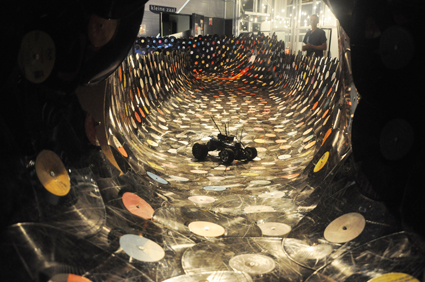
Lucas Abela, Vinyl Rally Arcade
photo courtesy the artist
Lucas Abela, Vinyl Rally Arcade
ART AND GAMES MAKE A KILLER COMBINATION. SOME OF THE MOST EXCITING EXPERIMENTAL ARTWORKS CREATED IN AUSTRALIA IN RECENT YEARS ARE DEEPLY EMBEDDED IN GAMING CULTURE. GIVEN THAT THE NEW GENERATION OF ART LOVERS GREW UP WITH GAMES AS A SIGNIFICANT COMPONENT OF THEIR LIVES, IT’S NO WONDER THERE IS SUCH A STRONG DESIRE AND SUPPORT FOR INTERACTIVE, PARTICIPATORY CULTURE.
When I was asked to present at a forum for the Game Masters exhibition at the Australian Centre for the Moving Image (ACMI) in June 2012 on art and game culture, the main questions I had to ask myself were around definitions. What do we mean when we talk about art and games? And what does the actual work that the Australia Council supports in this area (either directly or indirectly through organisations) look like?
That blurry line between conceptually driven art and game culture was also prominent in my mind, as was the language required to describe the work developing in Australia.
As I collected images and examples of recently funded projects, I started creating loose categories. These bleed into each other by necessity and are of course open for review. But they allow me to create a conversation around what I have termed Art and Games in which I suggest five sub-categories: Game Art; Art Videogames; Game-Like Art; Game Culture Interventions; and Game Culture Initiatives.
game art
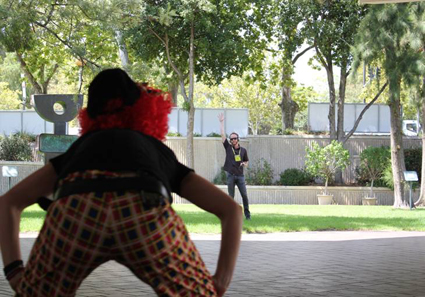
PVI Collective, Deviator, 2012
Game art is art that integrates gaming rules, structured play and reward/fail systems into the artwork. Works such as You Are Here’s Pemulwuy Dream Team (2009) and PVI Collective’s Deviator (2011) are two examples that illustrate how art can integrate game structures into the core aspect of the work.
In Pemulwuy Dream Team, artists Zanny Begg and Keg de Souza worked with the Redfern Indigenous and non-Indigenous communities to develop a Wii-remote boxing game filmed in the local Tony Mundine Gym. With the help of software developer Andy Nicholson, the artists developed a game around the story of Pemulwuy, a member of the Bidjigal clan of the Eora people who led Indigenous resistance to the European invasion when the First Fleet arrived in 1788. To win the game you had to beat not only the drug dealers but also the developers. No easy task.
PVI Collective’s locative media project Deviator (2011) is also a game-based work, structured to encourage players to intervene in public spaces with rewards and achievements unlocked as the game progresses. Activities on offer range from pole dancing in public to running away from a scary, kissing clown. And all the while participants are running against the clock to get points to increase their position on the scoreboard.
In both these works there are strong interventionist tactics at play that engage and critique the dominant political, social and economic orders of the spaces in which they are presented. At the core of this type of game art there is still a strong sense of critical engagement and questioning of the social status quo.
art videogames
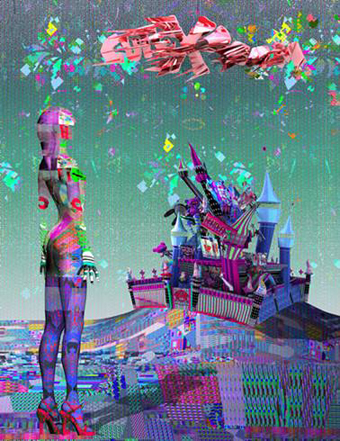
Anita Fontaine, CuteXDoom II, 2008
Art videogames are electronic games that have been transformed into artworks or designed from scratch as pieces of contemporary art. These require artists to utilise game engine technologies to create the works.
Anita Fontaine’s CuteXdoom II (2008) is an example of an art videogame that explores the concept of hyper-consumerism through artistic interventions, with particular reference to Japanese otaku (obsession) and kawai (cuteness) subcultures.
On joining a consumerist ‘cult’ controlled by cute consumer objects, the first person player suddenly finds the cute objects turning violently aggressive, with the game spent trying to escape these creatures and return to non-consumerist calm. CuteXdoom II, the second installment of Fontaine’s work was exhibitied at Maxalot in partnership with Mike Pelletier (Champagne Valentine), where she used game engine technology from titles such as Unreal Tournament 3 to create artistic work in new game environments.
game-like art
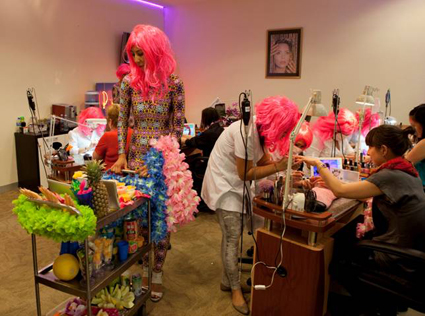
Thea Baumann, Hologram Holiday part of Metaverse Makeover
photo Russell Shakespeare
Thea Baumann, Hologram Holiday part of Metaverse Makeover
Game-like arts uses gaming technology and virtual and augmented reality applications to create emerging forms of art through a range of new, often interactive work. Thea Baumann’s Hologram Holiday (2011) and Jimmy McGilchrist’s Curious Creatures (2011) are two examples of works that use playful, interactive, participatory, virtual and augmented reality work in a game-like capacity.
Hologram Holiday, part of a larger Live Art project managed by Baumann, titled Metaverse Makeover, involves a performative nail salon treatment, an experimental sound track, several ‘hologram hostesses’ assisting with new augmented reality nails and virtual reality applications. Nail technicians place special QR codes on clients’ fingernails, which when viewed through an application on a smart phone or mobile device, reveal three dimensional, virtual reality jewellery popping out of each nail. A cornucopia of virtual bling.
In McGilchrist’s Curious Creatures, game engine technology is used to generate 3D creatures projected onto fences. Each creature makes its own activity decisions based on the interaction of participants, created though ‘shadows’ generated with X-box Kinect technology tracking movements in front of each fence. An immersive, interactive jungle landscape is created with responsive AI inhabitants playing with punters.
Game-like art uses the tools of game engine and virtual reality technologies to invent new applications for both experimental arts practices and innovative community engagement.
game culture interventions
One of the more interesting recent developments is the evolution of artwork that critiques the cultural and social set-up of game culture itself. This is not a negative development—in fact it is a great sign that game culture plays a significant role in current cultural debate.
Work such as Computer Boy, a mixed reality performance by Blood Policy and Aphids, uses machinema and theatre to talk about issues of potential isolation for hyper-networked young people. The work also examines racial and gender stereotypes that are perpetuated in some of the games on the market at the moment. These works are not anti-gaming; they elevate game experiences to the same level as other cultural experiences and hold them accountable at that same level.
game culture initiatives
As well as funding the creation of art games, art video games, game-like art and game interventions, the Australia Council supports sector development initiatives that expand the capacity of artists working in virtual reality and game cultures. Two such initiatives include the Australian Centre for Virtual Art Laboratory (ACVA Lab) and the Interactive Media Innovation [imi] Project.
ACVA Lab, held in 2009, was a national gathering in Melbourne that explored the work of Australian artists and technologists using virtual and augmented reality platforms. As well as facilitating artistic networks and prototyping, ACVA curated and promoted Australian artists at the International Symposium of Electronic Art (ISEA) 2011 in Istanbul through Terra Virtualis, a nationally representative exhibition of new, virtual and augmented reality art. ACVA also supported Aroha Groves’ virtual world work Connections2, which was Highly Commended at the 2010 Telstra National Aboriginal and Torres Strait Islander Art Award.
The [imi] Project, supported through the Australia Council, the Australian Research Council, the Australian Film Television and Radio School (AFTRS) and the Queensland University of Technology, similarly champions national innovation in interactive design. It will place Australian artists in a number of Australia’s leading interactive media development companies, including Defiant Development, Halfbrick Studios (think Fruit Ninja), Hoodlum, Kennedy Miller Mitchell, League of Geeks, Mod Productions, the Project Factory and Tantalus Media.
60Sox’s Justin Brow and AFTRS’ Karen Pearlman will be liaising with the Australia Council to identify and place artists working with a range of artforms in these companies to cross-fertilise ideas and develop new concepts for emerging art and game projects.
the future
The Australia Council continues to support emerging and experimental practices for art and games through its general grant rounds and through special initiatives.
A major event coming up, where many of the works we have supported will be on display, is the ISEA 2013 in Sydney. This event will not only showcase key Australian and international electronic artworks of excellence, but also engage with innovative game culture art and its evolution as part of the program. I look forward to seeing the new work in development for ISEA 2013 and also being part of ongoing conversations on the role of art and games in Australia.
ACMI, Game Masters, Exhibition, Melbourne, June 28-Oct 28; forum, June 28
For enquires about the Interactive Media Innovation [imi] project go to www.imi-innovation.org
RealTime issue #111 Oct-Nov 2012 pg. 27
© Ricardo Peach; for permission to reproduce apply to realtime@realtimearts.net
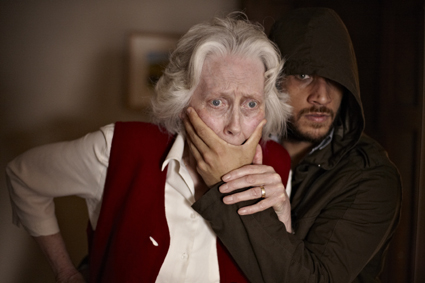
Last Dance
LAST DANCE OPENS INNOCUOUSLY WITH MRS LIPPMANN (JULIA BLAKE) GOING ABOUT HER BUSINESS ON THE BUSY COMMERCIAL STRIP OF A SUBURB IN INNER-MELBOURNE. IT’S AN AREA WHICH, JUDGING FROM THE ABUNDANCE OF KIPPAS AND BEARDS (NOT TO MENTION THE ‘KOSHER SUSHI’ SHOP), DRAWS ITS CHARACTER FROM ITS JEWISH INHABITANTS, WHILE THE INDUSTRIOUS WIDOW SEEMS THE SORT OF LADY WHO IS FRIENDLY WITH EVERYONE, THOUGH INTIMATE ONLY WITH HER CAT. THEN THERE’S THE SOUND OF SIRENS, THE BUZZ OF PEOPLE EVAPORATES AND A TROUBLED MRS LIPPMANN IS LEFT TO MAKE HER WAY HOME.
Her puzzlement is soon explained when she returns to her brown-brick flat, where she is accosted by Sadiq (Firass Dirani), a Palestinian Islamic fundamentalist fleeing from the synagogue where a fellow-terrorist has just blown himself up. Bleeding from a shrapnel wound and unsure of what to do next, Sadiq takes Mrs Lippmann hostage, though as he makes clear to her, “killing you means nothing to me—it simply means ridding the world of one more Jew.”
Last Dance should be applauded for directly confronting the ongoing conflict in Israel and disenfranchisement of the Palestinian people, raising questions of moral responsibility within the relatively accessible format of the thriller. Though the initial scenes are painted a touch too heavy-handedly—must every extra be Orthodox?—the Melbourne setting is believable in that the story might play out anywhere in the Judaic diaspora. There are a few surprises: Mrs Lippmann, a Holocaust survivor, though initially repulsed by Sadiq’s hatred and the mindlessness of his indoctrination, is not unready to listen to his story—and when the power dynamic between the pair shifts halfway through the film, her choices are made believable by their shared experience of catastrophic loss.
Without the right performers, director David Pulbrook and co-screenwriter Terence Hammond’s script may well have lost much of its drive. Fortunately, both leads excel here. Dirani, whose roles in TV dramas such as Underbelly and The Straits seem to have prepared him perfectly for the big screen, is superb as the failed suicide bomber, a livewire of impulsive gesture and darkly challenging looks. His brooding energy is magnificently balanced by Blake, the worn planes of her face channelling a seemingly boundless empathy as she is forced to confront her assumptions about Israel and try to reason her way out of a labyrinth of equivocation.
The film is smoothly shot, Pulbrook wisely allowing the performers to carry the story, the camera to linger on their faces. His experience as an editor (Ground Zero, The Cup) ensures that the film maintains a look of smooth professionalism. However, although the performances cannot help but shine through, they are not aided by an obtrusive soundtrack and some of the more overwrought contrivances of the script. Indeed, the script may have benefited from being tested on a stage before being adapted to the screen, given the limitations of the setting. As it is, although Last Dance delves into powerfully emotive territory it veers dangerously close to melodrama, particularly in the third act, so the characters never really developing beyond the necessities of the concept.
Last Dance, director David Pulbrook, producer Antony Ginnane, screenplay David Pulbrook and Terence Hammond, director of photography Lee Pulbrook, Ulah Productions, Becker Group release
RealTime issue #111 Oct-Nov 2012 pg. 29
© Oliver Downes; for permission to reproduce apply to realtime@realtimearts.net
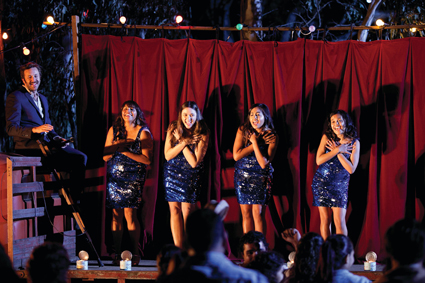
The Sapphires
THE SAPPHIRES IS A STRANGE MIX. IT OFFERS A WARMLY IMAGINED AND EASILY ENJOYABLE PERSONAL DRAMA THAT EXPLICITLY CONFRONTS RACIAL INEQUALITY DURING ONE OF THE MOST TUMULTUOUS PERIODS OF THE ANGLOSPHERE’S 20TH CENTURY. ON THE OTHER HAND, IT ADHERES SO WELL TO THE CONVENTIONS OF THE HOLLYWOOD ROMANTIC DRAMA AS TO DROWN ANY NUANCE OF HISTORICAL COMPLEXITY IN A STEADY STREAM OF STEREOTYPE. THOUGH IT SUCCEEDS WONDERFULLY AT PROVIDING THE VIEWER WITH AN ENTERTAINING MEANS OF KILLING AN HOUR AND A HALF, IT RARELY PROVOKES MUCH DEEPER INSIGHT.
It’s 1958 and on Cummergunga Mission four young girls are putting on a show, singing for their community. Cut to 10 years later, and while folk elsewhere struggle for civil rights, land rights and either fight in or protest against the war in Vietnam, sisters Gail (Deborah Mailman), Cynthia (Miranda Tapsell) and Julie (Jessica Mauboy) are still living on the mission and still singing. Entering a talent contest at the local pub, they encounter Dave Lovelace (Chris O’Dowd) an itinerant Irish musician who, unlike the straightforwardly racist locals, immediately recognises their talent.
Scoring the women an audition to travel to Vietnam as entertainers for the troops, Lovelace convinces them to trade Country for Soul and sets about moulding the sisters, along with their cousin Kay (Shari Sebbens), into a girl group à la The Supremes. Not that they’re averse—as Gail drily comments, singing beats “being treated like dogs by the gubbas in town.” Narrative logic takes over as the women travel to Saigon, becoming a hit among the African American soldiery, the thrill at their success tempered by the reality of life inside a warzone. Passions, both romantic and antagonistic, flare amid the battlefields as the reasons for Gail’s hostility towards Kay, whose pale skin has allowed her to pass for white, draws the story back to the apparent innocence of the opening.
Adapted from his music theatre work written in collaboration with Keith Thompson, Tony Brigg’s story draws on his own family history—his mother, Laurel Robinson, and aunt, Lois Peeler, sang in Vietnam as young women. The film’s great strengths develop from this, in the relationships between the four women and in the music that unites them. The songs certainly sound fantastic, thanks in no small part to Jessica Mauboy as the sweetly determined Julie, while O’Dowd is similarly likeable as their drolly rumpled manager.
However in its relentless focus on the personal, the film cultivates a determined buoyancy that often seems at odds with the institutionalised racism arrayed against the majority of the characters and the vast historical violence unravelling around them. The reasons why a group of Aboriginal women should only be permitted to perform for the entertainment of African American troops remain carefully unremarked upon—indeed, watching the film it would be easy to falsely surmise that blacks accounted for a majority of Americans deployed in Vietnam.
Unwilling or unable to accommodate complexity the film falls back on cliche: white people are racist, unless they’re Irish, in which case they’re drunk and charmingly inept, while Aboriginal people are disenfranchised but have sassy mouths, big hearts and are generally deadly. Although The Sapphires is diverting enough, by so completely obscuring the difficult questions of power, class and racial violence raised by the story with the redemptive narratives of individual love and the ‘transcendental’ power of music, the filmmakers do their material a disservice.
The Sapphires, director Wayne Blair, screenplay Tony Briggs, Keith Thompson, director of photography Warwick Thornton, editor Dany Cooper, music Cezary Skubiszewski, production design Melinda Dorling, art direction Janie Parker; Goalpost Pictures, distributor Hopscotch Films
RealTime issue #111 Oct-Nov 2012 pg. 30
© Oliver Downes; for permission to reproduce apply to realtime@realtimearts.net



























































































































